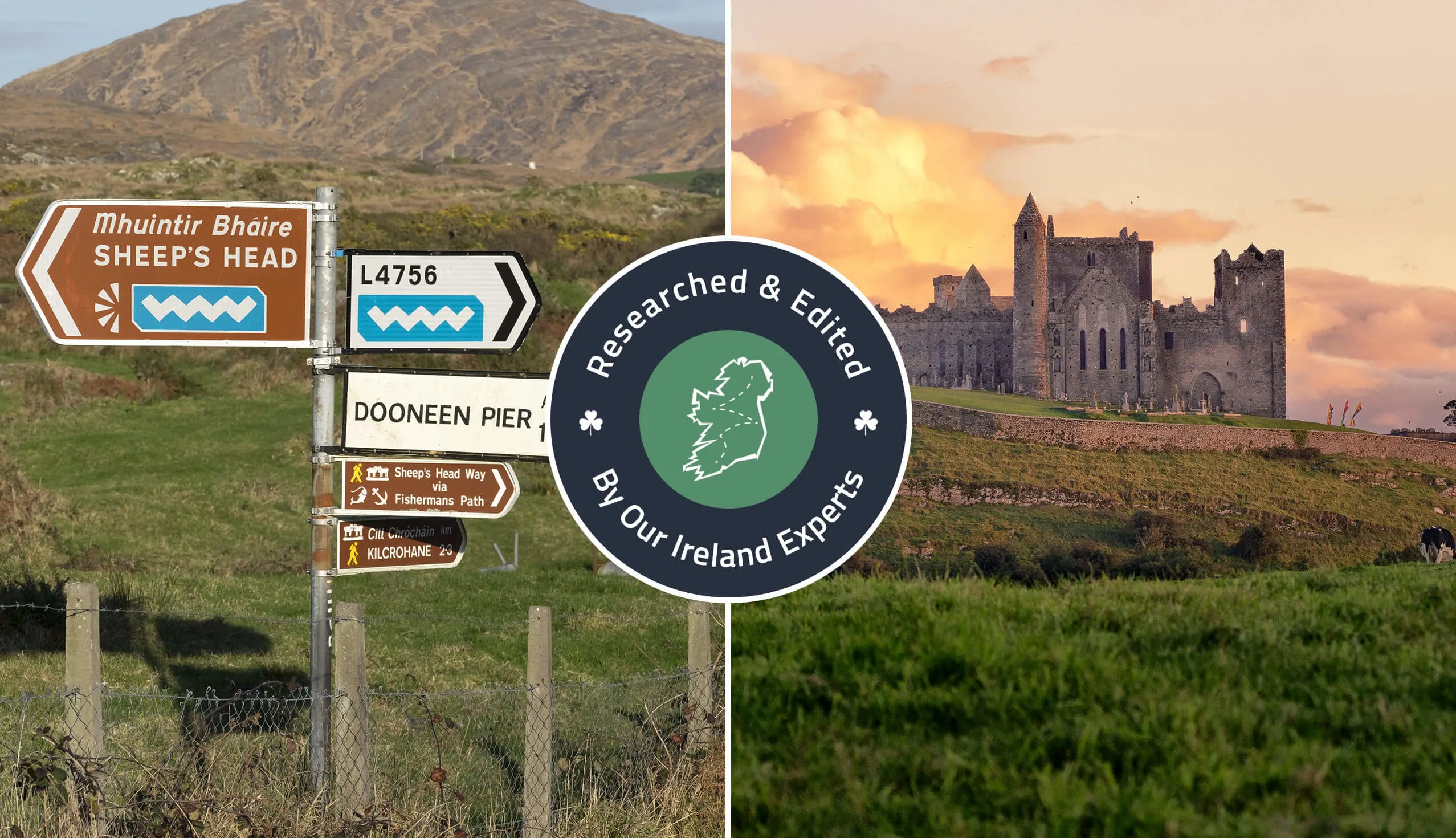Planning a 20-day Ireland itinerary can be a pain in the backside… So, we’ve done all of the hard work for you!
We’ve spent 25+ years travelling around Ireland and the itinerary below leans on that experience and the many mistakes we made along the way!
In a nutshell, this 20-day itinerary:
- Starts and ends in Donegal
- Has been meticulously planned
- Has an hour-by-hour itinerary for each day to save you time/hassle
- Follows logical routes that take you to hidden gems, tourist favourites and great pubs and restaurants
Who this itinerary will suit
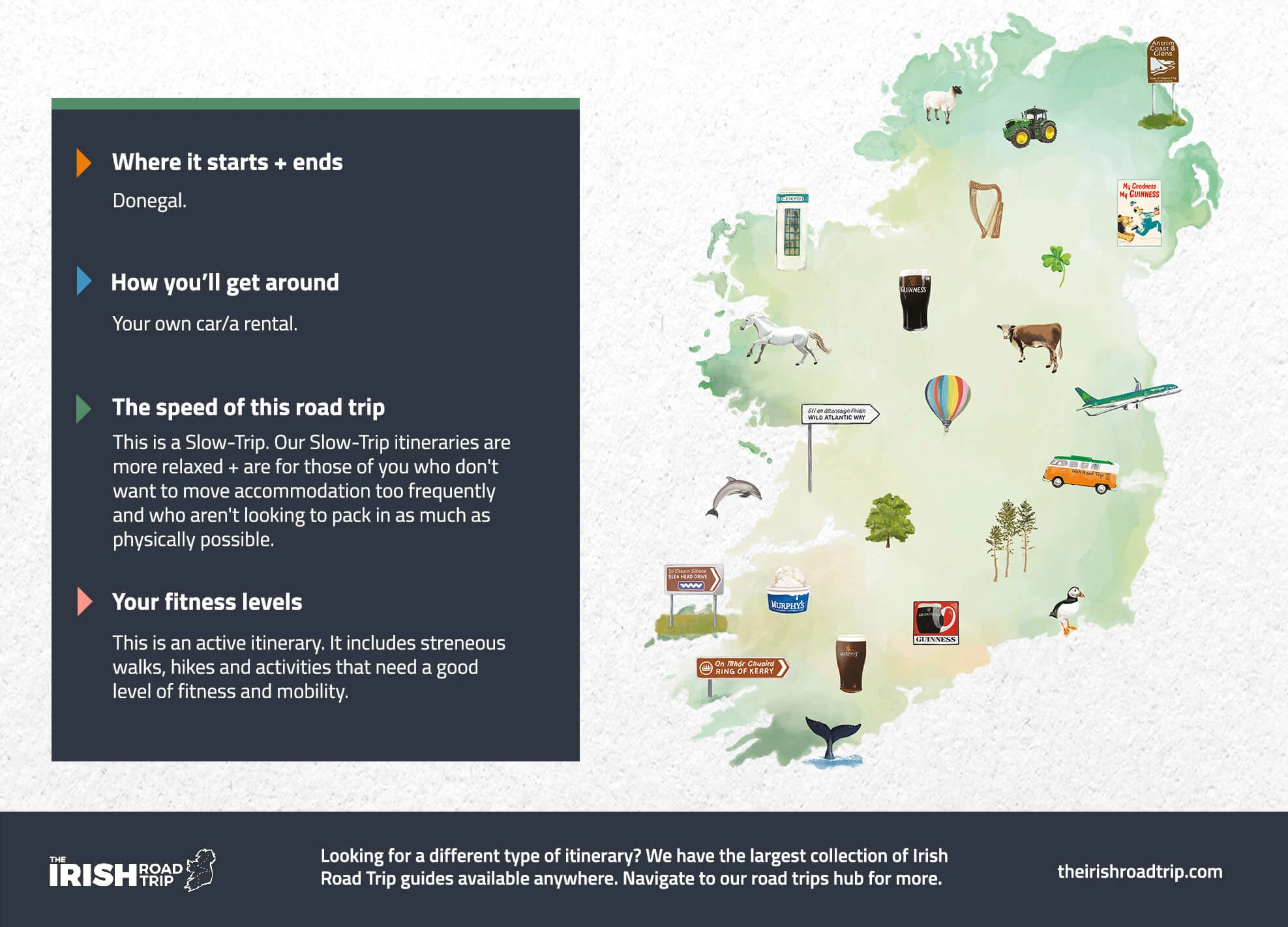
Now, before you scroll down, take 10 seconds to look at the graphic above – each of our road trip itineraries have been tailored to specific needs.
This road trip is specifically for those of you:
- Starting in/near Donegal
- Using your car/a rental
- Looking to explore at a slow pace
- With a good level of fitness (i.e. it includes long walks and hikes)
- Remember, we have hundreds of different itineraries here if this one doesn’t suit you
An overview of this 20-day itinerary
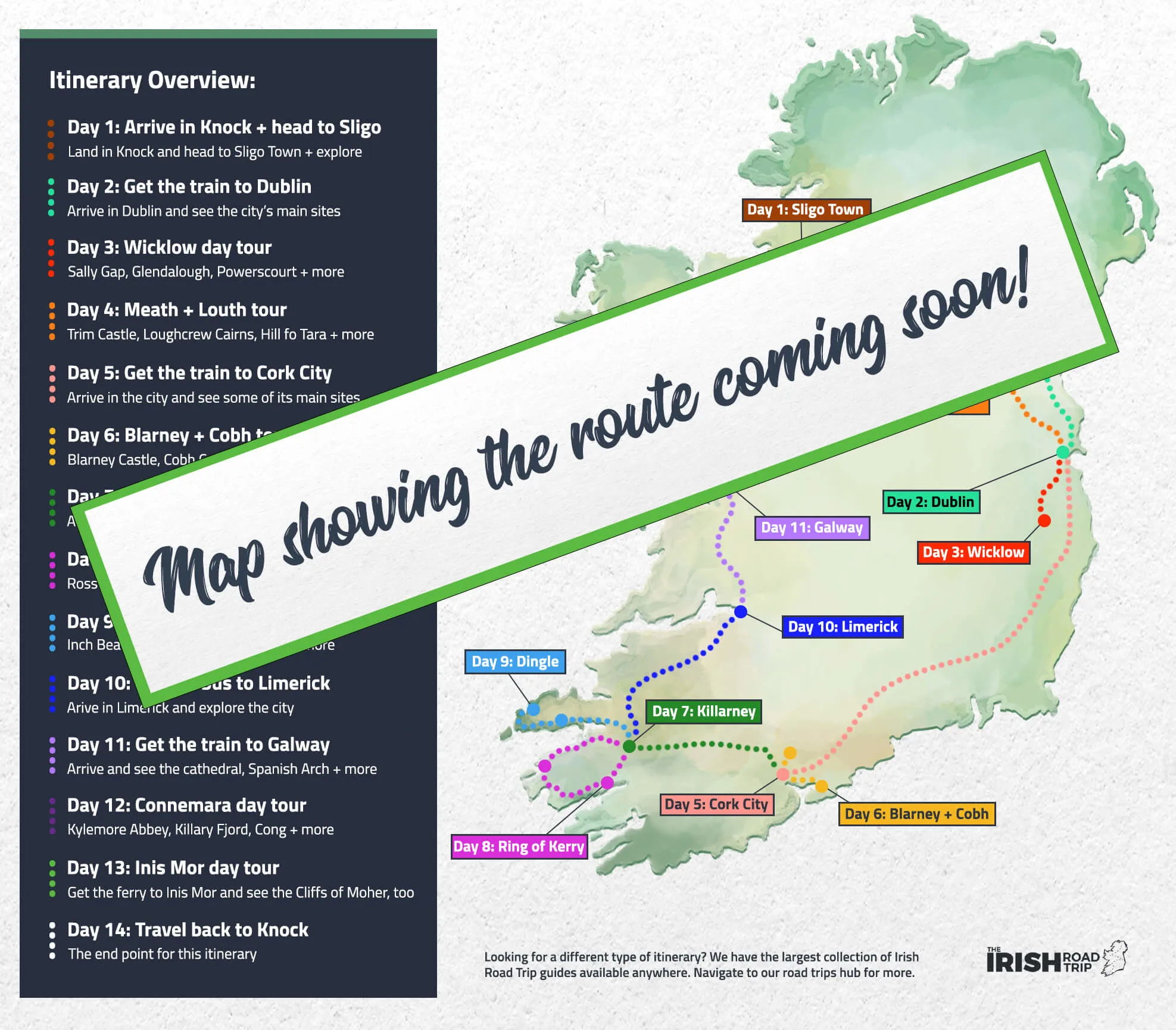
The map above gives you a very high-level overview of where this route will take you.
It uses several bases (e.g. Belfast for 2 nights) and provides you with day-long road trips you can head off on, so you avoid having to change accommodation constantly.
Now, I’ll stop rambling on – here’s a day-by-day insight into each of the days below!
Day 1: Arrive in Donegal
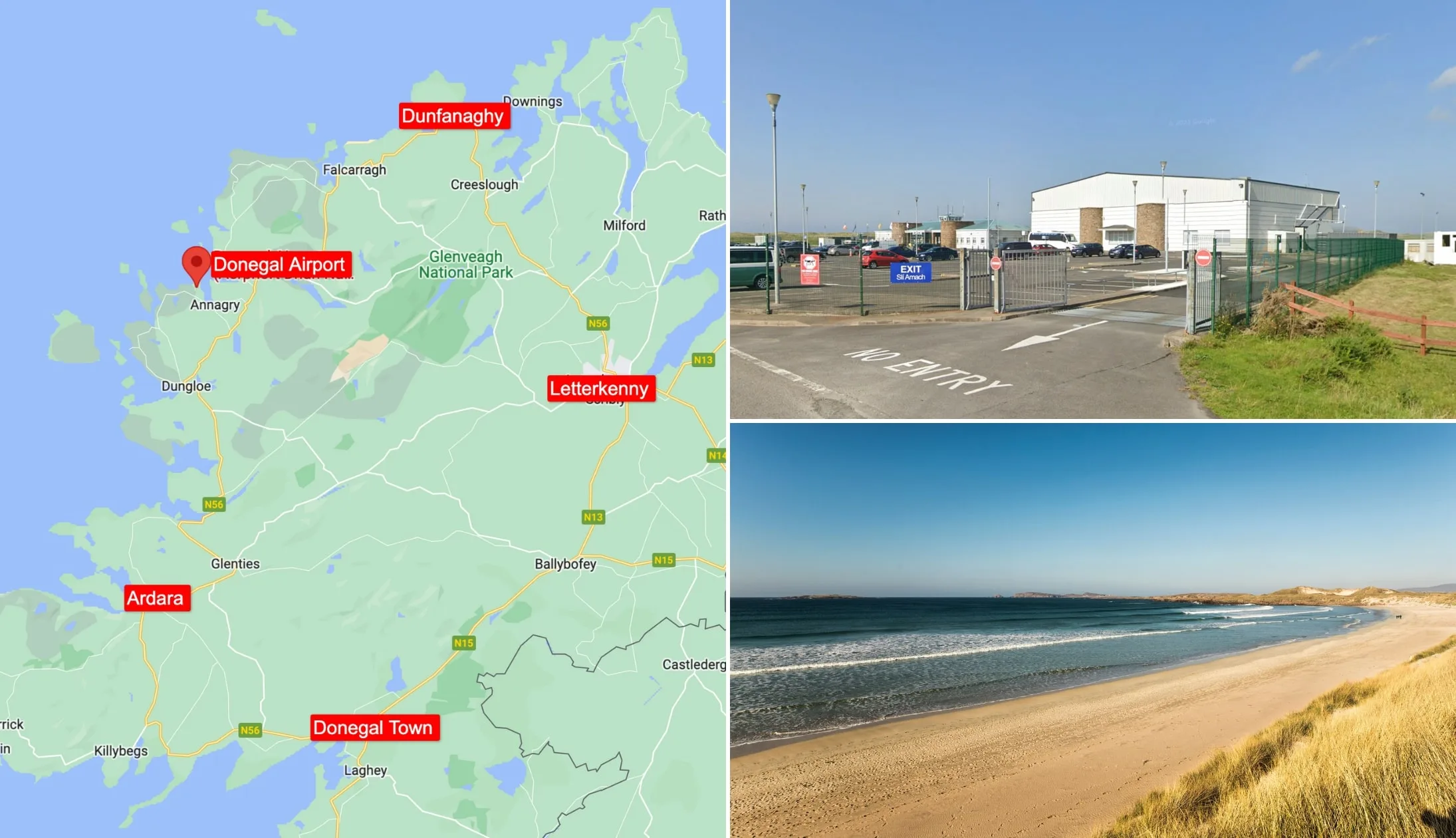
Photos via Google Maps and Shutterstock
It’s day one, so first of all, welcome to Ireland! Today you’ll land at Donegal Airport, where you’ll pick up your rental car, ready for a 20-day adventure across Ireland. For today, we’re going to assume that your flight gets in around midday.
Once you’ve got the keys and loaded up your luggage, it’s time to hit the road. Our final destination for today is the delightful coastal town of Dunfanaghy, where you’ll be spending two nights. Here are a few ideas for accommodation.
Our Dunfanaghy accommodation recommendations
- Budget to mid-range: Kings Accommodation (cosy spot a 10-minute walk from town) and The Mill (exceptional reviews and a 2-minute drive from town)
- Luxury: Shandon Hotel & Spa (10-minute drive from town right by the beach) and Arnolds Hotel (super central with top reviews)
Stop 1: Lunch

Photos via Time & Tide on FB
Dunfanaghy is a 40-minute drive from the airport on a road that cuts through the moody yet beautiful scenery of Ireland’s northwest. But you’re probably hungry after the journey, so let’s sort some lunch out first.
Time & Tide in Annagry is the perfect place to grab a bite after a long flight. It’s just a 6-minute drive from the airport and offers a selection of delicious baked goods, soups, and what many claim to be the best toasties in the land. They also brew up a superb cup of coffee, ideal if you’re in need of a little pick-me-up.
As for parking, there’s a spacious, free car park right next to the cafe.
Stop 2: Falcarragh Beach
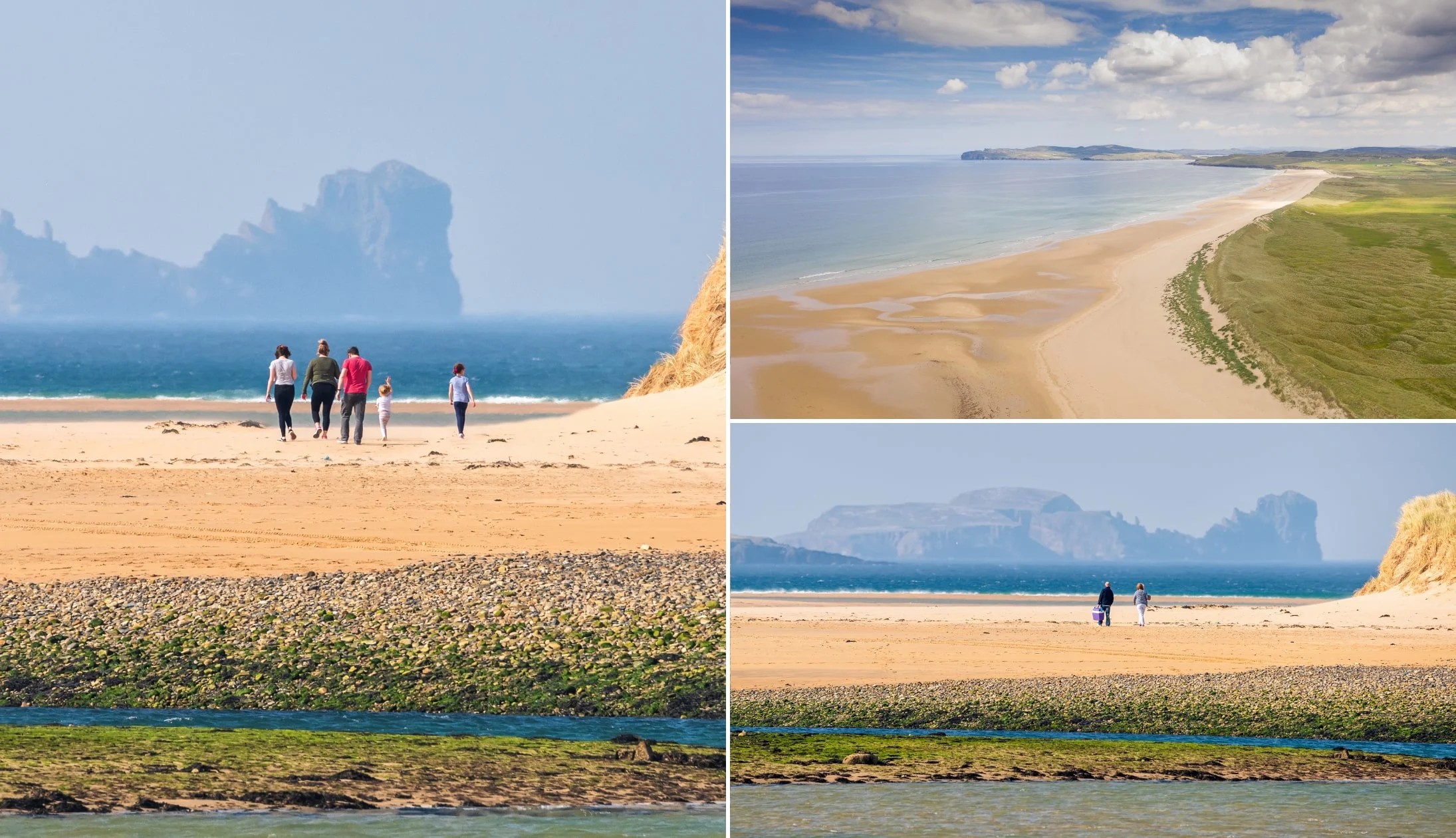
Photos left and bottom right: Gareth Wray. Top right © Tourism Ireland
There are some glorious beaches in Donegal and Falcarragh Beach is up there with the best of them.
A 28-minute drive from Annagry, it’s well worth dropping by before heading to your accommodation in Dunfanaghy.
At 4.5 km long, the beach is ideal for a gentle stroll along the soft, white sands. We don’t suggest swimming here but feel free to kick off your shoes and let the cool Atlantic Ocean gently lap at your feet.
On a fine day, you’ll notice that the sea takes on a turquoise colour, making for a pretty spectacular scene, especially with the gorgeous Donegal landscape surrounding it.
Stop 3: Dunfanaghy
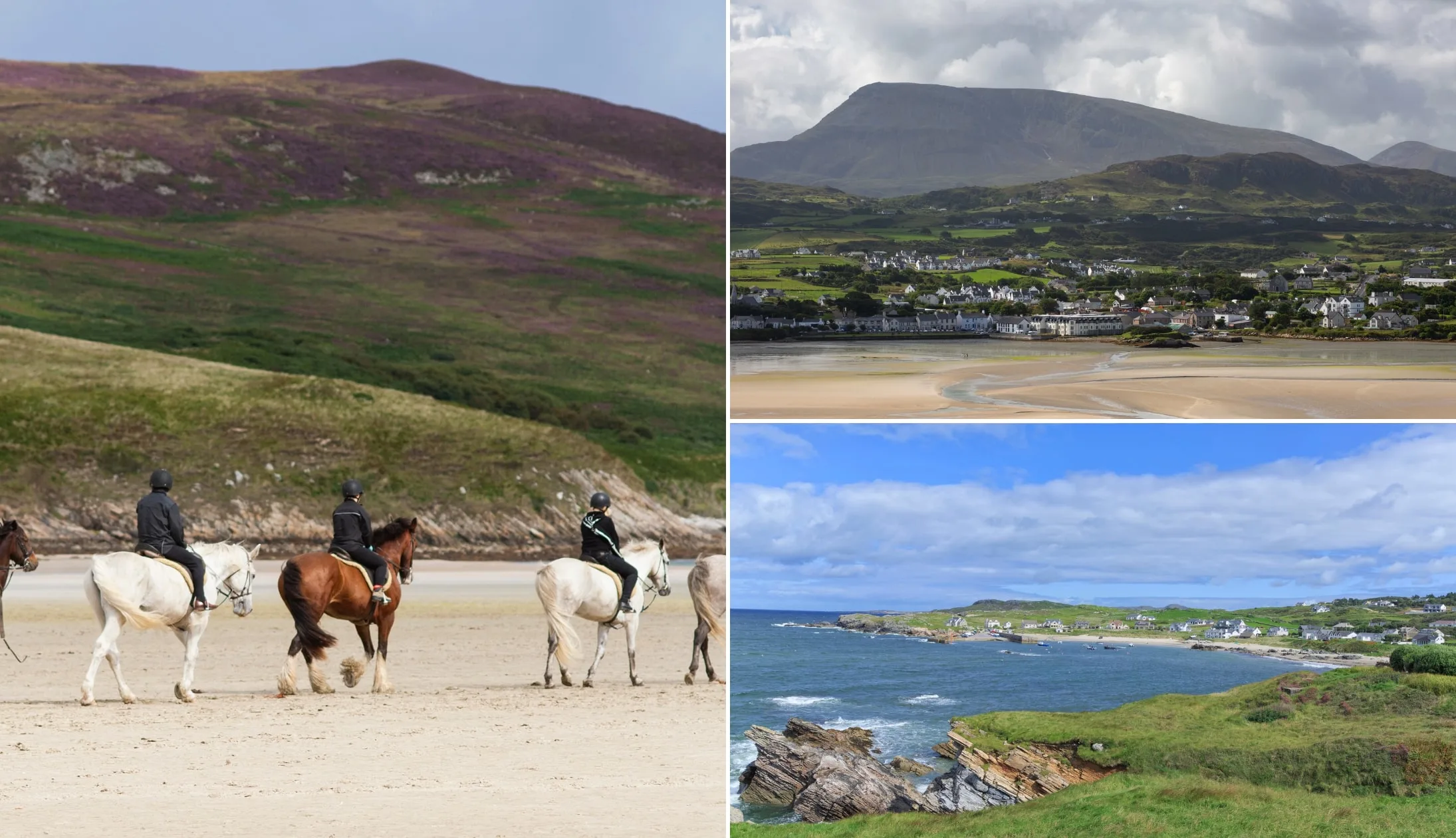
Photos via Shutterstock
The charming village of Dunfanaghy is home to breathtaking beaches and several excellent places to eat and drink. Plus it’s just a stone’s throw from many of Donegal’s top attractions, making it an ideal base for our first couple of days in Ireland.
Once you arrive, check into your accommodation, freshen up, and feel free to explore the charming little village.
If time allows, it’s worth checking out the Workhouse, where you can step back in time and have a nosey around the craft shop, see the Famine Exhibition, kick back with a coffee in the cafe or head off on the Heritage Trail.
The Heritage Trail is accompanied by an audio guide that offers an insight into local points of interest.
Stop 4: Dinner, drinks and live music
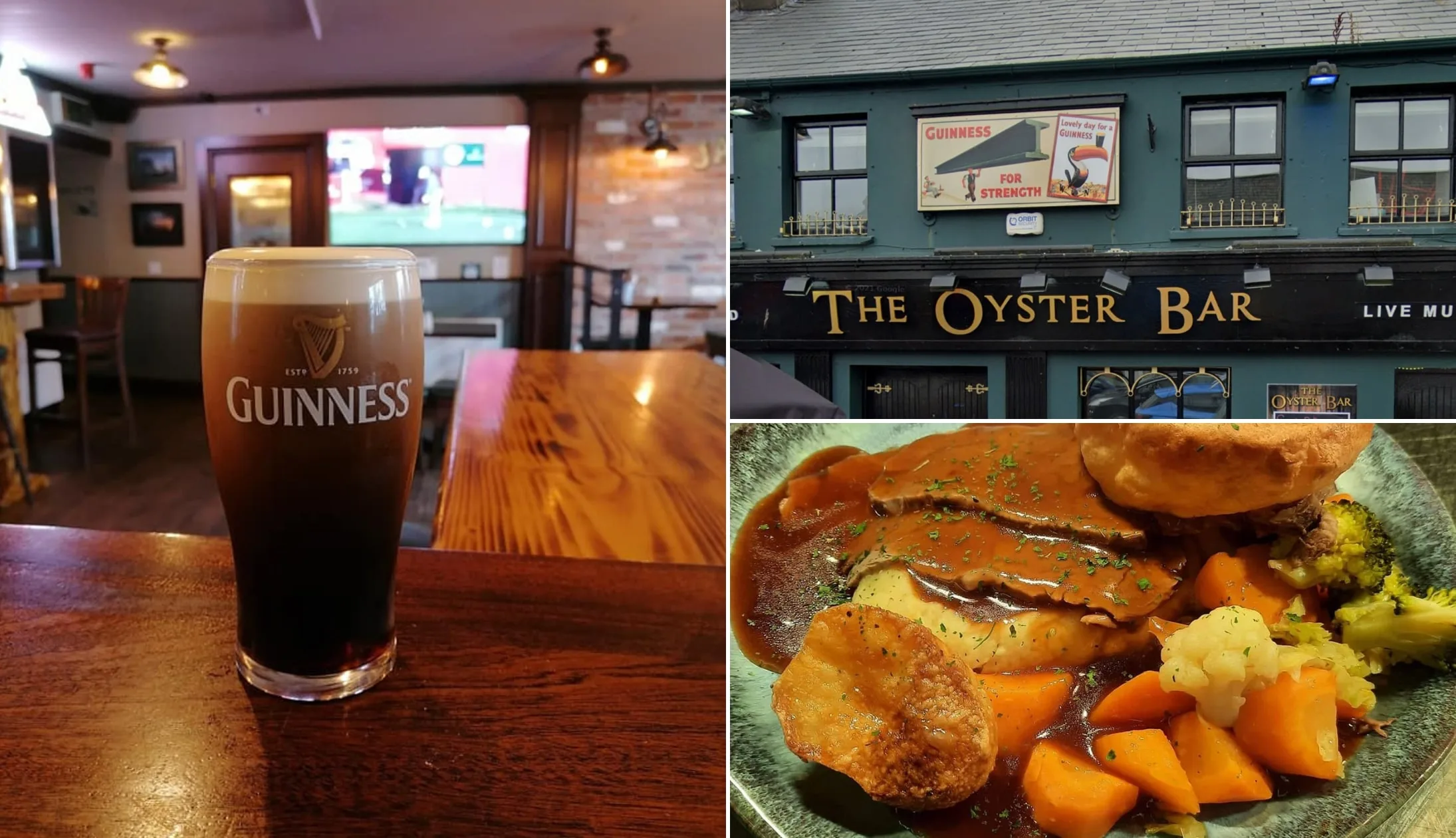
Photos via the Oyster Bar on FB
After exploring the village, it’s time to get some dinner and drinks in, and perhaps even a little live music to celebrate your first night in Ireland.
Our Dunfanaghy food recommendations
There are some fantastic places to grab dinner in Dunfanaghy. The Rusty Oven Pizzeria is always a winner. They cook up tasty pizzas in the wood-fired oven. It’s easy to find from Market Square – just follow your nose! In summer, the atmosphere in their sheltered garden is sensational.
Cafe Arnou is another good shout, with excellent fish and chips, while Lizzie’s is the place to be for seafood. The chowder is heavenly.
Our Dunfanaghy pub recommendations
You’ll find some great pubs in Dunfanaghy too. If you’re looking for an authentic Irish pub experience, Patsy Dans is a fantastic choice, boasting a low ceiling, a real turf fire, and a homely atmosphere.
You can also order pizza from the Rusty Oven here. It echoes the beat of live music and trad sessions on most evenings, so bring your best singing voice. They serve a top-notch pint of Guinness too.
The Oyster Bar is also worth checking out. A place where Irish music, cold beer, and good food come together, this busy social hub is a favourite among locals and visitors alike. There’s also a pool table.
Molly’s Bar is another good option in the town. There’s a nice beer garden to the rear of this family-friendly pub on Main Street.
Day 2: Donegal hikes
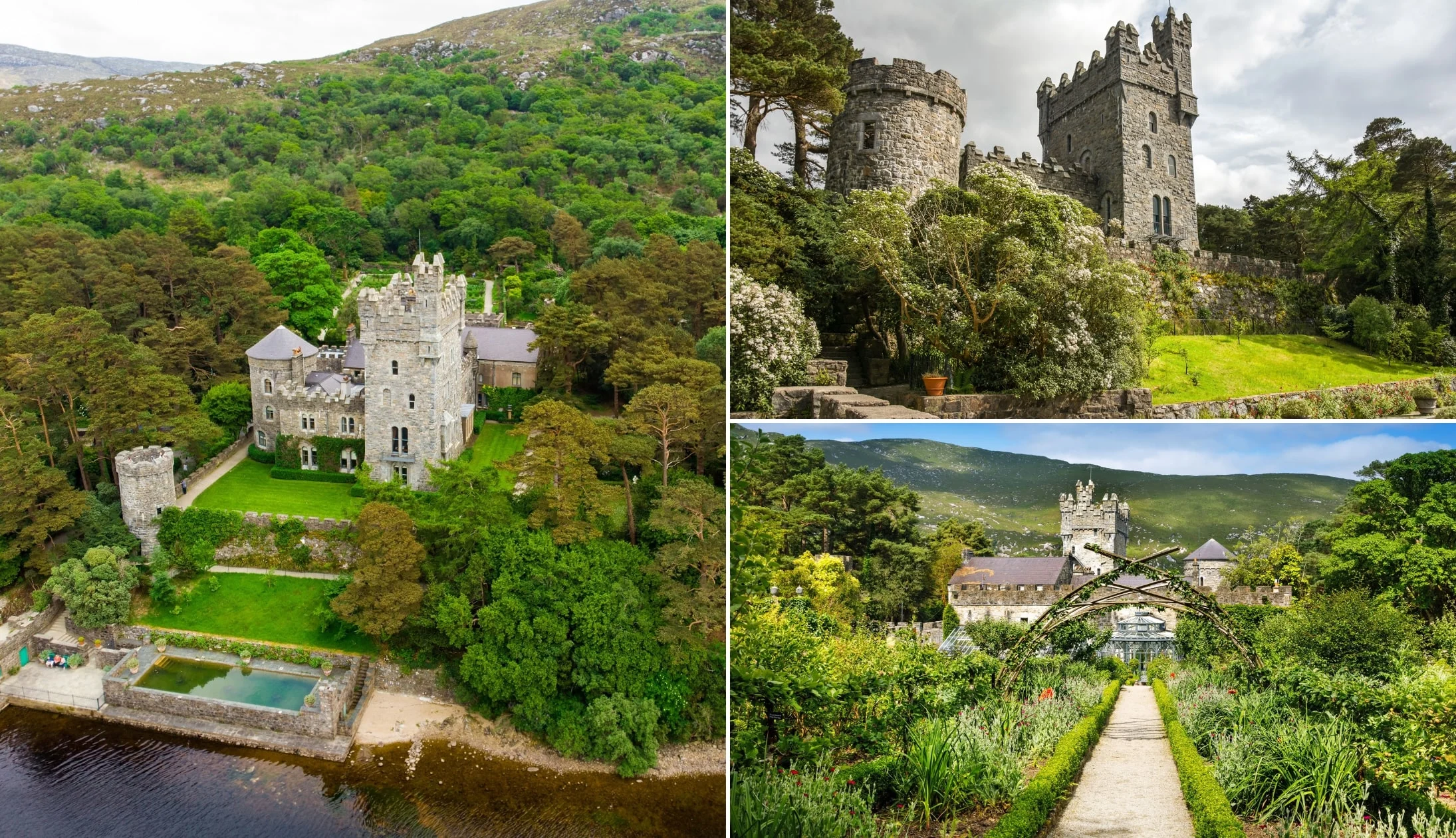
Photos via Shutterstock
Today we’re heading out into the gorgeous Donegal countryside to tackle the highest mountain in the county, Errigal. This is a moderately tough hike, so be sure to have decent footwear and all-weather clothing.
You’ll also want to take a packed lunch and snacks with you. Your accommodation might be able to sort you out with a packed lunch. Otherwise, you can grab something to go from one of the local shops or cafes.
Enjoy a hearty full Irish breakfast at your accommodation, or head into the village for something. Muck ‘n’ Muffins is a delightful coffee shop above a ground-floor pottery studio that offers a superb breakfast menu, with plenty of healthy and not-so-healthy options, like porridge, granola, their hefty pancake stack, or a sausage and bacon bap.
Stop 1: Errigal Mountain
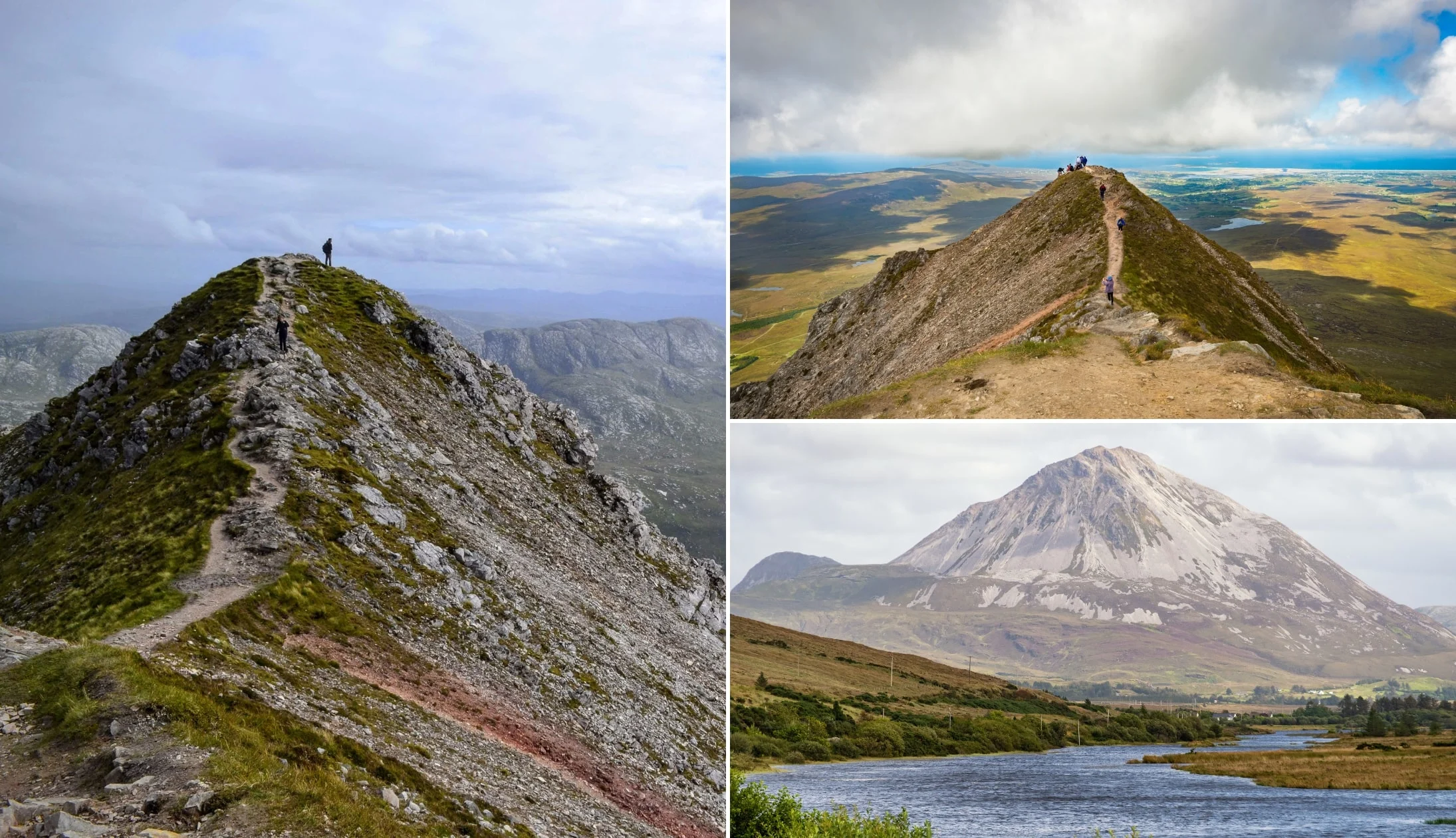
Photos via Shutterstock
The Errigal Mountain Hike Car Park is just a 26-minute drive from Dunfanaghy, down the scenic R251. You’ll find the small car park on the side of the road, pretty much directly beneath the mountain.
If you put “Errigal Mountain Hike Parking” into Google Maps, you’ll find it easily enough.
The car park fits around 10 to 12 cars, though be advised, it can be busy on a fine summer weekend, so it’s a good idea to arrive early.
At 751m high, Errigal is the highest peak in the Derryveagh Mountains. If you tackle the hike on a fine day, you’ll have views of everywhere, from Slieve Snaght in north Donegal to Sligo’s Benbulben.
The hike is around 4.5 km in length and should take between 2-3 hours to complete, depending on how long you spend at the summit taking in the views. As a moderate to strenuous hike, some knowledge of mountain navigation is definitely helpful.
The terrain is a mix of bog, rock, and shale, and with some steep inclines along the way, it can be tough-going at times. But once you make it to the top, you’ll know it was well worth the effort. Enjoy the summit, have a bite to eat, and then head back down the same way.
Stop 2: Glenveagh National Park
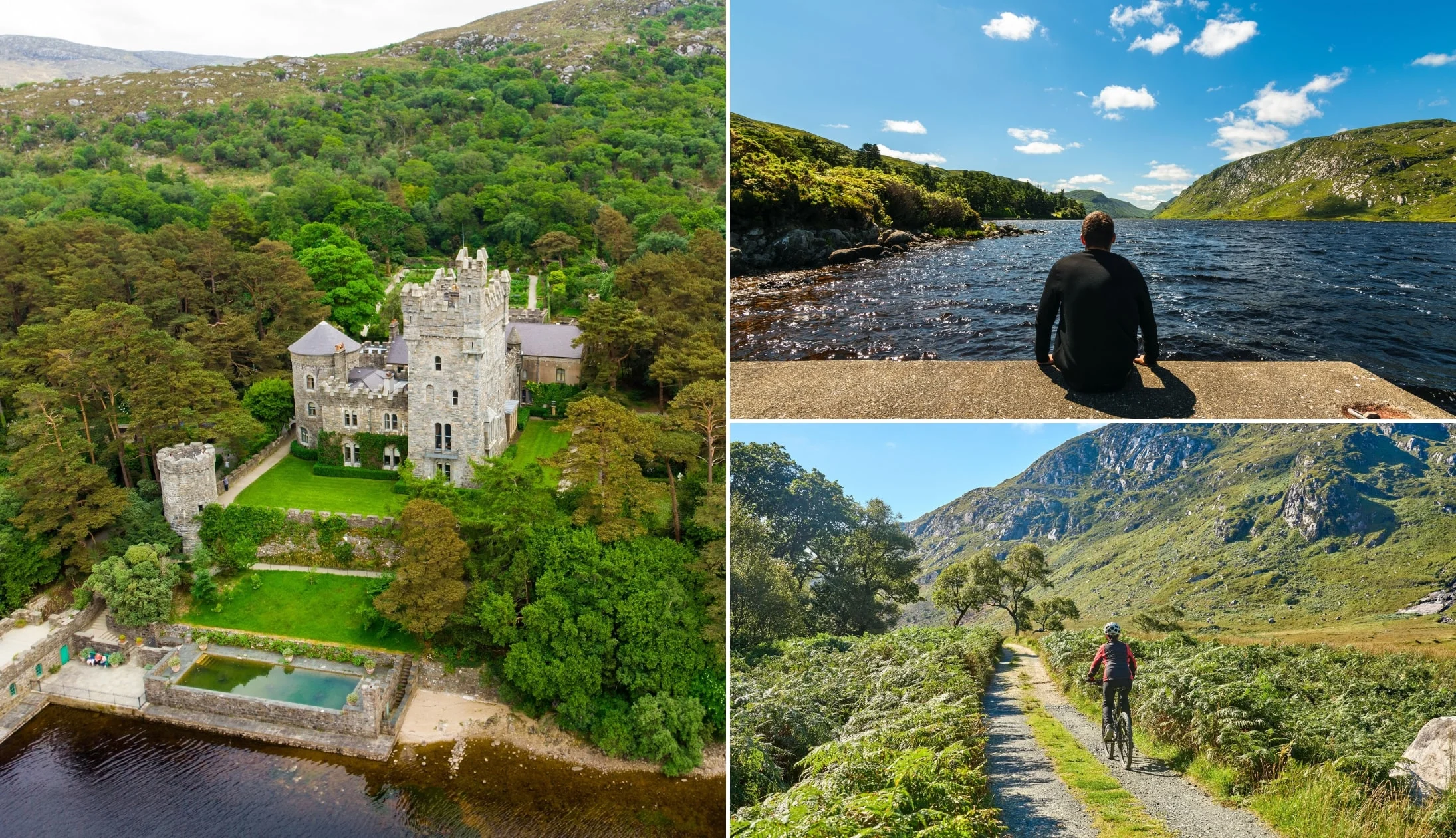
Photos via Shutterstock
Congratulations, you’ve completed the Errigal hike! Our next stop is Glenveagh National Park, a gorgeous 16,000 hectares of parkland in County Donegal that takes in loughs, forests, rugged mountains, waterfalls, and a castle.
It’s only an 11-minute drive from Errigal, and there’s a large car park at the entrance, complete with toilets and a visitor centre.
If you want to visit Glenveagh Castle, there’s a fantastic lakeside walk that takes you from the car park all the way to the castle, along the shores of Lough Veagh.
It’s an easy-going walk that’s 3.5 km long and typically takes about 40 minutes one way. You can also take a shuttle bus if you don’t feel like walking anymore.
Alternatively, it’s a nice path for cycling too and it’s possible to rent bikes from the visitor centre. There are plenty of other walking and cycling trails in the park if you still have energy left.
The fairytale castle is also a wonder to behold. It’s well worth strolling the grounds and gardens, before taking a guided tour of the inside. You’ll also find a cafe at the castle, ideal for recharging your batteries.
Stop 3: Back to Dunfanaghy for the night
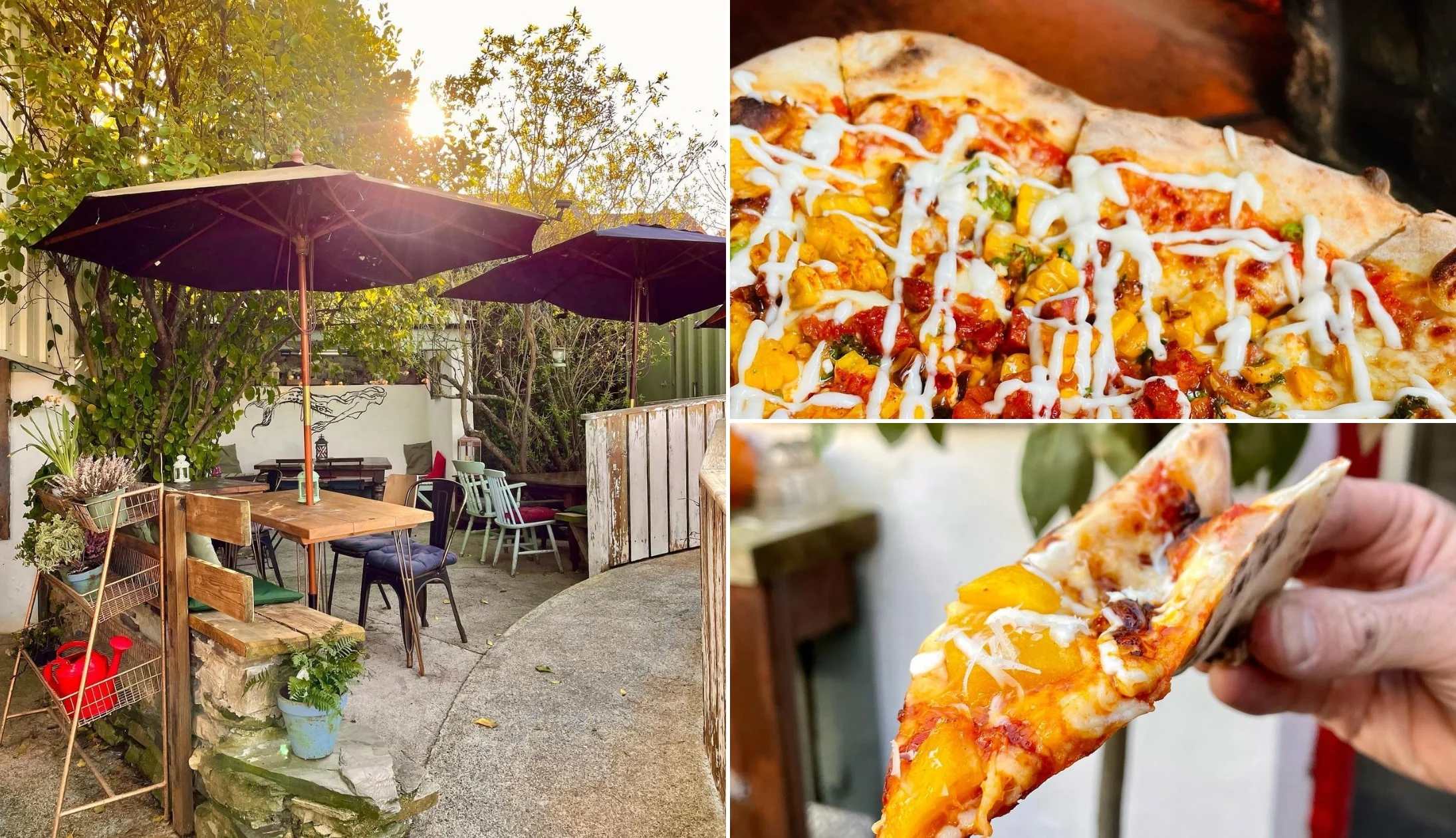
Photos via The Rusty Oven on FB
It’s a 23-minute drive back to Dunfanaghy from Glenveagh National Park. After a fairly active day, you’ll probably want to head back to your accommodation to freshen up, before hitting the town for dinner and a few well-earned pints.
Once you’ve had a breather, head back to Dunfanaghy’s main street to enjoy a well-deserved dinner.
Our Dunfanaghy food recommendations
There are some fantastic places to grab dinner in Dunfanaghy. The Rusty Oven Pizzeria is always a winner. They cook up tasty pizzas in the wood-fired oven. It’s easy to find from Market Square – just follow your nose! In summer, the atmosphere in their sheltered undercover garden is sensational.
Cafe Arnou is another good shout, with excellent fish and chips, while Lizzie’s is the place to be for seafood, the chowder is heavenly.
Our Dunfanaghy pub recommendations
You’ll find some great pubs in Dunfanaghy too. If you’re looking for an authentic Irish pub experience, Patsy Dans is a fantastic choice, boasting a low ceiling, a real turf fire, and a homely atmosphere.
You can also order pizza from the Rusty Oven here. It echoes to the beat of live music and trad sessions on most evenings, so bring your best singing voice. They serve a top-notch pint of Guinness too.
The Oyster Bar is also worth checking out. A place where Irish music, cold beer, and good food come together, this busy social hub is a favourite among locals and visitors alike. There’s also a pool table.
Molly’s Bar is another good option in the town. There’s a nice beer garden to the rear of this family-friendly pub on Main Street.
Day 3: The Donegal coast
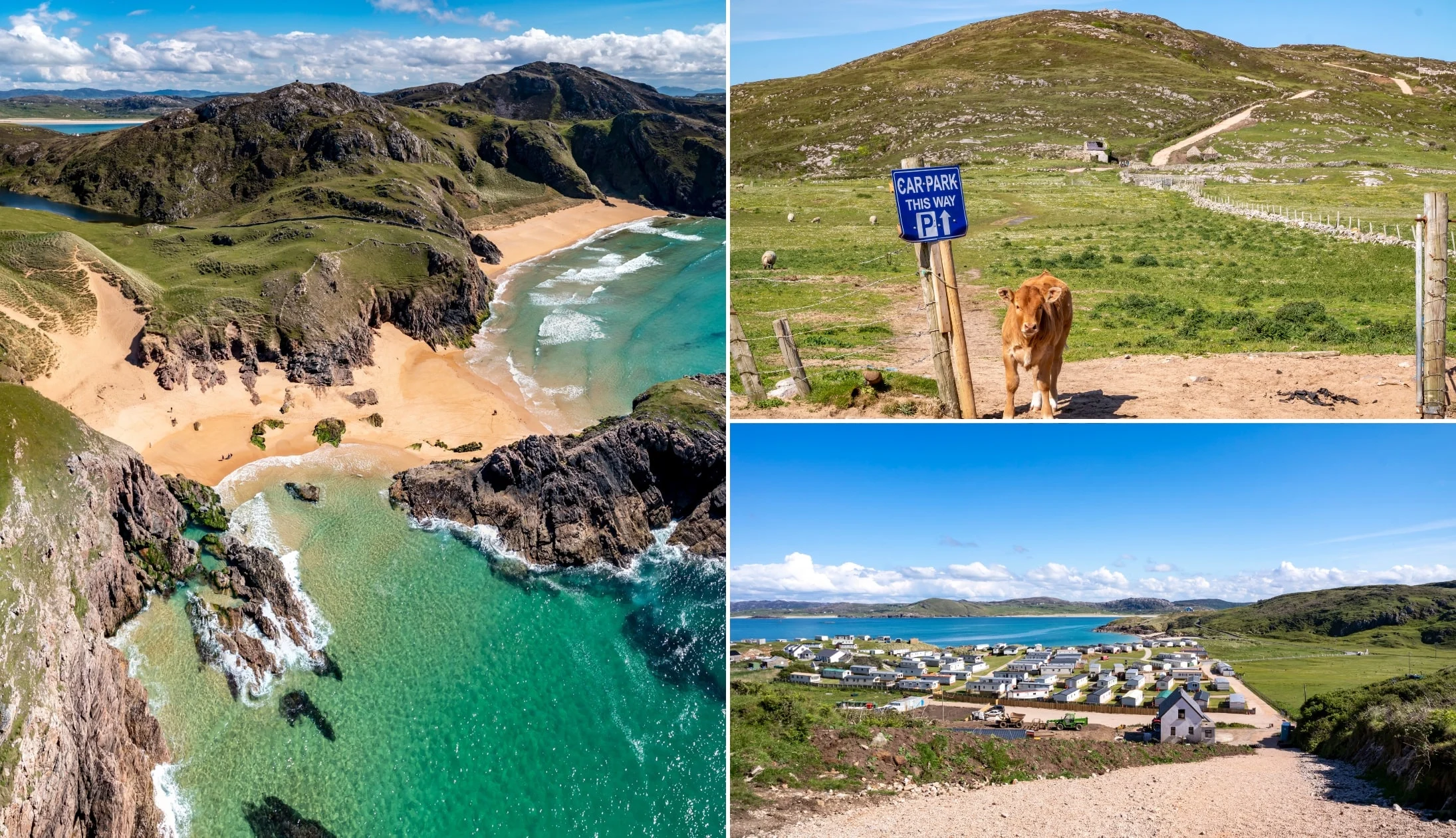
Photos via Shutterstock
Today we leave Dunfanaghy and head to Ardara, arguably one of the most charming towns in Donegal.
Before we get there, though, we’ll enjoy a nice drive along Donegal’s gorgeous coastline, exploring the sights and attractions of Rosguill and Fanad Peninsulas in north Donegal.
We’ll spend two nights in Ardara, so be sure to check out some of our top choices in terms of accommodation.
We’ve got a busy day ahead, so be sure to enjoy a hearty breakfast at your accommodation.
Our Ardara accommodation recommendations
- Places in the town: Atlantic Lodge (on the main street – superb reviews) and Hillhead House (a gorgeous, cosy spot with great reviews)
- Places outside of the town: Ashling House (top reviews and a 2-minute drive from town) and Woodhill House (superb reviews and a 3-minute drive from town)
Stop 1: Ards Forest Park
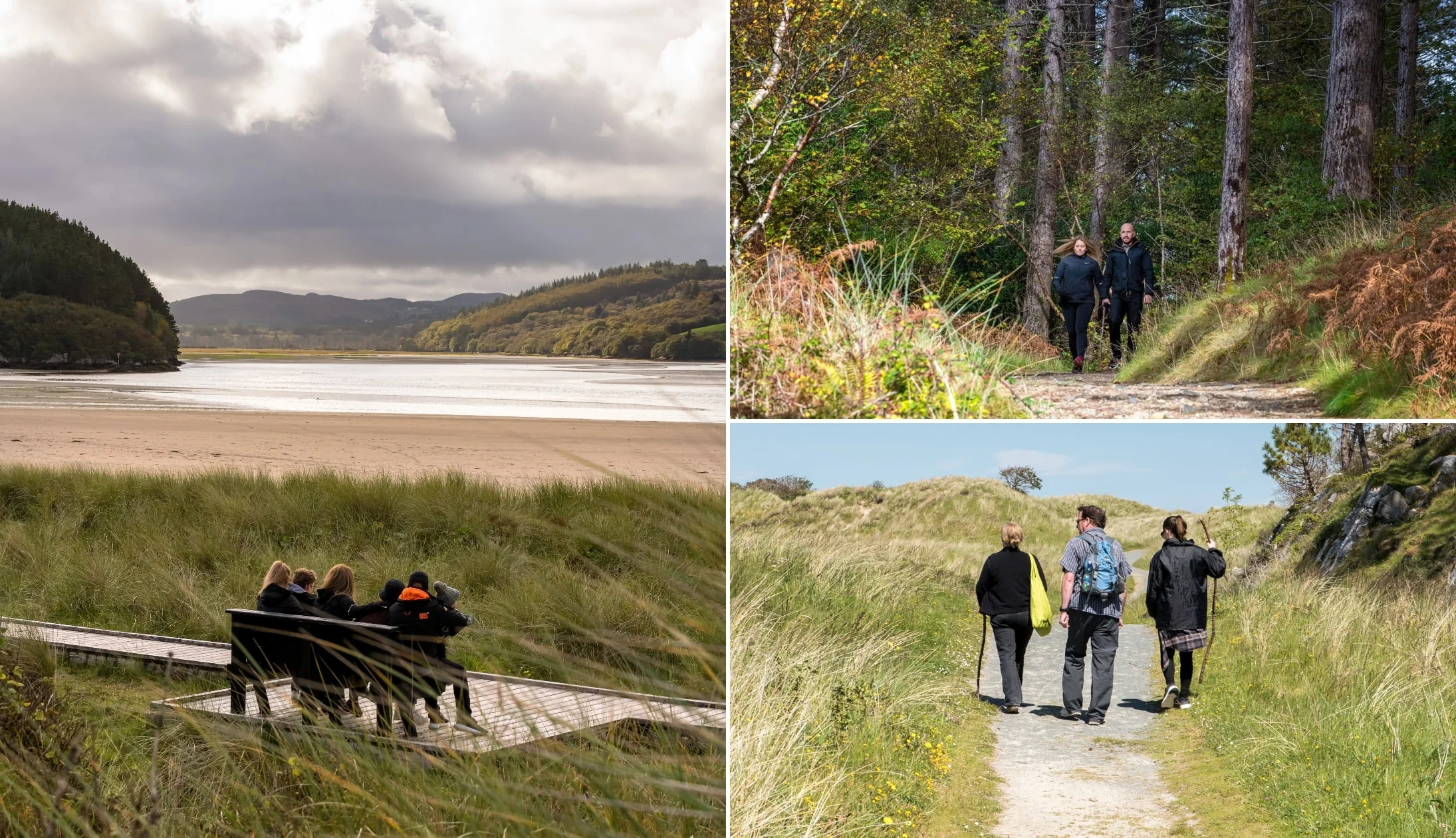
Photos courtesy of Gareth Wray Photograph
If variety is the spice of life, then Donegal’s Ards Forest Park honours that adage. Sand dunes? Check. Woodlands? Check. Salt marshes? Check. Wildlife? You’ll find it in abundance. It’s just a 10-minute drive from Dunfanaghy too. There’s a spacious car park which costs €5 to park, just bear in mind that cash isn’t accepted – you’ll need a contactless bank card.
There are countless Ards Forest Park walks that you can head off on, many of which are regarded as some of the finest walks in Donegal. The 1 km Sand Dune Trail is one of the handiest walks to enjoy for those short on time. It follows a forest track, boardwalk, and gravel path and hugs the coast while passing through woodland and the extensive sand dune complex. It shouldn’t take more than 1.5 hours to complete.
Stop 2: Downings Beach
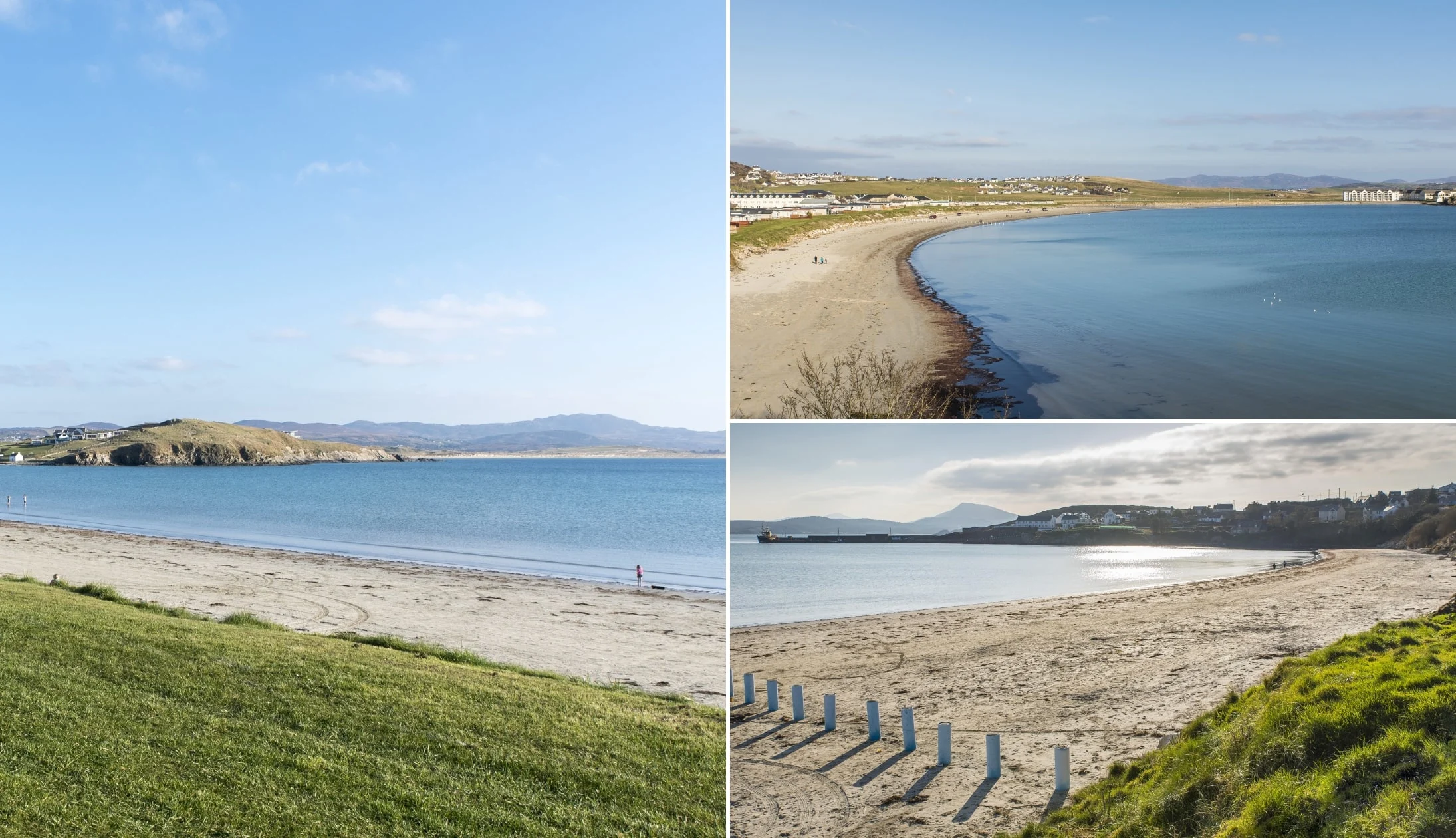
Photos via Shutterstock
Our next stop is a 25-minute drive away to Downings Blue Flag Beach. This stunning horseshoe-shaped bay of golden sand marks the beginning of the Wild Atlantic Drive around the Rosguill Peninsula.
There’s an easily accessible car park just off the Downings’ main street, so feel free to take a wander along the soft sands and paddle in the sea, or perhaps enjoy a swim if you’re feeling brave!
Otherwise, it’s well worth pulling over for a bit and admiring the scenery before heading off to our next stop.
Stop 3: Murder Hole Beach

Photos via Shutterstock
Don’t let the name put you off, Murder Hole Beach (aka Boyeeghter Bay) is one of the more unique places to visit in Donegal! To get there, follow the coast road through Doagh to the car park at Melmore Caravan Site.
The drive should take about 25 minutes and is worth it for the scenery alone. From the car park, it’s about a 15 to 20-minute walk along the trail to the beach.
The going is a little tough at times, but anyone with a moderate level of fitness should be okay with it. This is one of the more dangerous beaches in Donegal, and swimming is a definite no, due to strong rip tides.
Also, be sure to check the tide times, as a large part of the beach, including the sea cave, gets blocked off at high tide.
Aim to visit as the tide is going out to enjoy plenty of time to explore. Heading back to the car park will take another 15 to 20 minutes, so plan for at least an hour here if you want to explore.
Stop 4: Lunch in Downings
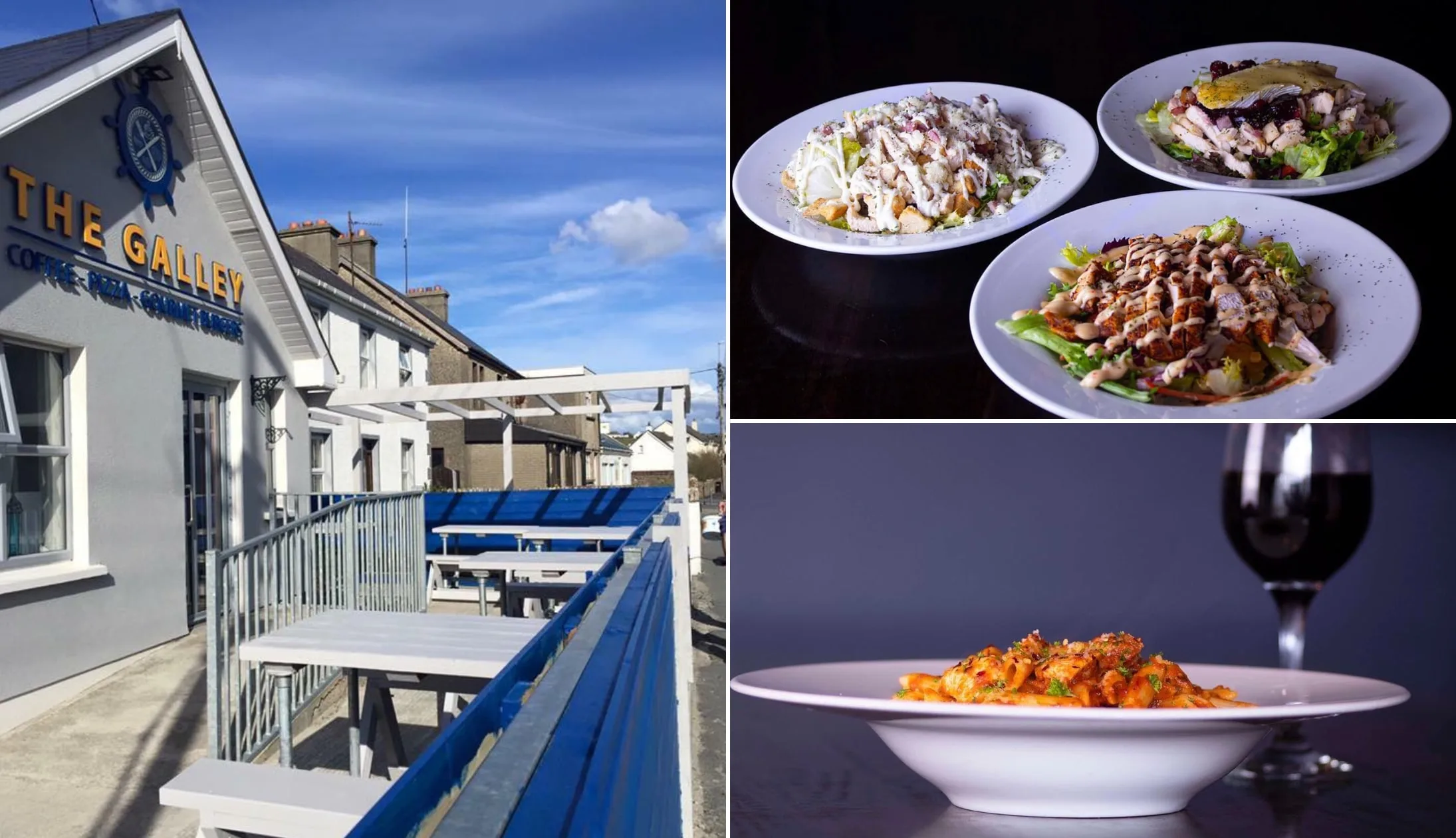
Photos via The Galley on FB
For lunch, head back to the seaside village of Downings, this time a 15-minute drive via Cloughbane. The Galley offers an extensive menu that includes pizzas, sandwiches, wraps, salads, toasties, burgers, and a range of tasty desserts. You’ll find a decent amount of parking next door.
For seafood and fish and chips, head for Fisk Seafood Bar. The battered fish tacos are amazing, and they offer a bunch of small plates so you can try a good variety. You’ll find convenient parking right across the road too.
Stop 5: Fanad Head Lighthouse
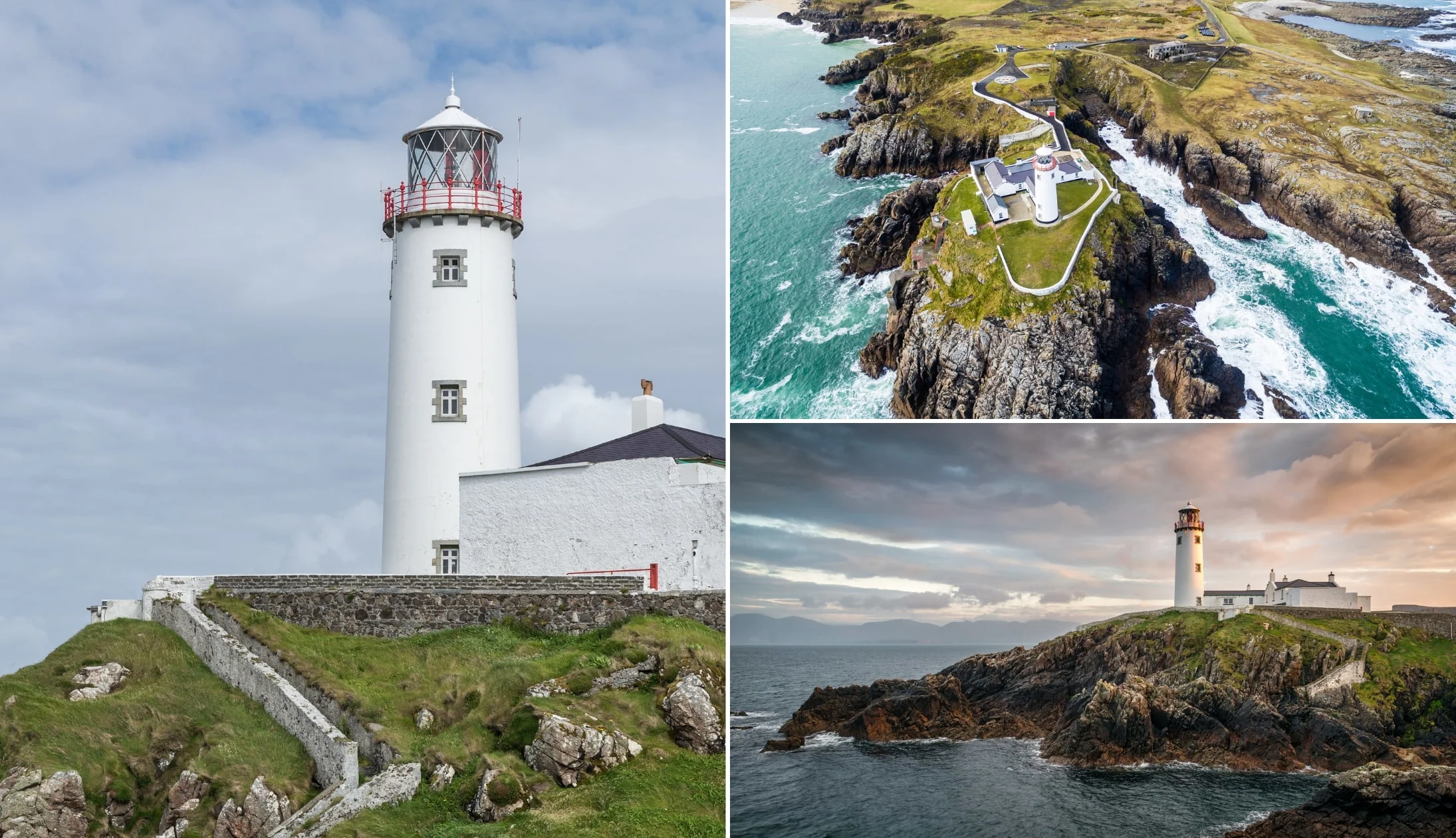
Photos via Shutterstock
Enjoy a nice 30-minute drive while you digest your lunch before arriving at our next stop, Fanad Head Lighthouse. There’s something immensely special about this place. Especially when you visit during the off-season, as the chances are you’ll have the whole area to yourself. Perched on the edge of the dramatic coastline of northern Donegal, the working lighthouse dates back to 1817.
You’ll find plenty of parking right next to the lighthouse, and from there you can get a fantastic view of the tower against a gorgeous backdrop. If you want to get closer, there are two tours to enjoy. The first is a self-guided tour of the grounds and the exhibitions, which costs €4 for an adult. The guided tour offers the same but also takes you up to the tower for some amazing views. It costs €10 per adult.
Stop 6: Portsalon Beach
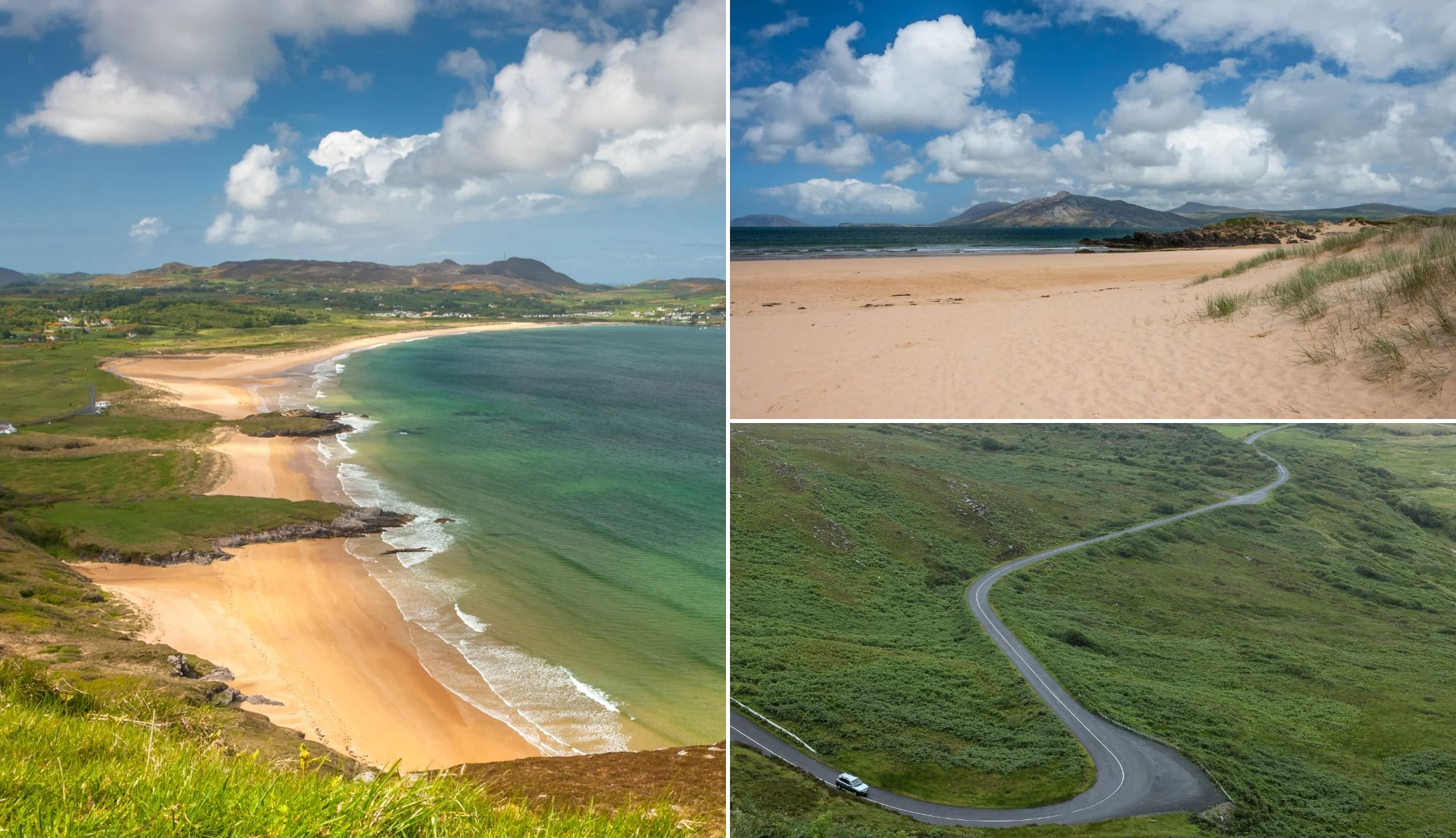
Photos via Shutterstock
The mighty Portsalon Beach is a short but spectacular 20-minute drive from Fanad Head Lighthouse on the east side of the peninsula. There’s parking near the southern end of the beach, making it easy to stop and enjoy all the beach has to offer.
Also known as Ballymastocker Bay, Portsalon is a beautiful Blue Flag beach with long stretches of sand for rambling, clear water to swim in, plenty of waves for surfers, and sheltered coves for escaping the wind. The views from this beach are simply breathtaking and it’s well worth taking a gentle stroll along the 1.5 km stretch of sand.
Stop 7: Ardara
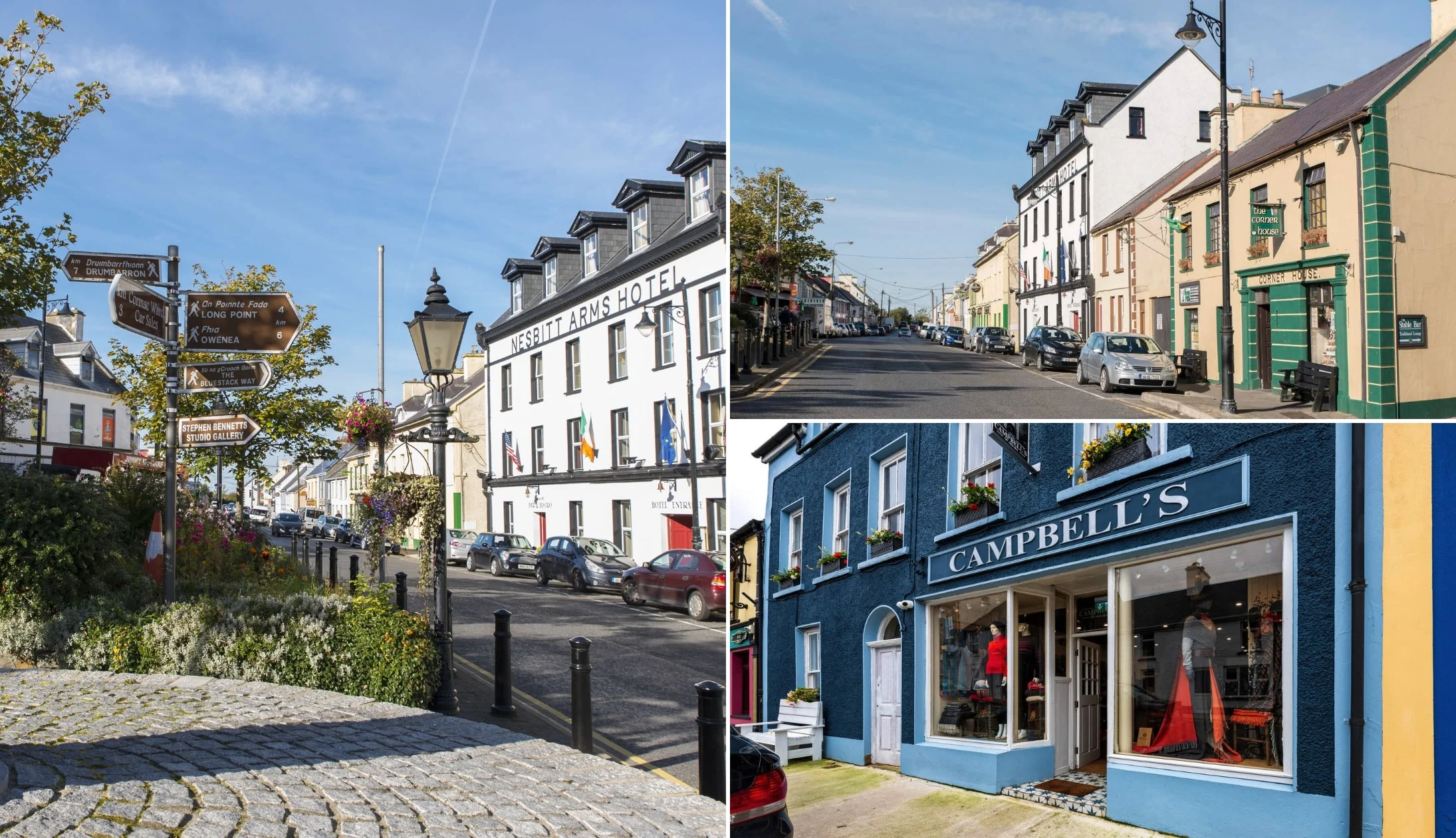
Photo left and top right: Martin Fleming. Bottom right: Gareth Wray
After an eventful day, it’s time to head to your final stop and the place you’ll be calling home for the next two nights, Ardara.
It’ll take about an hour and fifteen minutes to drive to Ardara from Portsalon Beach, cutting through the spectacular Donegal countryside.
The village is a wonderful alternative to the hustle and bustle of nearby Donegal town and a couple of days here offers an insight into life in a quaint Irish village.
Once you arrive, check into your accommodation, freshen up, and see what all the fuss is about!
Stop 8: Dinner, drinks and live music
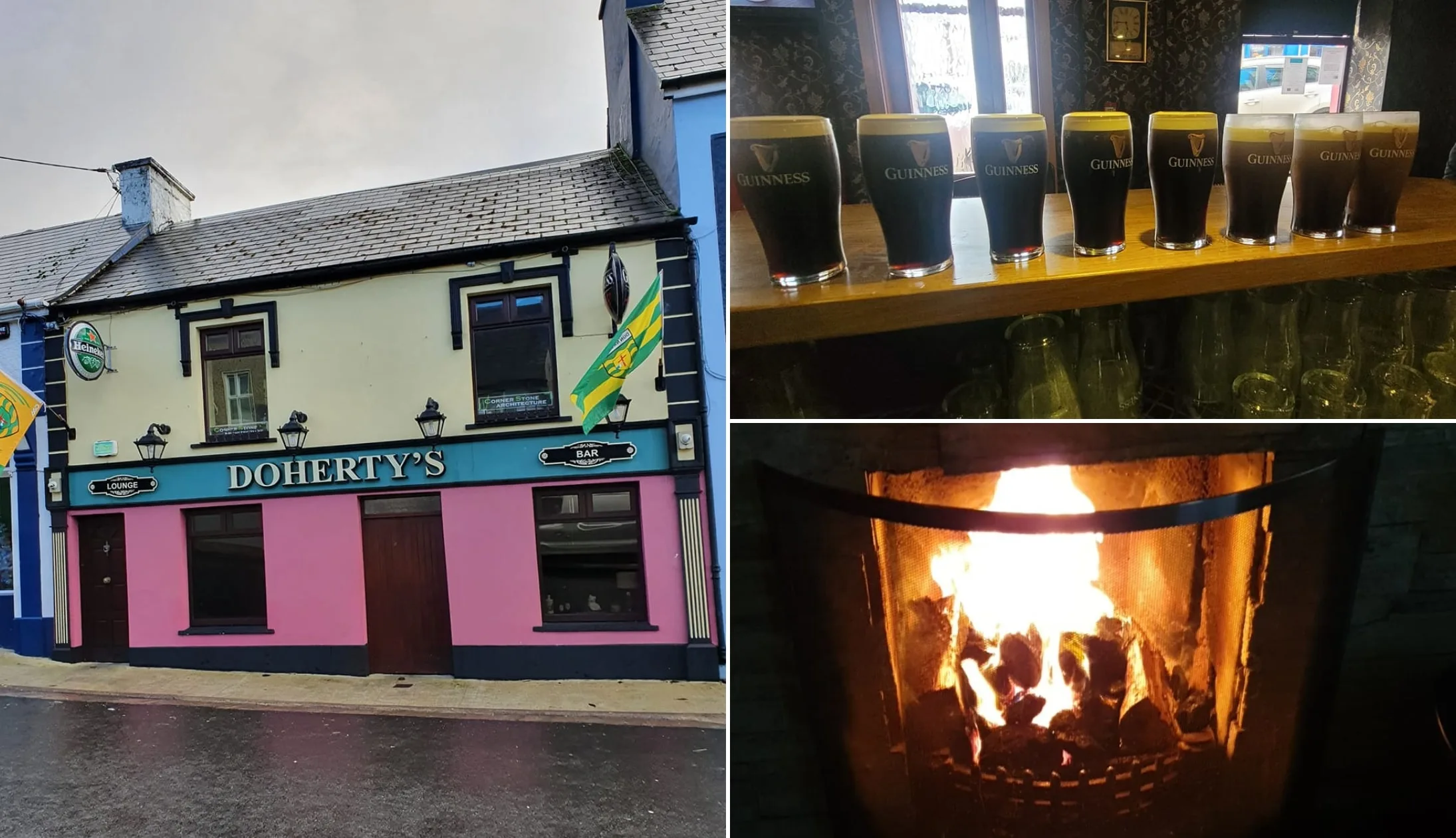
Photos via Doherty’s Bar on FB
Ardara showcases life in ‘rural Ireland’ at its very best. The village is beautifully maintained, there are heaps of traditional pubs and countless restaurants where you’ll get a fine feed. Perfect as dinner time approaches!
Our Ardara food recommendations
Nancy’s has been a staple of Ardara for many years now, and its age is reflected in the lovely rustic interior that’s full of wood finishes and stone floors. Not only will you be set for a few creamy pints here, but they also do a fantastic food selection, including fresh oysters.
You’ll also get a warm welcome at Mickalene’s on Main Street. Winner of Ulster Gastro Pub of the Year 2019 at the Food Awards Ireland, their fare is hearty, well-sourced and tasty.
Our Ardara pub recommendations
There’s certainly no shortage of great pubs in Ardara. If you were to construct a pub crawl of Ardara, then Teague’s Bar at the top of Main Street would be a fine place to start. Its unfussy décor and friendly atmosphere mean you can sit back and enjoy your pint without too much bother.
Lying at the other end of my imaginary pub crawl is Doherty’s, where its bright pink and green exterior would be hard to miss, even after a few too many! There’s live music and a fine food selection here (including pizza) to keep the good times rolling.
The Corner House is definitely one of the best places to catch live music and regular trad sessions in Ardara. Settled right at the apex of the town centre, the Corner House Bar is also steeped in the history of the village.
Day 4: Donegal cliffs and coast
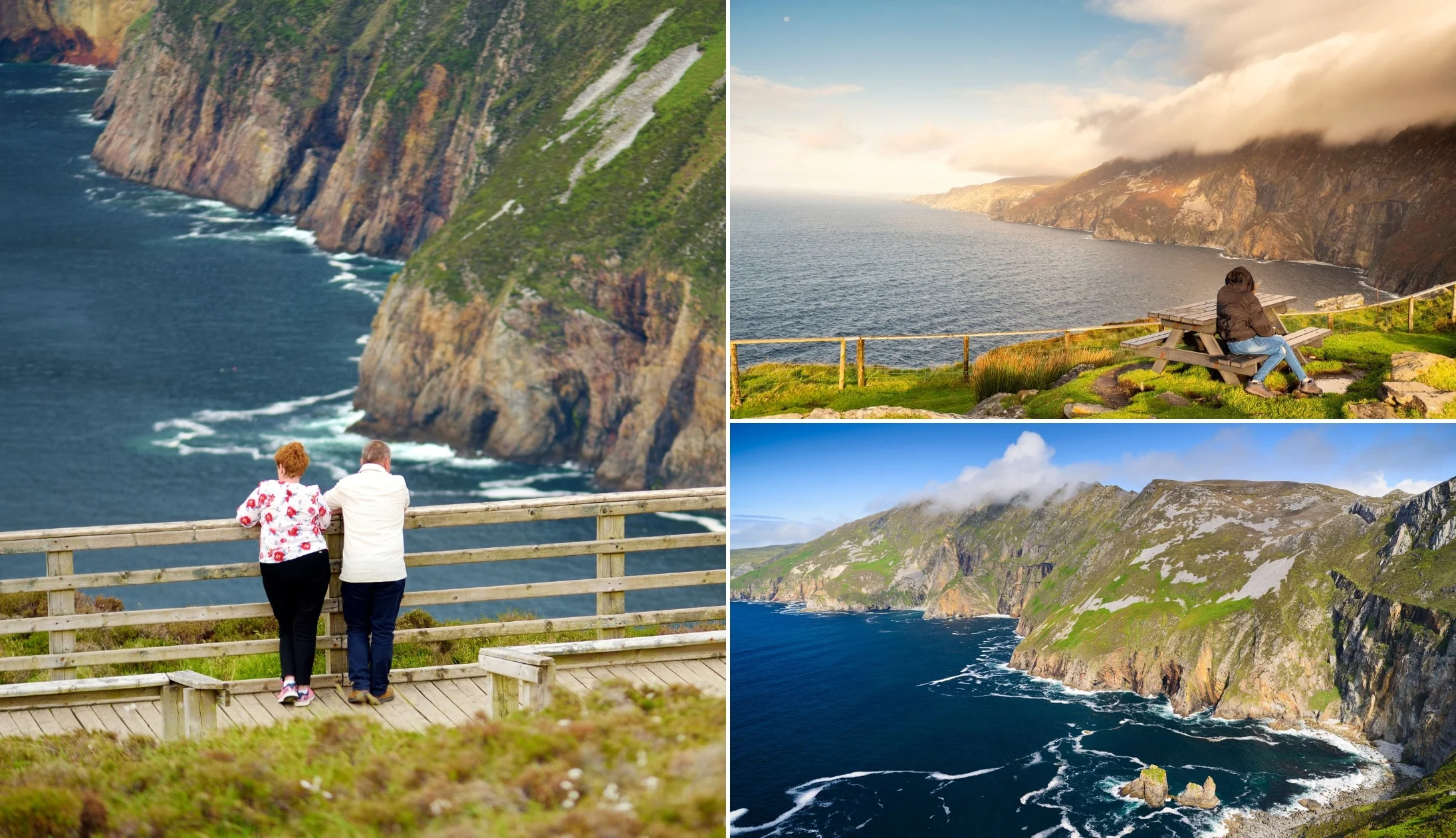
Photos via Shutterstock
Donegal’s west coast is wild and rugged, offering up some of the most spectacular scenery in the country. Today, we’ll be enjoying a drive that takes in some of the most gorgeous landscapes in the area.
Nature lovers, this day is for you! Start your day well with a hearty breakfast, either at your accommodation or at one of the cafes in town.
The all-day breakfast at Charlie’s West End Café is not to be missed, plus they do a veggie version too. Corby Cafe is also highly recommended, with quality coffee, tasty Eggs Benedict, and of course, a sumptuous full Irish.
Stop 1: Glengesh Pass
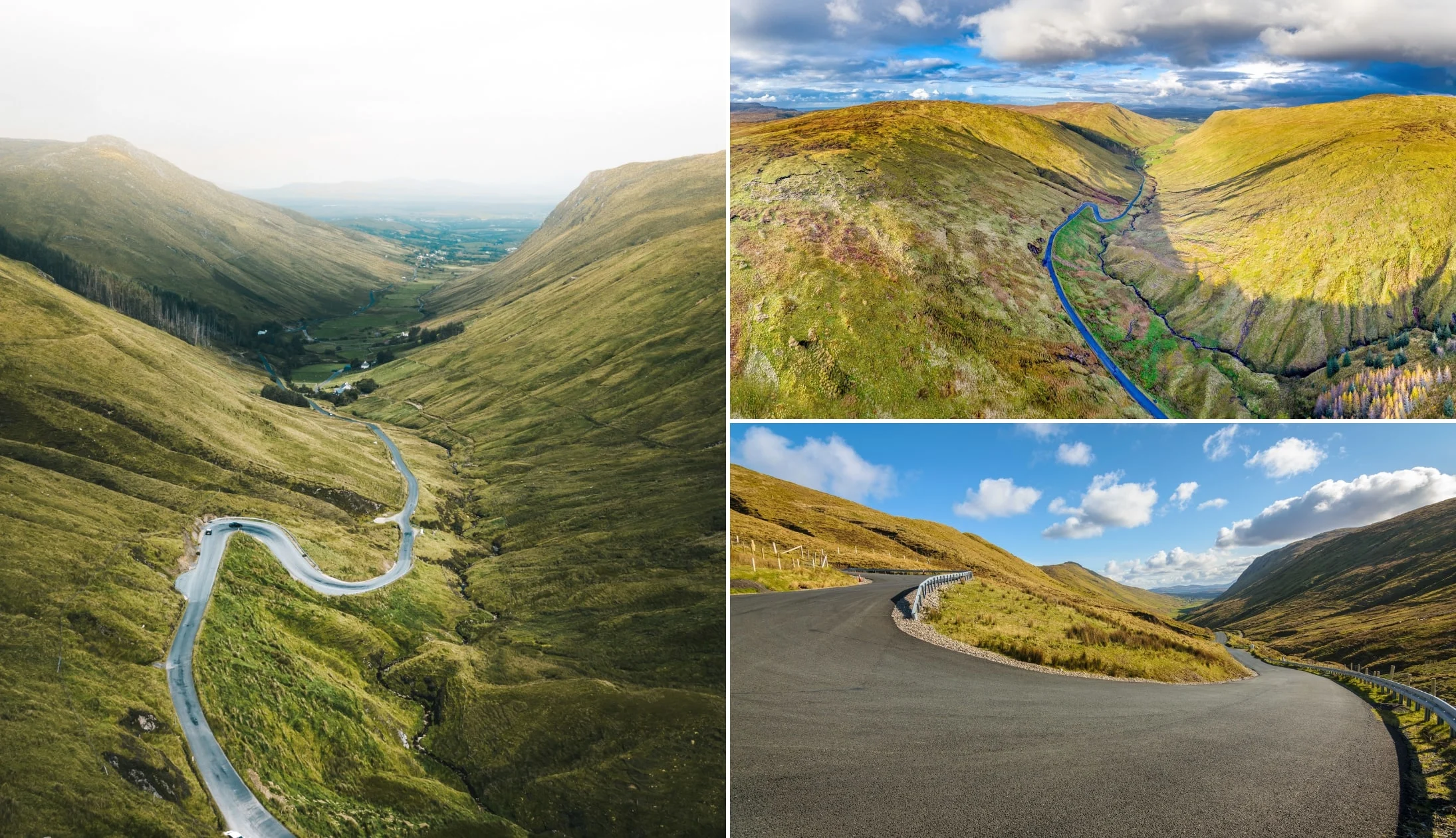
Photos via Shutterstock
Roads like the one at Glengesh Pass in Donegal make Ireland an absolute joy to explore.
Glengesh (which means ‘Glen of the Swans’) is a high mountain pass that cuts through the Glengesh and Mulmosog mountains and links the towns of Ardara and Glencolumbkille.
Over the course of your spin, you’ll encounter quiet open countryside, plenty of green fields, narrow roads and sheep… lots and lots of sheep!
Take it easy on the bends, visibility can be poor, and the roads are narrow, so there’s no need to rush.
The epic Glengesh Viewing Point has space for around seven cars and is just 12 minutes from Ardara. Park up here and soak up the epic views through the valley before driving on to our next stop.
Stop 2: Assaranca Waterfall
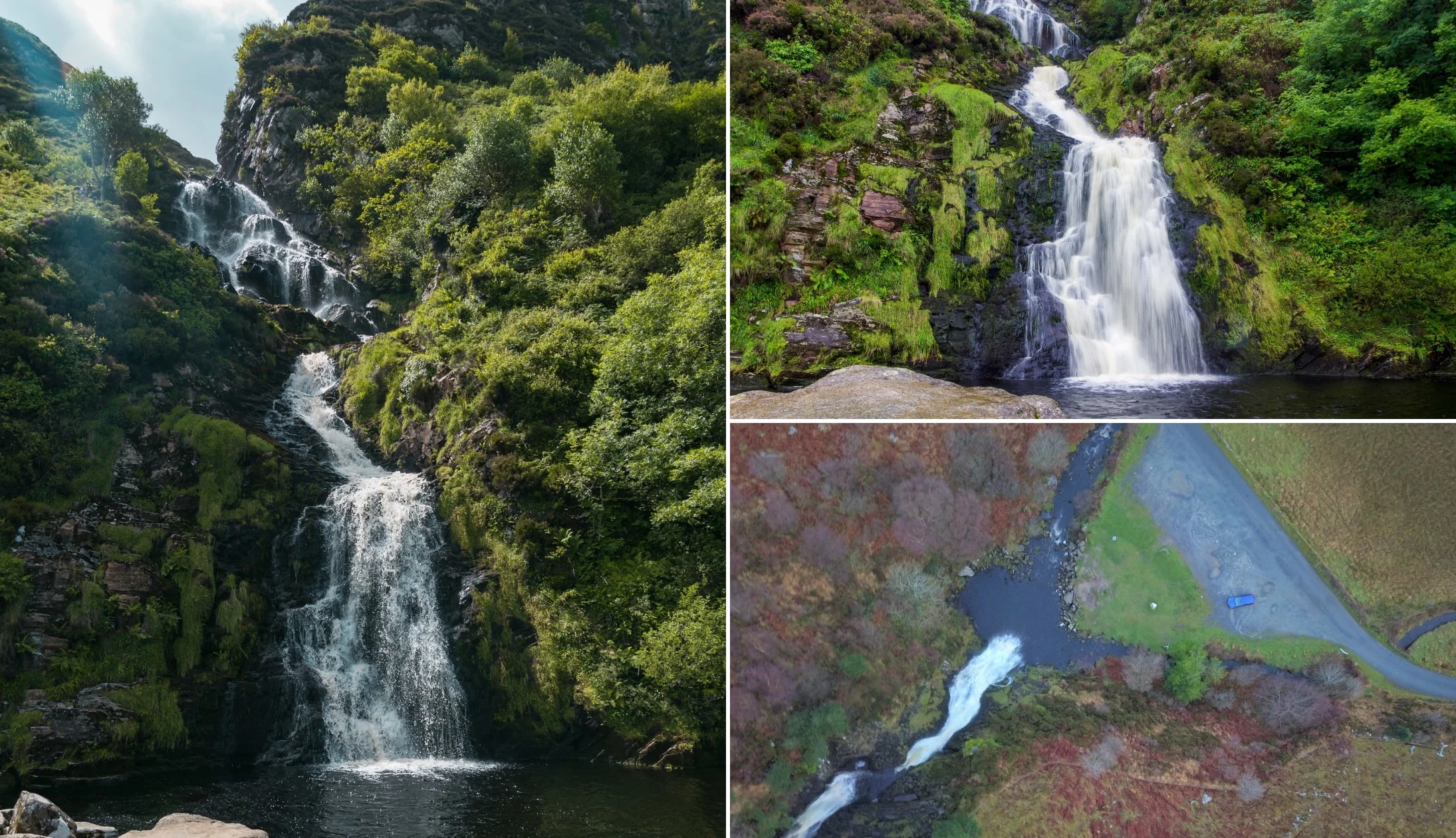
Photos via Shutterstock
Our next stop is the lovely Assaranca Waterfall. Now, we’re going to double back here, to save doing the same later on. Plus, we’re sure you won’t mind driving back up the Glengesh Pass! It’ll take about 20 minutes to reach the falls.
The mighty Assaranca Waterfall is a spectacular sight that’s right next to the road and is quite possibly one of the most impressive waterfalls in Donegal. You can, quite literally, park up right next to them and soak up the sights and sounds of Assaranca from a few feet away.
It’s natural attractions like this that make Ireland an absolute joy to explore – there’s no fancy visitor centre and no fuss – just nature at its finest!
Stop 3: Maghera Beach and Caves
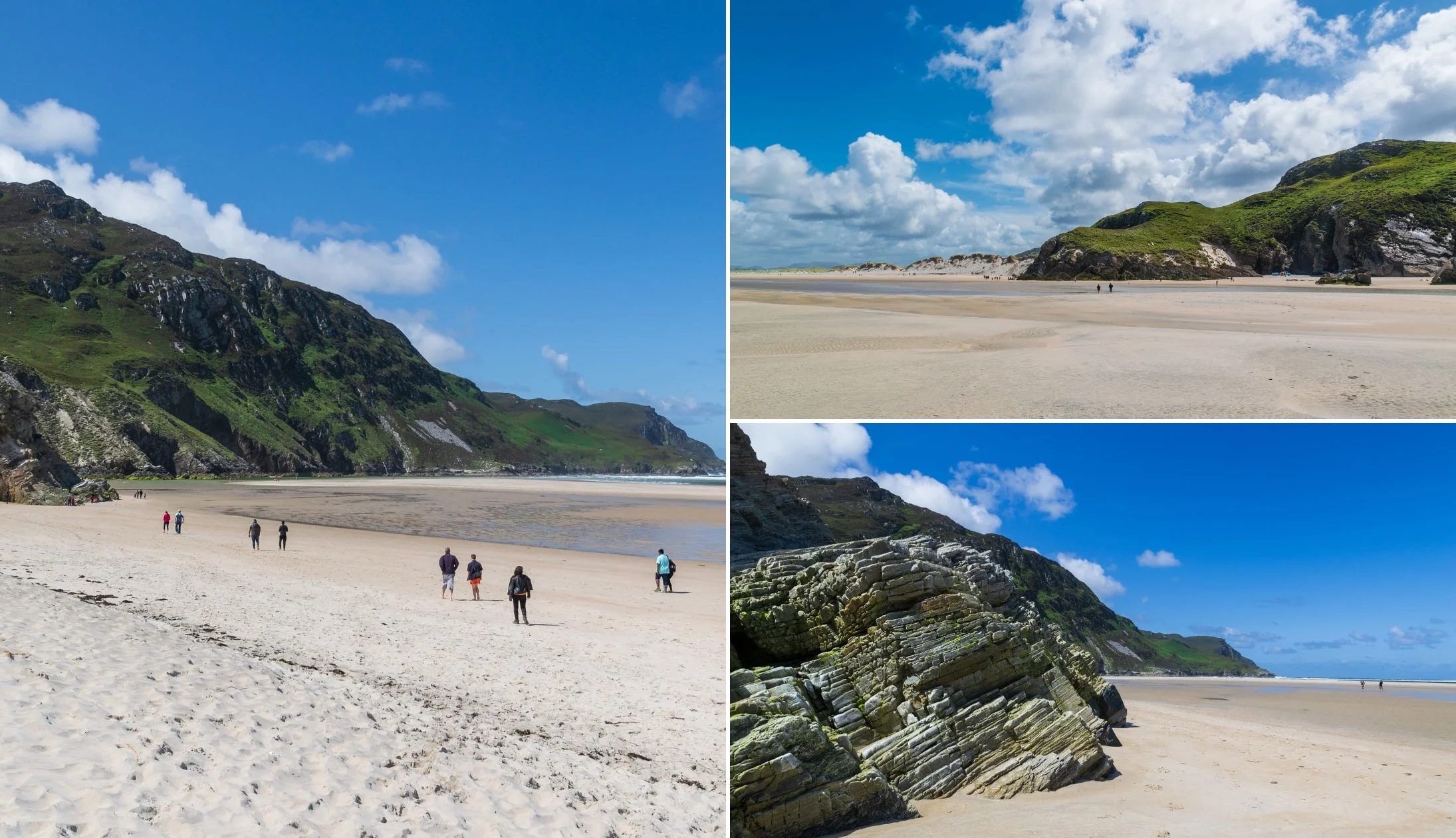
Photos via Shutterstock
Maghera Beach, another stunning natural sight is just around the corner, just a 2-minute drive away. There’s a car park here that’s run by a local fella who charges a very reasonable €3 per car. It’s well worth the cost, as he also single-handedly maintains the pathways to the beach and caves.
It’s a bit of a walk into the beach from the car park, but as you stroll, you’ll be treated to stunning views and your breath will catch when the beach itself comes into sight. Perfect white sand, deep blue water, and dunes for shelter if the wind is strong, entice tourists from all over the world to visit this hidden gem.
The caves are only accessible at low tide, so be sure to check the tide times in advance if you want to visit them. With more than 20 caves, 8 arches, and 5 tunnels, there’s a lot to see here. According to legend, locals sheltered in the caves from Cromwell or the Vikings, depending on who you talk to.
Stop 4: Glencolumbkille for Lunch
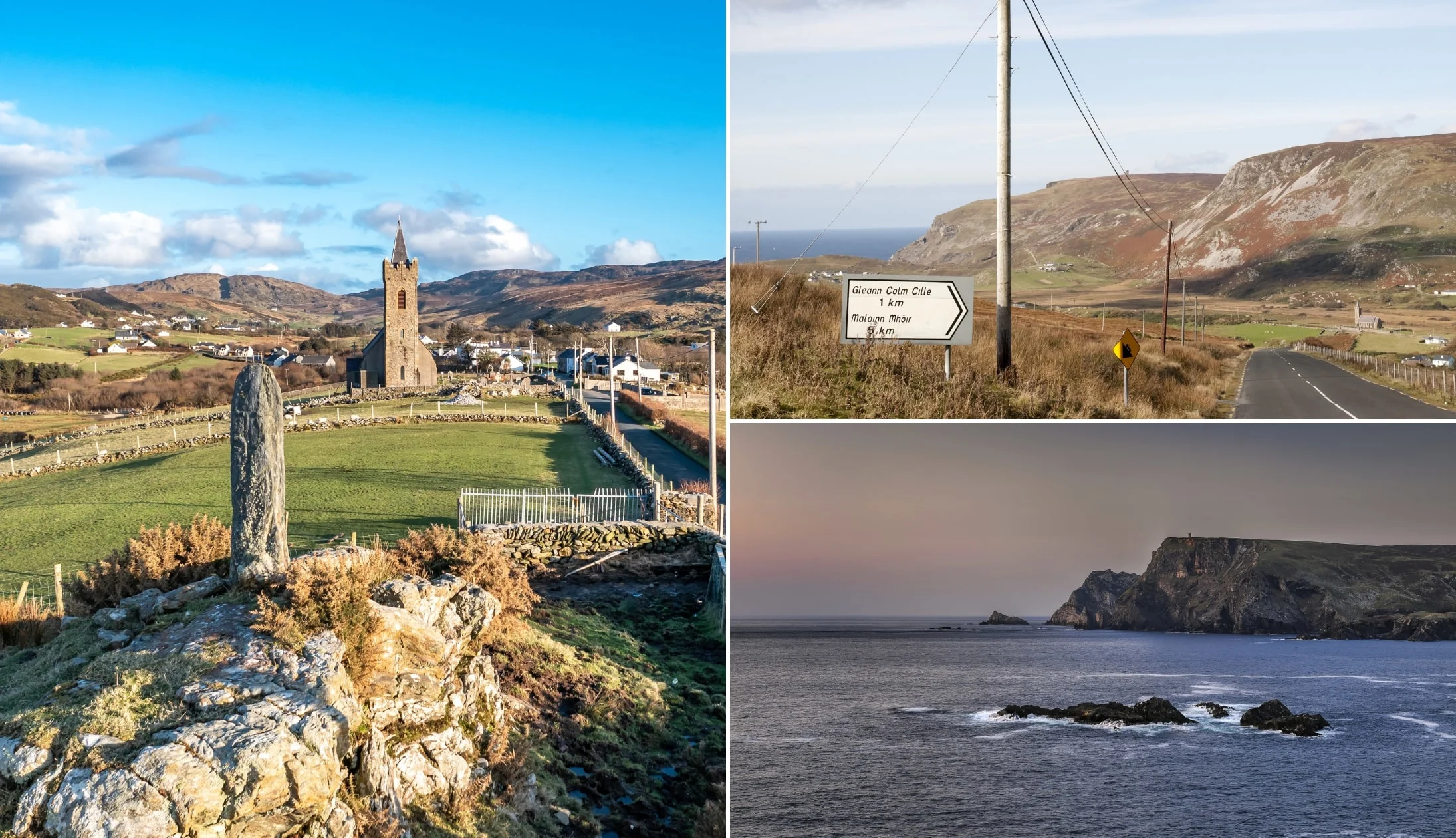
Photos via Shutterstock
As lunchtime draws near, enjoy a 28-minute drive through more gorgeous scenery to Glencolumbkille. Once you reach the pretty little town, head for either An Cistin or Cafe Blasta.
Both have their own spacious car parks, so there’s no need to worry about that. The seafood chowder at Cafe Blasta is superb and one of the best things ever on a cold, drizzly day.
At An Cistin, you’ll find an extensive menu that takes in dishes from around the world.
Stop 5: Malin Beg (Sliver Strand)
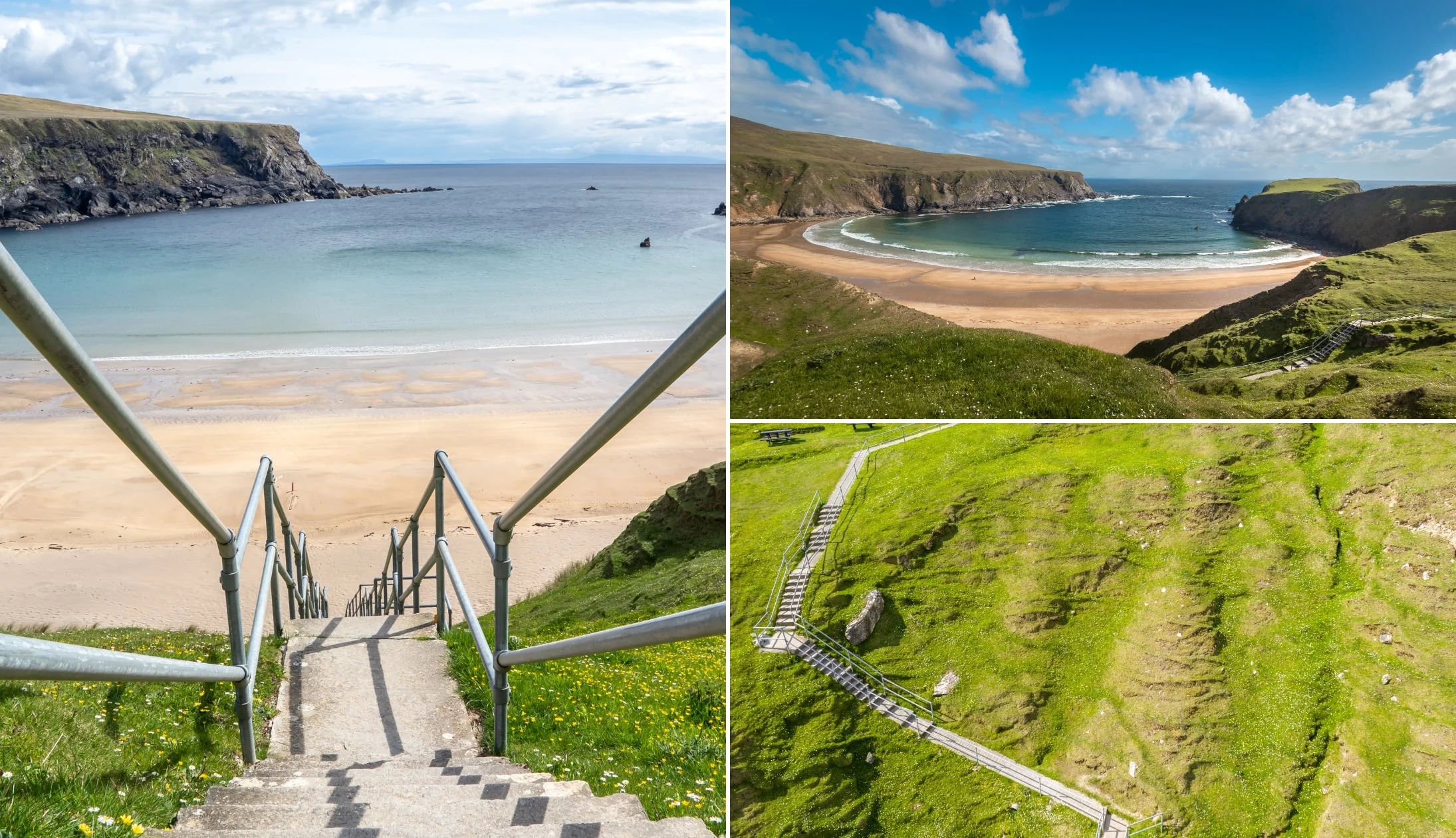
Photos via Shutterstock
Once you’ve had a good feed, it’s back on the road to visit another beautiful beach. But before you get there, take time to enjoy the epic scenery along the 14-minute coast drive from Glencolumbkille to Malin Beg AKA Silver Strand.
Slightly off the beaten track, this is a remarkably peaceful beach to visit. The horseshoe-shaped bay is enclosed by cliffs that tower all around, offering a sense of tranquillity and utter beauty.
With crystal clear waters, it is a good beach for capable swimmers but bear in mind that there isn’t a lifeguard service here.
Warning: There’s 174 steps you’ll need to go down and up if you want to get to the sand, which won’t suit those of you with limited mobility
Stop 6: Sliabh Liag Cliffs

Photos via Shutterstock
Sliabh Liag, or the Slieve League Cliffs, are the highest sea cliffs on mainland Ireland, towering a little over 600 metres above the sea. Three times higher than the cliffs of Moher, they boast spectacular scenery. It’ll take about half an hour to drive from Sliver Strand, and you have a couple of options in terms of parking.
Having said that, we strongly recommend you stick ‘Sliabh Liag Cliff Experience’ into Google Maps and park at the visitor centre there. From here, you can take a shuttle bus to the viewpoint for around €6. If you’re up for it, the steep walk up to the cliffs should take about 45 minutes each way.
Alternatively, you can drive to the upper car park and from there, it’s just a fifteen-minute stroll to Bunglass Point, one of the best viewpoints for the mighty cliffs. However, this car park tends to be closed during the summer for all but coaches and those with mobility issues. Also, with a narrow road, often full of hikers, we don’t recommend it.
Following the Sliabh Liag walk, you’ll come across a WWII Eire coastal sign and enjoy breathtaking scenery at every turn. It’s also possible to organise a Slieve League Boat Tour, which is another fantastic way to see the cliffs.
Stop 7: Back to Ardara

Photo left and top right: Martin Fleming. Bottom right: Gareth Wray
After enjoying the epic Sliabh Liag Cliffs, jump back in the car and enjoy the 35-minute drive back to Ardara.
Once more, you’ll be passing through spectacular landscapes, and for good measure, why not drive back up the Glengesh Pass one last time? Drop by your accommodation, freshen up, and then hit the town once more.
Stop 8: Dinner, drinks and live music

Photos via Doherty’s Bar on FB
You’ll be leaving Ardara tomorrow, so make sure to visit any of the places you missed last night!
Our Ardara food recommendations
Nancy’s has been a staple of Ardara for many years now and its age is reflected in the lovely rustic interior that’s full of wood finishes and stone floors. Not only will you be set for a few creamy pints here, but they also do a fantastic food selection, including fresh oysters.
You’ll also get a warm welcome at Mickalene’s on Main Street. Winner of Ulster Gastro Pub of the Year 2019 at the Food Awards Ireland, their fare is hearty, well-sourced and tasty.
Our Ardara pub recommendations
There’s certainly no shortage of great pubs in Ardara. If you were to construct a pub crawl of Ardara, then Teague’s Bar at the top of Main Street would be a fine place to start. Its unfussy décor and friendly atmosphere mean you can sit back and enjoy your pint without too much bother.
Lying at the other end of my imaginary pub crawl is Doherty’s, where its bright pink and green exterior would be hard to miss, even after a few too many! There’s live music and a fine food selection here (including pizza) to keep the good times rolling.
The Corner House is definitely one of the best places to catch live music and regular trad sessions in Ardara. Settled right at the apex of the town centre, the Corner House Bar is also steeped in the history of the village.
Day 5: Donegal and Sligo Town
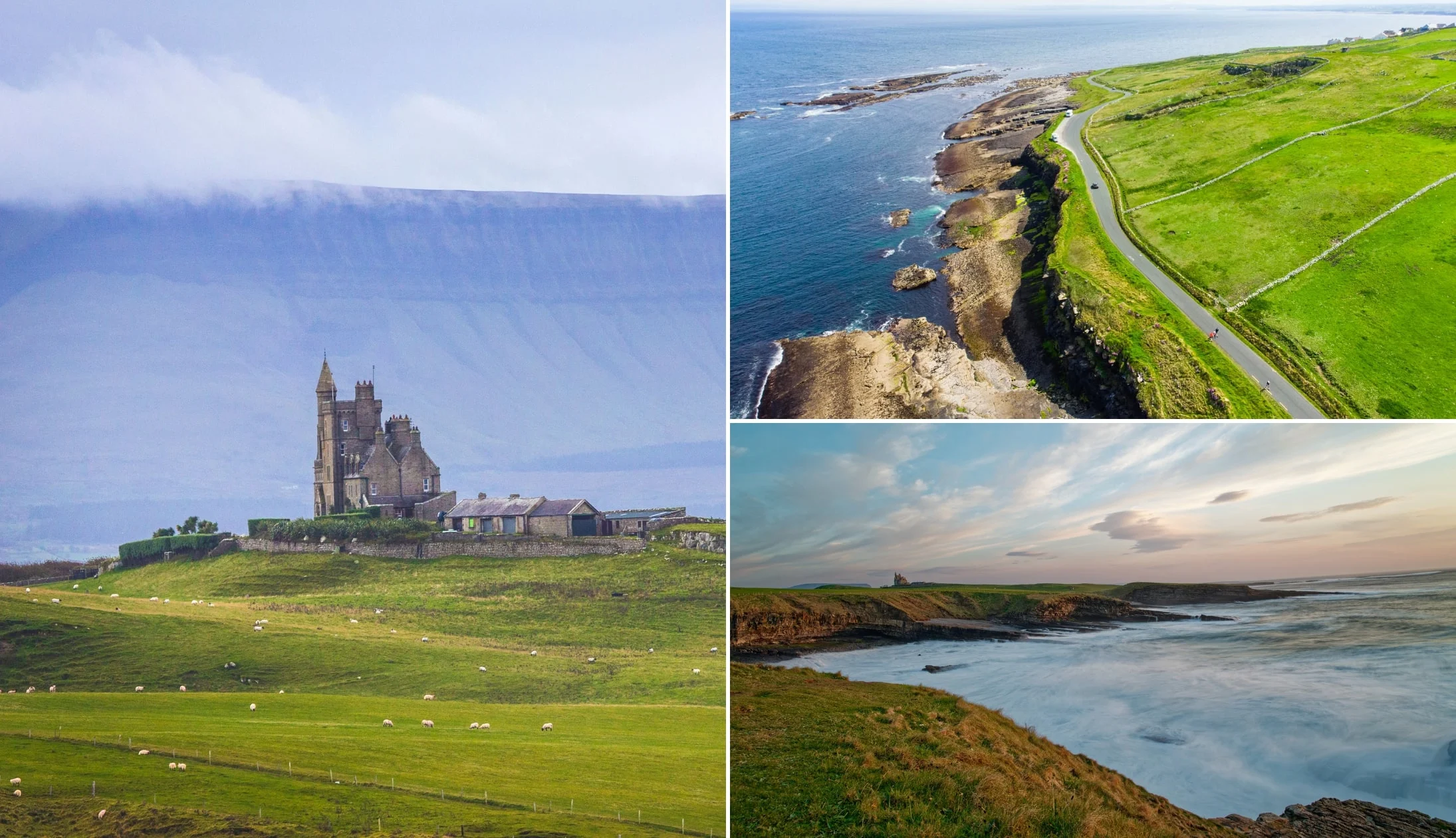
Photos via Shutterstock
Today we’ll be heading out of Ardara and making our way to Sligo Town.
But we’re not done with Donegal yet! Along the way, we’ll stop off at a few more Donegal sights, including Donegal Town and the mighty Donegal Castle.
We’ve got a busy morning coming up, so enjoy a good breakfast at your accommodation or nip into the Courthouse Restaurant or Charlie’s West End Cafe.
You’ll be spending two nights in Sligo so have a look at our top picks for accommodation.
Our Sligo accommodation recommendations
- Budget: Old Fort B&B (great reviews and a 7-minute spin from town) and Tranquility B&B (solid reviews and a 5-minute drive from town)
- Mid-range: Riverside Hotel (central with great reviews) and Sligo Southern Hotel (10-minute stroll into town and nice and comfy)
- Upper-range: The Glasshouse (right by the river in the town – close to everything) and the Clayton Hotel (5-minute drive to town with swimming pool)
Stop 1: Donegal Town
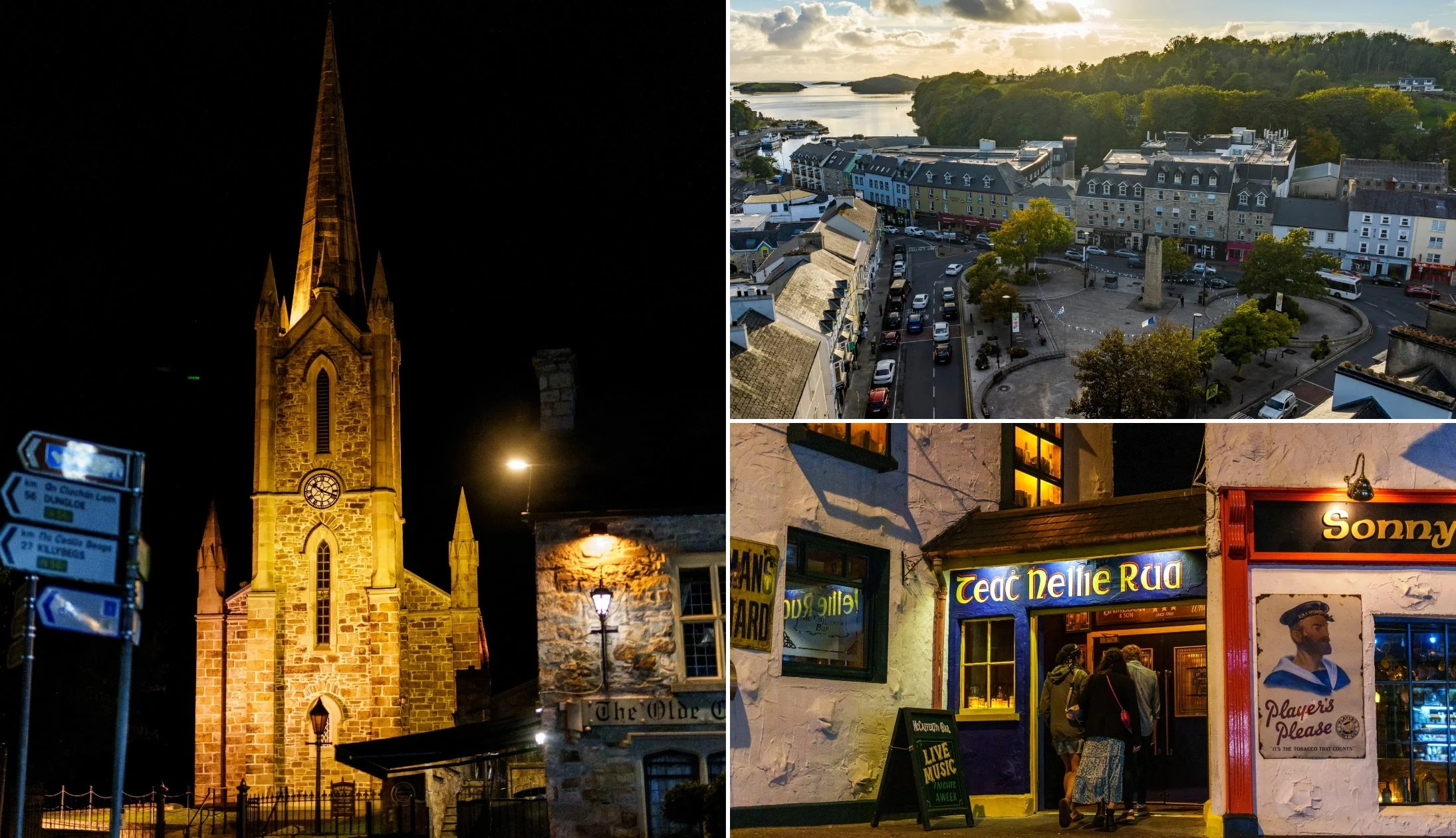
Photos courtesy Failte Ireland
It’s a 30-minute drive to our first stop of the day, Donegal Town. Situated on the River Eske at the head of Donegal Bay, Donegal Town is popular with tourists, but that’s not really new.
The port was invaded by Vikings in the 8th century, which gave it the name Dun na nGall, meaning “Fort of the Foreigners”. Donegal Town is a lovely place to stroll around, so grab a coffee—Coffee on Sene by the tourist information on Quay Street is good—and enjoy the sights.
It’s a lovely place for a wander with attractive buildings, a 2.5km riverside walk and a restored 15th-century castle rising above the rooftops.
The town has colourful cottages, historic pubs, independent shops, a few churches and a famine graveyard to keep you busy for a while. When you’re done, head towards the castle for our next stop.
Stop 2: Donegal Castle

Photos via Shutterstock
It is said that when Donegal Castle was originally built in 1474, it was the most impressive of the many Irish castles the island boasted at the time.
Former seat of the mighty O’Donnell clan, it’s seen many battles and is steeped in history. One of the best ways to learn more is to take a tour of the grounds.
Along the way, you’ll take in barrel-vaulted storerooms, a magnificent carved fireplace, and an uneven “trip” stairwell to catch enemy intruders unawares. There are also plenty of exhibits along the way, and it’s well worth the €5 admission fee.
Stop 3: Bundoran Beach
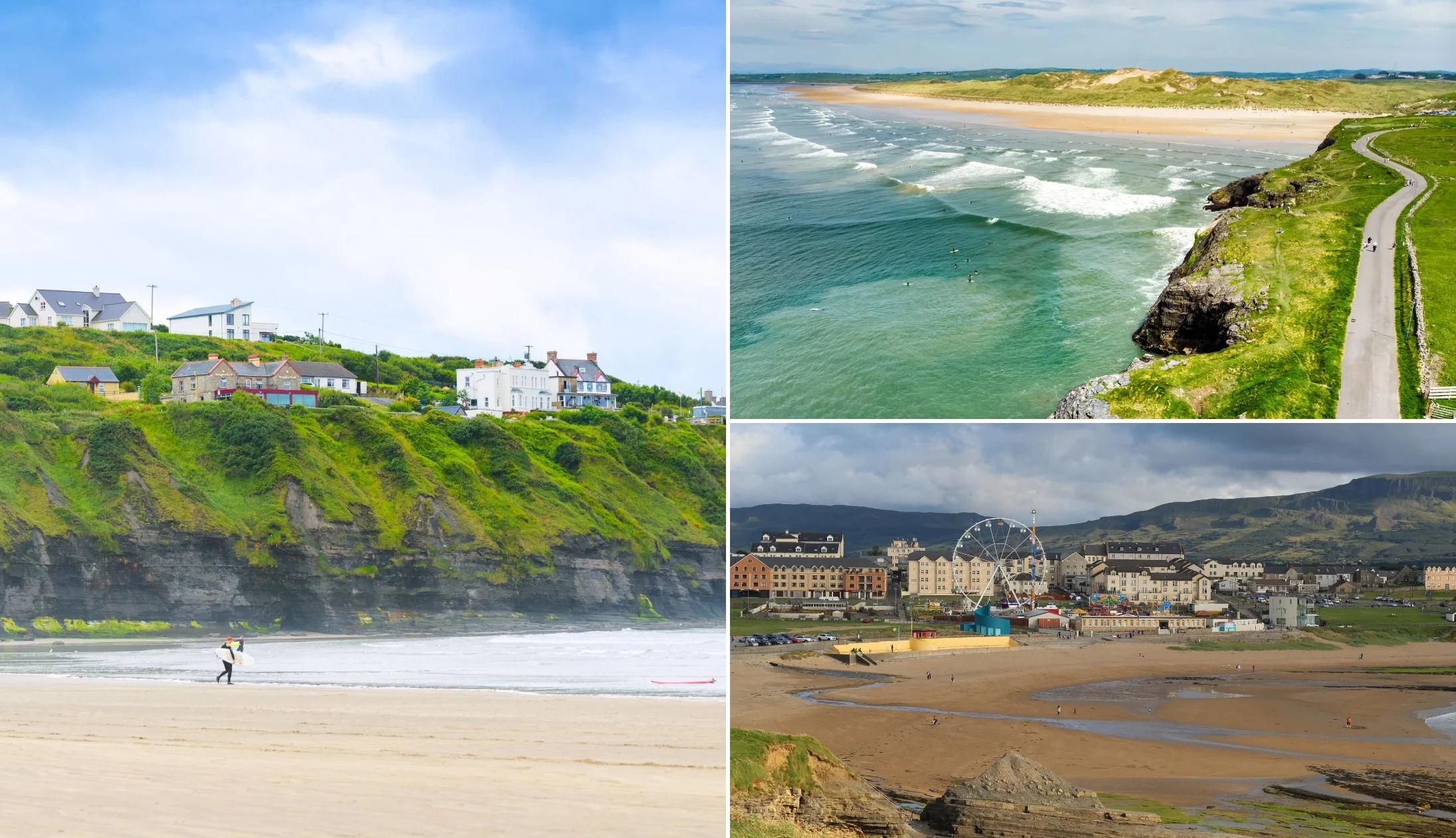
Photos via Shutterstock
Next, we’ll head south to Bundoran Beach. It’s around a 30-minute drive to this sandy Blue Flag Beach, which boasts an adventure park, a spacious car park, and a little coffee shop.
Best of all is the Rougey Cliff Walk. If you’ve got the energy for it, it’s a nice 4.5 km looped walk that starts at the tourist office on the main street.
The walk is pretty easy-going and mostly flat. It circles the headland before traversing the clifftops. Amazing views can be seen all around, taking in bays, islands, and mountains.
One of the main attractions is the legendary “Wishing Chair”. Hewn from solid rock, it’s marked by an information board that provides instructions on how to make your wish successfully.
It shouldn’t take more than an hour and a half to complete the walk. Just bear in mind, we have one more stop planned before lunch, so it’s up to you whether you want to do the walk or just enjoy the beach.
Stop 4: Mullaghmore Beach and Classiebawn Castle

Photos via Shutterstock
Next, we’ll enjoy a scenic 15-minute drive before crossing into County Sligo and arriving at the gorgeous Mullaghmore Beach. It boasts a 3 km stretch of golden sands, backed by sand dunes and mountains.
The beach sits a short drive from the impressive Classiebawn Castle, which looks like it’s been plucked from a fairy tale.
It’s privately owned, so you can’t visit, but backed by the Dartry Mountains, it offers many superb photo opportunities.
Stop 5: Sligo Town
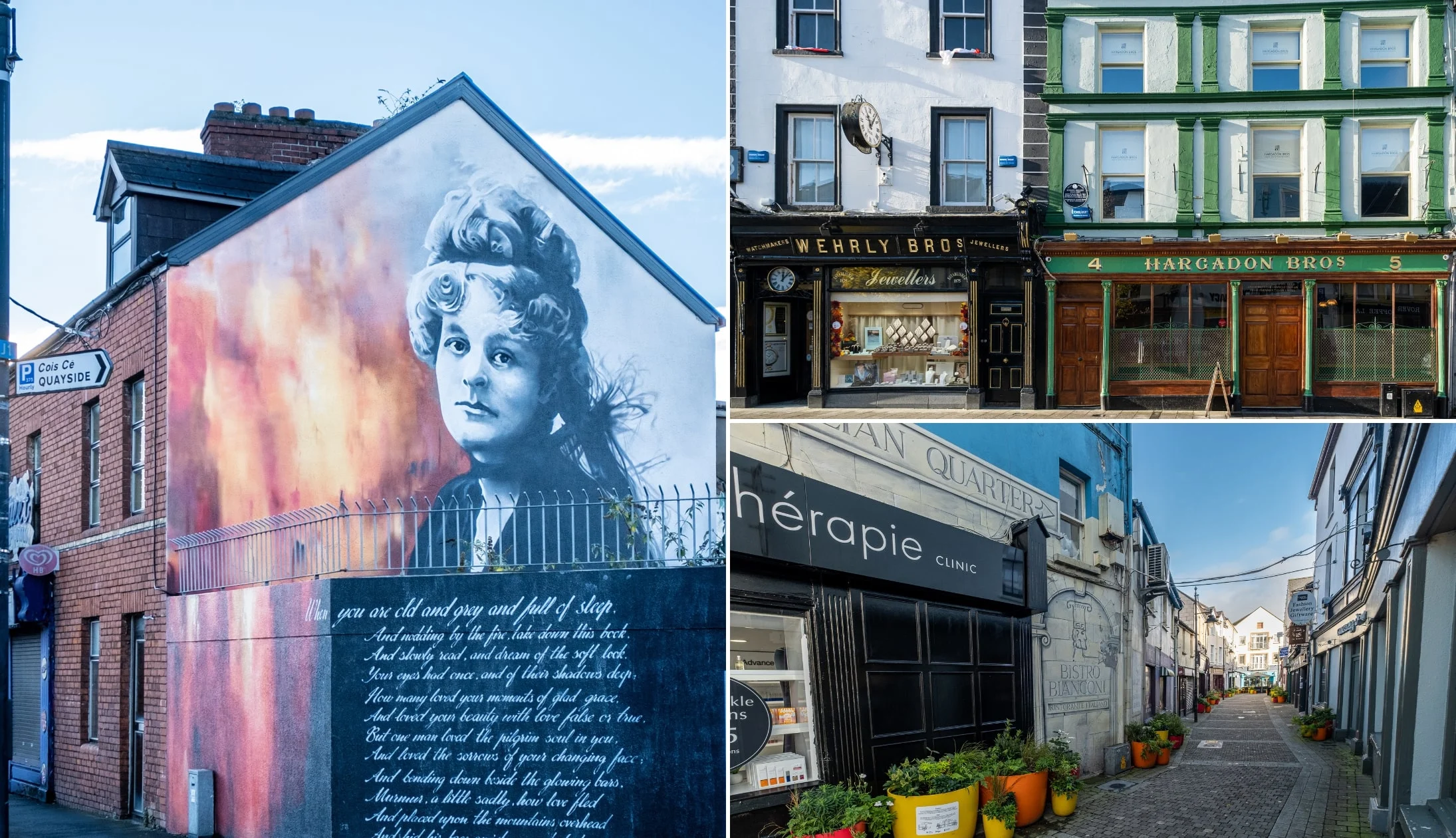
Photos courtesy Eddie Lee/Ed Lee Photography via Failte Ireland
Sitting astride the Garavogue River as it pours into the Atlantic, Sligo Town is a lively base for exploring the local surroundings. Steeped in history, surrounded by beauty, and with a charm and character all of its own, it’s a lovely place to spend a couple of days.
It’ll take about 30 minutes to get to Sligo Town from Mullaghmore Beach. We’ll be on foot for the rest of the day, so feel free to check into your accommodation and park the car. Once that’s done, it’s time for lunch.
Stop 6: Lunch
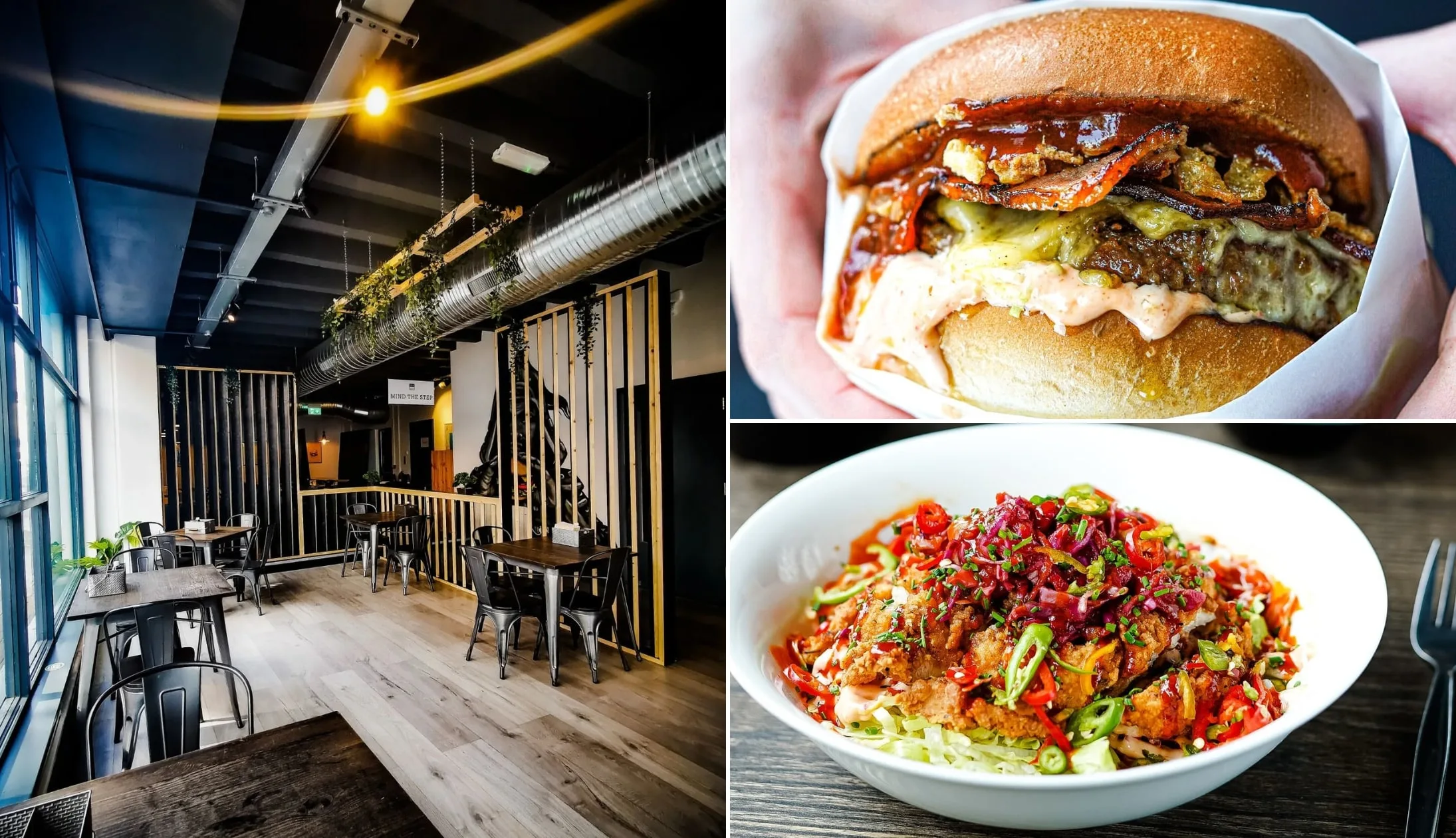
Photos via Flipside Sligo on FB
Enjoy a nice stroll through the old town and along the river, and drop into a restaurant, cafe, or pub of your choice for a spot of lunch. Hooked has never disappointed, and it’s located right in the middle of town on the charming Tobergal Lane. They offer a bunch of Irish and international dishes, including fish and chips, burgers, and a personal favourite, the slow-cooked pork belly.
For soup, toasted sandwiches, cakes, and more, Lyons Cafe and Bakeshop is a good call, while Bridgefoot House does a small but quality lunch menu, including a well-priced soup and sandwich combo. Wherever you choose to eat in the old town, you’ll not be more than a 5 to 10-minute walk away from our next stop, Sligo Abbey.
Stop 7: Sligo Abbey
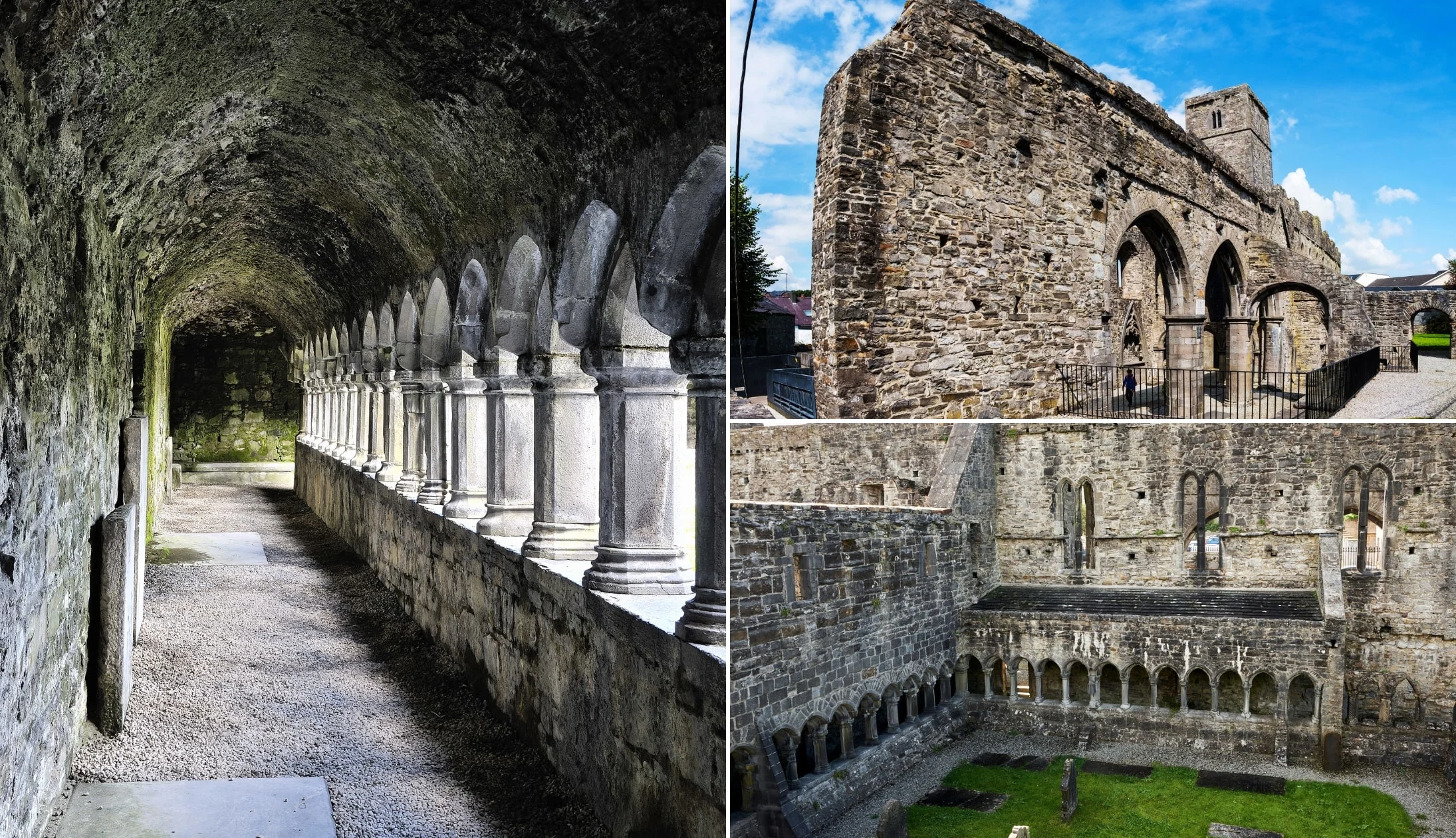
Photos via Shutterstock
The mighty Sligo Abbey is a fine place to explore while you’re in Sligo. It dates back to the mid-13th century and although it has experienced its fair share of trouble and turmoil over the years, much of the building remains to tell its tale. Admission to the abbey is €5 for adults, and you’ll get to learn the story of the abbey, examine the stunning architecture, and unearth some very unique attractions in the visitor centre.
Stop 8: Yeats building
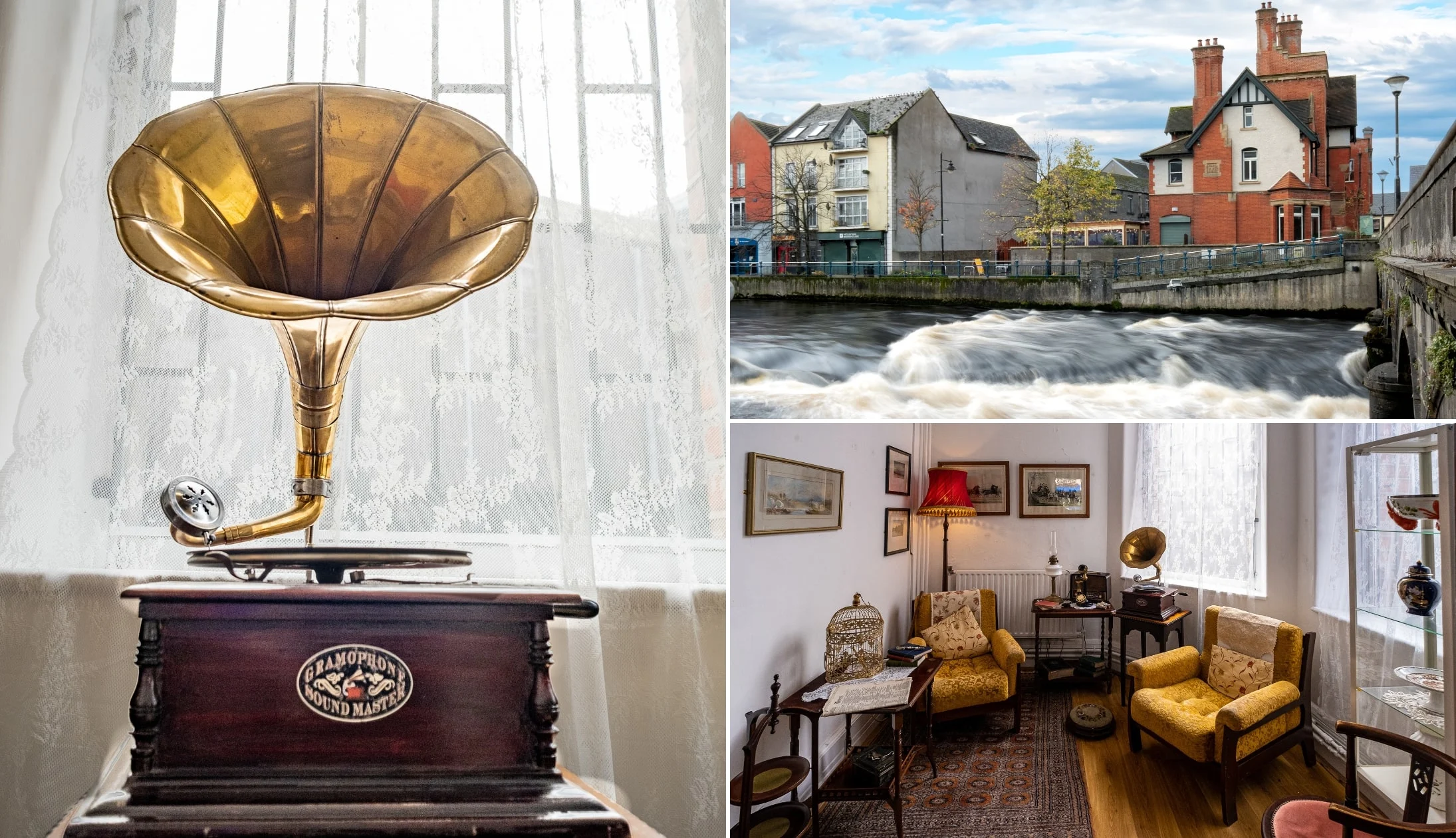
Photos courtesy Eddie Lee/Ed Lee Photography via Failte Ireland
If you’ve an interest in Irish culture, take the short, 6-minute stroll to the Yeats Building. It’s here that you’ll be immersed in all things drama, history, literature and poetry.
There’s a Yeats exhibition that’ll take you into the mind of one of Ireland’s most famous poets and you can also take a guided tour (advance booking needed).
Stop 9: Dinner, drinks and live music
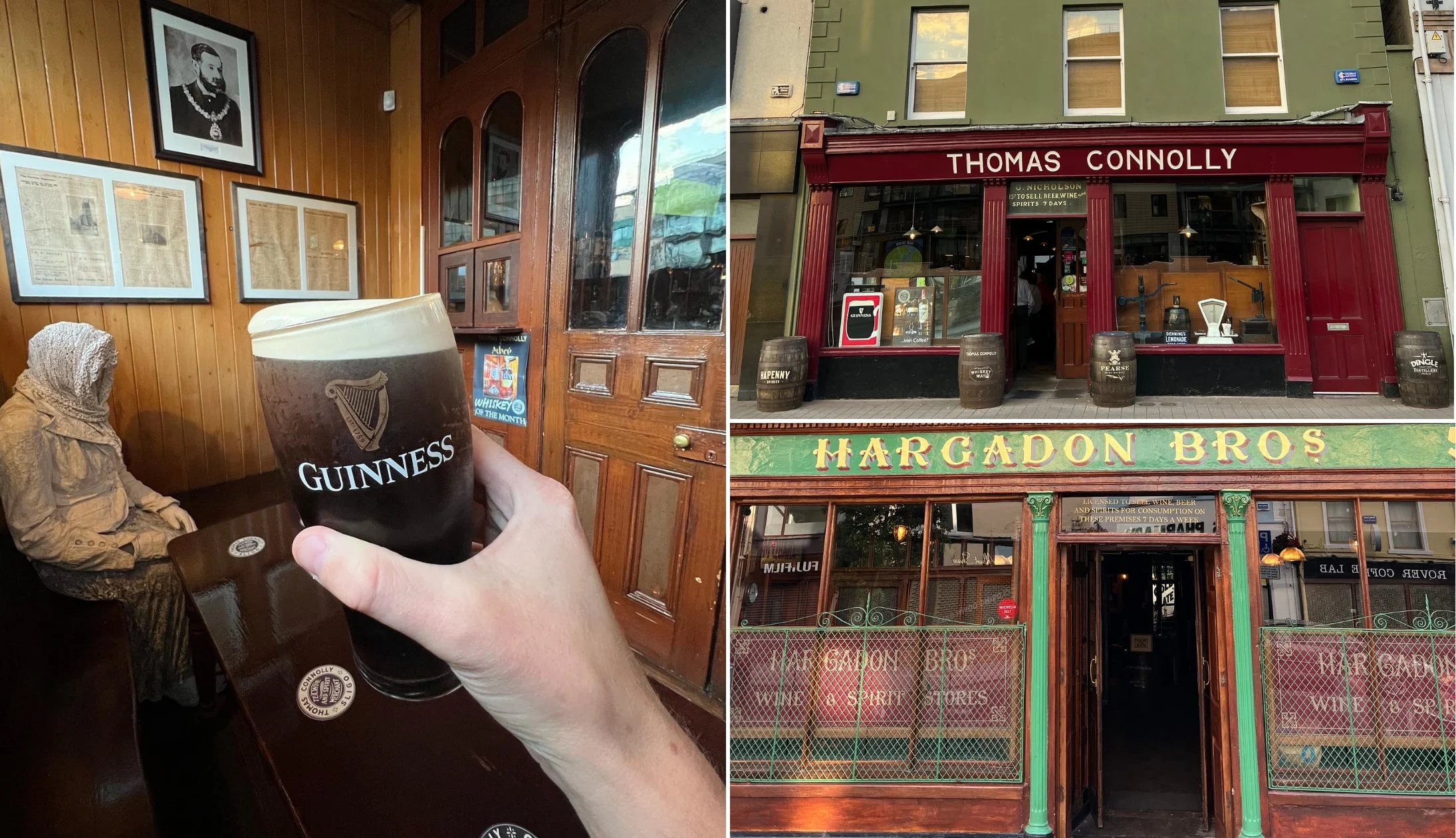
Photos by The Irish Road Trip
Sligo Town is a hotbed of traditional music, art, and great craic, there’s plenty to love about the town. After enjoying the sights, it’s time to head into the centre for a bit of dinner, a few drinks, and some fantastic live music.
Our Sligo food recommendations
Hopefully, you’re hungry as there’s some excellent restaurants in Sligo.
Head to Hooked for delicious Irish and international food made from local ingredients sourced from Sligo County. Some of our favourite dishes are the Sherlock of Tubbercurry’s Prime Beef steak sandwich and the buffalo chicken mac’n’cheese, but they also have some delicious vegan and vegetarian dishes.
For seafood and steaks, we love Coachlane. It’s a little on the pricey side, but their certified Irish Angus Beef is worth the extra money. If steak isn’t your thing, their seafood platter is incredible, with salmon, scallops, crab claws, cod, monkfish, and shrimp.
Our Sligo pub recommendations
If you’re feeling like after dinner drinks, we suggest hitting up Hargadon Bros (a traditional Irish pub dating back to 1868), Thomas Connolly (a heritage Irish pub and the oldest in Sligo Town), and Shoot the Crows (a cosy and quirky traditional pub with a great pint of Guinness).
For a night of lively trad music, pass by McLynns Bar or Fureys Pub (or both!).
McLynns is in the heart of Sligo town on Old Market Street. The fourth-generation pub has been running since 1889, with live music (Irish folk, acoustic, and bluegrass) every weekend and on mid-week nights. The traditional interior will transport you back in time, with wooden furniture and historical decor.
Fureys Pub on Bridge Street is a cosy old-style pub with a great atmosphere, an open fire (great for those cold winter evenings), and live trad music on weekends and certain weekday nights.
Day 6: Sligo Town and Yeats Country
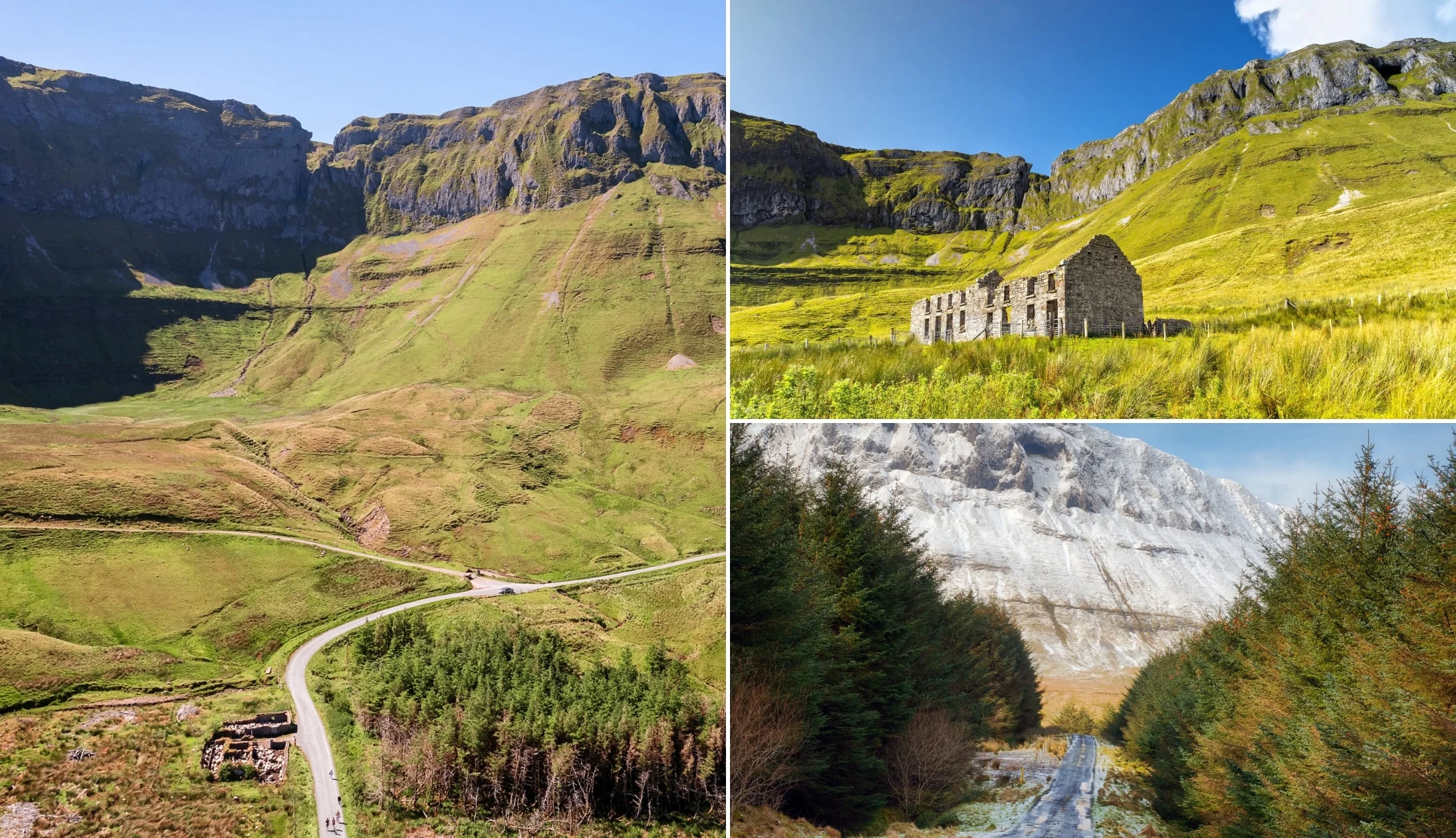
Photos via Shutterstock
Day 6 is all about exploring more of Sligo and its stunning surroundings, better known as Yeats Country. The poet WB Yeats was besotted with this slice of Ireland, and today we’ll explore a great many attractions with a Yeats link.
Before you hit the road, be sure to grab a hefty breakfast at your accommodation or at one of the cafes in town. Any of the ones we mentioned for lunch yesterday should be open for breakfast, and you can enjoy hearty fry-ups, sumptuous breakfast rolls, or something a little healthier at any of them.
Stop 1: Glencar Waterfall
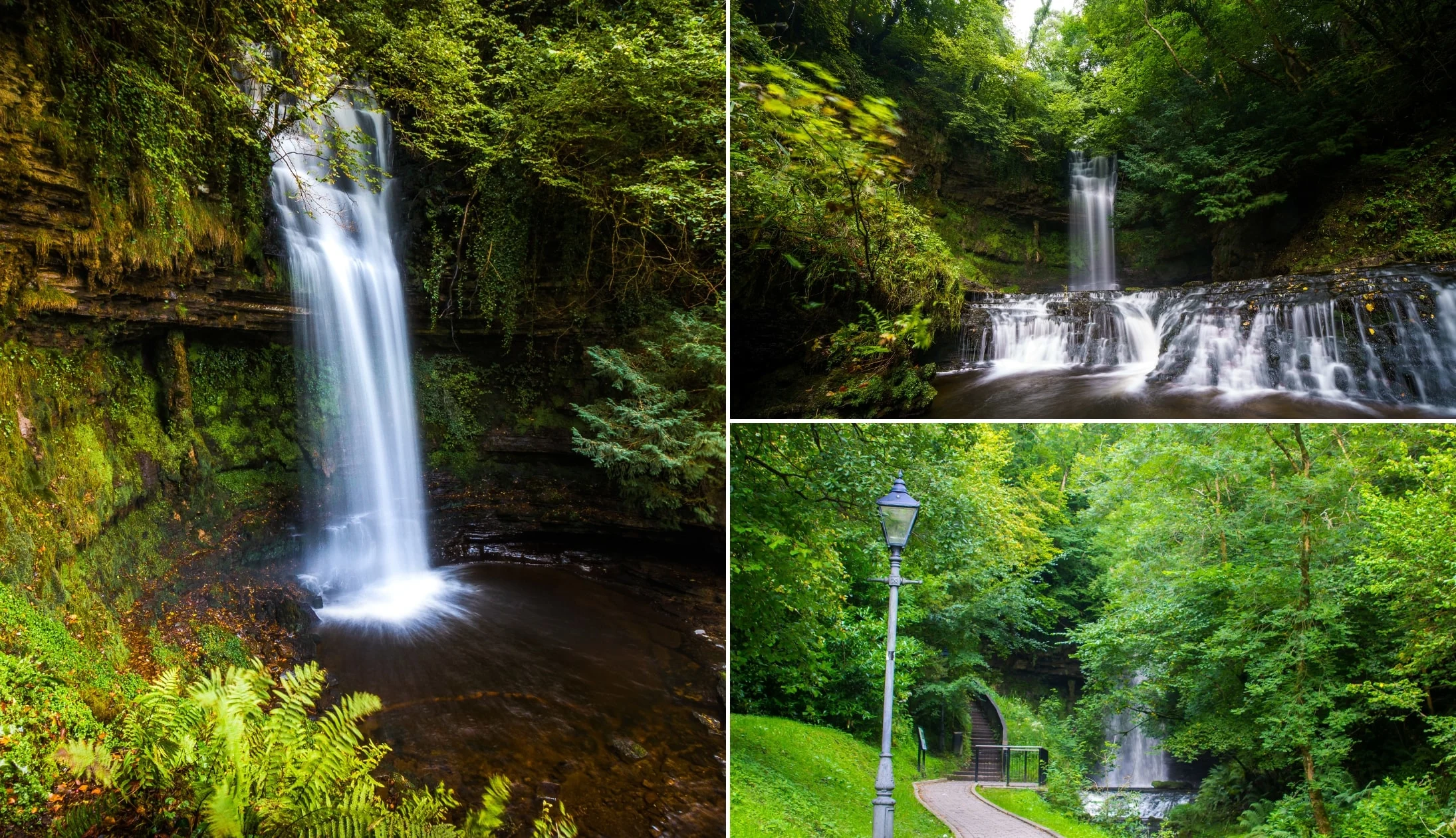
Photos via Shutterstock
Our first stop offers up some absolutely gorgeous scenery. From Sligo town, it’s a 17-minute drive over the border into County Leitrim to the Glencar Waterfall car park, where you’ll also find public toilets.
Once you’ve parked up, the waterfall is a short 300-metre walk away and should take five or ten minutes or so. The cascade crashes down 50 ft of green foliage and craggy rocks, creating a gorgeous scene tucked away in the woods. In fact, its beauty inspired WB Yeats to write a poem about it.
If you’re feeling peckish or thirsty, you’ll find the teaSHED cafe between the waterfall and the car park. Here, you can get a good cup of tea or coffee, as well as various cakes and bakes.
Stop 2: Benbulben Forest Walk
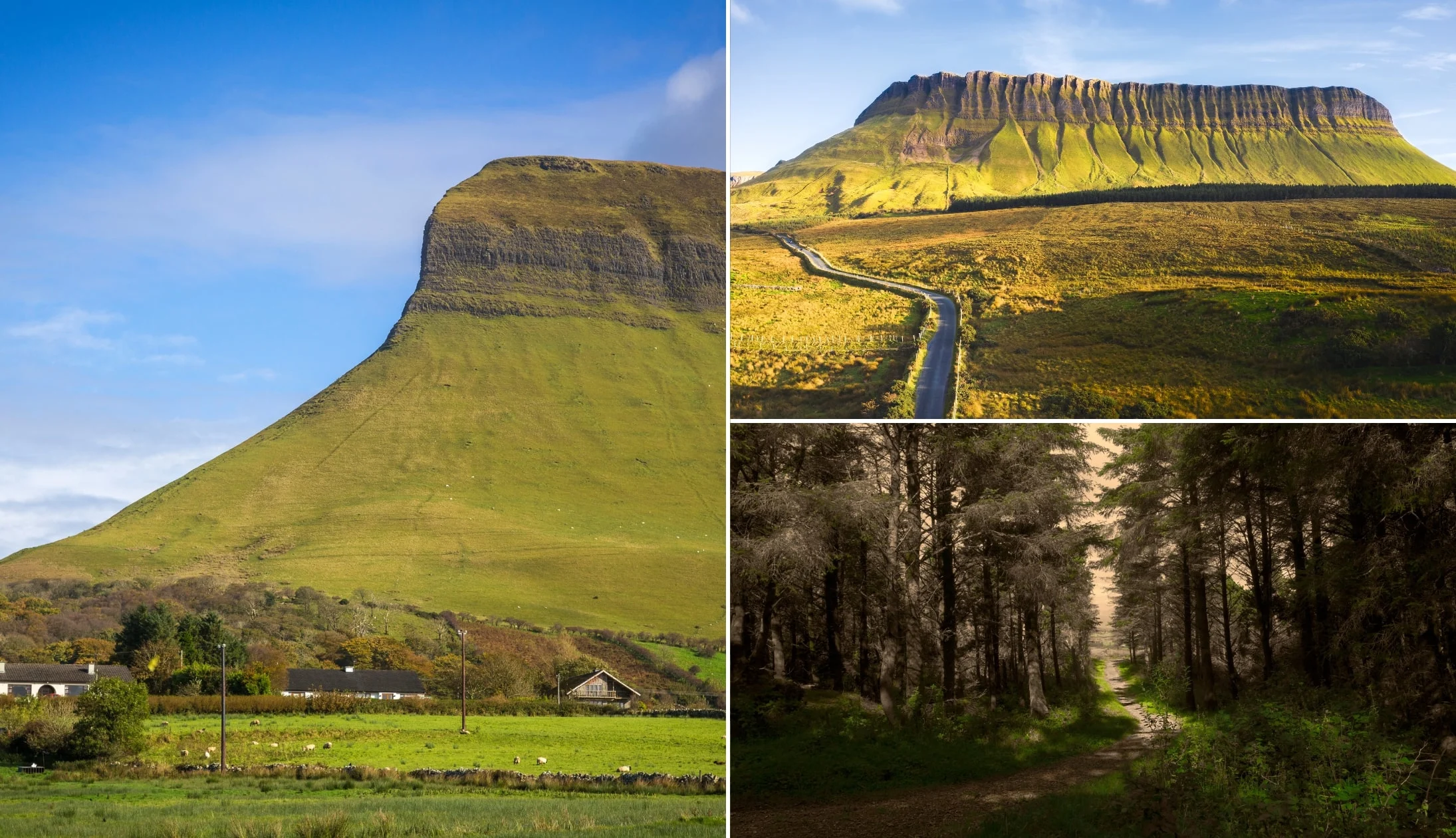
Photos via Shutterstock
Our next stop is just a 16-minute drive from the waterfall and will be a nice opportunity to get out into the Irish countryside and soak up the views. The Benbulben Forest Walk is an easy-going 5 km looped ramble that should take about an hour and a half to complete.
Along the way, you’ll enjoy superb views of the spectacular Benbulben Mountain.
This unique, flat-topped mountain dominates the Sligo countryside, with its steep sides and deep ravines gauged into its side. While this walk doesn’t climb the mountain, it offers up some of the best views of it. Plus, on a clear day, you can see across the countryside and over the sea to the Slieve League Cliffs.
There’s a handy little car park right at the start of the walk. Just stick “Benbulben Forest Walk” into Google Maps and you’ll find it.
Stop 3: Gleniff Horseshoe

Photos via Shutterstock
After that walk, you’ll get a chance to rest your legs as you enjoy the wonderfully scenic Gleniff Horseshoe Drive. The drive starts and ends in the charming village of Cliffoney, which is about 12 minutes away.
The Gleniff Horseshoe is a 20km loop that offers spectacular views of the Dartry Mountains and Donegal Bay.
There’s plenty to see along the way, including wild scenery, megalithic monuments, and a huge cave high up on the slopes. Also, look out for Benwiskin – the wave-shaped mountain at the entrance of the valley.
Starting at O’Donnell’s Bar in Cliffoney, you’ll first head to Gleniff Barytes Mill Site. From there, you drive into the valley. Keep an eye open for the impressive Grainne and Diarmuid’s Cave up in the hills.
The drive is very easy to follow, but we’ve made a map for you here that’ll give you a good sense of the route.
Stop 4: Davis’ Restaurant & Yeats Tavern for lunch
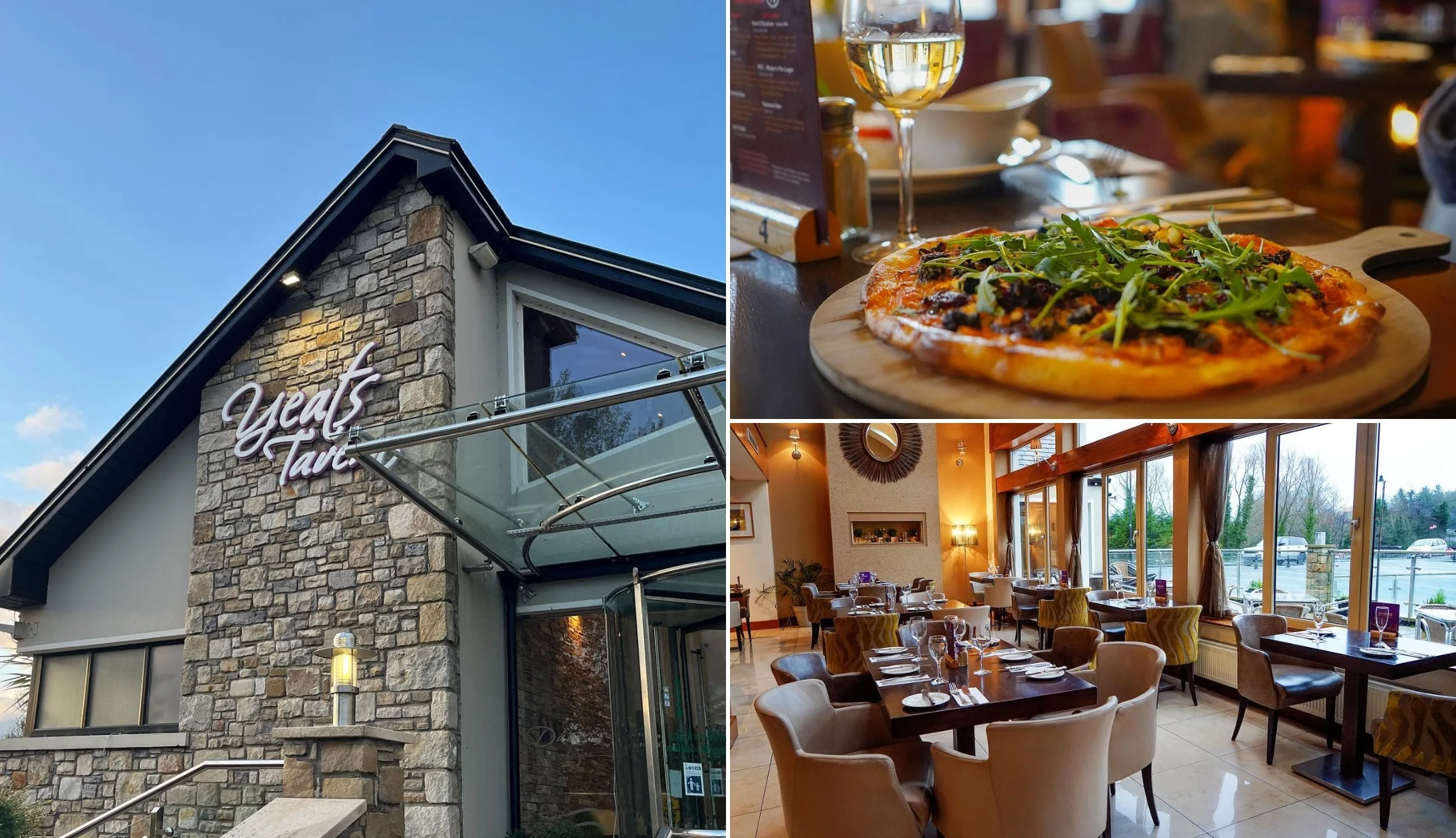
Photos via Davis’ Restaurant on FB
It’s time for lunch. Take the 20-minute spin out to Davis’ Restaurant & Yeats Tavern, which is a stone’s throw from our next attraction of the day.
There’s a nice big car park here, the menu has a huge variety of choices, with everything from light bites to hearty meals, and the service is top-notch.
Stop 5: Drumcliffe Church and WB Yeats Grave
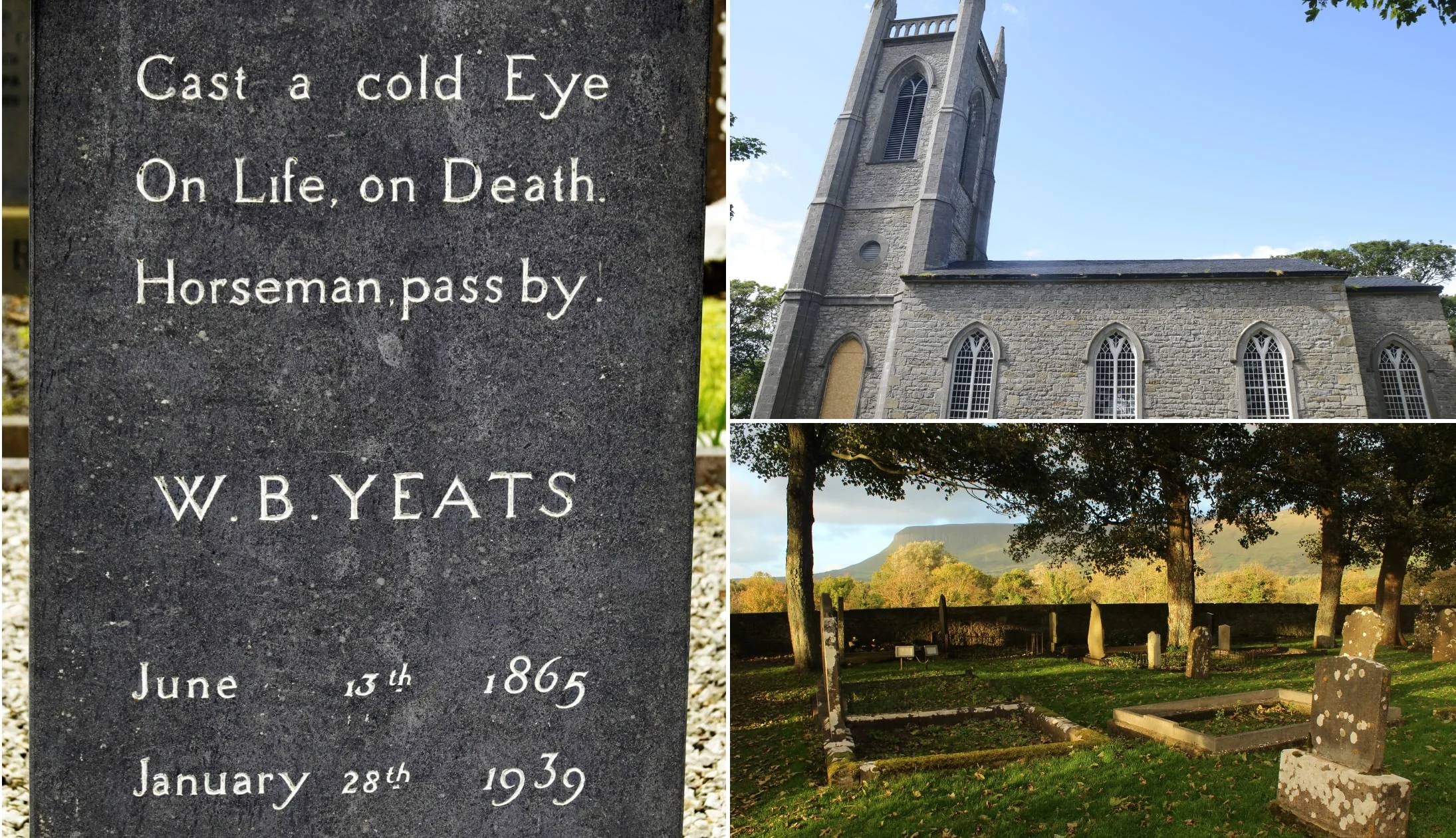
Photos via Shutterstock
Our next stop is just a 2-minute drive from Davis’ Restaurant & Yeats Tavern.
Drumcliffe Church is best known as the final resting place of WB Yeats, one of Ireland’s most beloved poets. A visit to the grave is a cultural experience, but there’s much more to enjoy at the church.
Check out the 11th-century high cross and enjoy the gorgeous scenery all around before heading to the craft shop and cafe. There’s a handy car park right next to Drumcliffe Church that offers plenty of space and free parking.
Stop 6: Lissadell House
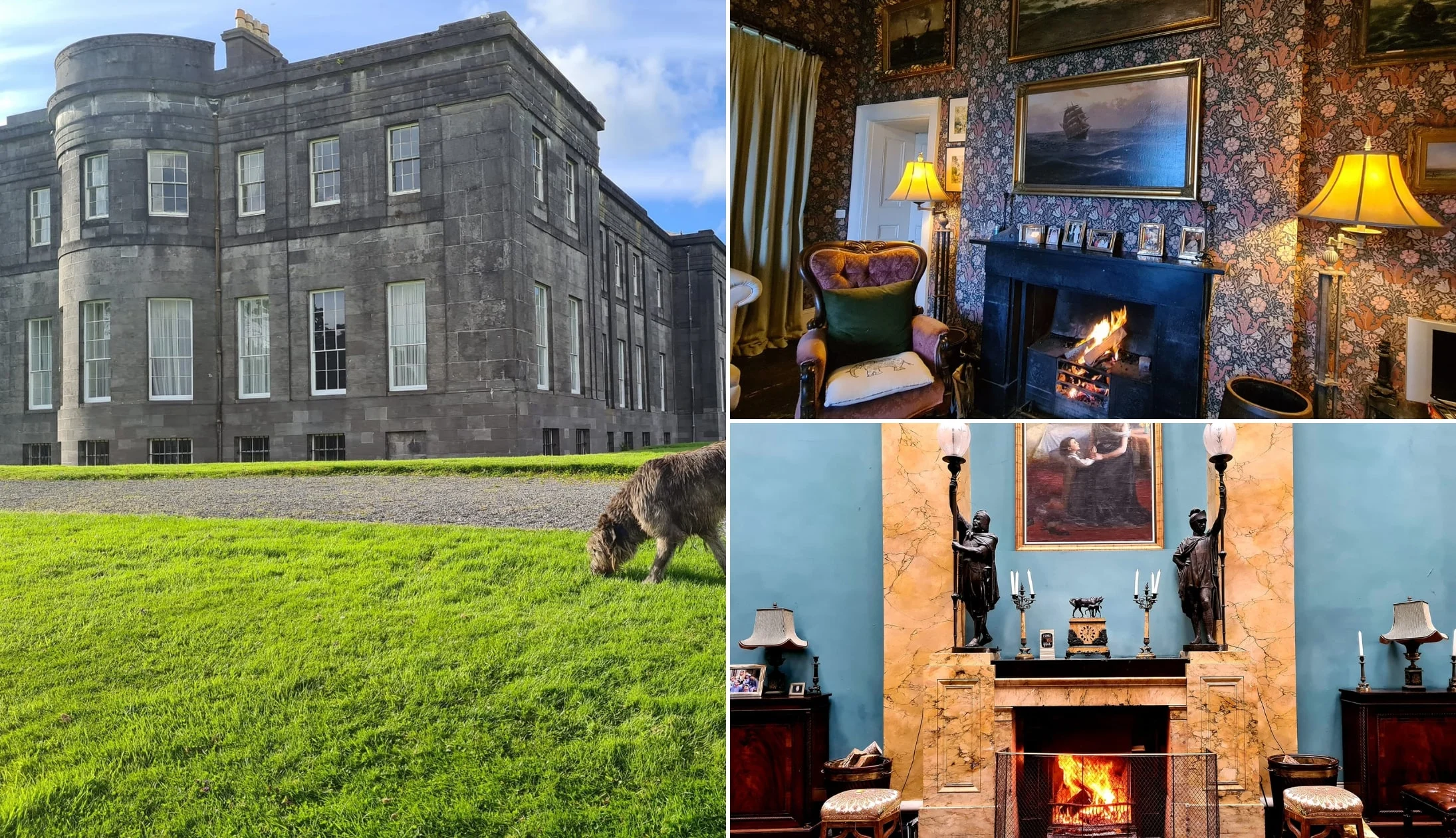
Photos via Lissadell House on FB
Next up is Lissadell House, a 10-minute drive from Drumcliffe Church. Childhood home of Countess Markievicz, one of the leaders of the 1916 Rising and the first woman to be elected to Dáil Eireann, the Irish Parliament, it’s of huge cultural importance. It was also famously visited by WB Yeats and his brother Jack B Yeats, an artist of formidable skill.
There’s plenty to see and do at the house, with a whole load of history to soak up. Take a guided tour of the inside, check out the 1916 Rising exhibition, enjoy the Yeats Gallery, or stroll the beautiful grounds. You could easily spend a few hours here. If you get thirsty, head to the tea rooms for tea (or coffee) and homemade cake.
Stop 7: Streedagh Beach stroll
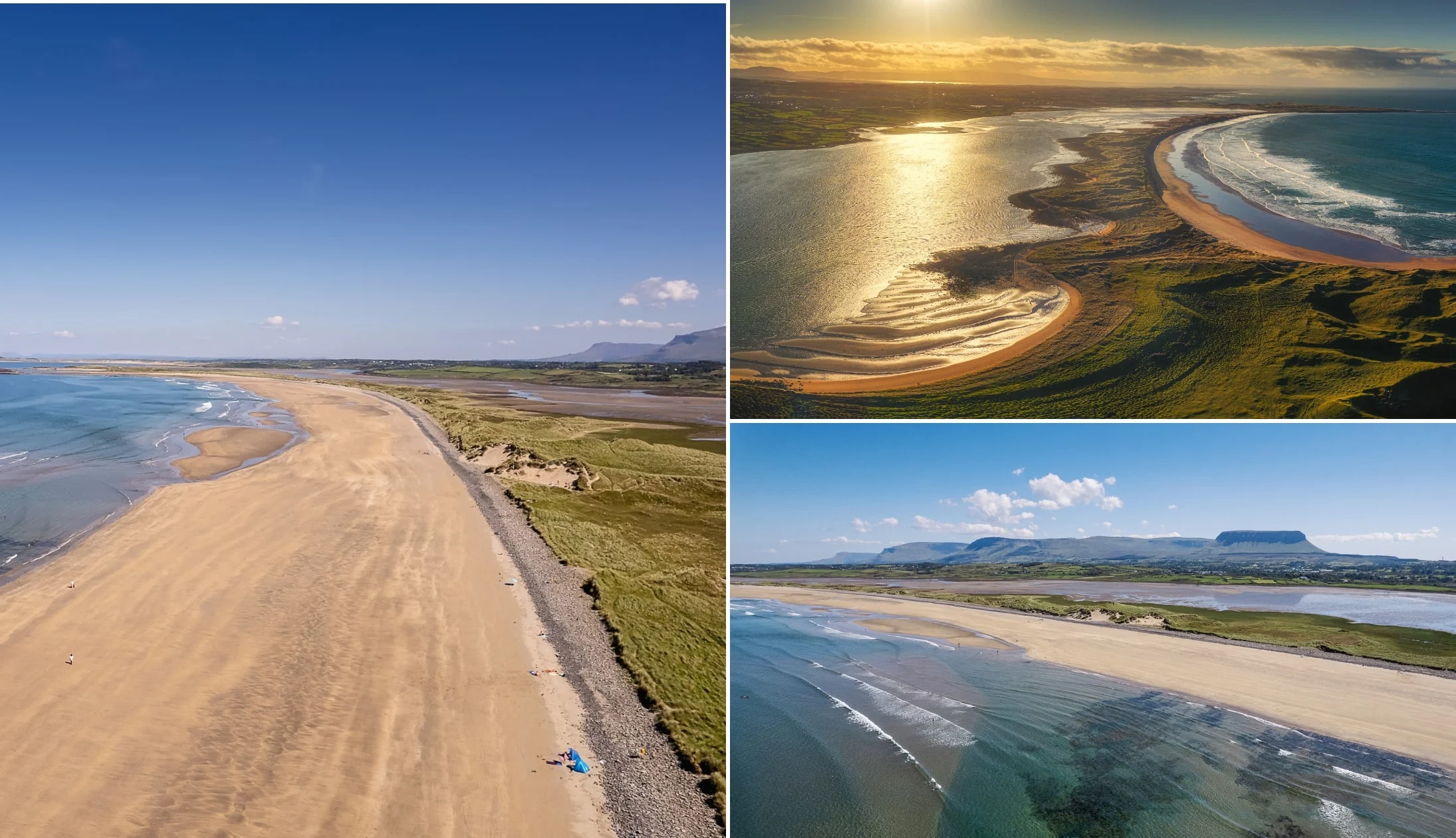
Photos via Shutterstock
After a short 15-minute drive through the tranquil countryside, you’ll arrive at our final stop before heading back to Sligo for the evening. Streedagh Beach arguably offers up the best views of the mighty Benbulben, as immortalised in the TV show, Normal People.
While popular with surfers, it’s not an ideal beach for swimming due to the strong currents. However, it’s absolutely fantastic for walking, with a 3 km linear walk along the sands and dunes. Keep your eyes peeled and you might spot three shipwrecks from the Spanish Armada, which sank here in 1588. Fossil hunters will also enjoy the fascinating rock formations towards the end of the walk. In total, the walk should take 1.5 to 2 hours to complete.
Stop 8: Back to Sligo Town for the evening

Photos by The Irish Road Trip
After enjoying the beach, and if you’re feeling romantic, maybe even catching a gorgeous sunset, it’s time to head back to Sligo to freshen up and get some dinner, drinks, and entertainment.
Our Sligo food recommendations
Hopefully, you’re hungry as there’s some excellent restaurants in Sligo.
Head to Hooked for delicious Irish and international food made from local ingredients sourced from Sligo County. Some of our favourite dishes are the Sherlock of Tubbercurry’s Prime Beef steak sandwich and the buffalo chicken mac’n’cheese, but they also have some delicious vegan and vegetarian dishes.
For seafood and steaks, we love Coachlane. It’s a little on the pricey side, but their certified Irish Angus Beef is worth the extra money. If steak isn’t your thing, their seafood platter is incredible, with salmon, scallops, crab claws, cod, monkfish, and shrimp.
Our Sligo pub recommendations
If you’re feeling like after dinner drinks, we suggest hitting up Hargadon Bros (a traditional Irish pub dating back to 1868), Thomas Connolly (a heritage Irish pub and the oldest in Sligo Town), and Shoot the Crows (a cosy and quirky traditional pub with a great pint of Guinness).
For a night of lively trad music, pass by McLynns Bar or Fureys Pub (or both!).
McLynns is in the heart of Sligo town on Old Market Street. The fourth-generation pub has been running since 1889, with live music (Irish folk, acoustic, and bluegrass) every weekend and on mid-week nights. The traditional interior will transport you back in time, with wooden furniture and historical decor.
Fureys Pub on Bridge Street is a cosy old-style pub with a great atmosphere, an open fire (great for those cold winter evenings), and live trad music on weekends and certain weekday nights.
Day 7: The Mayo Coast
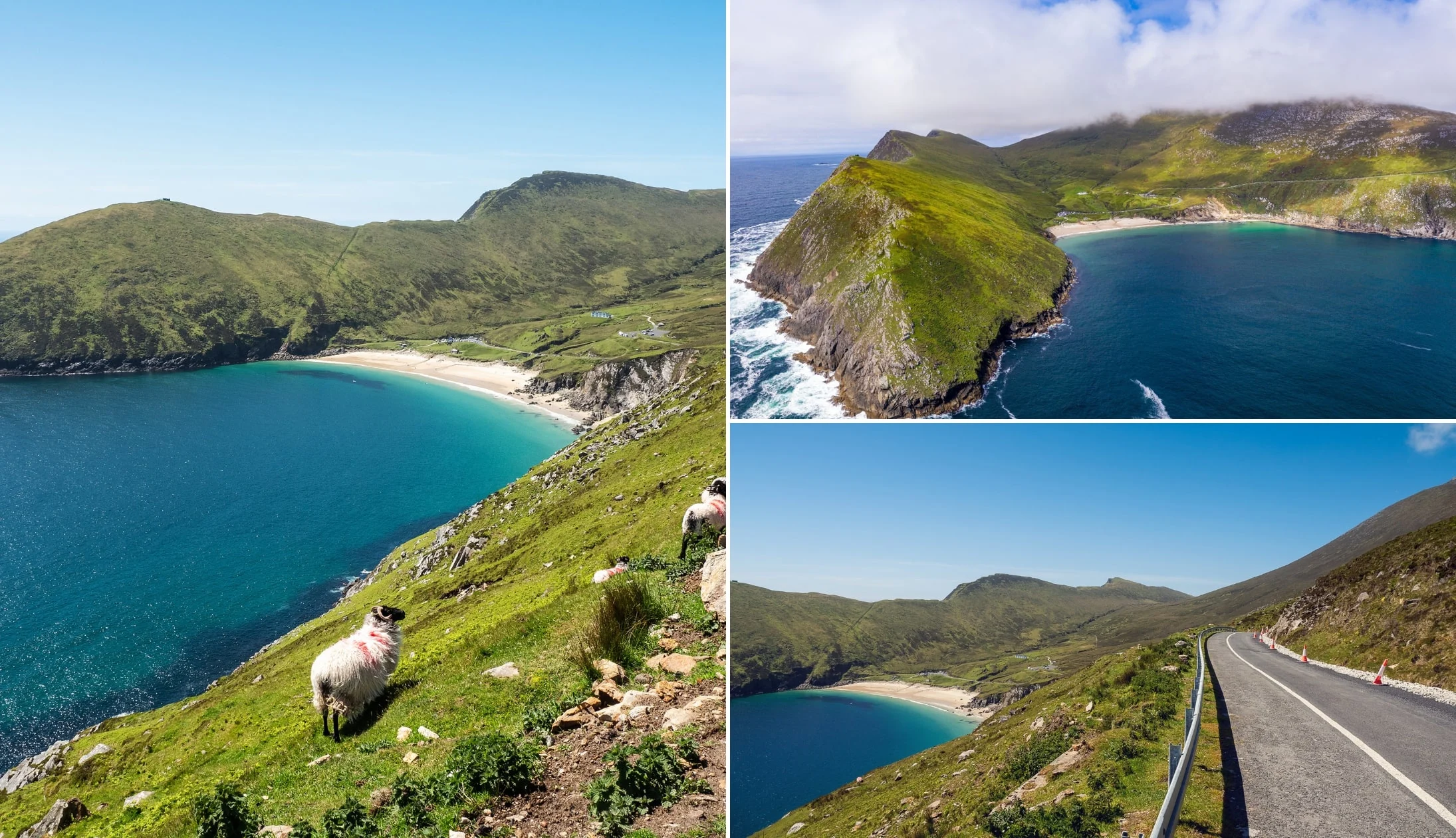
Photos via Shutterstock
Today we’re heading to Westport, the long way round. Along the way, we’ll take in the stunning Mayo coast and the sights of Achill Island, one of the country’s most remote areas and Ireland’s largest island.
There’s going to be a lot of driving today, but it really is the only way to see all of the incredible places we’ve got lined up for you! Be sure to drop by a shop before you leave Sligo to grab plenty of snacks and water for the car.
Before hitting the road, let’s grab one last breakfast in Sligo, either at your accommodation or one of the many fantastic cafes in town. Margaret’s Cafe does a wonderful full Irish, but their pancakes and smoked bacon are also well worth giving a go. For a vegan-friendly alternative, head to Sweet Beat, where you’ll find an extensive menu and great coffee.
You’ll need to book two nights’ accommodation in Westport, so be sure to check out our suggestions.
Our Westport accommodation recommendations
- Budget: Old Mill Holiday Hostel (in the town with good reviews) and Clooneen House (very central with excellent reviews)
- Mid-range: Castlecourt Hotel (very central and has a spa) and Westport Plaza Hotel (central with exceptional reviews)
- High-range: Knockranny House (gorgeous hotel a 1-minute drive from town)
Stop 1: Grab a cup of coffee and stretch your legs in Ballina
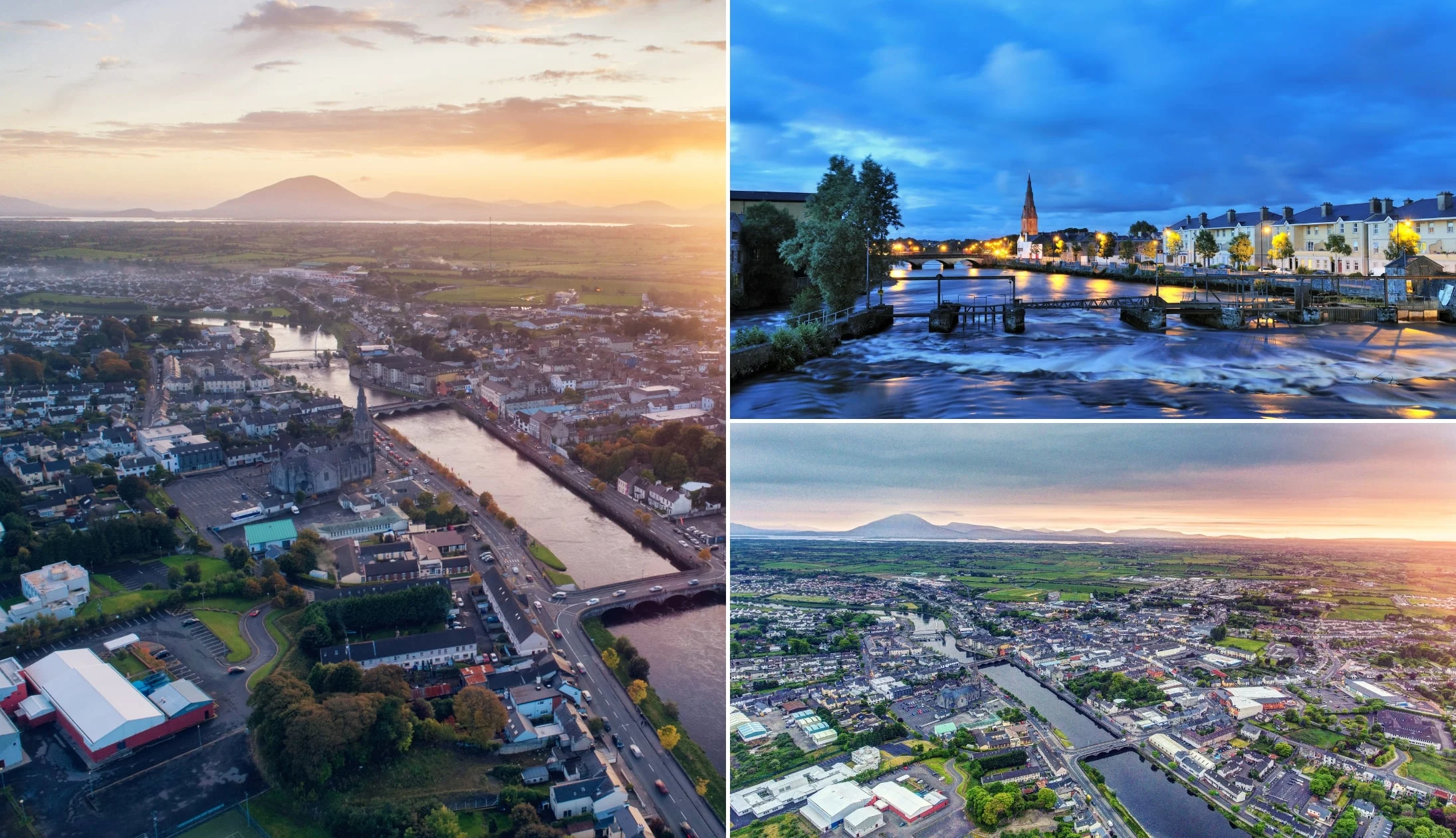
Photos via Shutterstock
Our first stop takes us to the riverside town of Ballina, about an hour’s drive from Sligo. Straddling the River Moy, it’s a beautiful, tranquil town that’s nice to stroll around. Park up in the Market Square car park, which costs around 50 cents an hour or so.
If you fancy a cup of coffee while you wander the town, both The Coffee Vine Cafe and Dave’s Deli and Coffee Shack are a short walk from the car park, they both offer a superb choice of coffee styles, as well as pastries and cakes.
Stop 2: Dun Briste
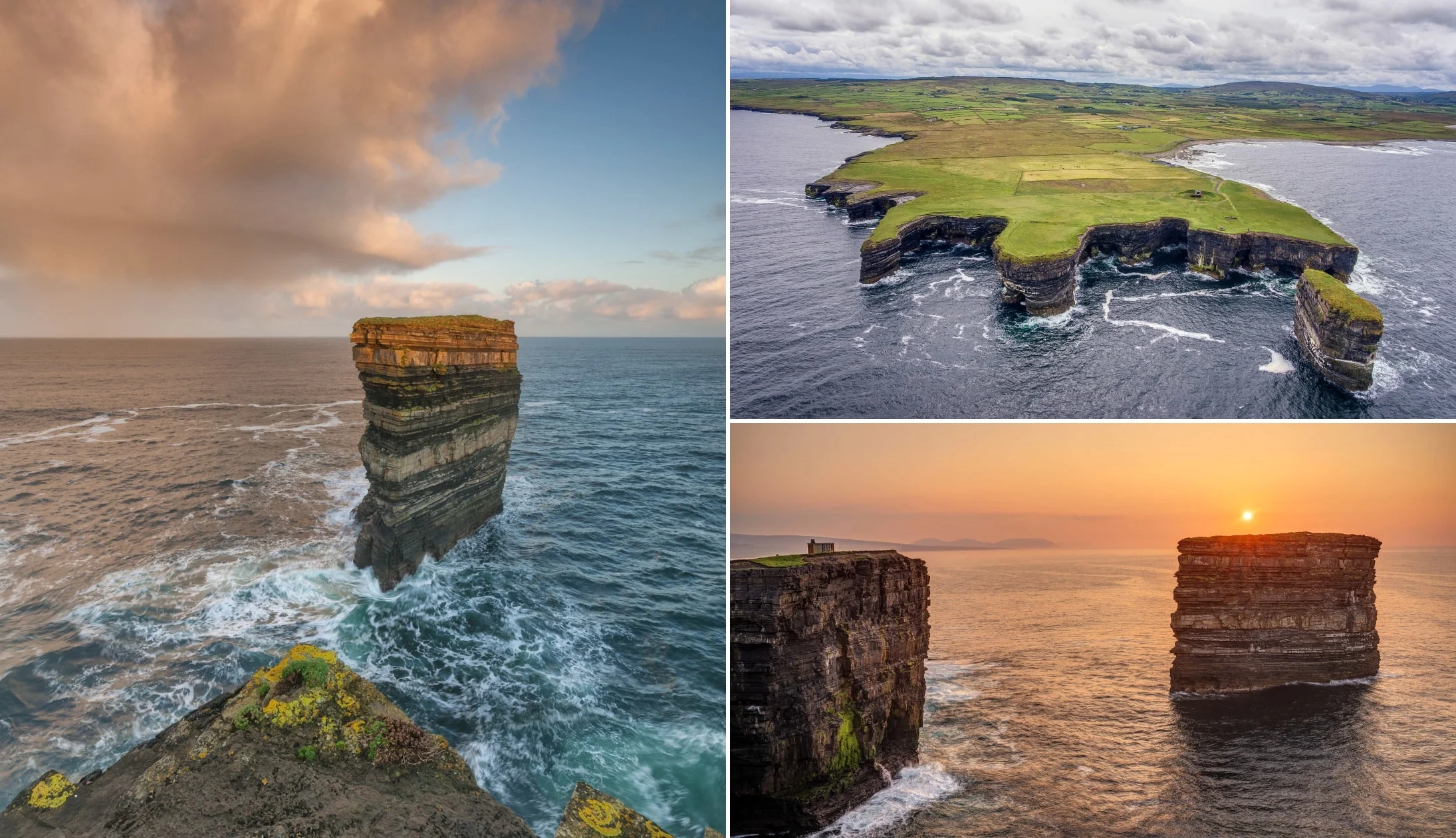
Photos via Shutterstock
Jumping back in the car, we’ll drive 34 minutes to the spectacular Dun Briste sea stack, just off Downpatrick Head. Standing 45 metres high, 63 metres long and 23 metres wide, it lies just 200 metres offshore and is home to puffins, kittiwakes and cormorants. There’s a spacious car park when you reach the headland, and from there it’s about a 15-minute walk to the edge of the cliffs.
With its colourful rock strata and churning waters below, it’s an impressive sight. Legend tells that it was formed by Saint Patrick, who struck the ground with his crozier to strand Crom Dubh, a Celtic Chieftain. There’s a clatter of things to see at Downpatrick Head, including the WWII EIRE 64 lookout post, St Patrick’s Church, and Pul Na Sean Tinne, a blowhole known as the “Hole of the Old Fire”. You’ll also find a nice tea shop and cafe there.
Stop 3: Ceide Fields
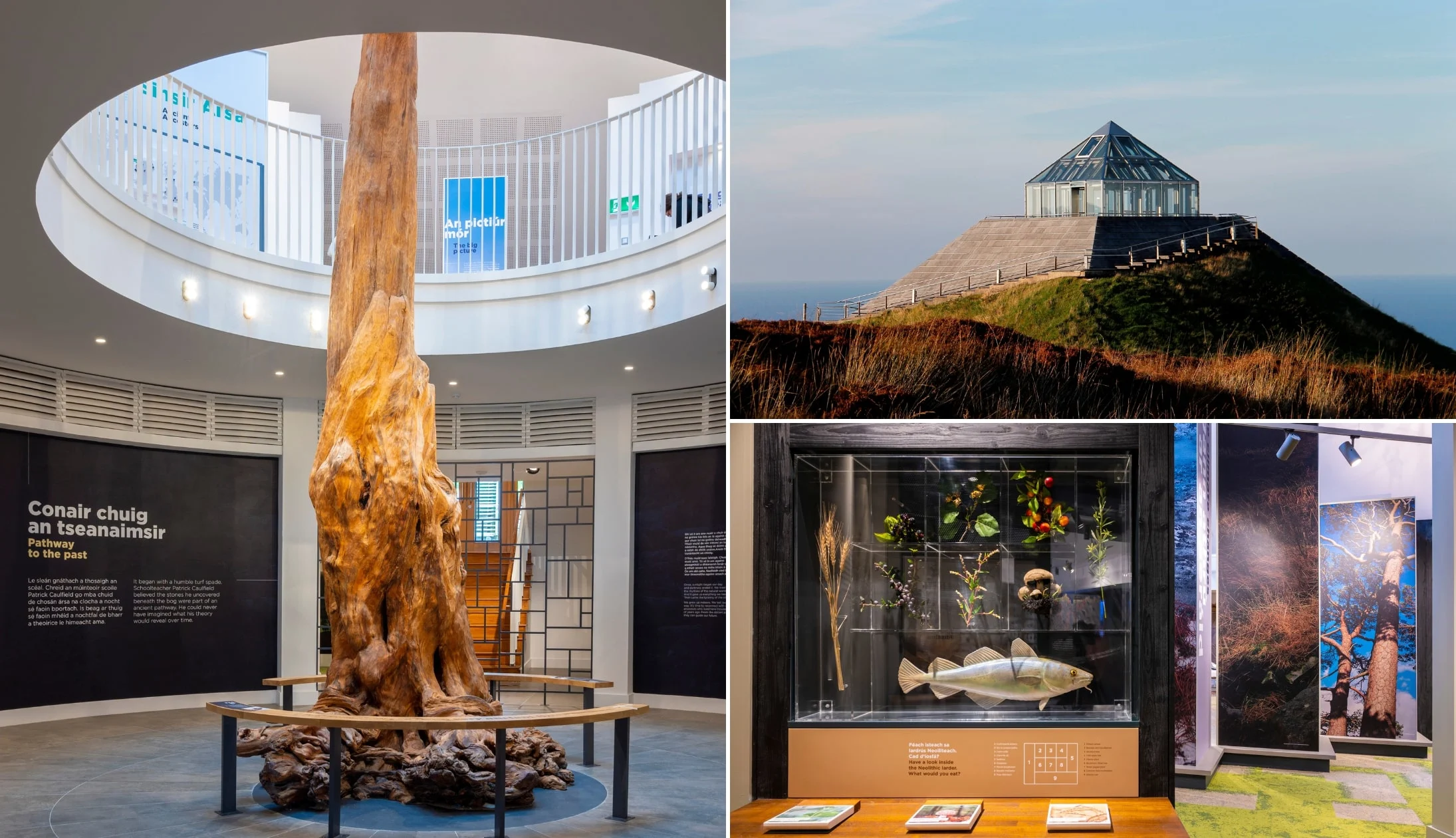
Photo left and bottom right: Michael Mc Laughlin. Top right: Alison Crummy. Via Failte Ireland
Our next stop is the Ceide Fields, just a 19-minute drive from Dun Briste. More than 6,000 years old, this remarkable neolithic site perches atop the cliffs, some 113 metres above the sea. This extensive Stone Age monument is the oldest-known field system in the world, containing a number of megalithic tombs, ancient stone-walled fields, and the remains of centuries-old dwelling places.
There’s a fantastic visitor centre, which rises from the peat bog in a pyramid shape and boasts an array of displays and exhibits to check out. You can enjoy a guided tour of the area too, or visit the viewing platform. And of course, there’s a decent little cafe too.
Stop 4: Ballycroy – Wild Nephin National Park
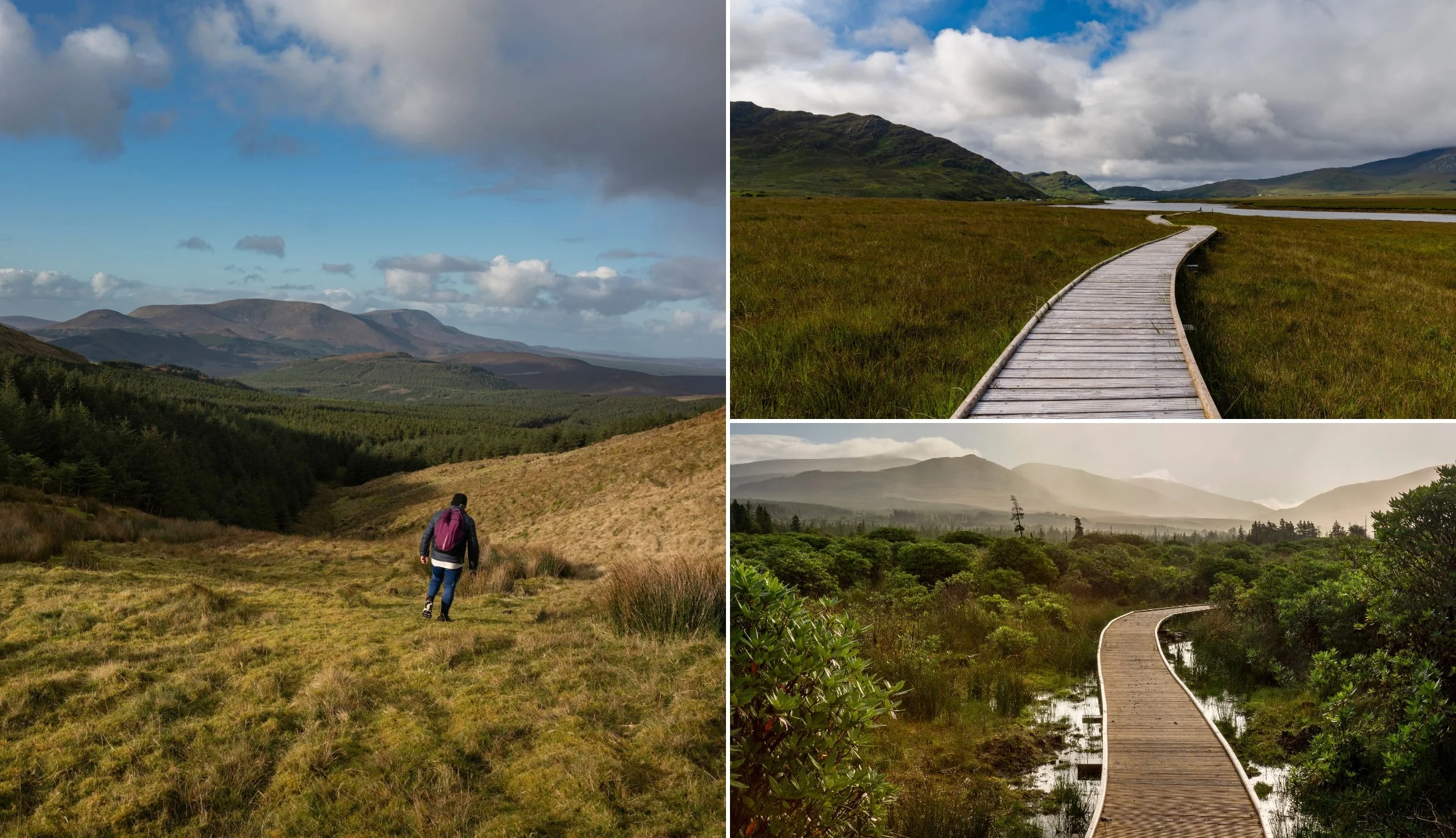
Photos via Shutterstock
After Ceide Fields, we’ll take a beautiful 50-minute drive through the stark beauty of Mayo’s countryside before arriving at Ballycroy Visitor Centre in the heart of Wild Nephin National Park. The park is home to a wealth of gorgeous lakes, mountains, and bogs, with a range of walks to suit all schedules and abilities.
First, it’s worth popping into the visitor centre, which showcases some fascinating displays and exhibits that explain the history and culture of the area. If you want to check out your beautiful surroundings, there’s a nice, easy-going 2 km walk from the visitor centre that offers spectacular views out to Achill Island and the Nephin Beg Mountain Range.
Stop 5: Lunch on Achill Island
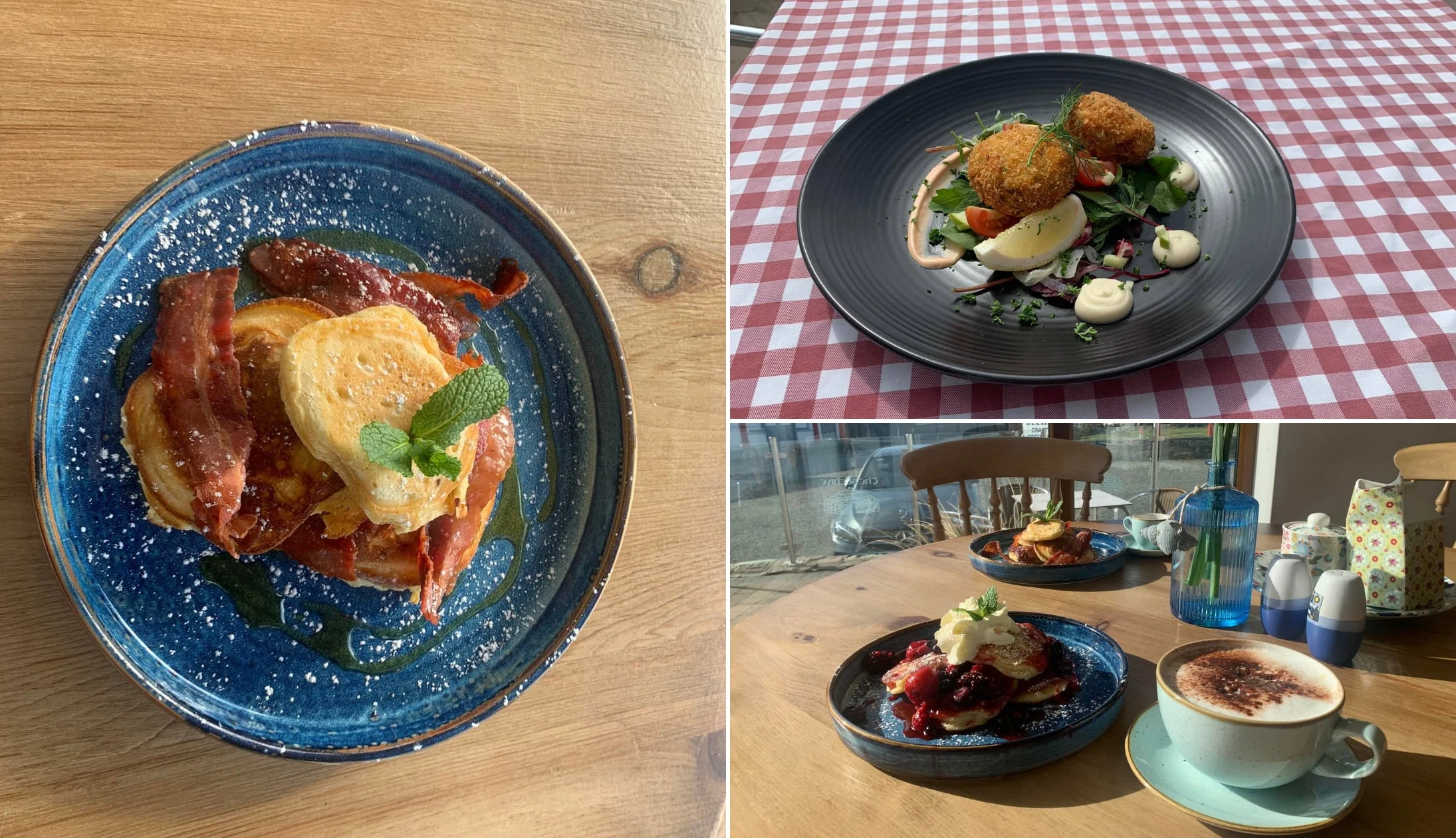
Photos via Beehive Crafts and Gifts on FB
For lunch, we’ll drive over the Michael Davitt Bridge onto the epic Achill Island, which boasts breathtaking landscapes and plenty to see and do. For food, the lively village of Keel, about 45 minutes from Ballycroy, is the place to be, with several pubs, cafes, and restaurants to choose from.
We recommend the Beehive Crafts and Gifts Restaurant, with excellent indoor and outdoor seating, and a varied menu, with options for all dietary requirements. Be sure to check out the fishcakes! Alternatively, The Currach is a good choice and they do a mean seafood chowder.
Alternatively, stop off at Blásta at Ted’s in Cashel. Parked up in the pub car park, this fantastic food truck offers up a wealth of tasty treats, including mussels, excellent fish and chips, shrimp tacos, and falafel. With daily specials, there’s always something new to try. In fact, the only problem with Blásta is that it’s so hard to choose just one thing!
Stop 6: Keel Beach
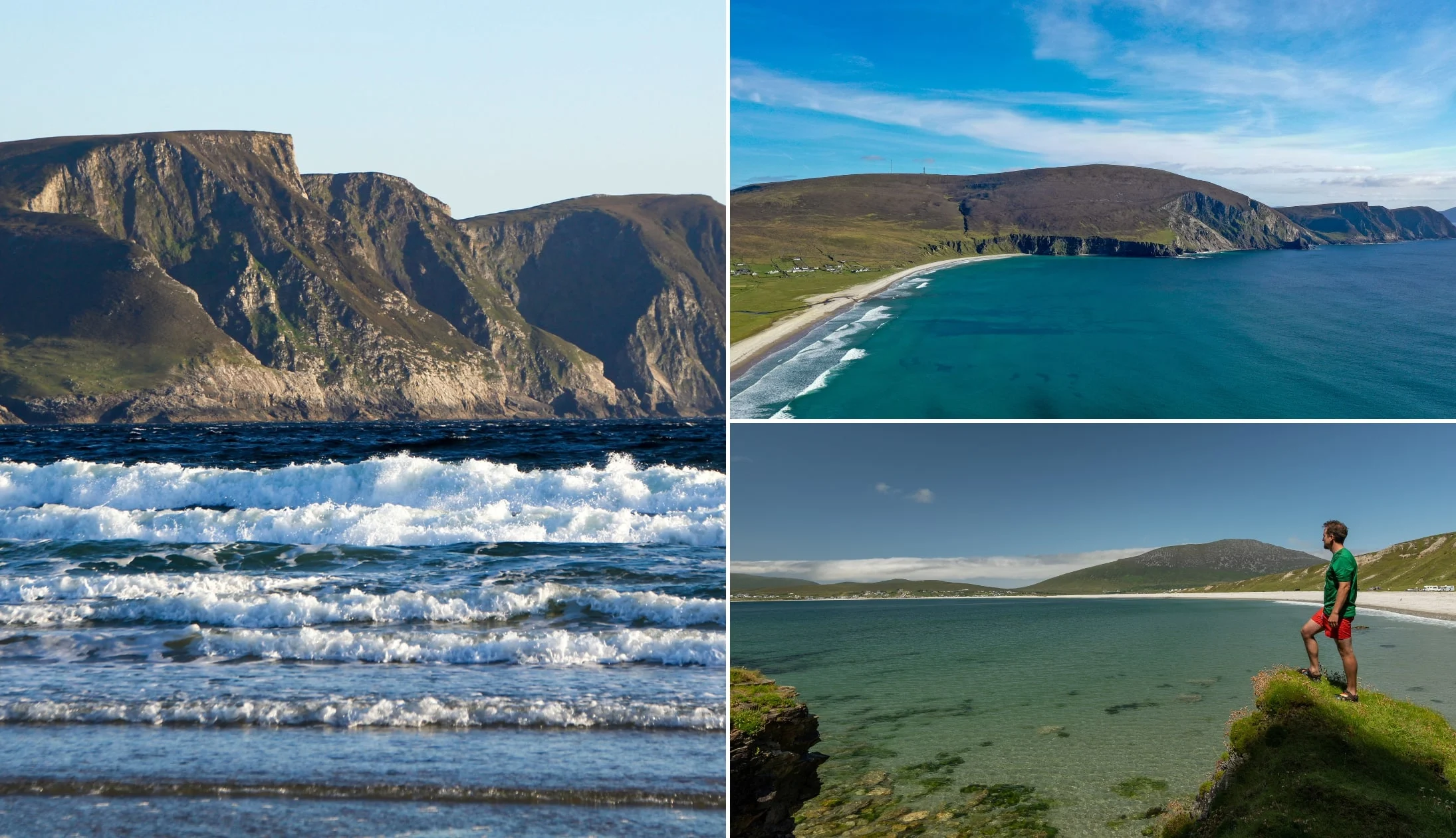
Photos via Shutterstock
After lunch, feel free to potter about Keel Beach, one of the most popular on Achill, especially for surfers. There’s even board and wetsuit rental if you fancy giving surfing a go yourself! Blue Flag certified, the beach enjoys fantastic water quality, as well as a seasonal lifeguard service, making it a great spot for swimming too.
You’ll find plenty of parking at Keel Beach, as well as clean toilets and numerous picnic tables. It’s a 12-minute drive from Ted’s, or just down the road from the restaurants and cafes in Keel.
Stop 7: Keem Bay

Photos via Shutterstock
Next stop, the exotic-looking Keem Bay. Seriously, on a sunny day, it looks more like Bali than Ireland! Surrounded by towering green cliffs, it boasts a luscious white sandy beach and crystal-clear seas. A nice place for a swim (lifeguards are on duty during summer months), it’s also a top place for relaxing and taking in the scenery. The 12-minute drive up there from Keel is also incredibly scenic, so be sure to take your time.
Stop 8: White Cliffs of Ashleam
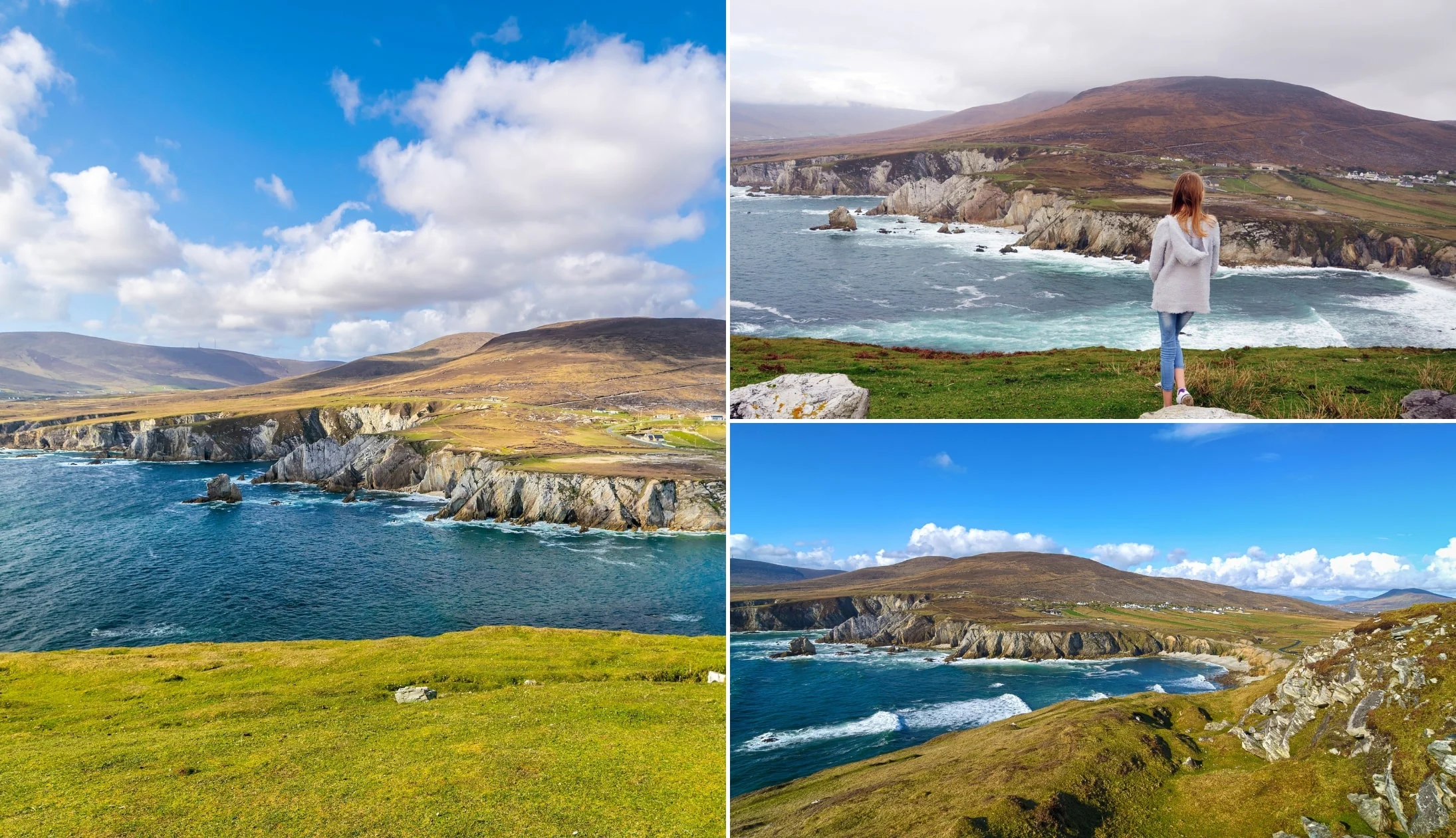
Photos via Shutterstock
The White Cliffs of Ashleam are another Achill Island highlight that are well worth driving to. If you put “White Cliffs of Ashleam @ Wild Atlantic Way” into Google Maps, it’ll take you on a 30-minute drive from Keem to the viewpoint, taking in amazing scenery the entire way. The road winds up to the viewpoint, and from there, you’ll get a fantastic eyeful. The jagged, bright white cliffs seem to cut into the sea, which crashes against them in a violent yet beautiful display.
Stop 9: Grace O’Malley Towerhouse
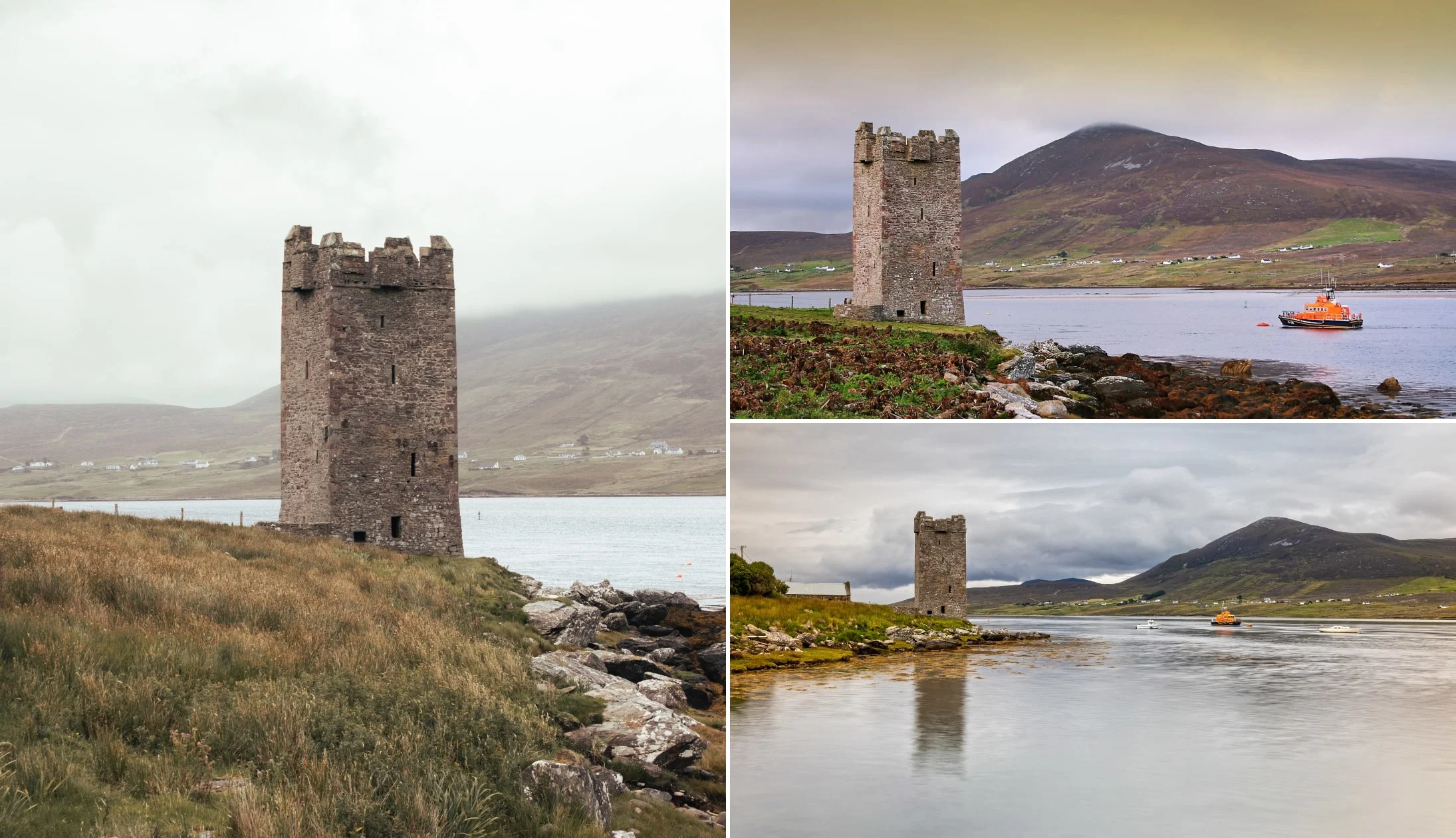
Photos via Shutterstock
Our final stop on Achill Island takes us to Grace O’Malley’s Towerhouse. It’s just an 11-minute drive from the White Cliffs of Ashleam on the edge of Achill Sound. The tower dates back to the 15th century and was famously used by Grace O’Malley, the legendary Pirate Queen, who ruled the island hundreds of years ago. You’ll find a small car park at the tower, and if you want to get close, just hop over the stile and walk over.
Stop 10: Back to Westport for the night
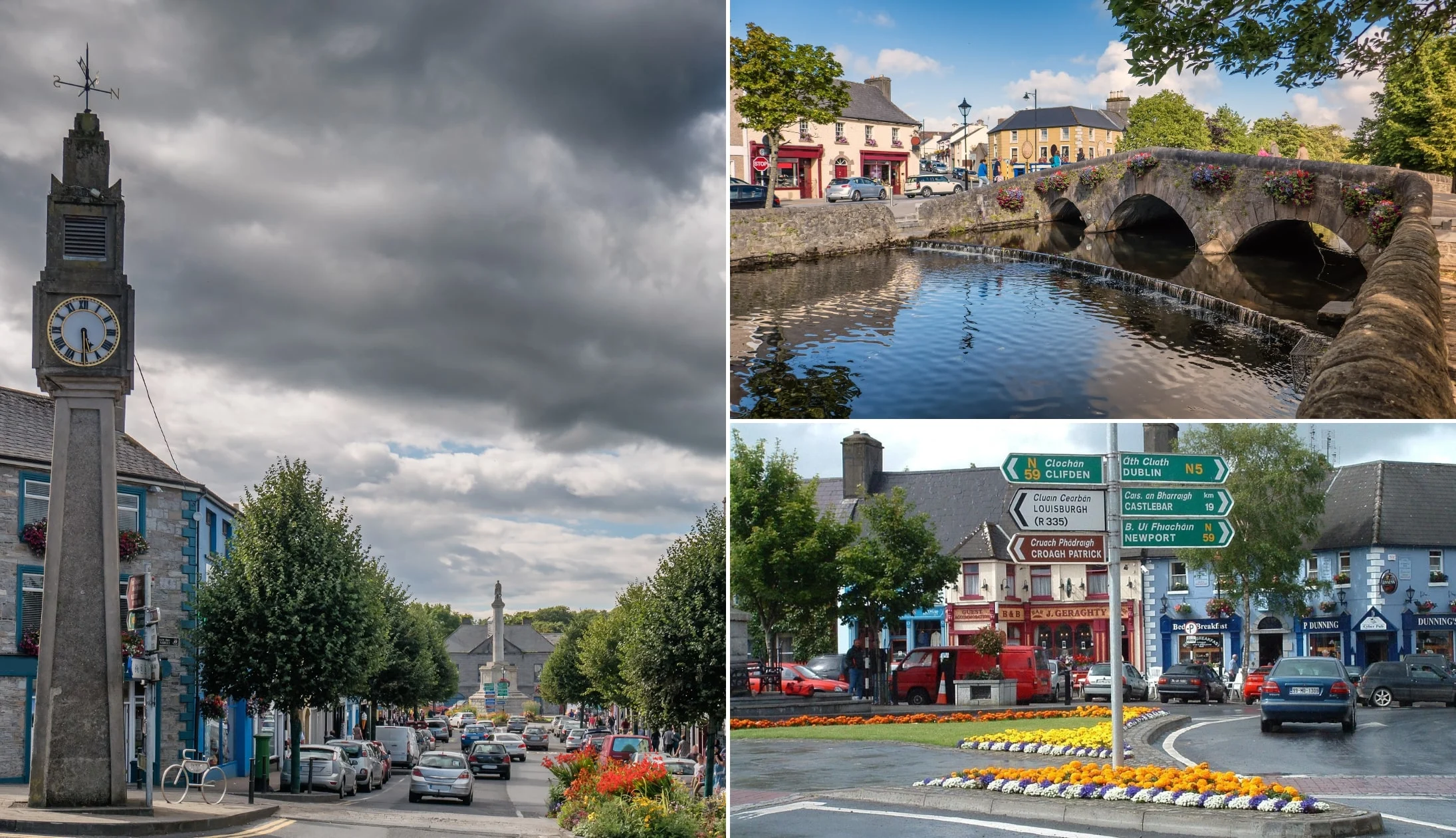
Photos via Shutterstock
Our final stop for the day takes us back onto the mainland and to the vibrant seaside town of Westport, which is about 50 minutes away.
Along the way, we’ll pass Clew Bay, which is home to 365 islands, one for each day of the year. After a long day on the road, you’ll want to check into your accommodation, freshen up, and then reward yourself with dinner and a few drinks in town.
Our Westport food recommendations
There’s some excellent restaurants in Westport and the town is another great place for locally-sourced food, with a host of restaurants to choose from. The award-winning An Port Mor, located in the town centre, is one of the best, with an array of succulent dishes, including the ever-popular Clew Bay Lobster.
JJ O’Malleys is another great choice, beloved by locals and visitors alike for its extensive menu that combines traditional Irish food and seafood with contemporary dishes. Plus, the decor is fantastic!
Our Westport pub recommendations
There’s some mighty pubs in Westport, too! For an end-of-day pint, you’d struggle to beat a visit to Toby’s Bar.
Small and unassuming, it’s a favourite among locals, with a friendly crowd of regulars. It boasts a fantastic atmosphere and many say that they pour the best pint of Guinness in town.
Blousers is another great option, especially on a cold night. A dram of whiskey or a pint by the roaring fireplace is always a welcome treat, plus they’ll often have live music.
The most iconic pub for live music in Westport is definitely Matt Molloy’s. It’s owned by the flautist from The Chieftains (if you’ve not heard them, check them out!) and offers traditional Irish music live every night. It has a lively atmosphere and often attracts a crowd.
Day 8: Croagh Patrick
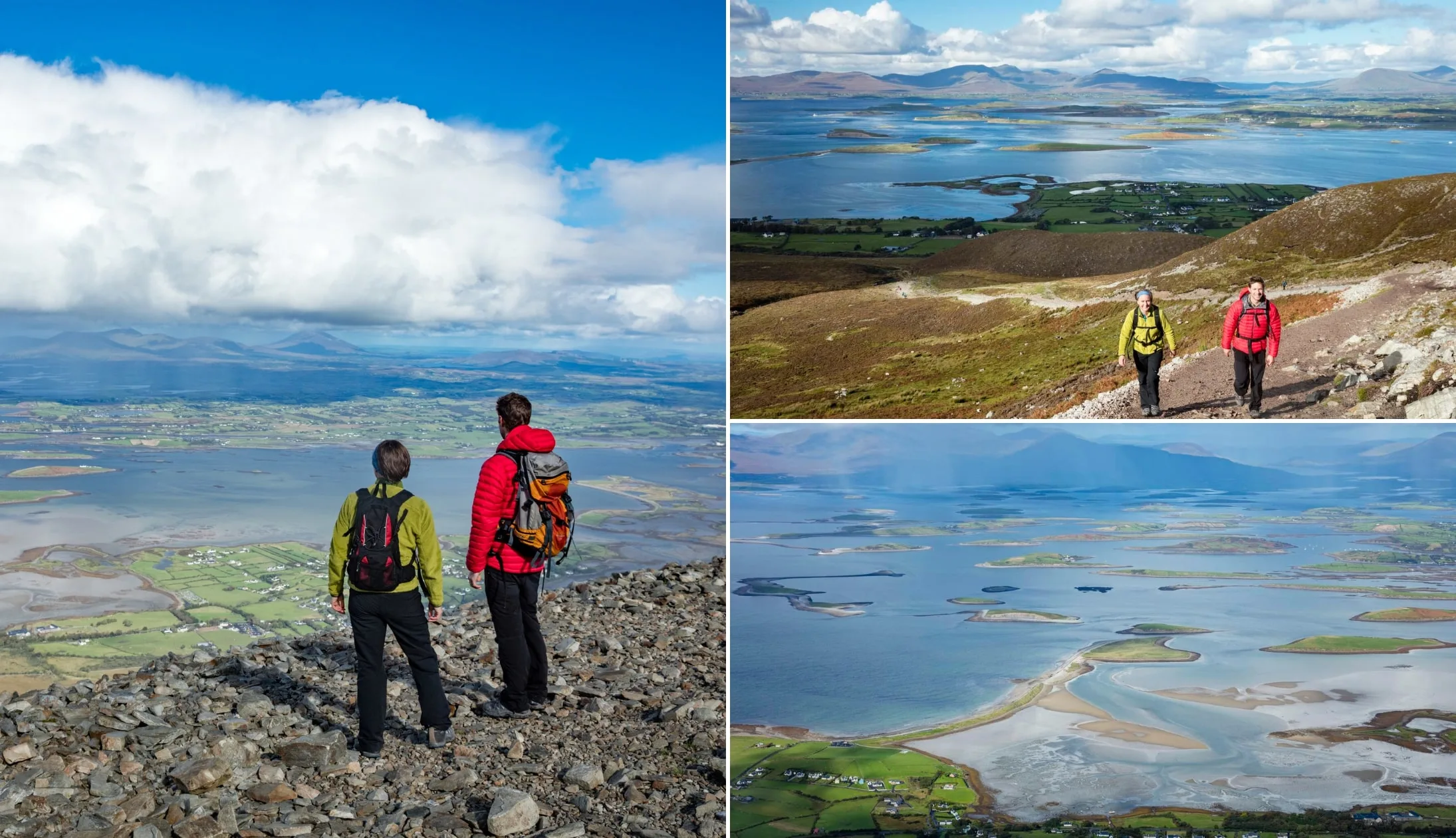
Photos courtesy Gareth McCormack/garethmccormack via Failte Ireland
Day 8 sees us tackling the spectacular Croagh Patrick hike, the fourth-highest mountain in County Mayo.
It’s an excellent way to spend the morning, and if the weather is clear, you’re in for some superb views from the top. Make sure to pack decent footwear and clothes for sun, rain, and wind. It’s also well worth stocking up on plenty of water and snacks to fuel your trek up this holy mountain.
First things first, you’ll want to grab a hearty breakfast either at your accommodation or in town. If you’re heading into town, This Must Be The Place serves up a mighty feed and a superb cup of coffee. The menu encompasses a bunch of healthy breakfast classics, as well as vegan options, toasties, and tasty cakes.
If you’re craving something not quite so healthy, get down to Cian’s for one of the best full Irish breakfasts in the country. The locally sourced ingredients make all the difference and it makes for a decadent start to the day.
Stop 1: Croagh Patrick
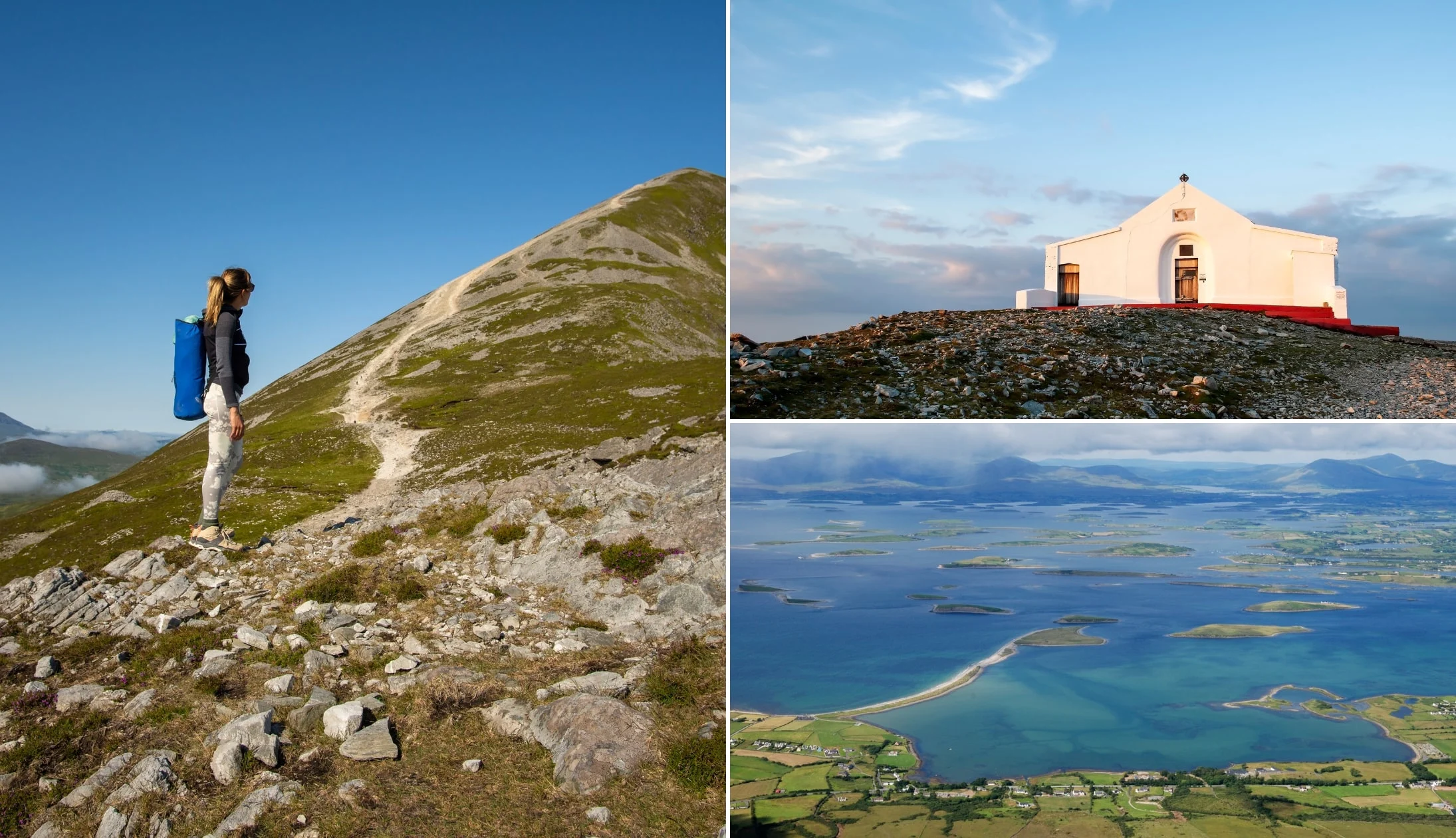
Photos via Shutterstock
The path up to the summit of Croagh Patrick is well-signed and really easy to follow. While the pilgrimage starts from the village of Murrisk, you can start it from Murrisk Car Park, which sits at the foot of the mountain. The car park is just a 12-minute drive from Westport and should cost €3 for the entire day. Bear in mind you’ll need to pay in cash.
Croagh Patrick, also known as “The Reek”, stands at an impressive 764 metres tall, and while the hike up is easy enough to follow, it’s pretty hard-going. There’s a lot of climbing up steep inclines and steps, with very few flat sections for the first 20 minutes or so. It’s worth the effort though, and from the summit, you’ll enjoy breathtaking views over Clew Bay. With its 365 islands, it really is a sight to behold.
The hike up and down can take anywhere between 2.5 hours to 5 hours on average, depending on fitness and photo stops. It’s tough but doable for anyone in reasonable shape. Once you get back down, you can grab a refreshing pint at the Tavern, just down the road from the car park. They also do great food, so if you fancy it, you could have lunch here.
Stop 2: Back to Westport for lunch
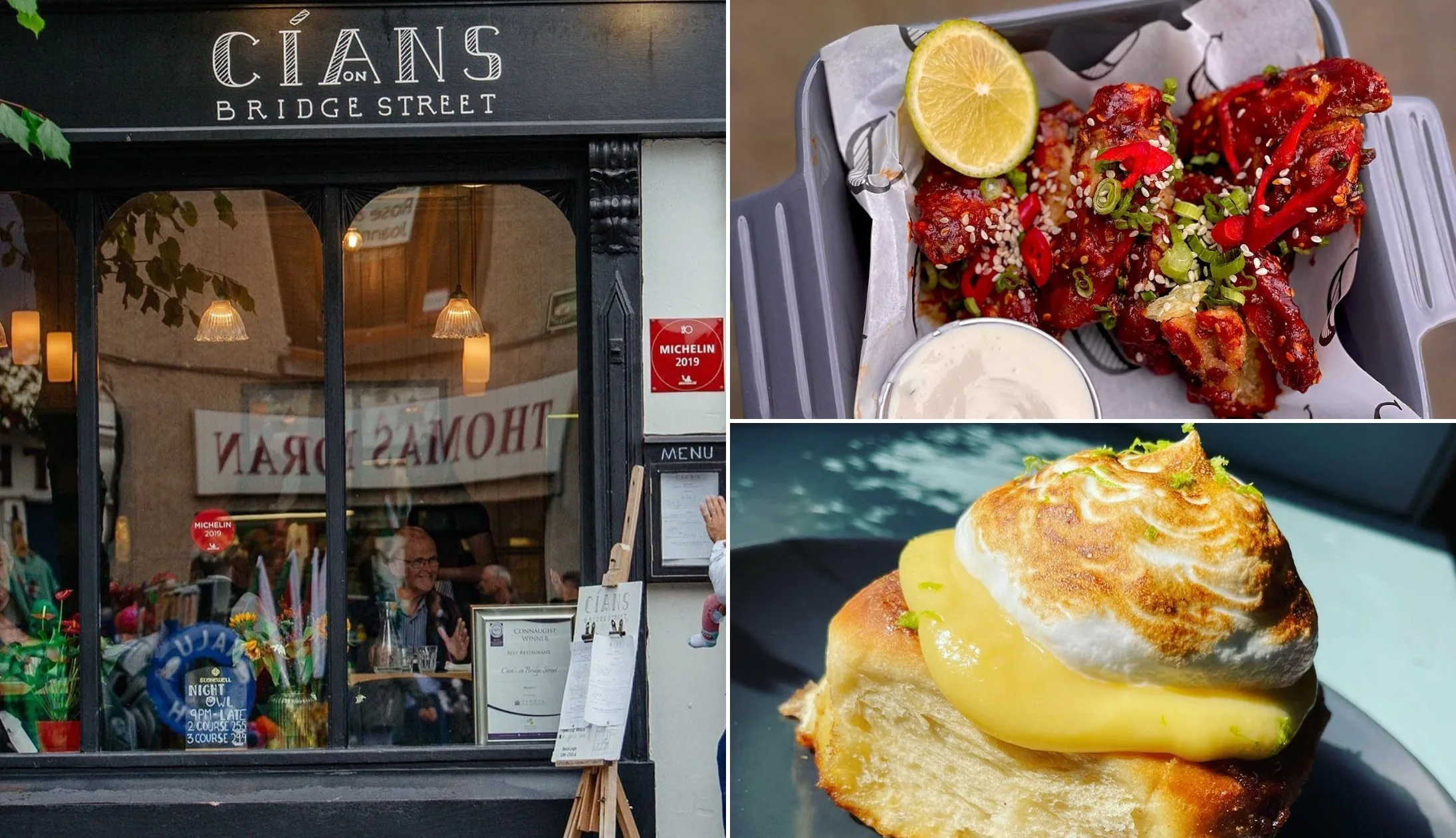
Photos via Cian’s on FB
After giving yourself a pat on the back from conquering Croagh Patrick, it’s time to head back to Westport and grab a shower.
If you haven’t had lunch yet, we’ve plenty of great options for you in Westport. Friends Bistro is one of our favourite spots, and they do amazing burgers, mussels, and desserts to die for. They also offer lighter lunches, with a nice selection of sandwiches, soups, and salads, plus veggie options.
Cian’s is another favourite, especially their seafood chowder. They do a great selection of Irish dishes and seafood, as well as juicy burgers.
Stop 3: Westport House
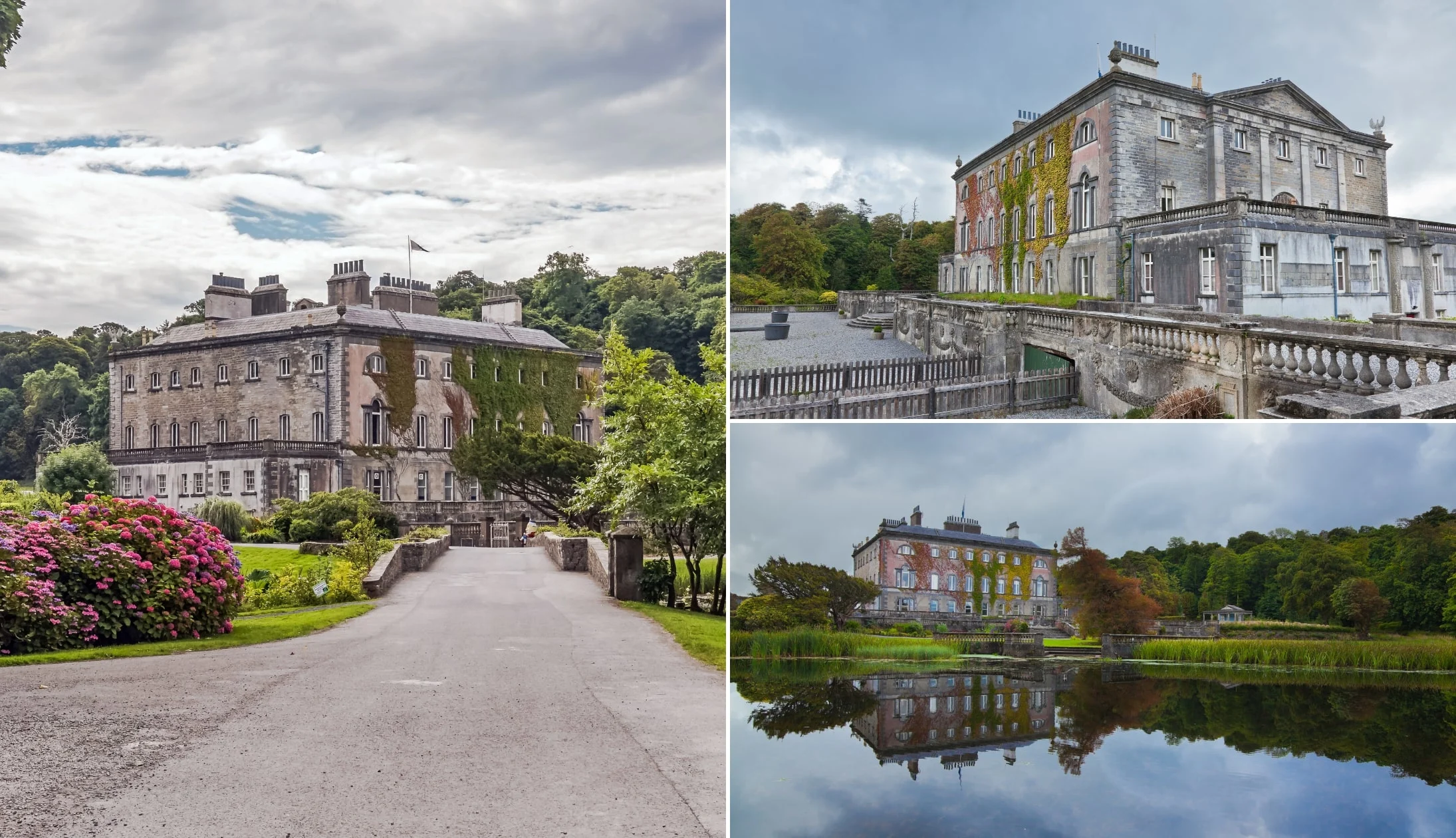
Photos via Shutterstock
We’ll take it easy this afternoon, driving just five minutes out of town to the historic Westport House. Dating back to 1730, the house has been welcoming guests for hundreds of years. There’s plenty to do during your visit too. The gorgeous grounds and gardens are just waiting to be discovered, and there’s now a 3.5 km looped walk that takes you through the woods and alongside the lough.
Inside, you’ll feel as if you’ve stepped back in time. Take a guided tour to discover the history of the house and the family that called it home, or wander the halls at your own pace with a self-guided audio tour.
Stop 4: Dinner, drinks and live music
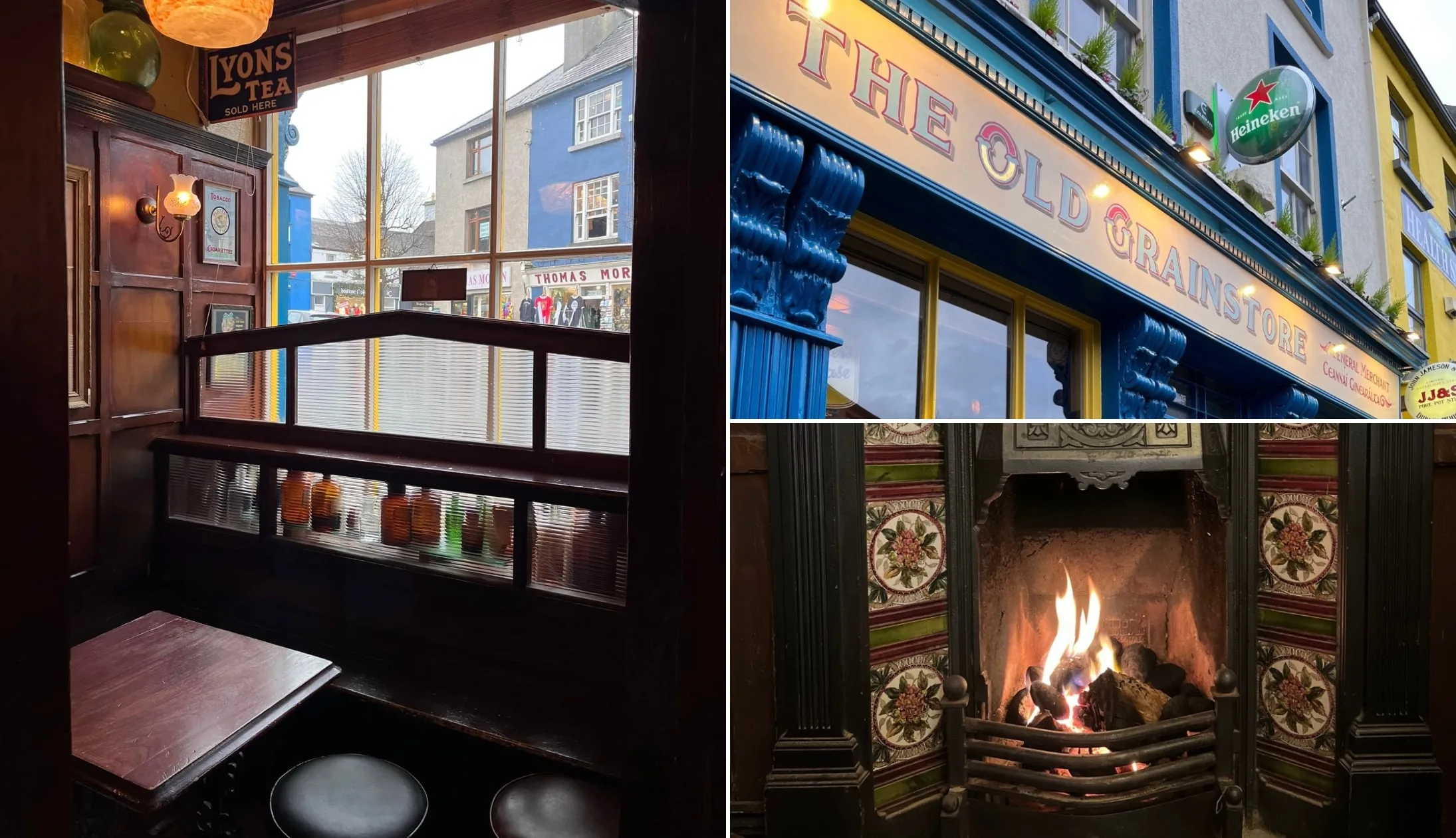
Photos via The Old Grainstore on FB
After this morning’s walk, it’s worth taking it easy this evening. So, why not grab dinner and finish your night with a pint at the iconic Matt Molloy’s Pub for some of the best live trad sessions this side of the Shannon?
Our Westport food recommendations
There’s some excellent restaurants in Westport and the town is another great place for locally-sourced food, with a host of restaurants to choose from. The award-winning An Port Mor, located in the town centre, is one of the best, with an array of succulent dishes, including the ever-popular Clew Bay Lobster.
JJ O’Malleys is another great choice, beloved by locals and visitors alike for its extensive menu that combines traditional Irish food and seafood with contemporary dishes. Plus, the decor is fantastic!
Our Westport pub recommendations
There’s some mighty pubs in Westport, too! For an end-of-day pint, you’d struggle to beat a visit to Toby’s Bar.
Small and unassuming, it’s a favourite among locals, with a friendly crowd of regulars. It boasts a fantastic atmosphere and many say that they pour the best pint of Guinness in town.
Blousers is another great option, especially on a cold night. A dram of whiskey or a pint by the roaring fireplace is always a welcome treat, plus they’ll often have live music.
The most iconic pub for live music in Westport is definitely Matt Molloy’s. It’s owned by the flautist from The Chieftains (if you’ve not heard them, check them out!) and offers traditional Irish music live every night. It has a lively atmosphere and often attracts a crowd.
Day 9: Connemara
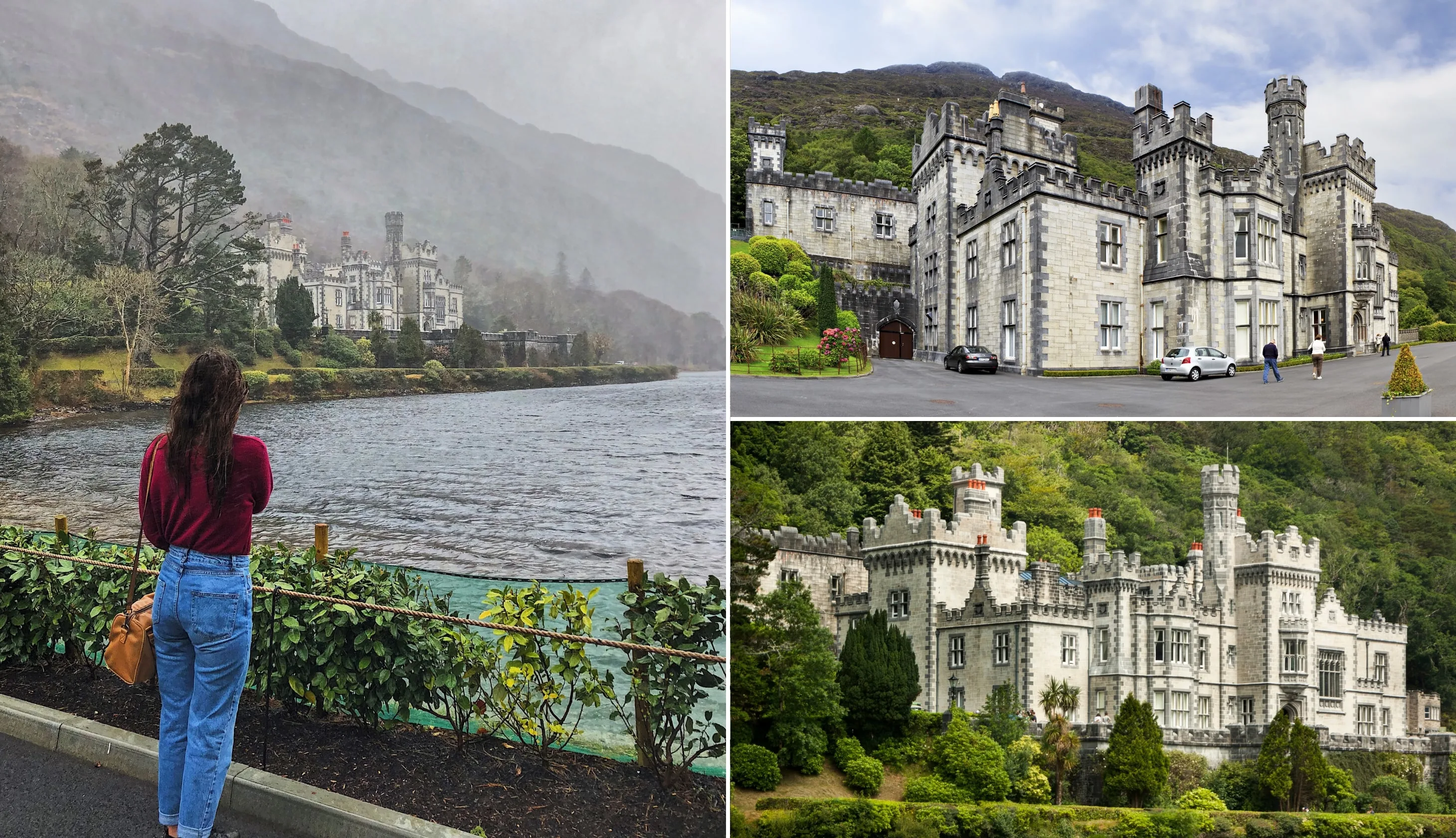
Photos via Shutterstock
Today you’re heading down through Connemara (an incredibly scenic part of the country) to Galway City, where you’ll be spending two nights.
You’ve got a busy day ahead, so enjoy a hearty breakfast at your accommodation, or, if you’d prefer to have breakfast out, Christy’s Harvest and This Must Be The Place are both solid choices.
Recommended accommodation in Galway
- Budget: Feeney’s Audubon Lodge (in Salthill outside of the city by the sea) and Corrib View Guesthouse (a 45-minute walk from Eyre Square)
- Mid-range: Balcony House B&B (10-minute walk from Eyre Square) and Ash Grove House (gorgeous guesthouse near Galway Cathedral)
- Luxury: The G Hotel (luxury hotel in the city) and Glenlo Abbey (one of Ireland’s top hotels – 15-minute drive from the city)
Stop 1: Silver Strand in Louisburg
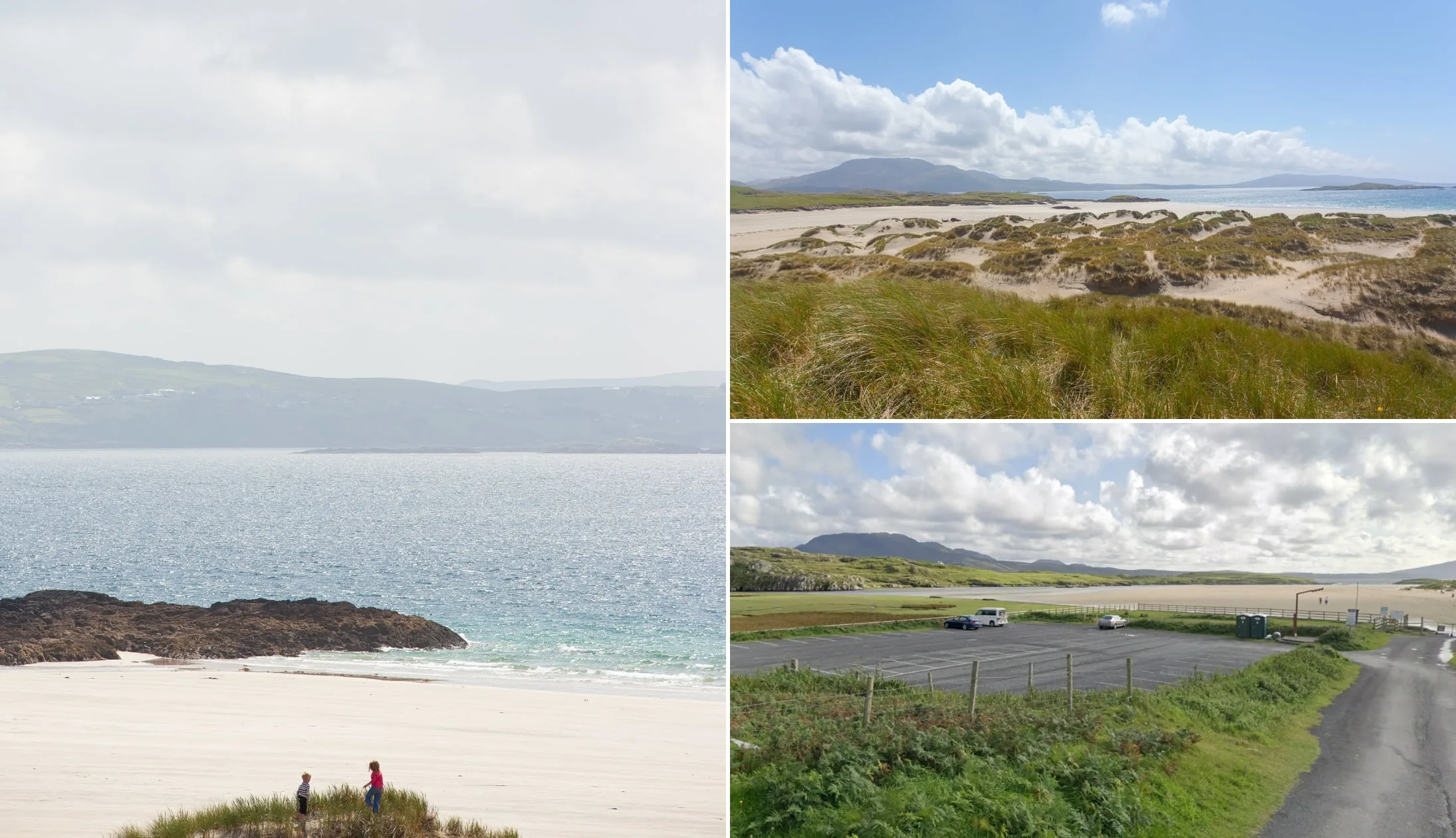
Photo left and top right: Kelvin Gillmor. Other: Google Maps
Today’s drive is all about taking in some of Ireland’s most stunning landscapes. This first leg takes us on a short but sweet 25-minute drive from Westport to the charming village of Louisburg.
The road hugs the southern edge of Clew Bay, with the sea and its many islands on one side and the mighty Croagh Patrick mountain on the other.
Once you arrive in Louisburg, feel free to park up, stretch your legs, and grab a cup of coffee. Tia Cafe does a great cup, plus tasty cakes and bakes, and you can normally park right out in front on the roadside.
When you’re ready, take the short drive around to Silver Strand Beach. This is one of the Wild Atlantic Way’s finest, so soak up the sights, sounds and fresh sea air for a bit.
Stop 2: The Doolough Valley
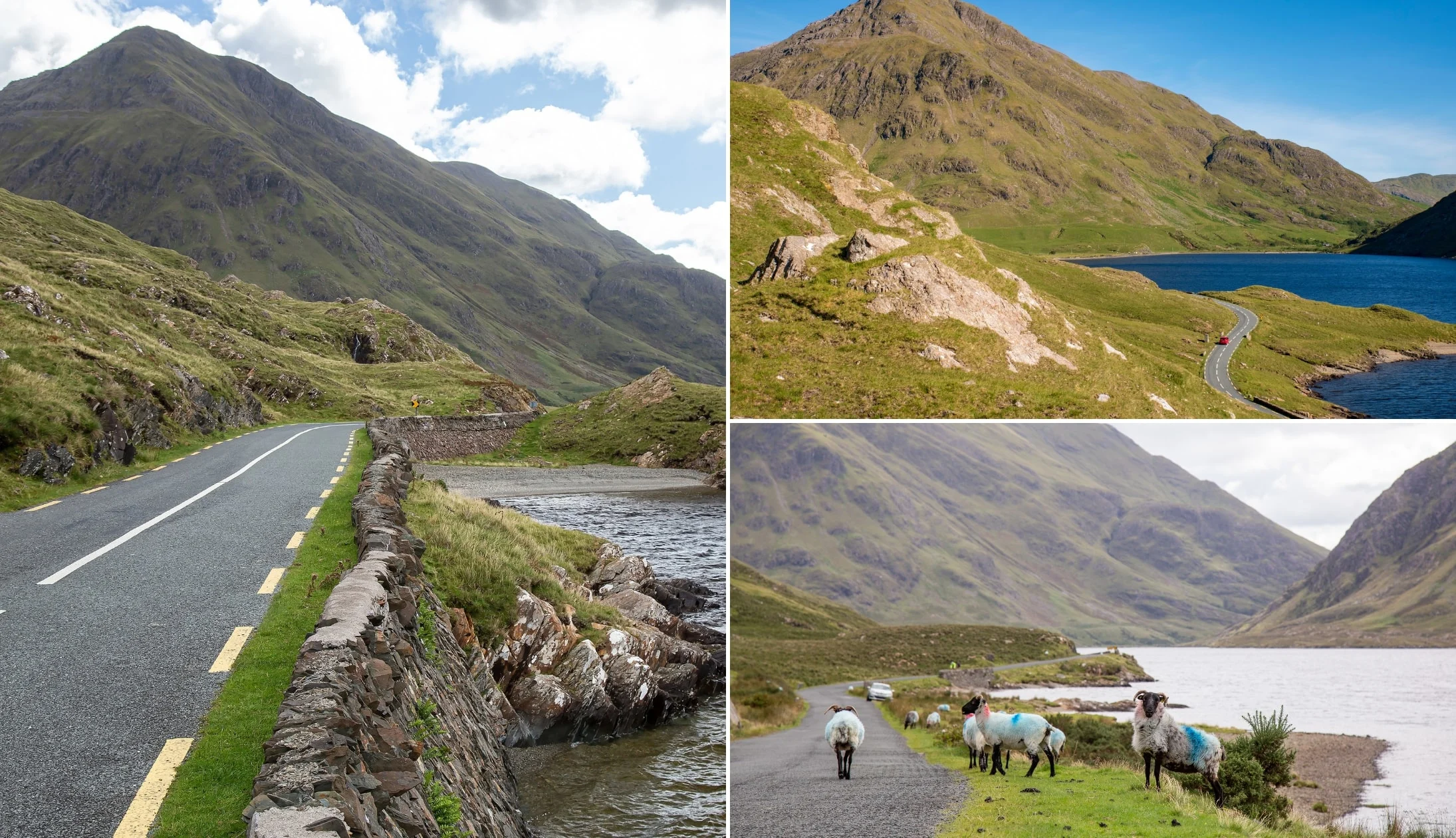
Photos via Shutterstock
After you leave Louisburgh, you’ll be making your way to Leenane via the outstanding Doolough Valley.
This stretch of road is one of the most scenic drives in Ireland, and you’ll often find the place virtually empty.
Before you enter the valley, you’ll reach a Wild Atlantic Way viewpoint sign. Stop here, and you’ll have a view of the area in the photo above.
When you’re ready, follow the road as it winds around the ink-black waters of the Killary Fjord towards the village of Leenane.
Stop 3: Aasleagh Falls
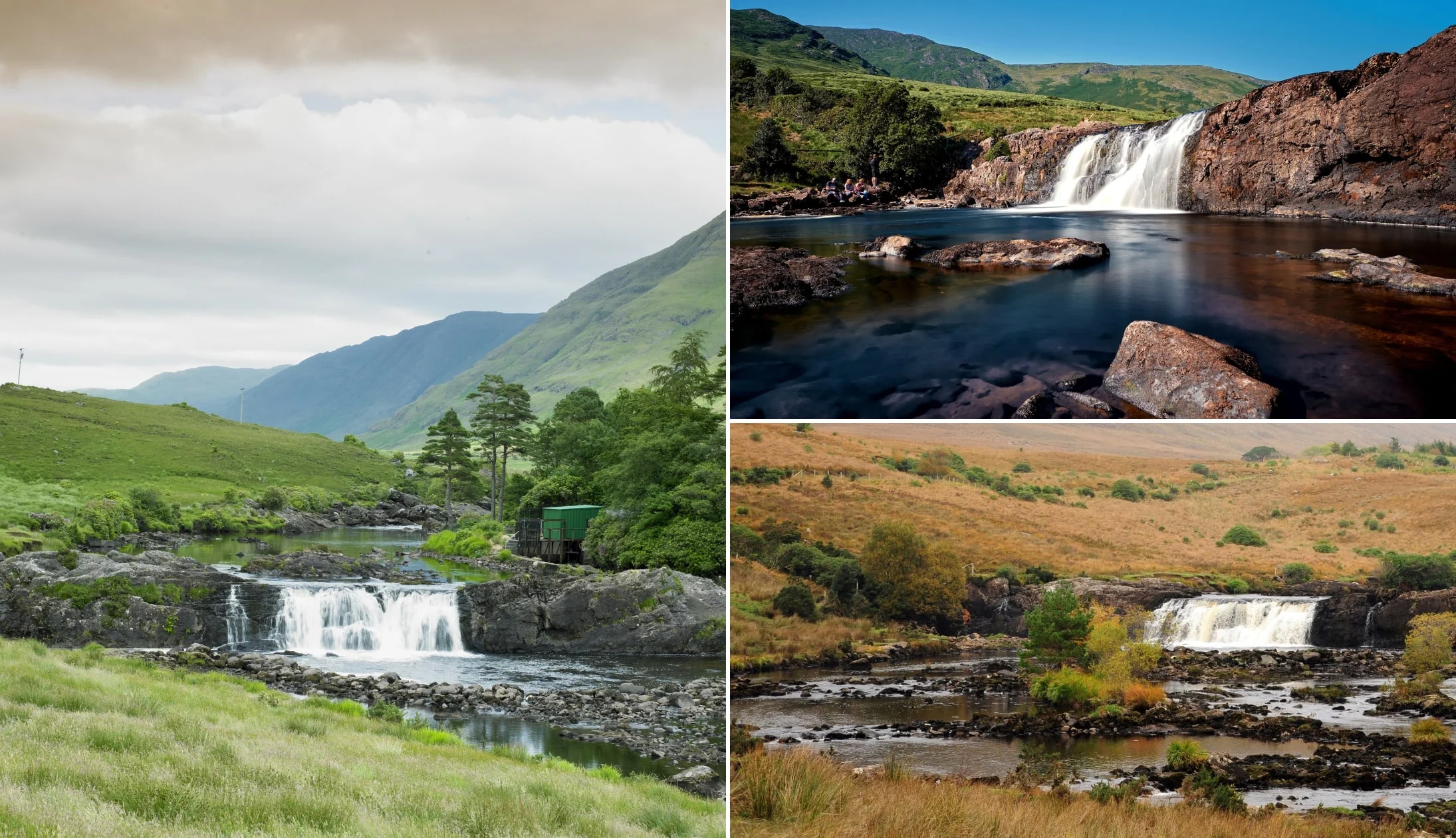
Photos via Shutterstock
Take your time on the 35-minute drive through Doolough, and you’ll eventually reach Aasleagh Falls, which lies at the head of Killary Fjord.
There are two car parks at the falls, and it’s just a short walk to the cascade. However, with no official path to the waterfall, be prepared to cross a mucky field. It’s a gorgeous cascade, especially after the rain, and it’s a fine place to relax a little while, contemplating the meaning of life as the tranquil sound of running water fills the air.
Stop 4: Leenane and Killary Fjord
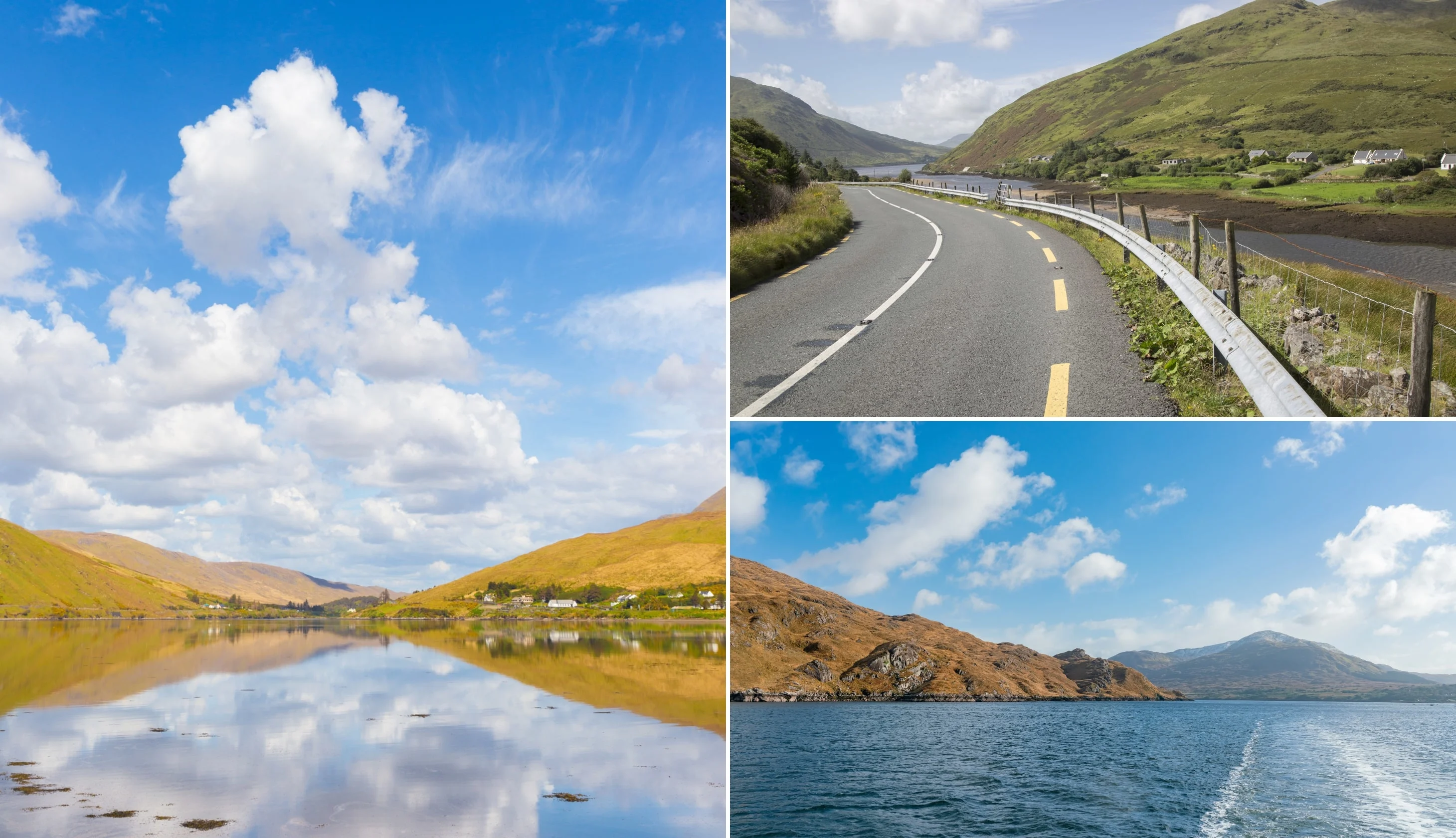
Photos via Shutterstock
The gorgeous village of Leenane is just a short 5-minute drive from the waterfall. It sits on the edge of Killary Fjord and it’s another area of spectacular scenery. The village offers a truly authentic experience of rural Ireland, and for most of the year, it’s pretty quiet, although it can get busy in summer.
Having said that, there are plenty of attractions. It’s perhaps most well-known for serving as the impressive backdrop to Jim Sheridan’s classic, ‘The Field’, starring Richard Harris, John Hurt, Sean Bean, Brenda Fricker, and Tom Berenger. Fans of the movie will recognise much of the village, especially Gaynor’s Bar, which starred as the local pub in the film.
The Sheep and Wool Centre is always worth checking out, and you can find hand-crafted woolly sweaters, scarves, and much more while learning about how they’re made.
Stop 5: Kylemore Abbey

Photos via Shutterstock
Our next stop is the epic Kylemore Abbey. Built in 1867, it’s perched on the edge of both Pollacapall Lough and the breathtaking Connemara National Park. As you wander the grounds, enjoy the gardens, church, and abbey before checking out the tea room and gift shop.
The grounds cover a staggering 13,000 acres of land and include magnificent gardens, walks and woodlands. Meanwhile, inside the tour takes visitors on a journey through the many generations of people who have dwelled, worked, studied and prayed inside the castle’s magnificent walls.
Visitors will have stories brought to life in spectacular fashion via historical photographs, audio-visual presentations, artefacts, historical costumes and much more.
Stop 6: Lunch in Letterfrack
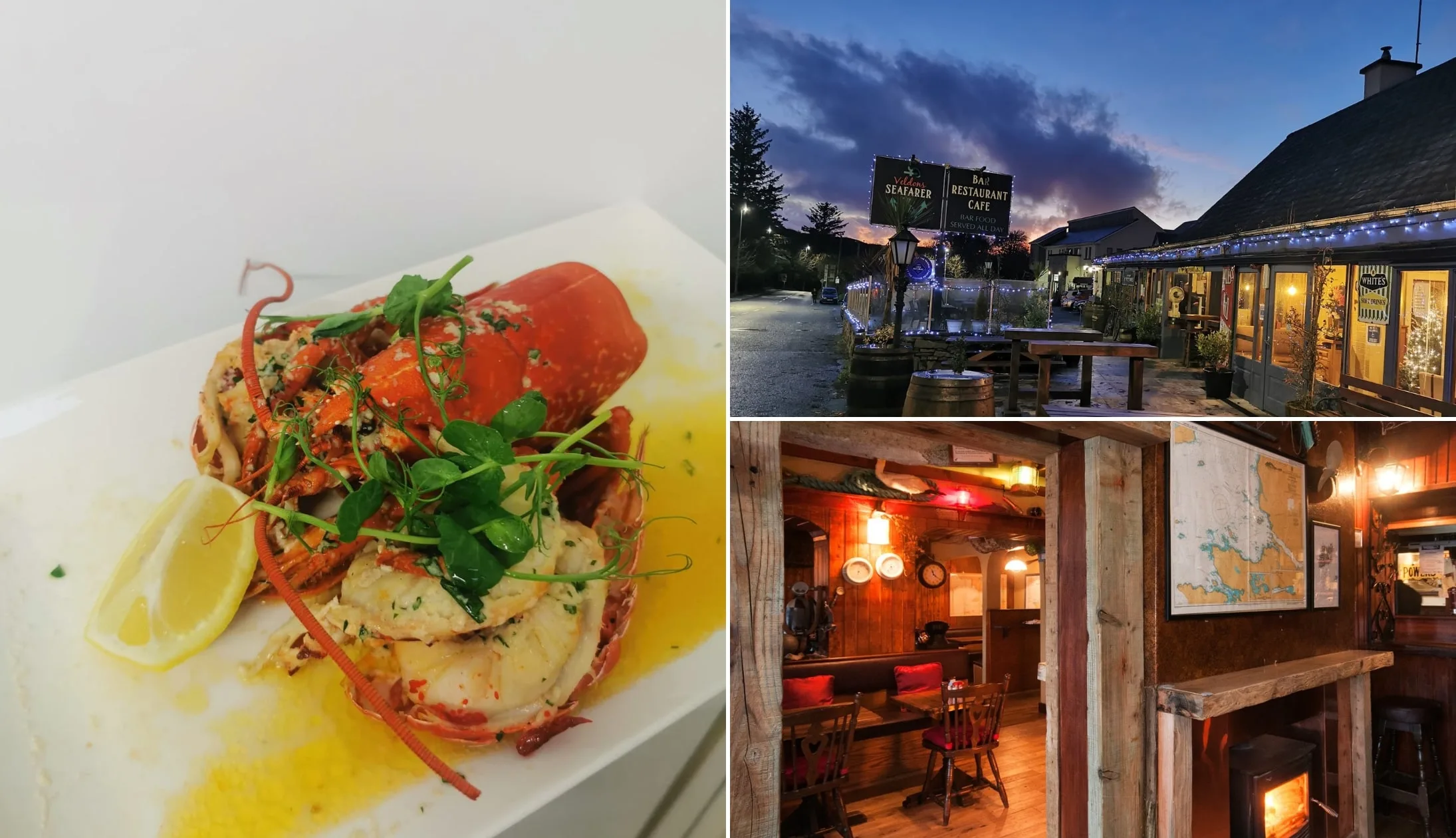
Photos via Veldons on FB
Just 7 minutes down the road from Kylemore Abbey, the bustling village of Letterfrack is a great choice for lunch. You’ve got some fantastic options too. One of our favourites is the Clover Fox Restaurant and Bar. This traditional pub boasts open fires and a welcoming atmosphere, as well as a varied menu that takes in fresh, local seafood and a wealth of classic Irish dishes.
For more sumptuous seafood, Veldons Seafarer Bar and Restaurant is an excellent choice, and their seafood platter is hard to beat. For a lighter lunch of sandwiches, toasties, quiche, cakes, and coffee, the Hungry Hiker is a must. You can sometimes find street parking in Letterfrack. Otherwise, park up at the Connemara National Park Visitor Centre.
Stop 7: Diamond Hill
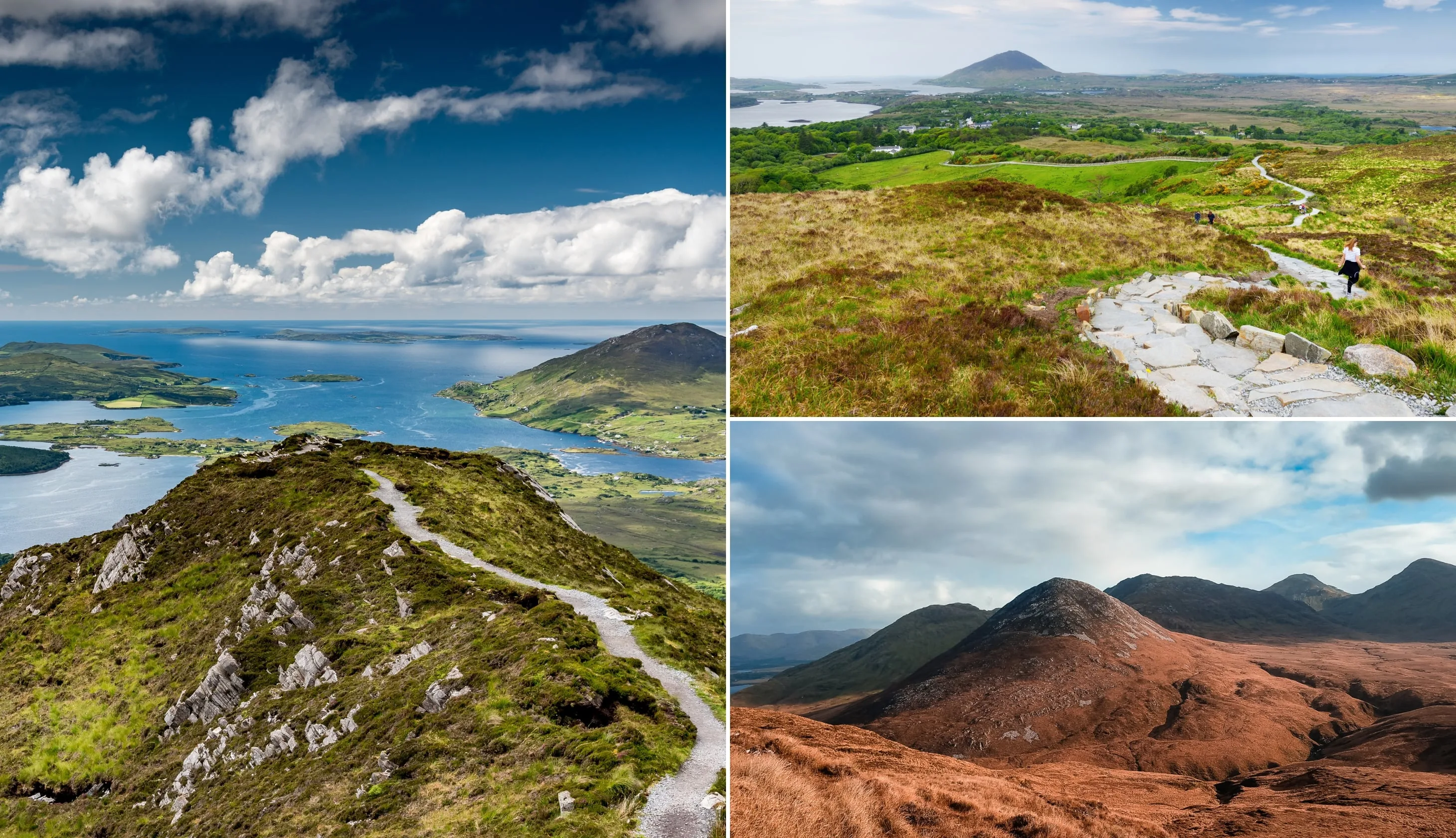
Photos via Shutterstock
Diamond Hill is one of our favourite hikes in Connemara, and the views from the top are sure to take your breath away. From the car park at the Connemara National Park Visitor Centre, you’ll see a number of signed walks, including two that take you up Diamond Hill. The Lower Trail is about 3 km long and typically takes an hour and a half to complete. While it doesn’t go all the way to the summit, it still offers spectacular views.
The Upper Trail is an extension of the Lower Trail. It’s a bit tougher, typically taking up to three hours to complete, but the views are more than worth the effort! Whichever route you choose, you’ll normally come across wild goats along the way!
Be advised these walks can both be very busy on weekends in the summer season.
Stop 8: The Sky Road
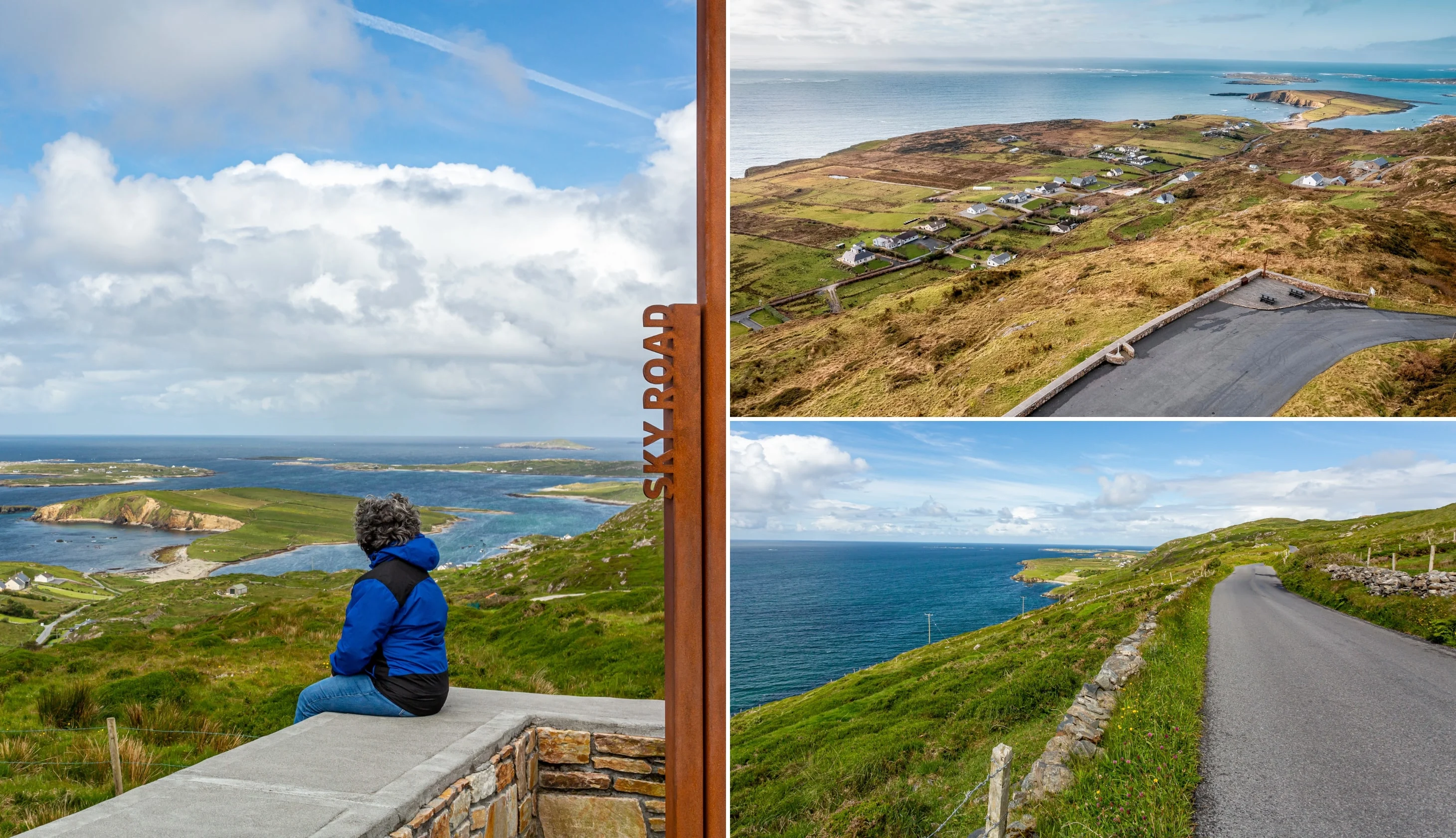
Photos via Shutterstock
Head 18 minutes south to Clifden and then follow signs for The Sky Road.
The Sky Road is a breathtaking 16km loop. It begins in Clifden, making its way around the Kingston peninsula along a coastal road with stunning views. Along the way, the loop passes by Clifden Castle, a ruined manor house overlooking the water.
After the castle, the Sky Road deviates into two routes which join up again later, the lower road which has close-up views of the sea, and the upper road, which has views over the bay.
Some scenic stops along the way are Clifden Castle, the viewing point on the upper road, and Eyrephort Beach. We’d say two hours is a good length to spend on the Sky Road including stops, but this depends on what time you begin the drive.
Stop 9: Dinner, drinks and live music in Galway
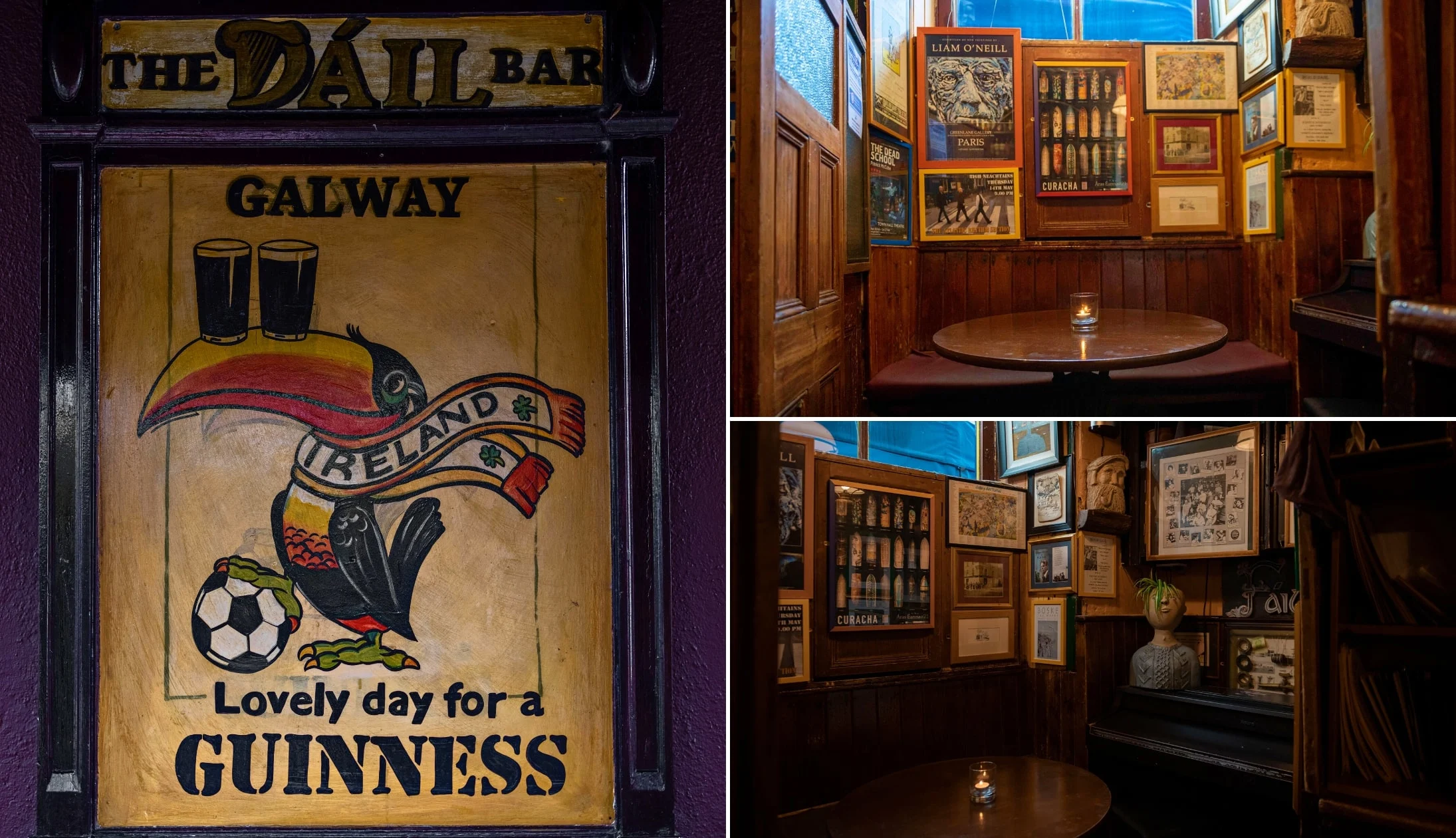
Photos courtesy Failte Ireland
Once you’ve finished the Sky Road loop, it’s time to head south to Galway, a roughly one hour and 20-minute drive. Check into your accommodation then head out for a night of food and music.
Galway is a lively city regardless of the time of year. Here’s some spots worth checking out:
Our dinner recommendations
There’s some excellent restaurants in Galway – our favourites are Ard Bia, The Quay Street Kitchen, and Dela. Ard Bia is absolutely fantastic, but you need to book in advance for dinner.
The restaurant has a quirky interior and serves beautifully presented modern dishes.
The Quay Street Kitchen has a great selection of vegan and vegetarian-friendly dishes, and Dela has modern Irish cuisine on the menu.
Live music and trad bars
There’s some mighty pubs in Galway. After dinner, head out for drinks at either Tigh Neachtain or The Crane. Both are traditional pubs with a great atmosphere.
Trad music is an integral part of the city, with heaps of options to choose from. Our favourite spots are Crane Bar (mentioned above) and Tigh Chóilí.
Day 10: Galway City
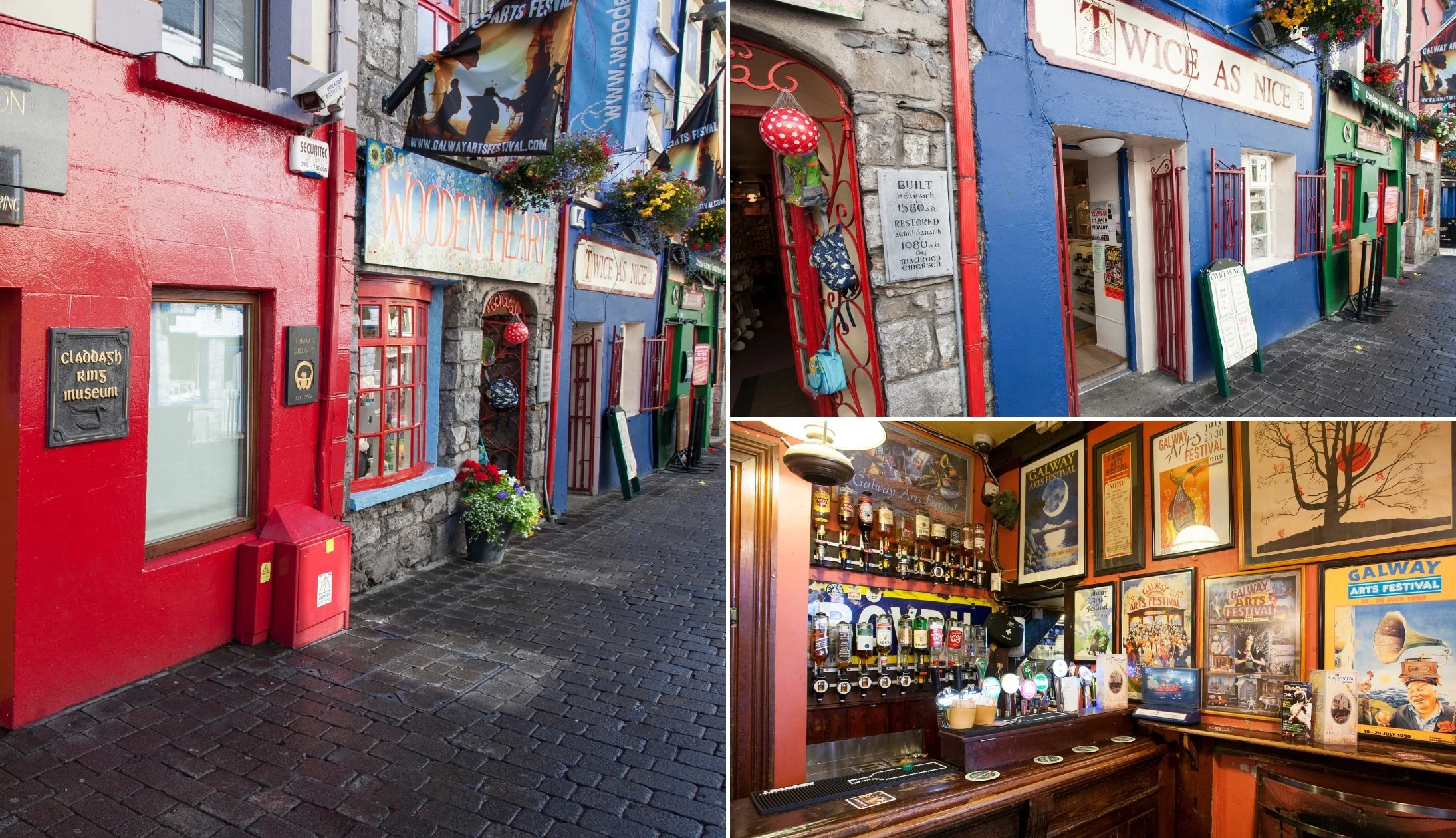
Photos by Stephen Power via Ireland’s Content Pool
Today, you’ve got the whole day to explore Galway and its wonderful attractions.
We’re going to recommend that you start your day out in Salthill, by the sea, before coming back into the city and either exploring on foot or via a hop-on/hop-off bus tour.
Stop 1: Breakfast in Salthill

Photos via Shutterstock
We’d recommend driving over to Salthill (5-minute spin) and start the day off with breakfast at Coco Cafe Salthill or Gourmet Food Parlour Salthill.
Then, enjoy a walk along the famous Salthill Promenade (and kick the wall) before heading back towards the city centre.
Stop 2: Decide how you’ll get around for the day
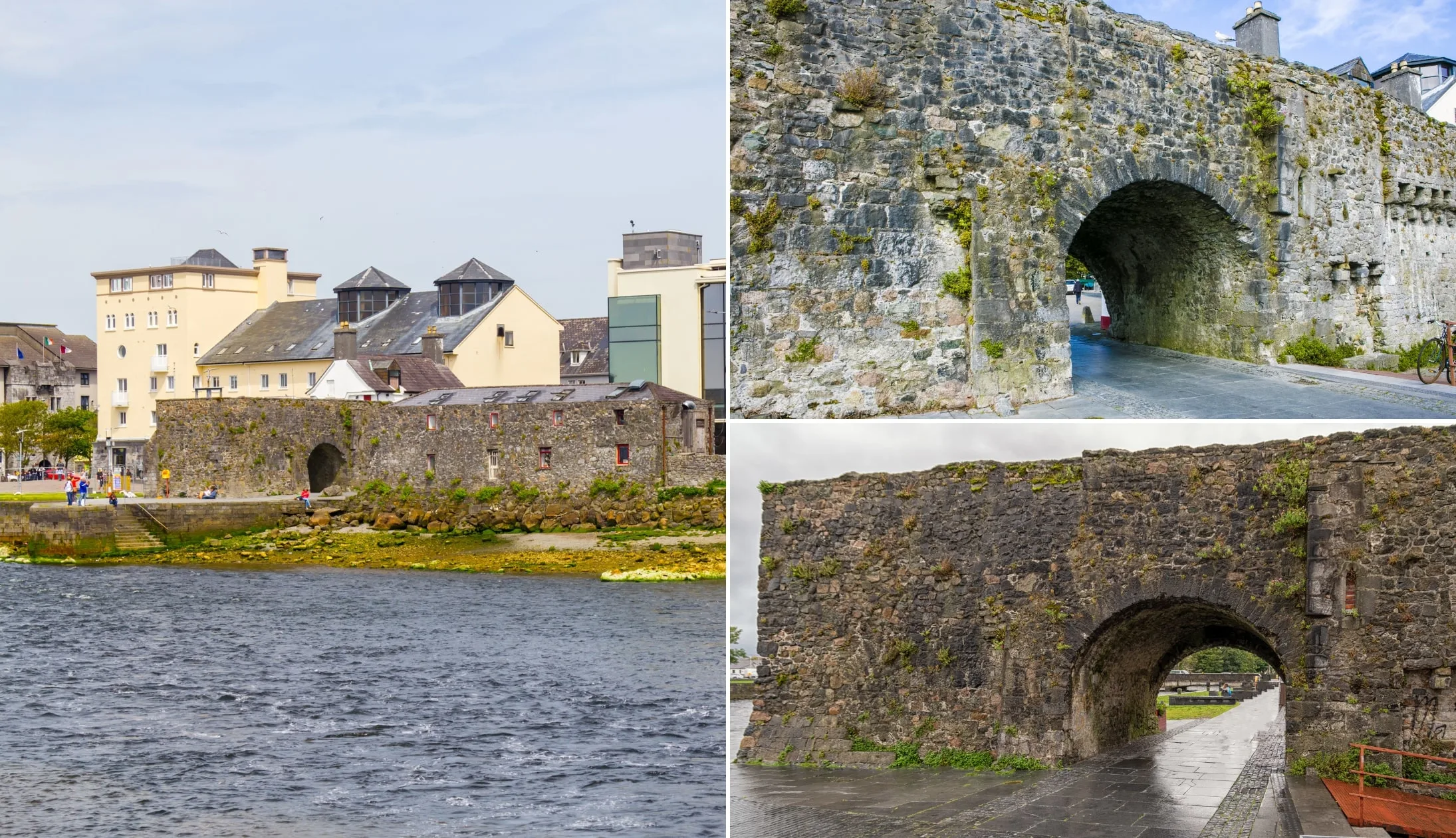
Photos via Shutterstock
Now, Galway is a very walkable city, but if it’s raining or if you fancy getting dropped to the ‘main’ attractions, the hop-on/hop-off bus tour is well worth buying.
Regardless of which option you choose, here are some of our favourite sites in Galway City (we’ve listed them in a logical way for you to walk between them).
Stop 3: Galway Cathedral
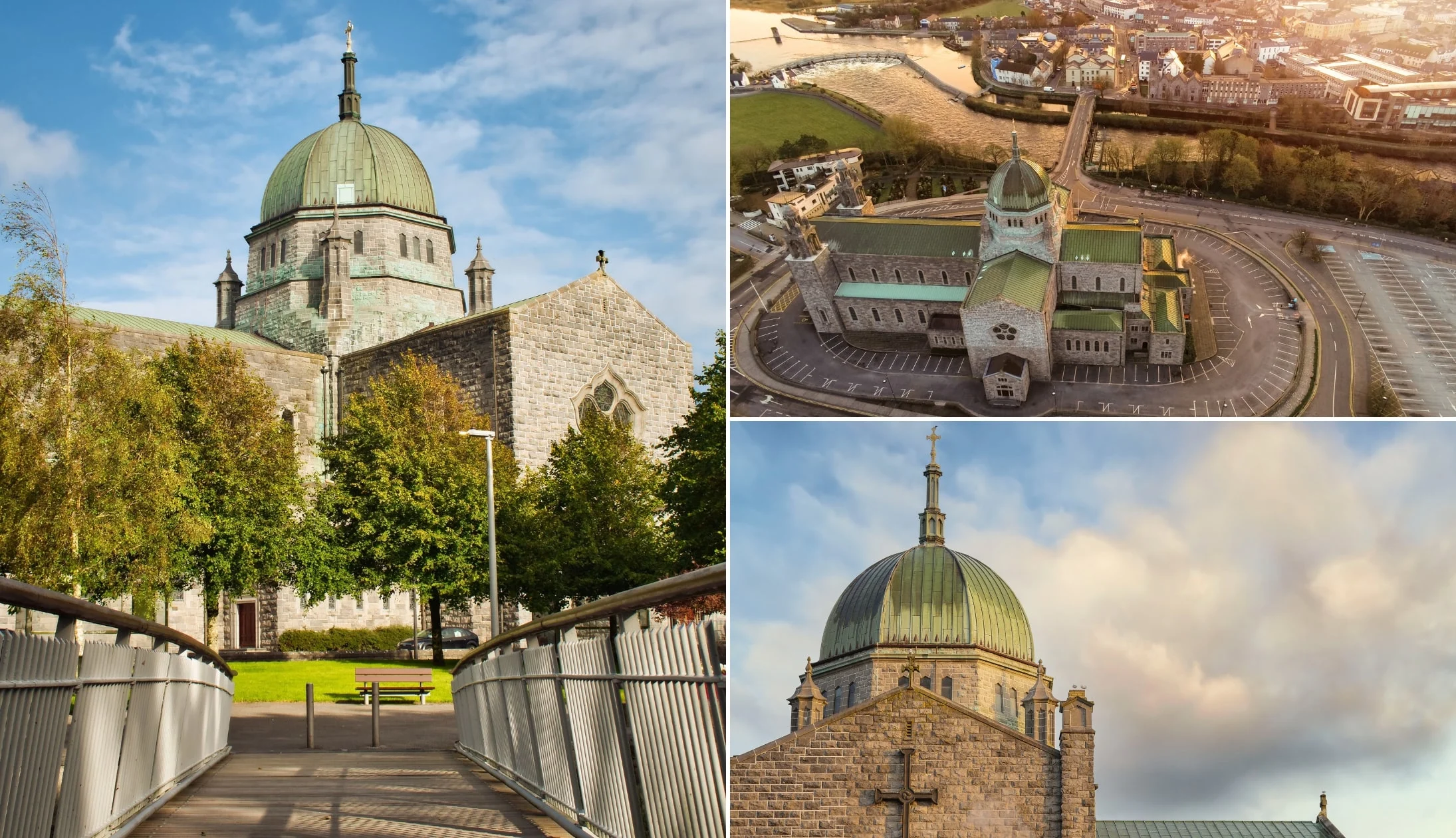
Photos via Shutterstock
Galway Cathedral is wonderfully impressive both inside and out. It’s arguably the jewel in the Galway City skyline and you’ll cop it from many places as you stroll around the city.
Interestingly enough, it’s not as old as it looks, and construction on the building was only completed in 1965, earning it the title of ‘the last great stone cathedral to be constructed in Europe’.
The cathedral is free to enter, but visitors are asked for a donation of €2 to help with the building’s upkeep.
Stop 4: Quay Street and the Latin Quarter

Photos by Stephen Power via Ireland’s Content Pool
Galway’s colourful streets are an absolute joy the ramble along regardless of the time of year.
If you’re walking from the cathedral, you’re a short stroll away from the Latin Quarter and Quay Street where you can have a nosey around.
These streets are alive with the buzz from tourists and locals alike.
Stop 5: Lunch
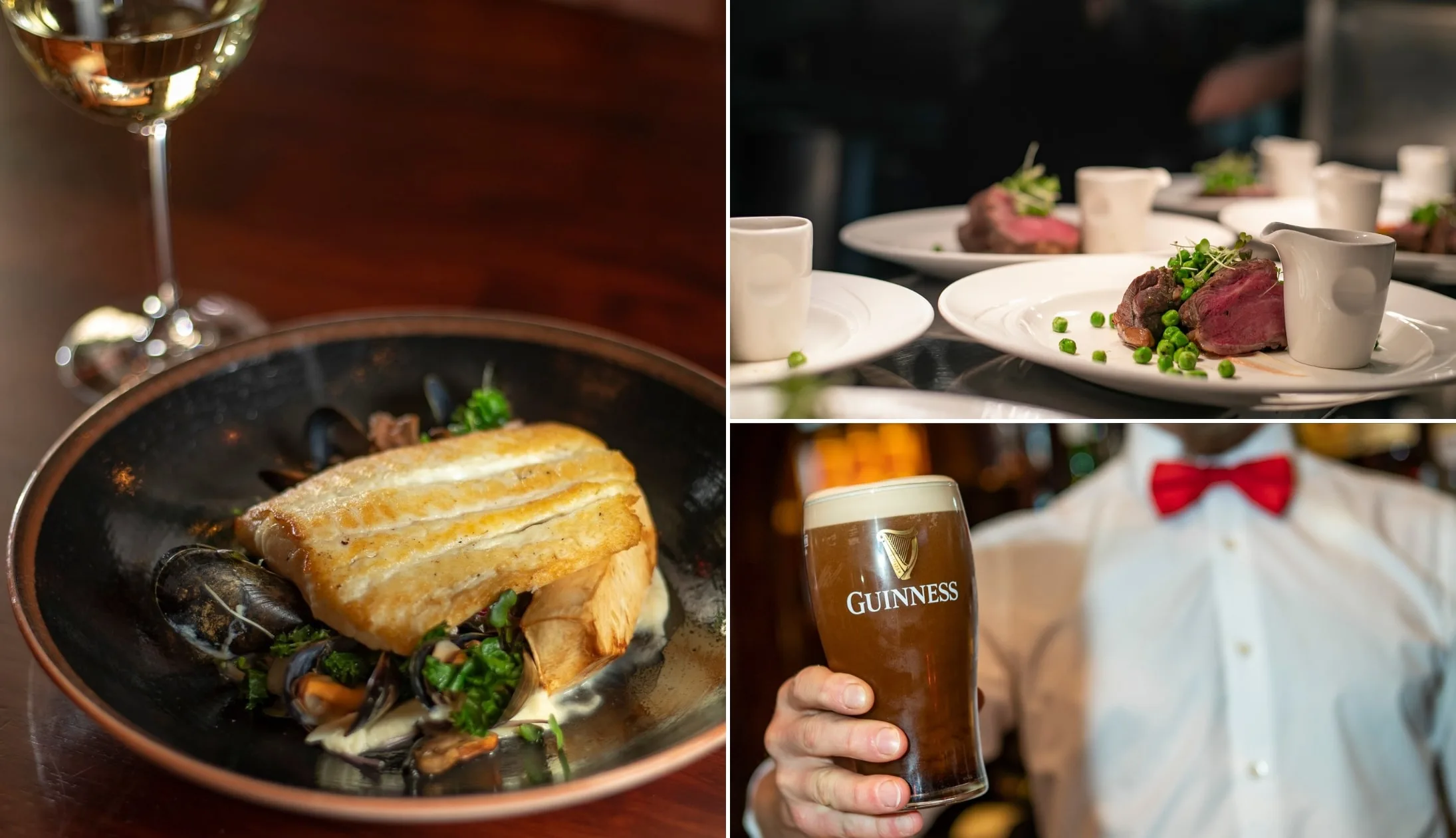
Photos via Blakes Bar Galway on FB
By now, you must be hungry. There are heaps of brilliant places for lunch in Galway, but if you don’t want the hassle of finding somewhere to eat, we’ve got a few suggestions!
We recommend Blakes Bar (traditional pub grub), Zappis (authentic Italian cuisine), or Tigh Neachtain (Irish and international cuisine).
Stop 6: The Hall of the Red Earl

One of our favourite places to visit in Galway (especially if it’s raining!) is the Hall of the Red Earl.
The Hall of the Red Earl is one of Galway’s most interesting sites. The ruins date back to the 13th century, with ties to the founding of Galway and the Anglo-Norman De Burgo family.
It was the first municipal building in the city, used for collecting taxes, hosting banquets, and sentencing criminals.
The Hall of the Red Earl was lost as the city grew until 1997, when the ruins were unearthed by archaeologists on behalf of the Office of the Public Works.
Today, you can walk amongst the ruins, view the artefacts, and learn about the hall’s history from the informative displays.
Stop 7: Galway City Museum
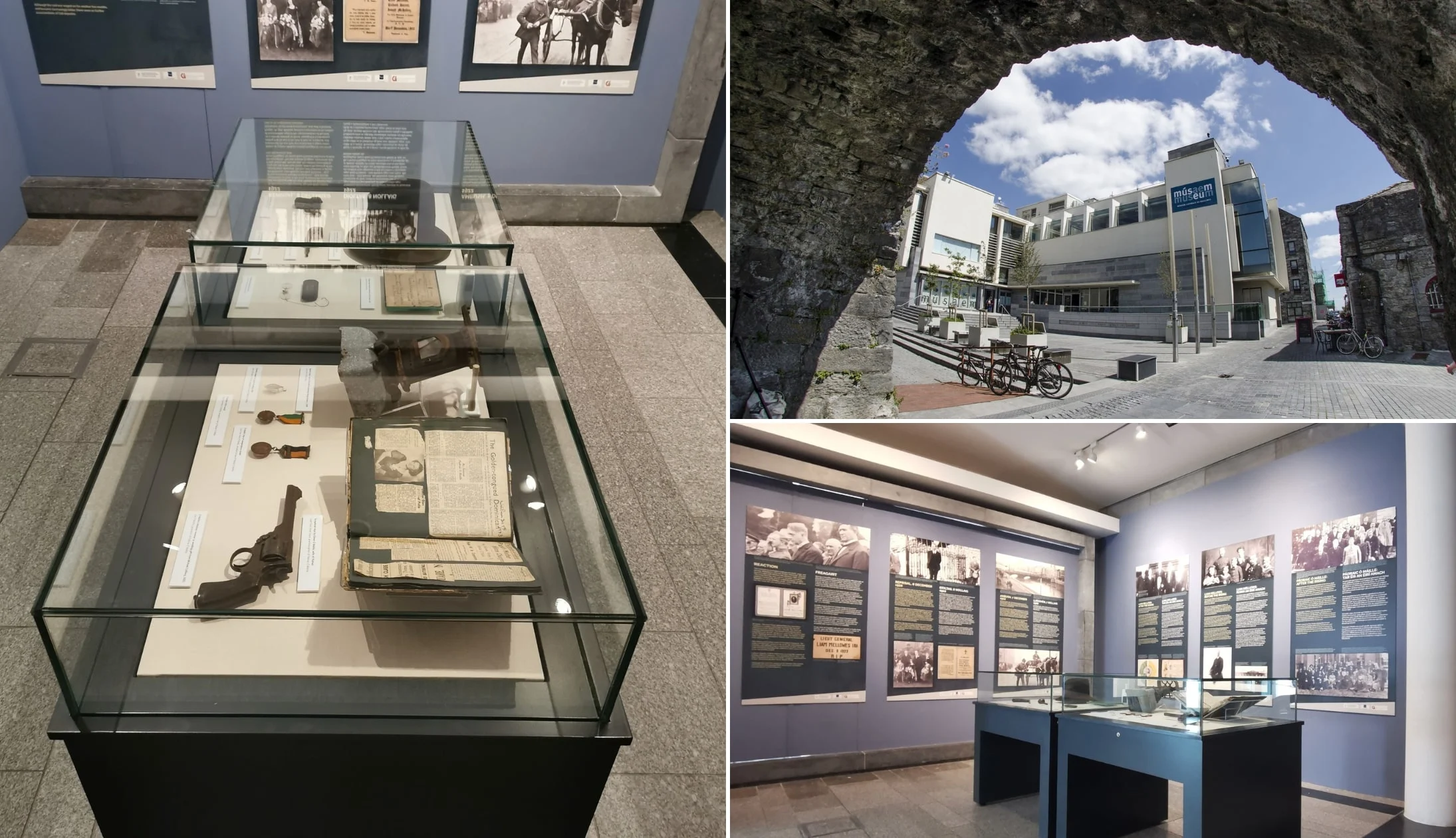
Photos via Galway City Museum on FB
The Galway City Museum is just a stone’s throw from the Spanish Arch. It’s one of the best places to learn about Galway’s history, culture, and archaeology, with collections telling the story of prehistoric Galway all the way through to 19th and 20th-century Galway!
The museum has three floors and seven long-term exhibitions, including The Wild Atlantic – Sea Science, and an exhibition on Pádraic Ó Conaire.
It’s free to visit, although donations are always appreciated.
Stop 8: Spanish Arch and the Long Walk

Photos via Shutterstock
The Spanish Arch is a must-see Galway attraction, dating back to Medieval times. The large stone arch is located on the outskirts of the city centre, overlooking the Claddagh (shore).
It originally housed soldiers who were keeping watch on the city’s Medieval walls. Its nickname is thought to come from the city’s merchant trade with the Spanish, whose ships would often be docked in the area!
From the Spanish Arch, you can take a short stroll alongside the water to what’s known as The Long Walk. You’ll likely have seen pictures of it (it’s a line of colourful buildings right on the water).
Stop 9: Dinner, drinks and live music

Photos courtesy Failte Ireland
Galway is a lively city regardless of the time of year. Here’s some spots worth checking out:
Our dinner recommendations
There’s some excellent restaurants in Galway – our favourites are Ard Bia, The Quay Street Kitchen, and Dela. Ard Bia is absolutely fantastic, but you need to book in advance for dinner.
The restaurant has a quirky interior and serves beautifully presented modern dishes.
The Quay Street Kitchen has a great selection of vegan and vegetarian-friendly dishes, and Dela has modern Irish cuisine on the menu.
Live music and trad bars
There’s some mighty pubs in Galway. After dinner, head out for drinks at either Tigh Neachtain or The Crane. Both are traditional pubs with a great atmosphere.
Trad music is an integral part of the city, with heaps of options to choose from. Our favourite spots are Crane Bar (mentioned above) and Tigh Chóilí.
Day 11: County Clare
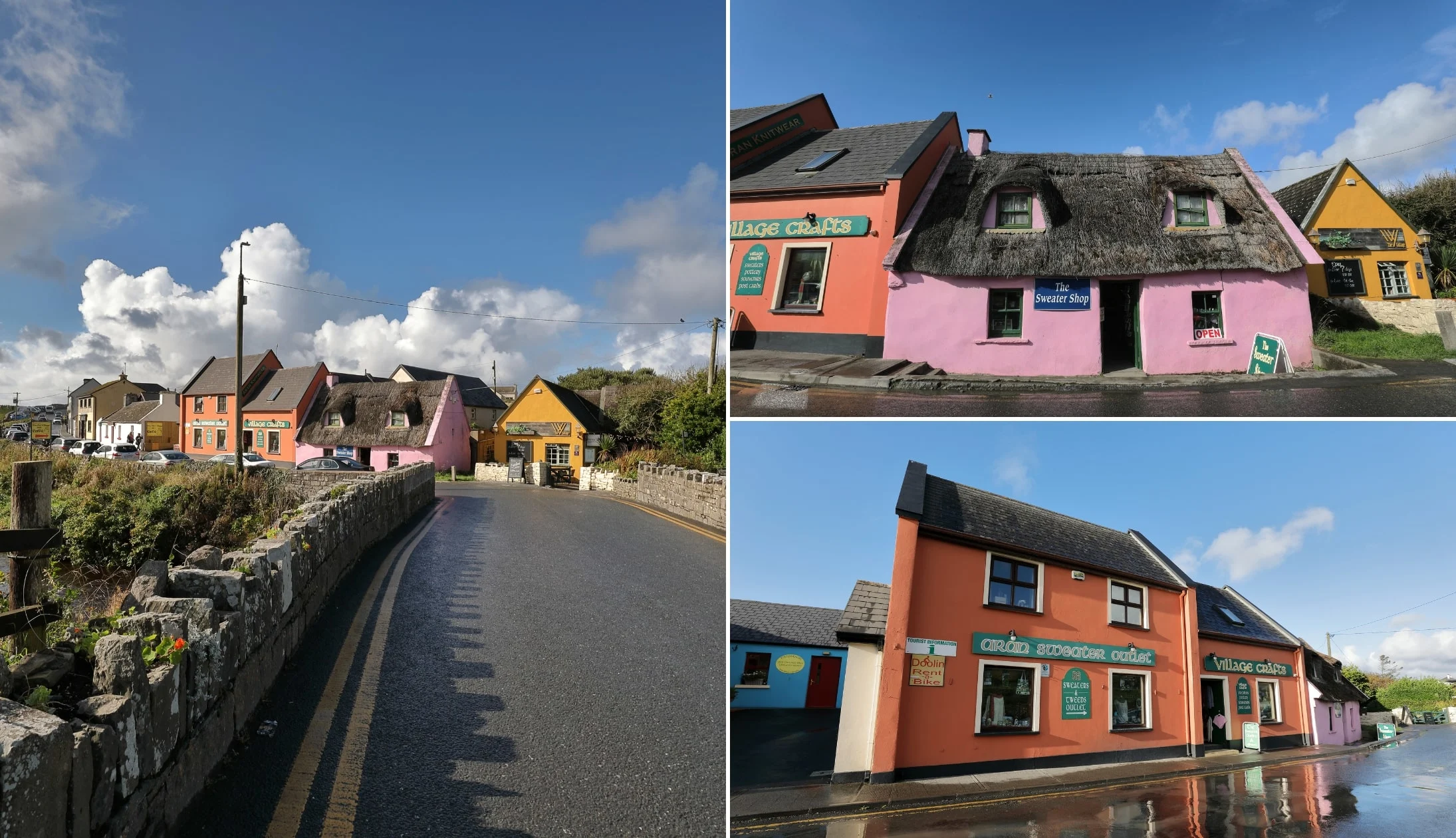
Photos courtesy of Chaosheng Zhang
You’re saying goodbye to Galway today and heading over to Doolin for two nights. The total drive time is less than 2 hours, depending on whether you take the coast road. But we have lots of places for you to stop on the way! Doolin is a lovely village on Ireland’s west coast, known for its trad music.
Doolin accommodation recommendations
- Popular and central stays: West Haven House (short stroll from McDermott’s Pub) and Cullinan’s Guesthouse (great reviews and right across from Fitzpatrick’s Bar)
- Our favourites: Doolin Inn (a stone’s throw from Fisher Street), Fiddle + Bow Hotel (boutique and very central) and Hotel Doolin (good value and nice and central)
Stop 1: Dunguaire Castle
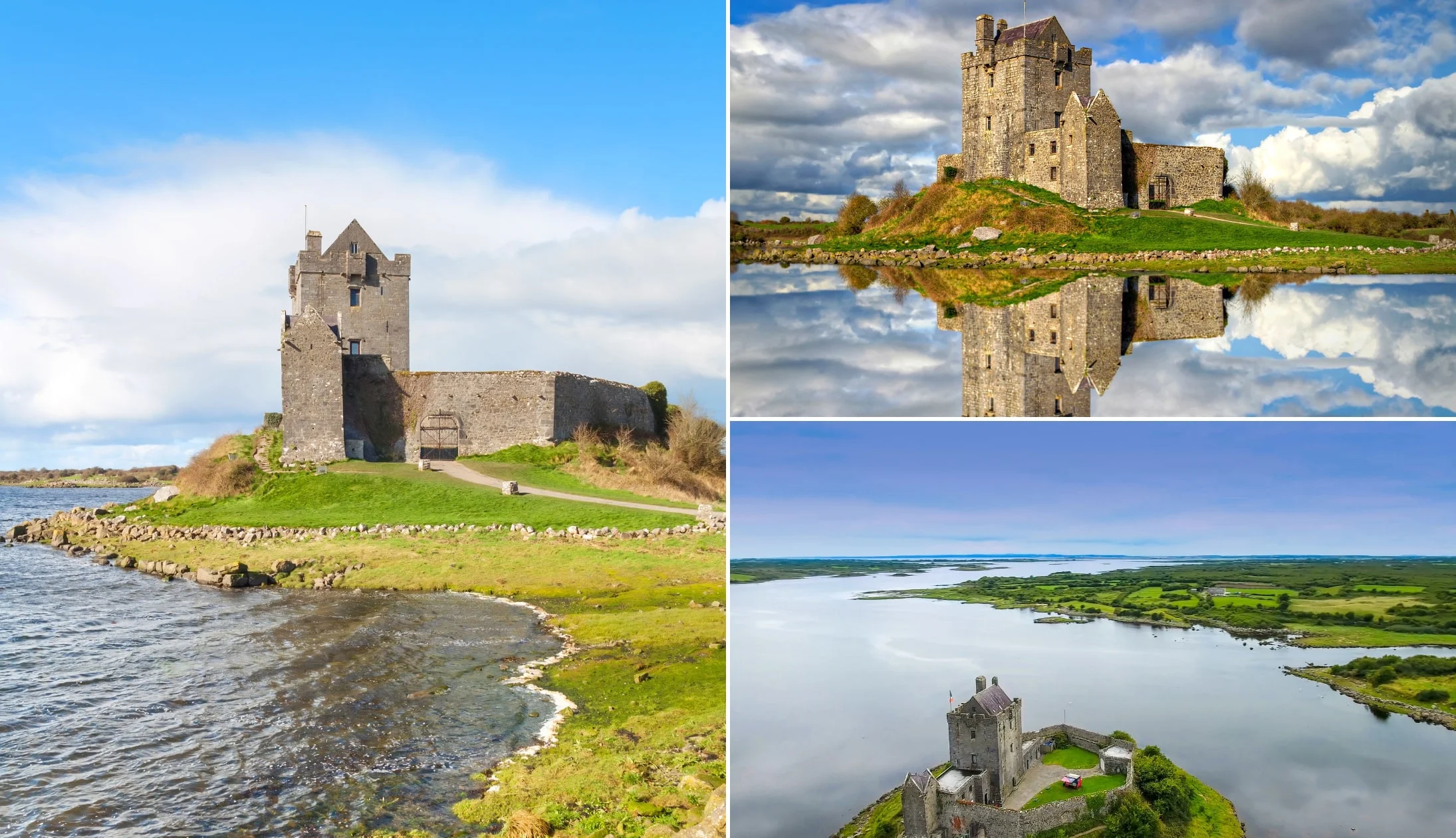
Photos via Shutterstock
Dunguaire Castle is a 35-minute drive from Galway. The castle was built in 1520 and belonged to the O’Hynes clan. In 1912, the castle was bought by writer Oliver St. John Gogarty. During his ownership, he restored the castle and hosted several famous writers, including W.B. Yeats and George Bernard Shaw. The enchanting castle sits on the shores of Galway Bay and has an impressive 75-foot tower. We’d recommend spending at least an hour here, walking the grounds and taking a self-guided tour. According to legend, if you stand at the front gate and ask a question, you’ll have an answer by the end of the day!
Stop 2: Aillwee Cave
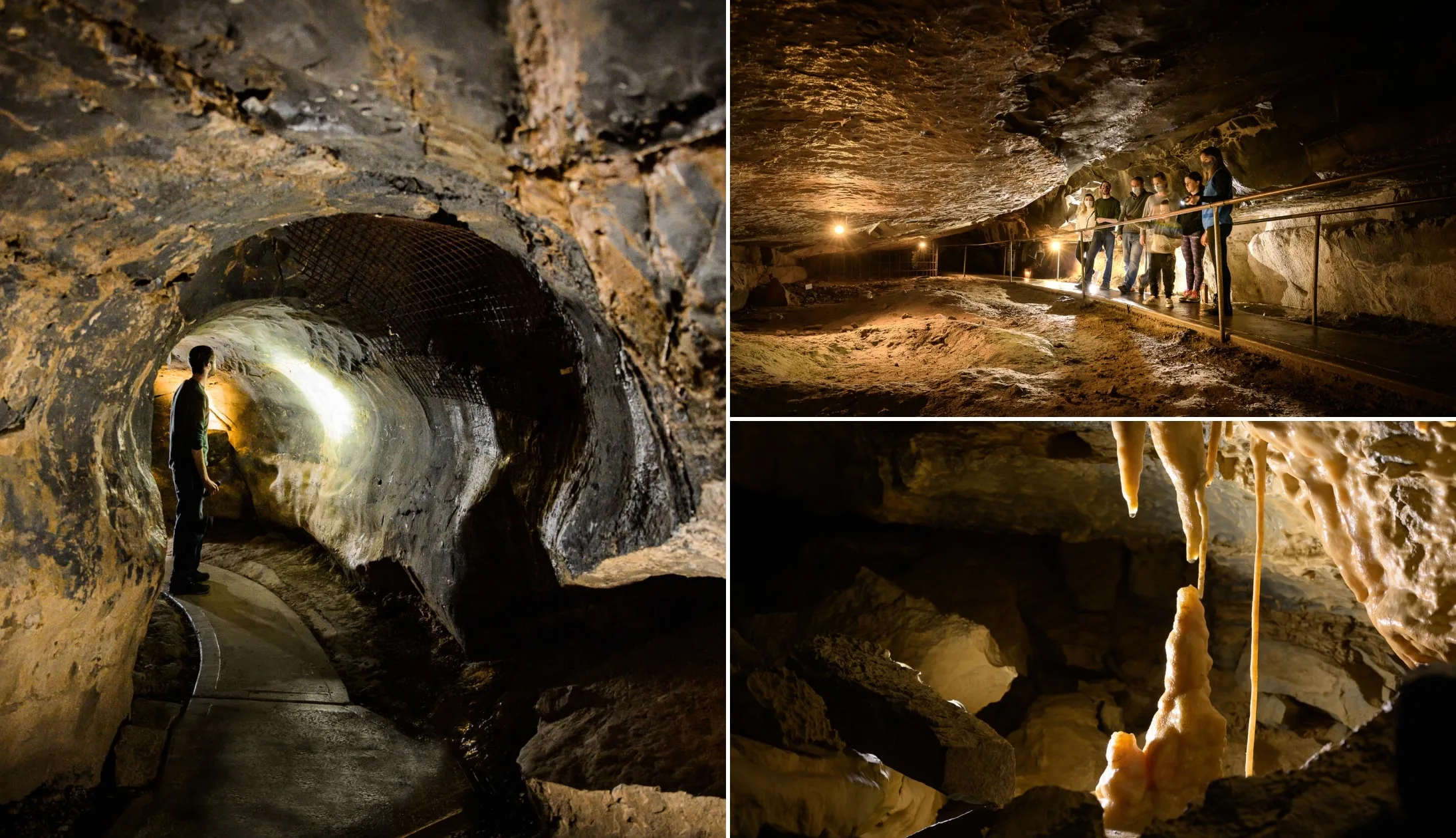
Photos via Aillwee Caves on FB
Your next stop, the Aillwee Cave, is around 27 minutes from Dungaire. The Aillwee Cave is a fascinating underground system full of caverns, rock formations, and even the bones of an ancient bear! The site is close to the Birds of Prey Centre, a unique and educational experience involving some of the world’s top birds of prey.
We’d recommend spending at least one hour at this stop, or even longer if you visit both attractions. The Aillwee Cave tour lasts 45 minutes, passing by an underground waterfall and over bridged ravines. At the Burren Birds of Prey Centre, you’ll be able to see predators like owls, vultures, and hawks and possibly watch a 45-minute flying demonstration.
Stop 3: Ballyvaughan for lunch
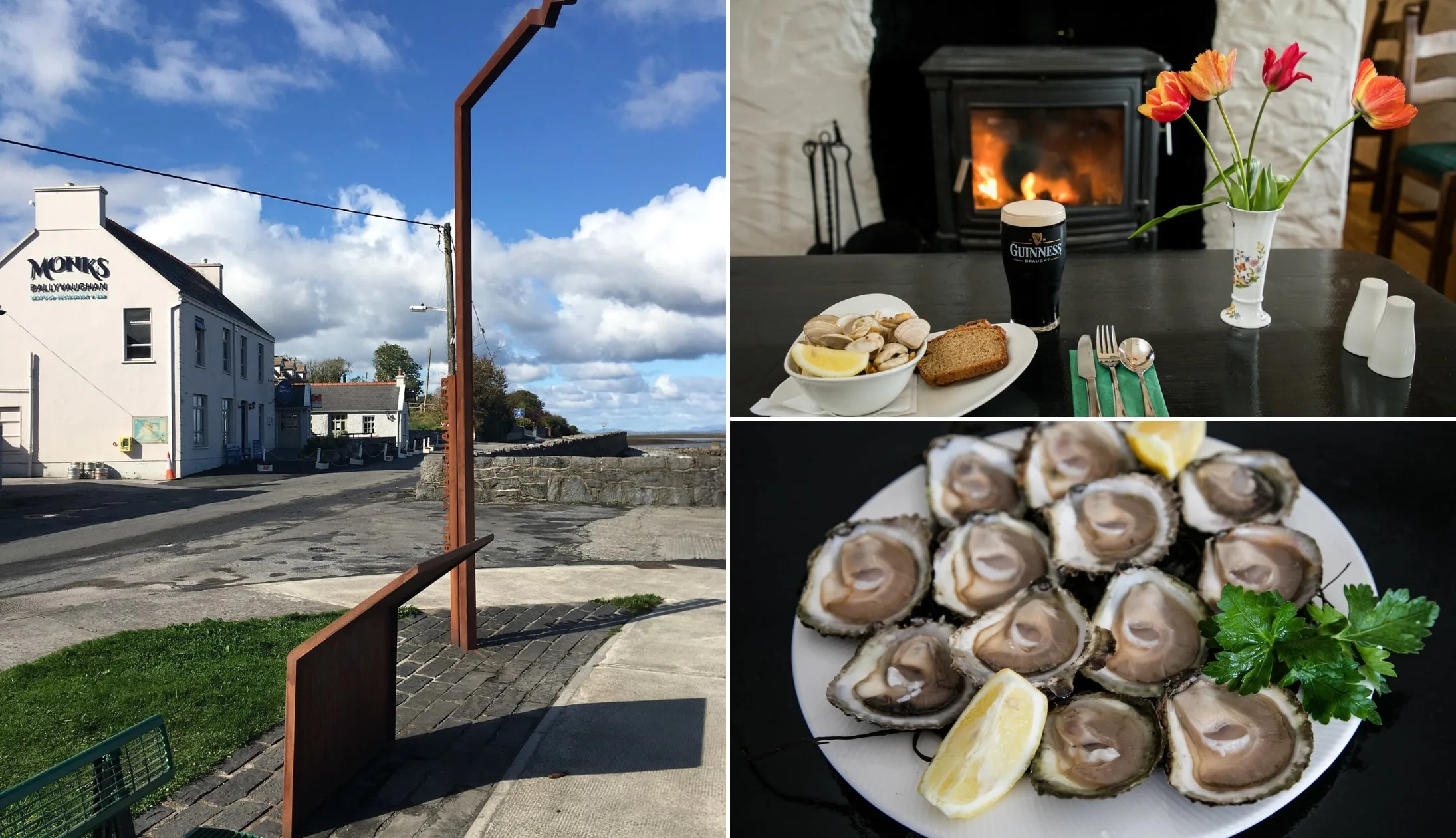
Photos via Monk’s on FB
It’s time to head to the quaint seaside village of Ballyvaughan, only 5 minutes from Aillwee Cave. Our favourite places to eat in the village are Monks (a brilliant seafood restaurant with handpicked Galway Bay oysters), The Wild Atlantic Lodge (a beautiful restaurant with delicious Irish cuisine), or The Larder (a cosy cafe with sandwiches, soup, and quiches). Once you’re done, take the scenic coastal drive to Doolin along the R466.
Stop 4: Doolin

Photos courtesy of Chaosheng Zhang
The coastal drive from Ballyvaughan to Doolin usually takes around 40 minutes, but we would recommend giving yourself a little extra time. There are some amazing views of the Burren along the way and you might want to pull over! Once you arrive at Doolin, check into your hotel and rest/freshen up/etc.
Stop 5: Cliffs of Moher
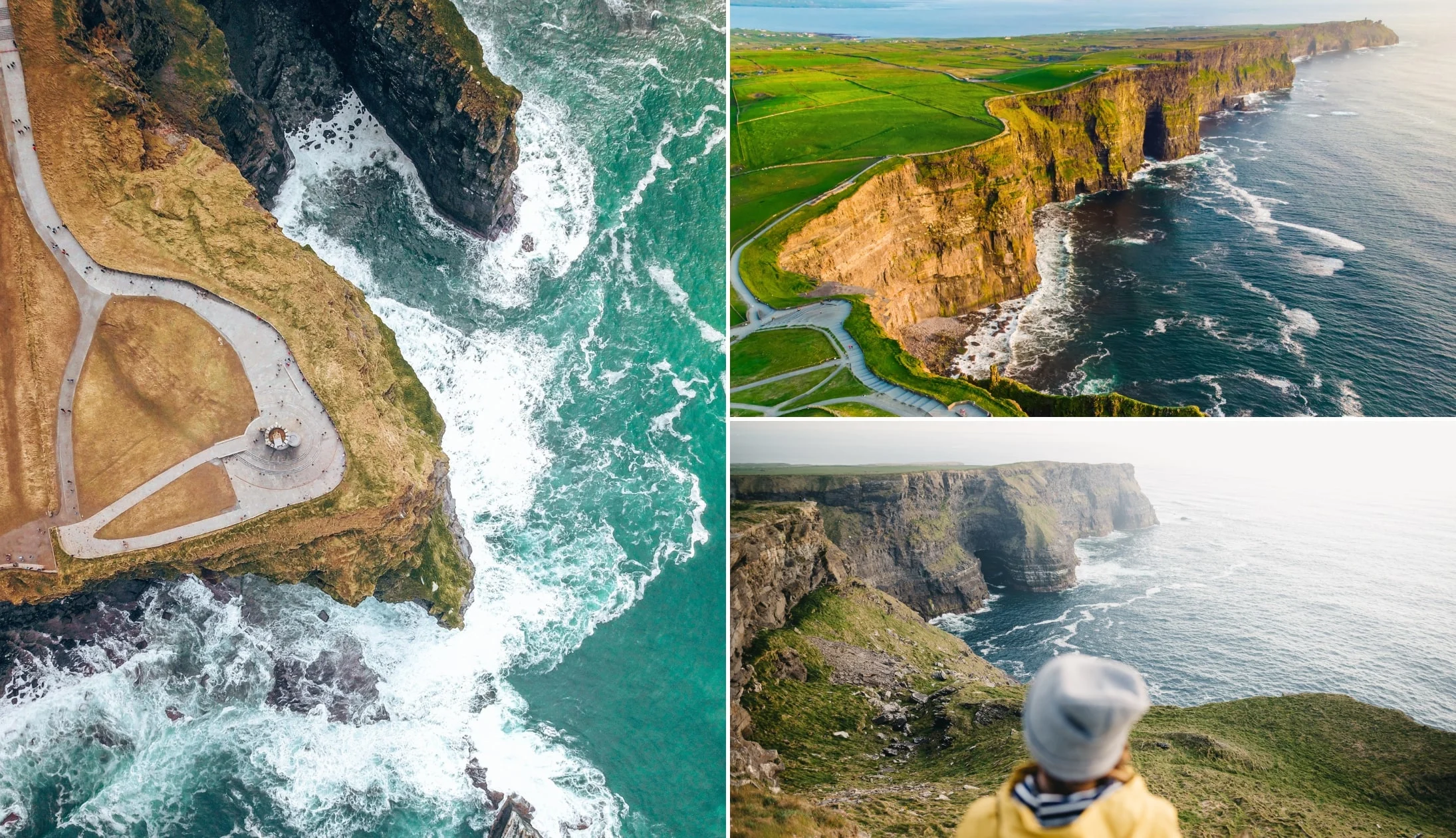
Photos via Shutterstock
Your next stop, the magnificent Cliffs of Moher, are one of the area’s (if not Ireland’s) most popular attractions. The cliffs are a 15-minute drive from Doolin, with breathtaking views of the wild Atlantic, Galway Bay, and the Aran Islands.
There’s a visitor centre on-site, as well as 800 metres of paved walkways with viewing areas and the historic O’Brien’s Tower. In our opinion, the visitor centre isn’t really anything that special, but you’ll get access to all three with the Cliffs of Moher Experience.
Stop 6: Dinner, drinks and live music in Doolin
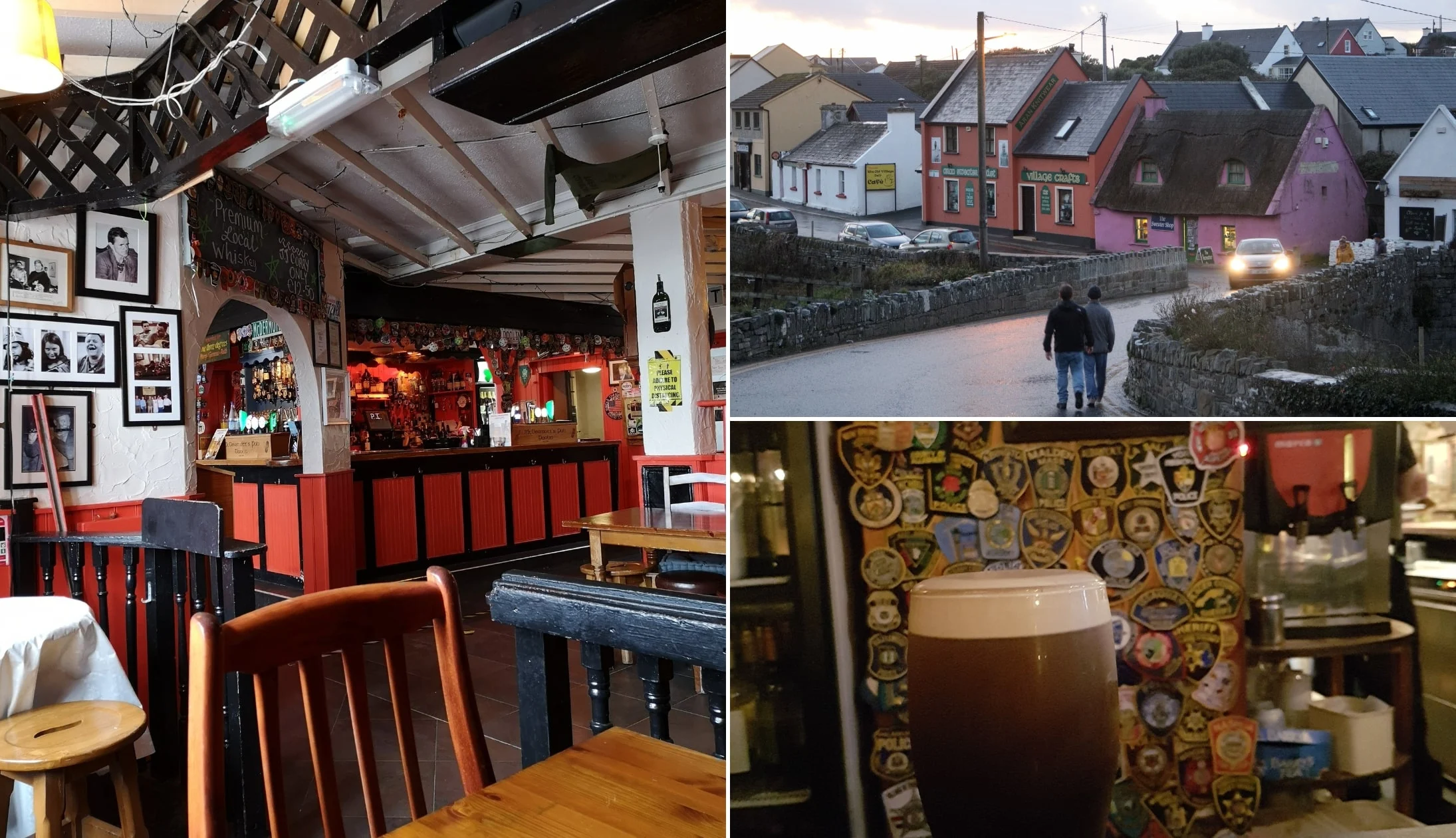
Photos by The Irish Road Trip
Although it’s fairly small, there’s some great restaurants in Doolin and there’s a handful of mighty pubs in Doolin, too.
Our Doolin food recommendations
We have quite a few recommendations for where to eat in Doolin. These are Riverside Bistro (the seafood pasta and lamb shank are delicious), Anthony’s at Doolin (modern Irish and international cuisine with a great selection of cocktails), and Russell’s Seafood Bar at Fiddle + Bow (amazing local seafood from award-winning chef Viv Kelly).
Our Doolin pub recommendations
Doolin is packed full of traditional Irish pubs which are great for a pint (or a hearty pub meal if the restaurants above aren’t to your liking). Our favourites are McDermot, McGanns, Fitz’s, and Gus O’Connors. The pubs above are also a good place to catch some live music, as well as Anthony’s at Doolin.
Day 12: The Aran Islands
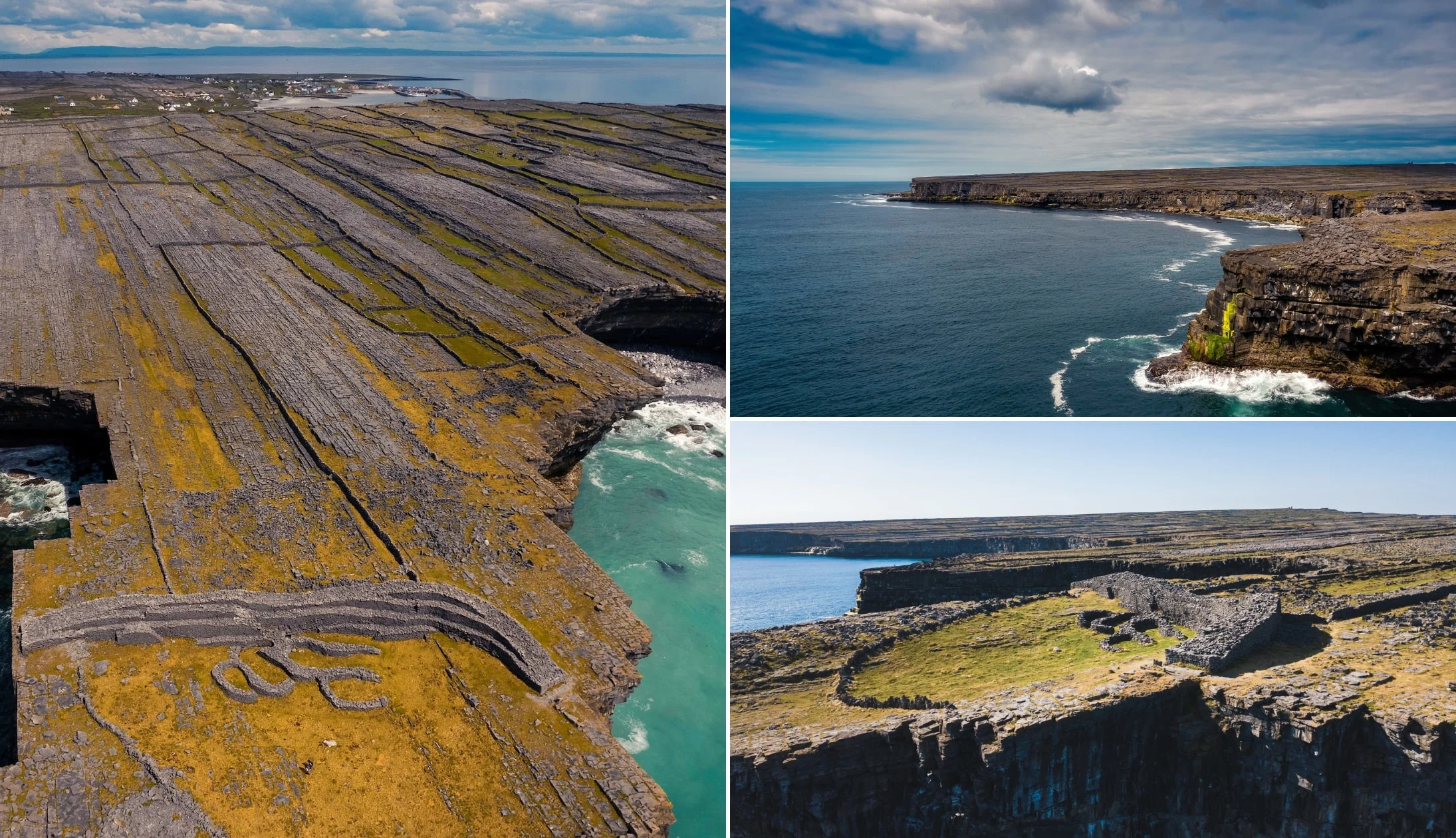
Photos via Shutterstock
Today is a big one, as you’ll be heading off to explore Inis Mor, a beautiful island off the west coast of Ireland and a part of the Aran Islands, a chain of limestone islands rich in history. Inis Mor is the largest of the Aran Islands at 31 km², with a population of around 800 people. Inis Mor’s residents are within the Irish-speaking Gaeltacht, and you’ll notice there’s a strong sense of Irish culture. The landscapes are incredible, with miles of stone walls and rugged coastline.
It’s going to be an adventure-filled day packed with walking and cycling, so make sure to wear appropriate clothes and pack for all types of weather! Grab a hearty breakfast where you’re staying, or check out the Doolin Cafe or Gus O’Connor’s Pub.
Stop 1: Doolin Pier
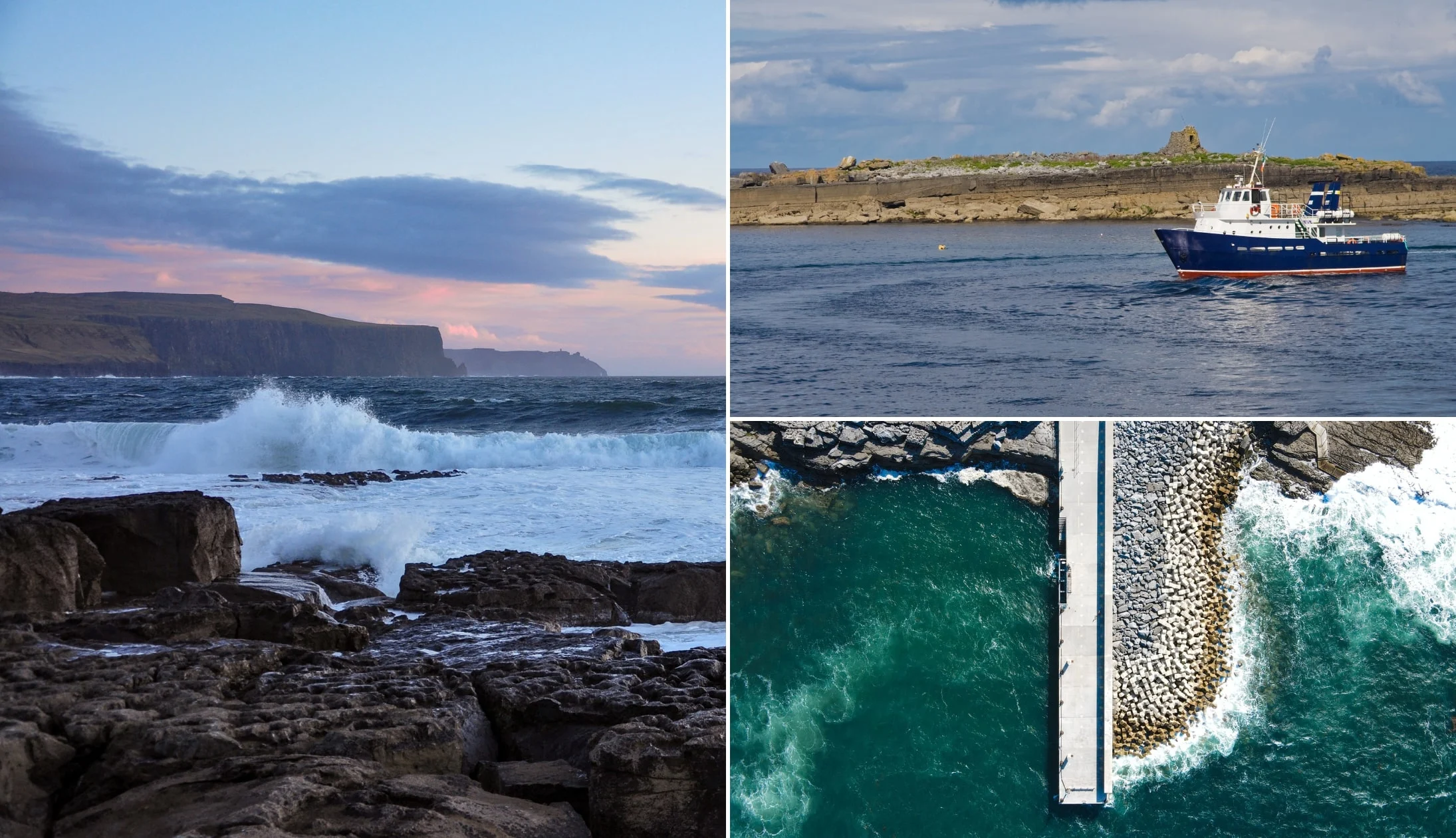
Photos via Shutterstock
There are two ferry services running to Inis Mor: the Doolin Ferry Co. and Doolin2Aran Ferries. We’ve used them both and are happy to recommend either! The journey is generally 35 minutes long (via express boat), although the 1pm Doolin Ferry Co. service makes a stop at Inis Orr first, so it will take longer. There are daily sailings departing Doolin (more info here).
Stop 2: Inis Mor
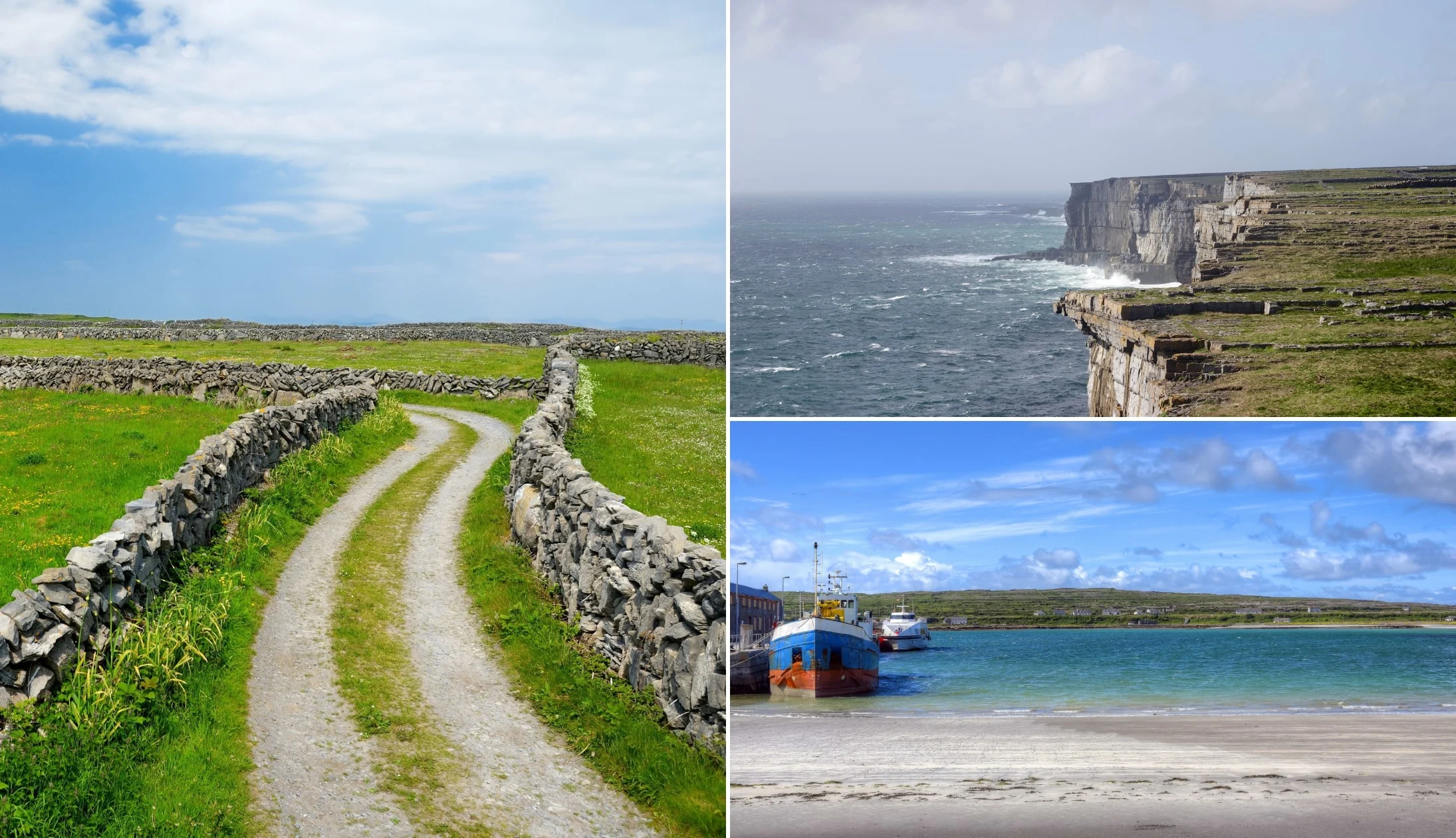
Photos via Shutterstock
Today, you’re going to be exploring glorious Inis Mor, the largest of the Aran Islands. The island is 31 km² and has a population of around 800 people. Inis Mor’s residents are within the Irish-speaking Gaeltacht, and you’ll notice there’s a strong sense of Irish culture. The landscapes are incredible, with miles of stone walls and rugged coastline.
Stop 3: Grab a bus or bike and head to see the seals
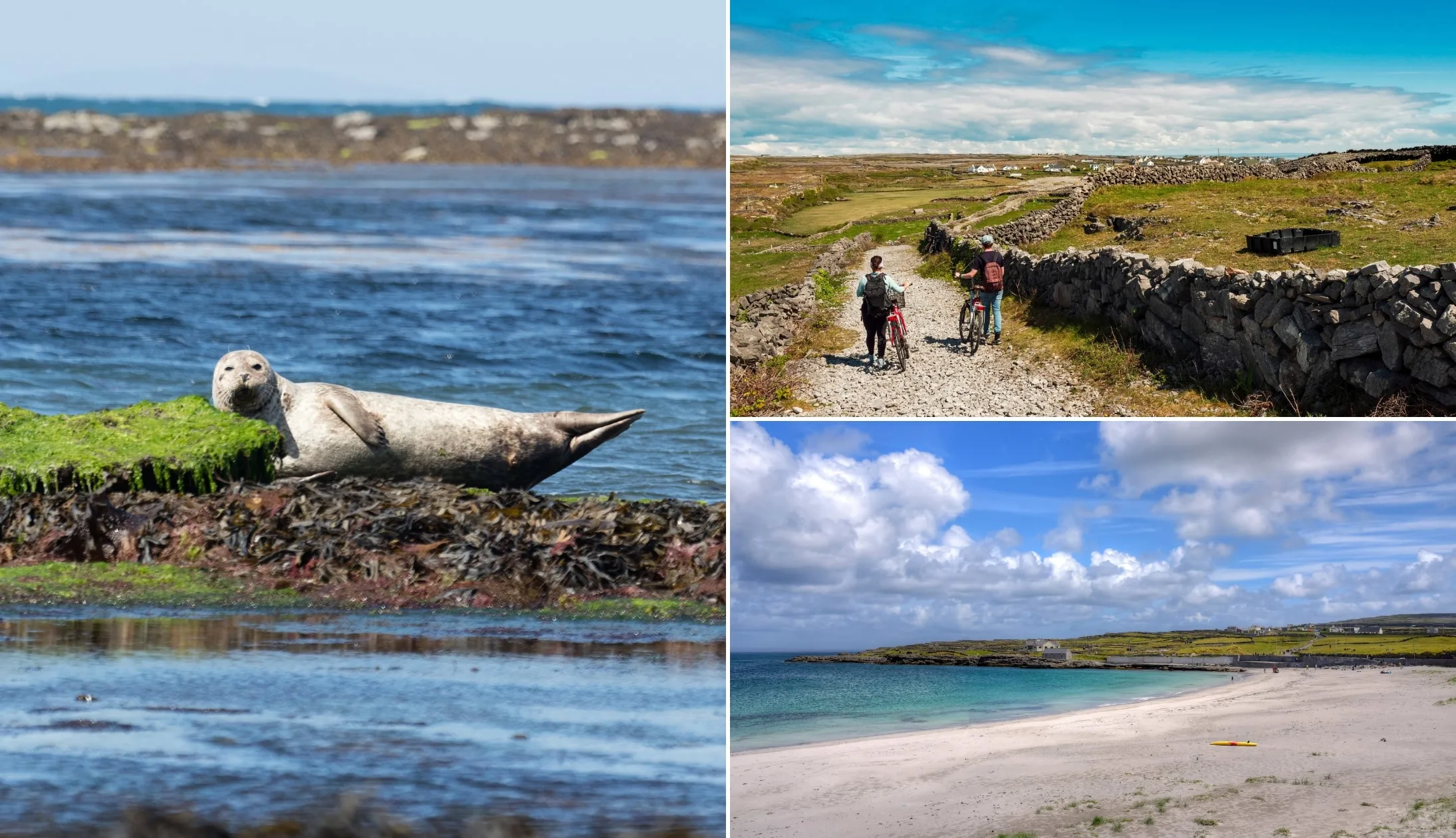
Photos via Shutterstock
We recommend either renting a bike (preferably an eBike), or if you don’t feel like being too active today, hopping on a mini-bus tour when you arrive on the island. It’s important to note that you’ll only have four hours on Inis Mor, so if you feel like taking it a bit easy, hopping on a mini-bus is the best option.
Once you arrive on the island, there are several bike hire companies within walking distance of the pier: Aran Bike Hire, Inis Mor Bike Hire, and eBike Self-Guided Tours. From the pier, it’s 4.1km to the Seal Colony Viewing Point (around 15 minutes cycling). The island is home to a population of Atlantic Seals who live close to Kilmurvey Beach. The viewpoint is easy to find, and during low tide, you can spot as many as a dozen seals sunbathing on the beach and rocks.
Stop 4: Dún Aonghasa
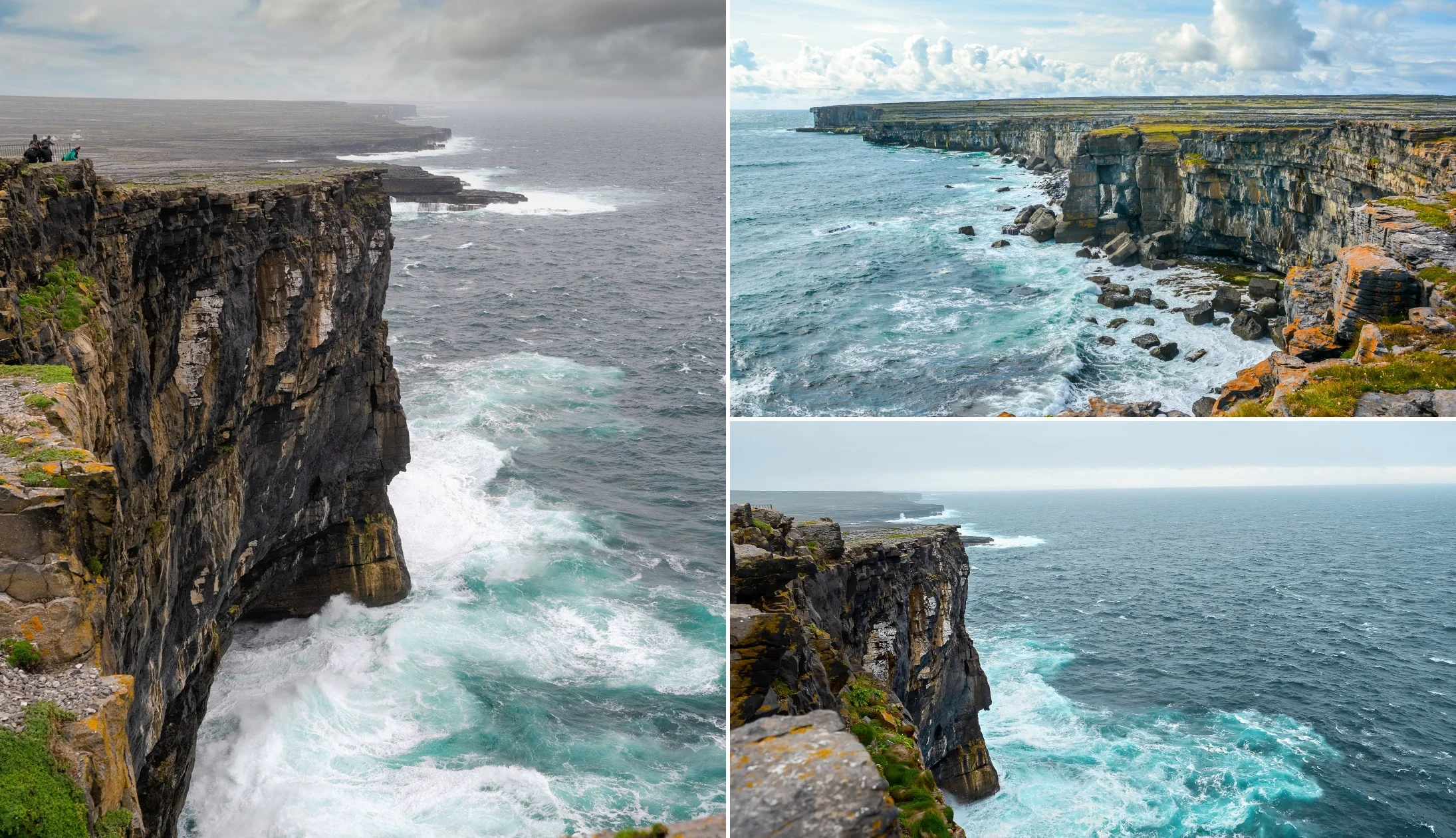
Photos via Shutterstock
Dún Aonghasa is a prehistoric hill fort sitting on the edge of an 87-metre cliff. It’s not clear exactly how old the fort is, but parts of the fort date back to the Bronze Age and Iron Age. It’s the biggest fort on the Aran Islands with three impressive drystone defence walls. If you’re cycling, you’ll need to park your bike at the ‘bike parking’ area (here on Google Maps), then walk the final 1km on foot. There’s an incline approaching the fort and the last section is on rocky ground, so good shoes are a must. There’s no barrier at the edge of the cliff, so make sure to take extra care and don’t go near to the edge. If you have low levels of mobility, the walk out here might be too much of a challenge. If that’s the case, you’ll find the lovely Teach Nan Phaidi close by where you can grab a coffee and a bite-to-eat, if you like.
Stop 5: The Worm Hole
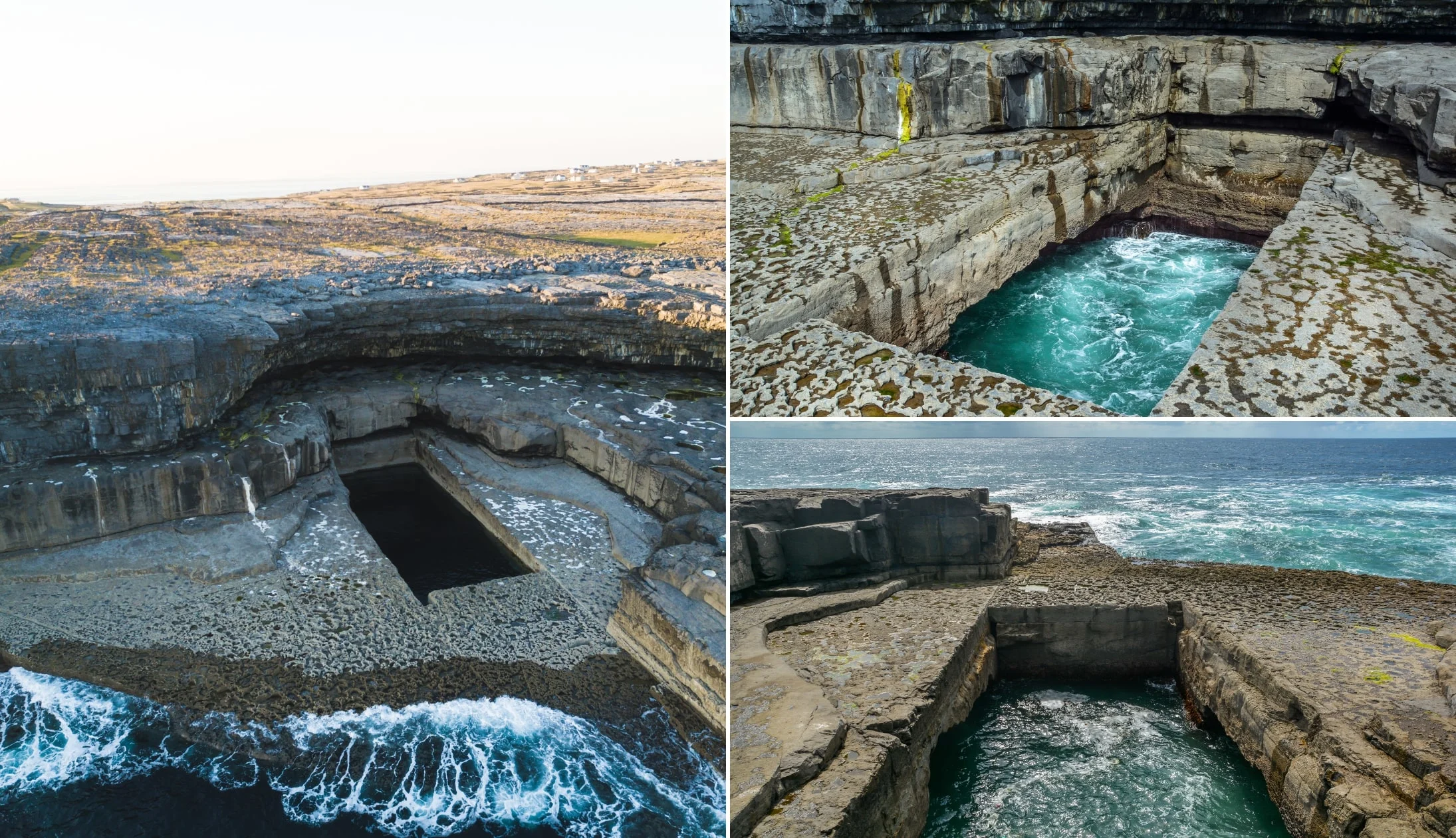
Photos via Shutterstock
Also known as the Serpent’s Lair or ‘Poll na bPeist’, the Worm Hole is a one-of-a-kind natural tidal pool! What makes it so unique? Well, its rectangular shape is 100% natural. It was featured in the 2017 Red Bull Cliff Diving Series and although it’s a little hard to find, it’s well worth the extra effort.
From Dún Aonghasa, the best way to visit The Worm Hole is to (carefully) make your way east along the cliffs (stay well away from the edge). It’s roughly 1.6km with painted rocks marking the way. Even though it may be tempting to go for a swim, we highly advise against it as there’s no easy way to get out of the pool if you get into trouble. The tidal pool also contains underwater currents, and depending on the tide and weather, waves can crash over the top.
Stop 6: The Black Fort

Photos via Shutterstock
Dún Dúchathair, or the Black Fort, is an ancient fort 2.7km (roughly 8 minutes cycling) from Kilronan. The fort is near a cliff edge and it’s thought that it gets its nickname thanks to the cliff’s dark limestone which is characteristic of the area. The site has terraced stone walls that surround the Clocháns (stone dwellings). Similarly to Dún Aonghasa, it’s not clear just how old the Black Fort is, but it’s believed to be built around the same time.
The way is clearly signposted and easy to find, but before you reach the fort, the paved road ends and the terrain becomes rockier. Most people choose to leave their bikes at the side of the road and proceed on foot. There’s no barrier or fence at the cliff edge, so once again, take extra care close to the cliffs.
Stop 7: Lunch
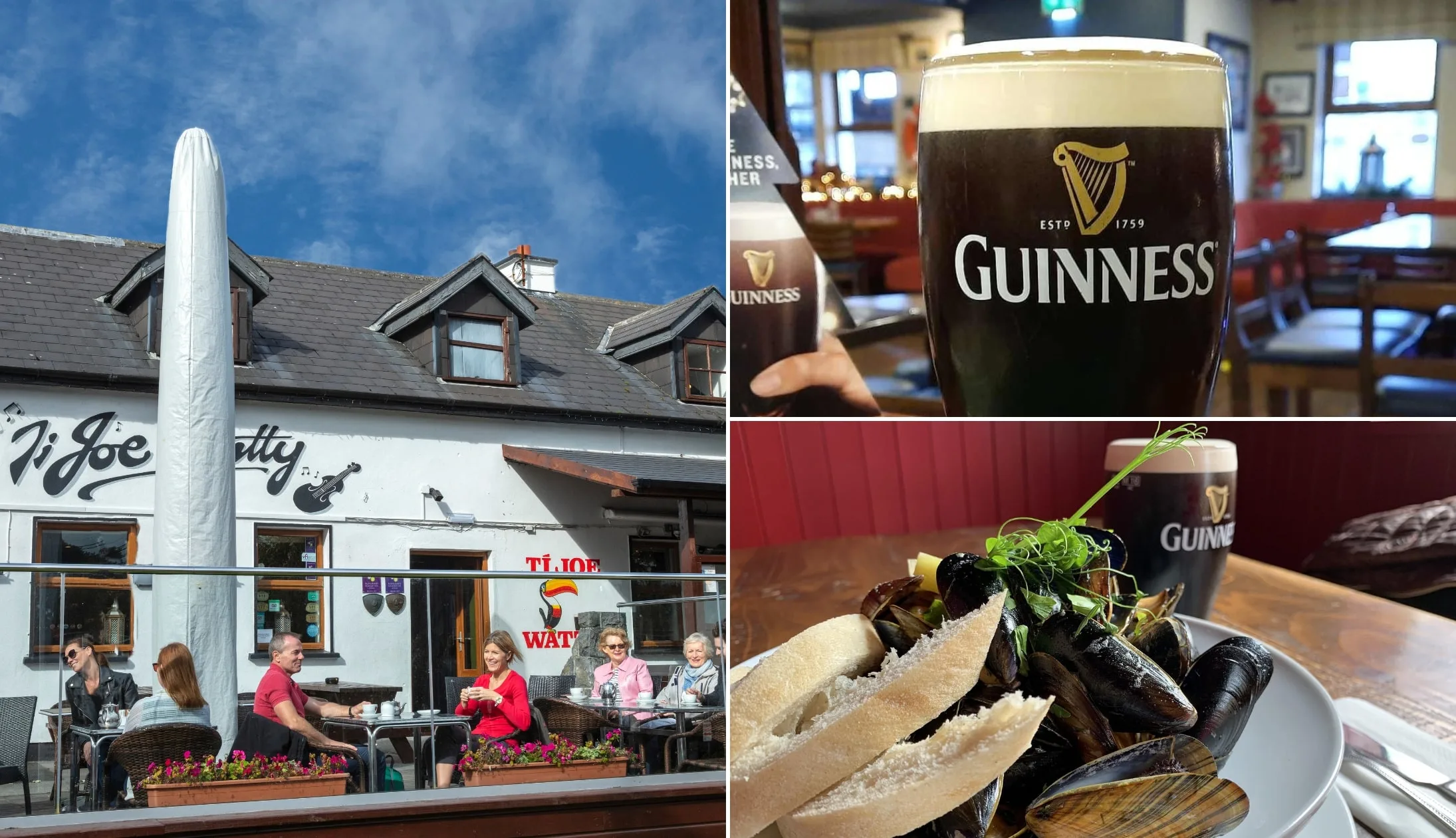
Photo left: Gareth McCormack via Failte Ireland. Others: Via Joe Watty’s
After the trek back to your bike, you must be hungry. For a small island, there are plenty of places to eat and some of our top picks are Joe Watty’s Bar, Bayview Restaurant, and Madigan’s Bar & Restaurant at the Aran Islands Hotel.
Both Joe Watty’s Bar and Bayview Restaurant are a good pick for families, with hearty Irish dishes, delicious seafood, and a children’s menu. Madigan’s Bar & Restaurant has a seasonal menu with light bites and a lovely outdoor seating area overlooking the water.
Stop 8: The Cliffs of Moher from below
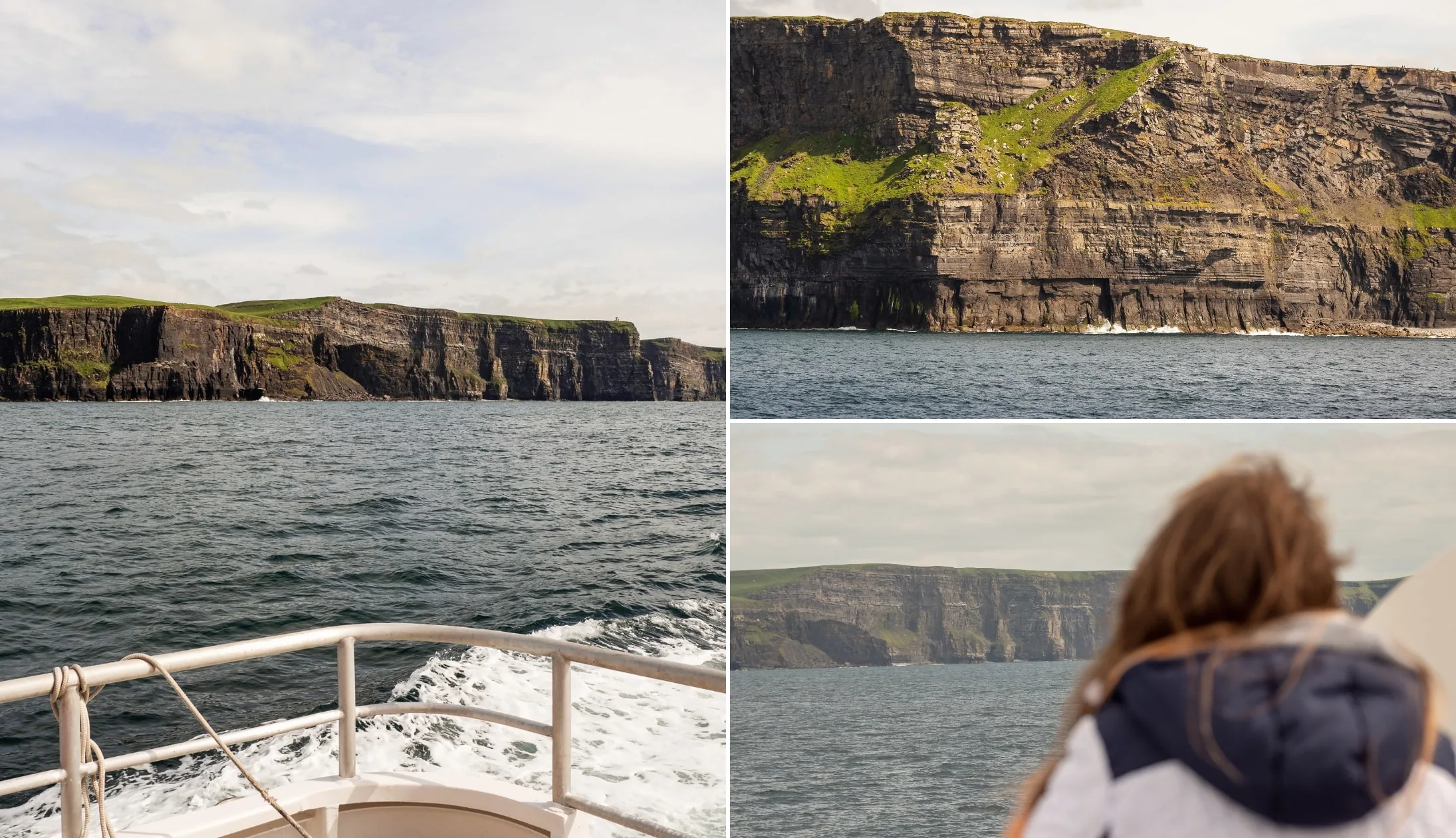
Photos via Shutterstock
During the Cliffs of Moher Cruise, you’ll get the chance to view the cliffs from a completely different angle! Whilst sitting on the boat looking up at the magnificent cliffs is awe-inspiring, our favourite part of the cruise is passing by the enchanting sea cave which was one of several Harry Potter filming locations in Ireland.
You’ll also get the chance to see Ireland’s largest seabird colony at the An Branán Mór sea stack, and if you’re lucky, you may even spot a dolphin, seal, or basking shark in the water!
Stop 9: Back to Doolin for the night

Photos by The Irish Road Trip
Below is a reminder of our recommendations for dinner, drinks and music in Doolin.
Our Doolin food recommendations
We have quite a few recommendations for where to eat in Doolin. These are Riverside Bistro (the seafood pasta and lamb shank are delicious), Anthony’s at Doolin (modern Irish and international cuisine with a great selection of cocktails), and Russell’s Seafood Bar at Fiddle + Bow (amazing local seafood from award-winning chef Viv Kelly).
Our Doolin pub recommendations
Doolin is packed full of traditional Irish pubs which are great for a pint (or a hearty pub meal if the restaurants above aren’t to your liking). Our favourites are McDermot, McGanns, Fitz’s, and Gus O’Connors. The pubs above are also a good place to catch some live music, as well as Anthony’s at Doolin.
Day 13: The Trip to Dublin
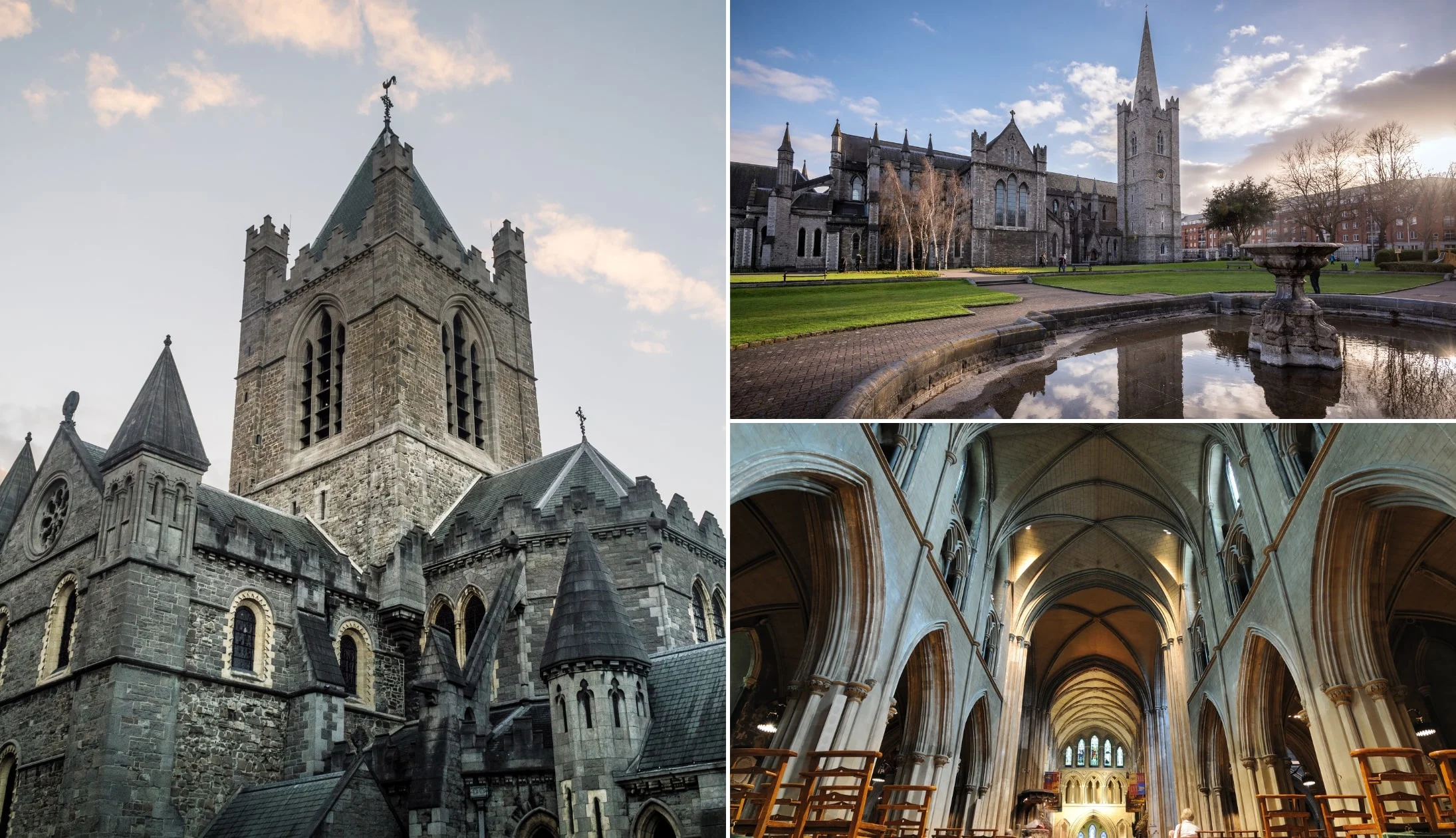
Photos via Shutterstock
Next stop, Dublin City! We’ll be driving straight to the city from Doolin in order to spend the rest of the day exploring Ireland’s vibrant capital city on foot.
Grab breakfast at your accommodation or nearby. When you’re ready, it’s time to hit the road!
You’ll be spending three nights in Dublin – make sure to book your accommodation in advance.
Recommended accommodation in Dublin
- Budget: Abigail’s Hostel (Temple Bar), Jacobs Inn (central hostel) and the Generator Hostel (short walk from the city)
- Mid-range: Dublin Skylon Hotel (just outside the city), Wren Urban Nest (Temple Bar) and the Harding Hotel (very central)
- Luxury: The Merrion (St. Stephen’s Green – very central) and The Westin (just off Grafton Street)
Getting around Dublin + money savers
- Time savers: If you want to avoid walking where possible, it’s worth getting a ticket for the Hop On Hop Off Bus around Dublin. It goes to or near all of the main sites on this itinerary plus plenty more.
- Money saver: If you’re visiting the ‘main’ Dublin attractions, the Dublin Pass can save you €€€ (here’s how)
Stop 1: Dublin City
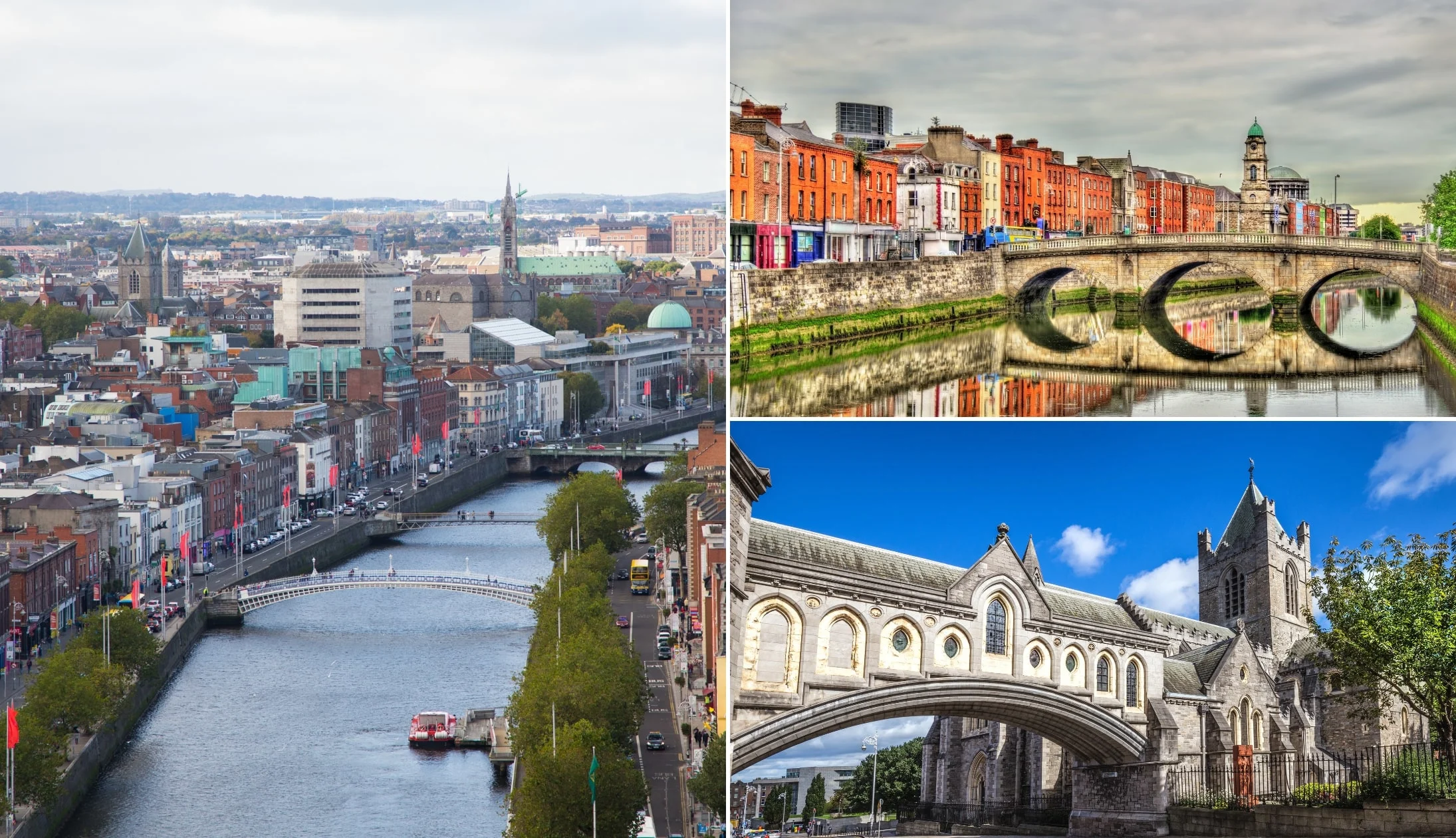
Photos via Shutterstock
We’ll be starting the day with a fairly long, 3-hour drive straight from Doolin to Dublin. The road mostly takes us along the M6 motorway. The section between junction 16 and 15 is a toll road, which costs €2 for cars or €1 for motorcycles. You can pay cash or by card at the toll gate but you can check with your rental car provider to see if your rental agreement covers the payment of toll charges.
If you fancy a coffee halfway through, you could drop into the beautiful town of Athlone to stretch your legs and grab a cup. It’s a beautiful little town on the River Shannon and there are tons of cafes there. We like to park up at the Strand Car Park on the riverfront, then drop into Shannon Crafts & Coffee Dock for a cup of tea or coffee and a nice slice of cake by the river.
Once you arrive in Dublin, head to your accommodation to check in and park up, as we’ll be on foot for the rest of the day.
Stop 2: Park up and then head to Trinity College
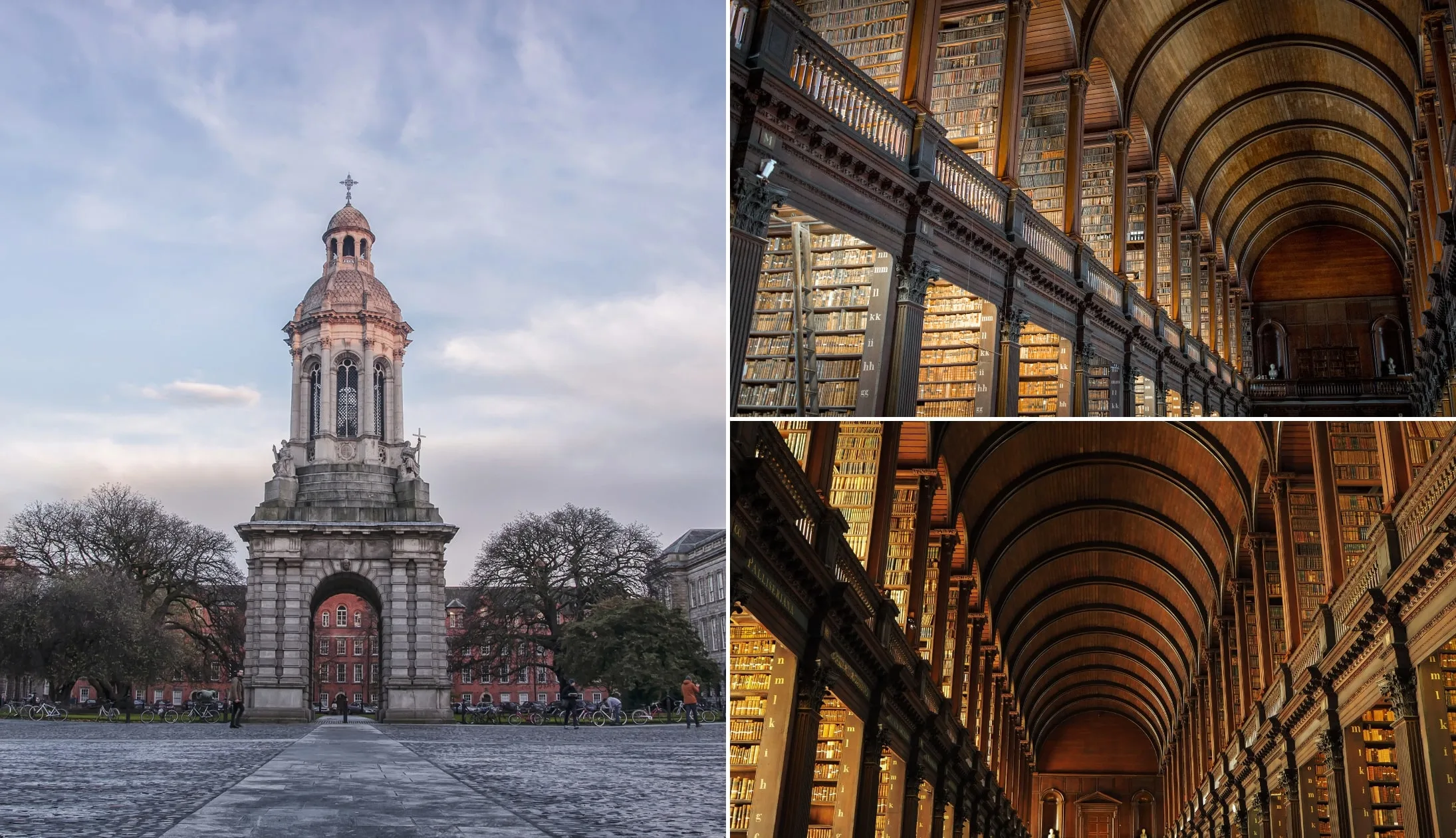
Photos via Shutterstock
Head straight to wherever you’re staying. Check-in and leave the car behind you. The city is very walkable.
When you get to the city, head straight for Trinity College to see the Book of Kells, arguably the most famous cultural attraction in Dublin.
If you can, we highly recommend pre-booking your tickets online, as the queues can get really long (bordering on ridiculous!). This fast-track ticket allows you to dodge the queue and gets you into Dublin Castle, too!
Spend around one hour seeing the Book of Kells, walking around the exhibit, and taking in the beauty of the Old Library. After that, give yourself another 20 minutes or so to walk around the university campus.
Stop 3: Lunch
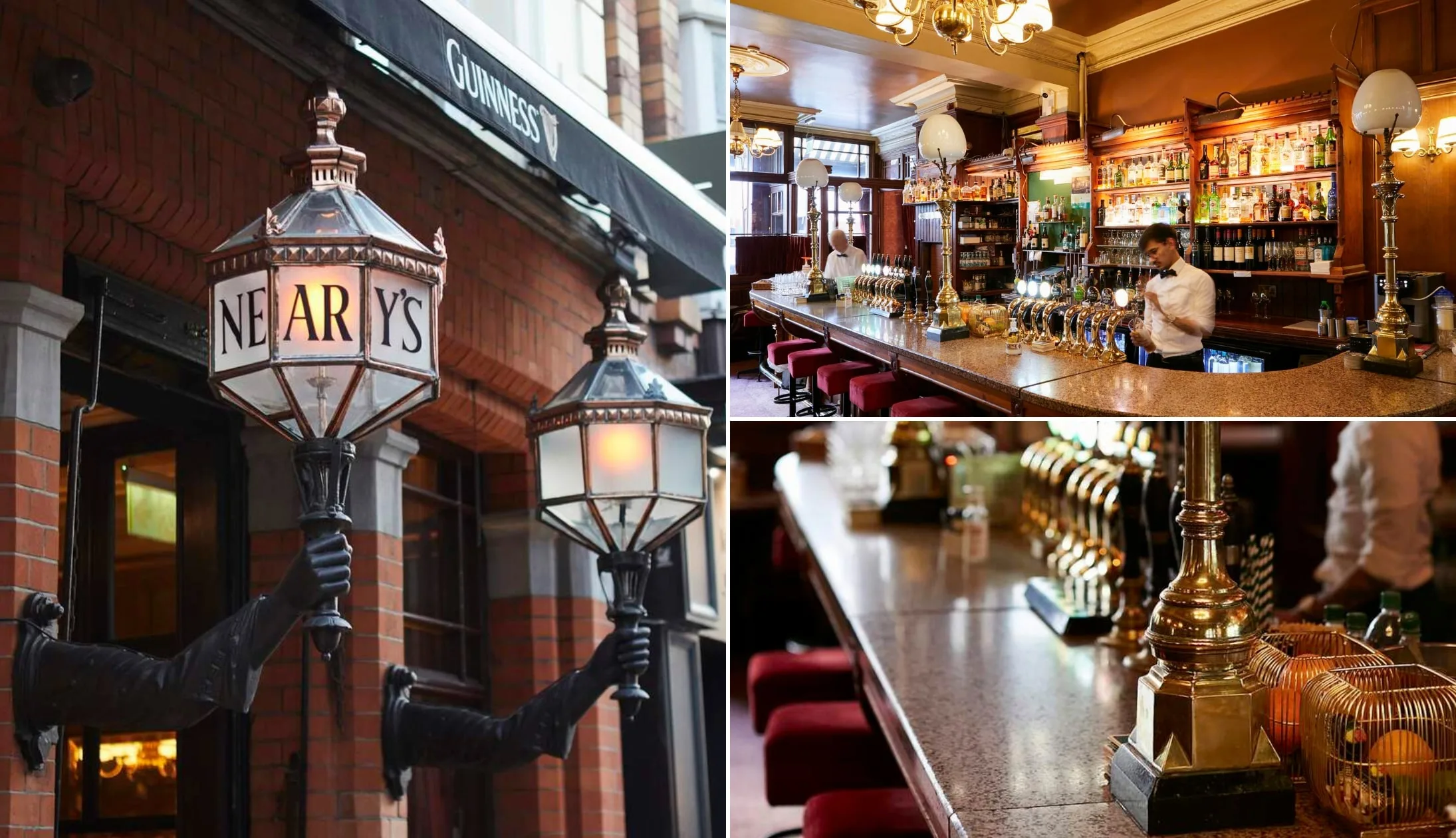
Photos © Tourism Ireland
There’s plenty of great restaurants in Dublin, but for lunch we suggest you head to Neary’s. It’s just up the road from Trinity College, along the bustling Grafton Street.
This old-school pub is a classic and it serves up a range of simple lunch options, like sandwiches, soup, toasties, and Carlingford Oysters, all washed down with a tasty pint of Guinness.
Affordable and delicious, we can’t recommend it highly enough. Sprout and Co on Dawson Street is another good shout for a quick, light lunch that tastes great and is close to Trinity College.
Stop 4: The Ha’penny Bridge (via Temple Bar)
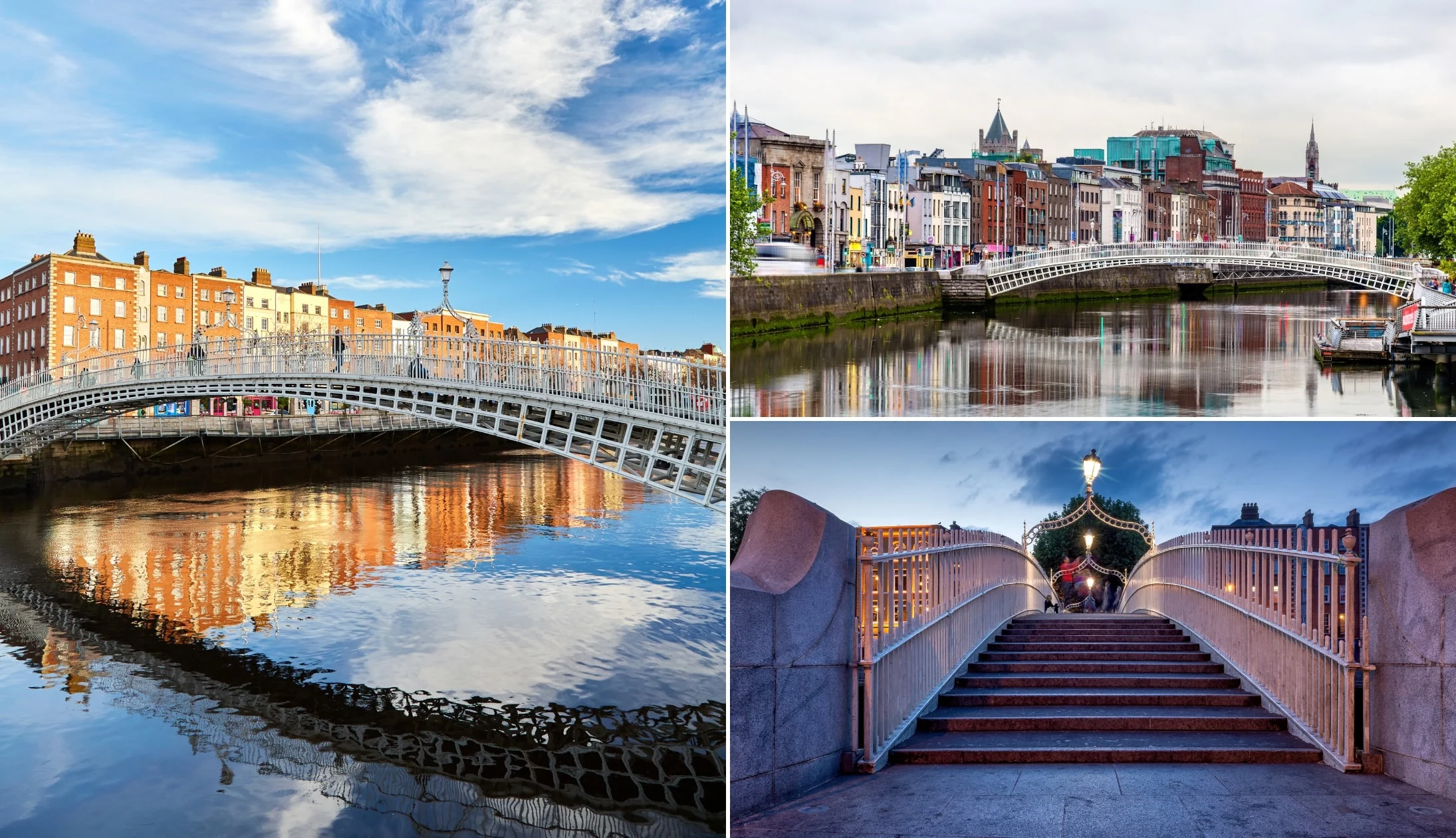
Photos via Shutterstock
The Ha’penny Bridge (officially named the Liffey Bridge) dates back to 1816 and was the first pedestrian bridge over the River Liffey!
It’s a seven-minute walk from the Trinity Gates, but feel free to take your time as you make your way through the lively streets of Temple Bar.
Now, Temple Bar can be a bit of a tourist trap. If you fancy a pint, here are several pubs in Temple Bar worth trying (the Palace is our go-to).
If you feel like an afternoon coffee, there are some great cafes in the Temple Bar area or on the other side of the river. Joe’s Coffee and Vice Coffee are two of our favourites across the water. They’re both just a short stroll from the north side of the Ha’penny Bridge.
Stop 5: Dublin Castle
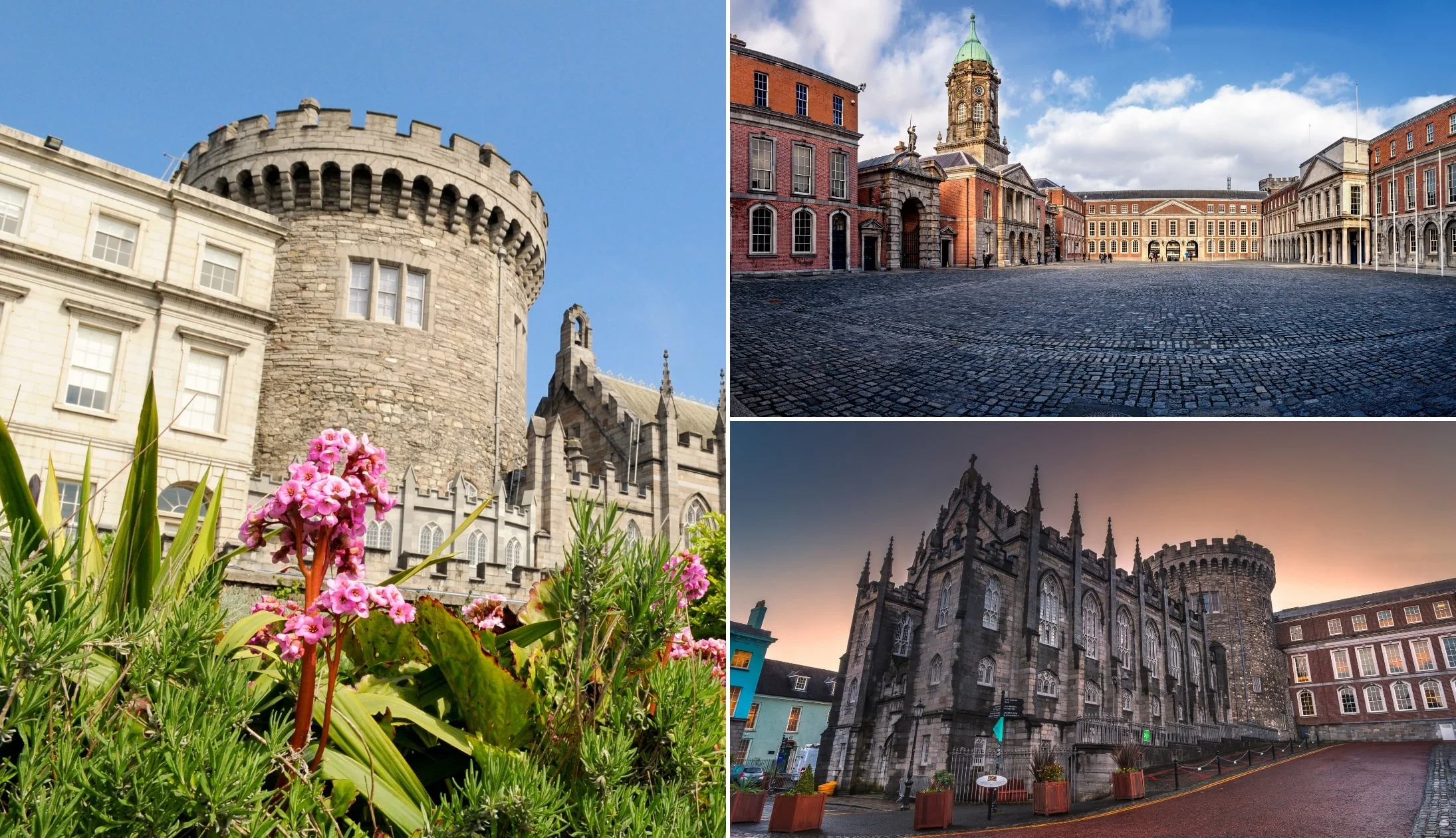
Photos via Shutterstock
Next on the itinerary is Dublin Castle. Nestled in the city centre, the castle dates back to the 13th century and was the seat of the English for over 700 years.
Today, it’s an important government complex and the site of Presidential Inaugurations and key State events.
The castle is around 10 minutes from the Ha’penny Bridge on foot. There’s no admission fee to explore the grounds, but if you want to have a look inside, you’ll need to purchase tickets for either a self-guided tour or a guided tour.
Guided tours include access to the State Apartments, Exhibitions, Chapel Royal, and the Mediaeval Undercroft. Self-guided tours include access to the State Apartments and Exhibitions only.
Tickets for guided tours can be purchased on the day of your visit at the ticket booth.
Stop 6: Christ Church Cathedral
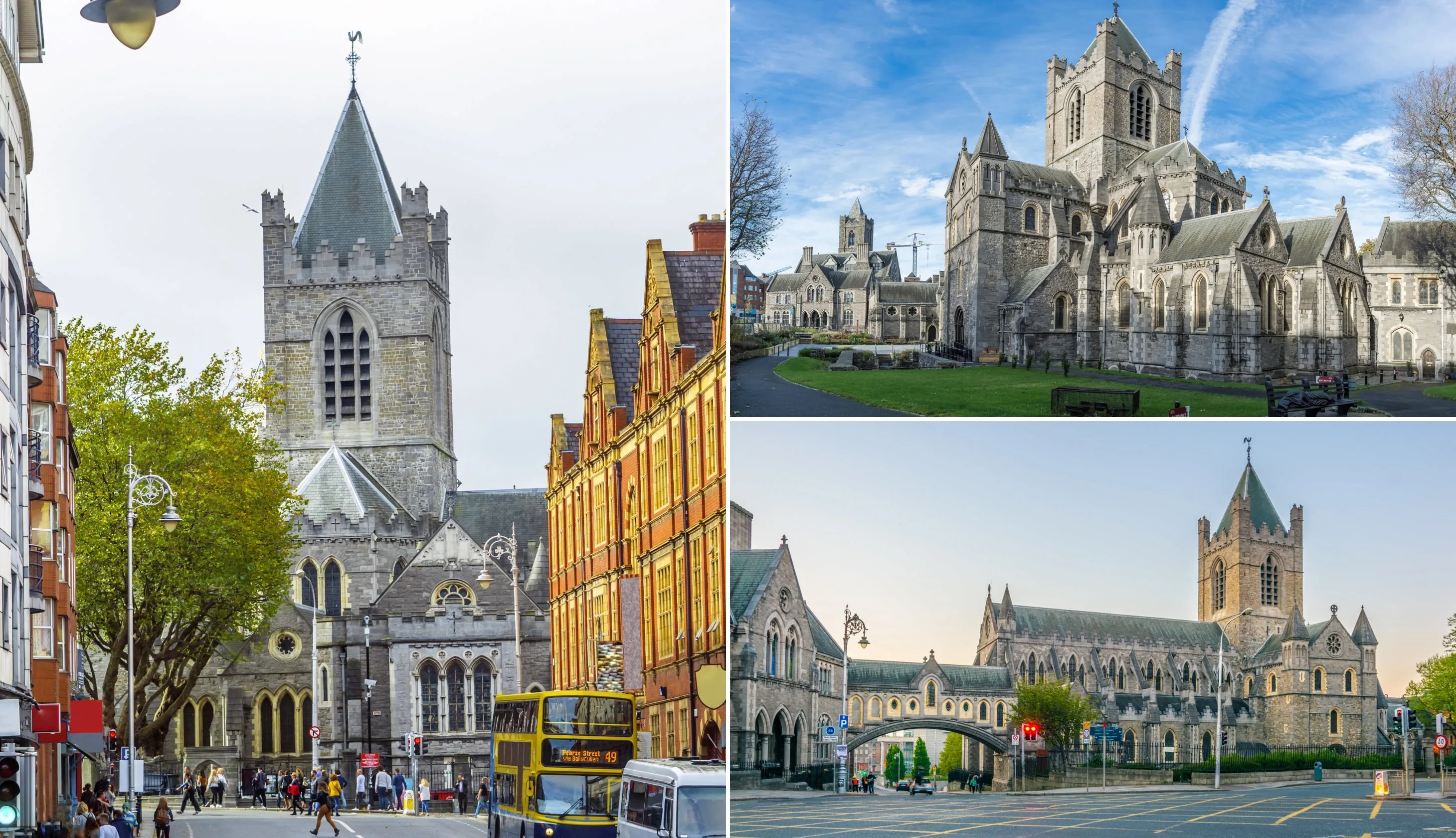
Photos via Shutterstock
Christ Church Cathedral dates back to the early 11th century when it was founded under Sigtrygg Silkbeard, a Norse King of Dublin. It was rebuilt later in stone, largely thanks to the first Anglo-Norman archbishop, John Cumin, in the late 12th century.
The cathedral is only a 4-minute walk from Dublin Castle and a really interesting place to visit. Some highlights are the restored crypt houses, Strongbow’s tomb, and the Treasures of Christ Church exhibition.
You can grab a ticket online here – these include an audio guide that comes in several languages, with three themes to choose from – ‘Power and Politics’, ‘Music and Spirituality’, and ‘Christ Church and the City’. Self-guided tours with an audio guide usually last around one hour.
Stop 7: Dinner, drinks and live music
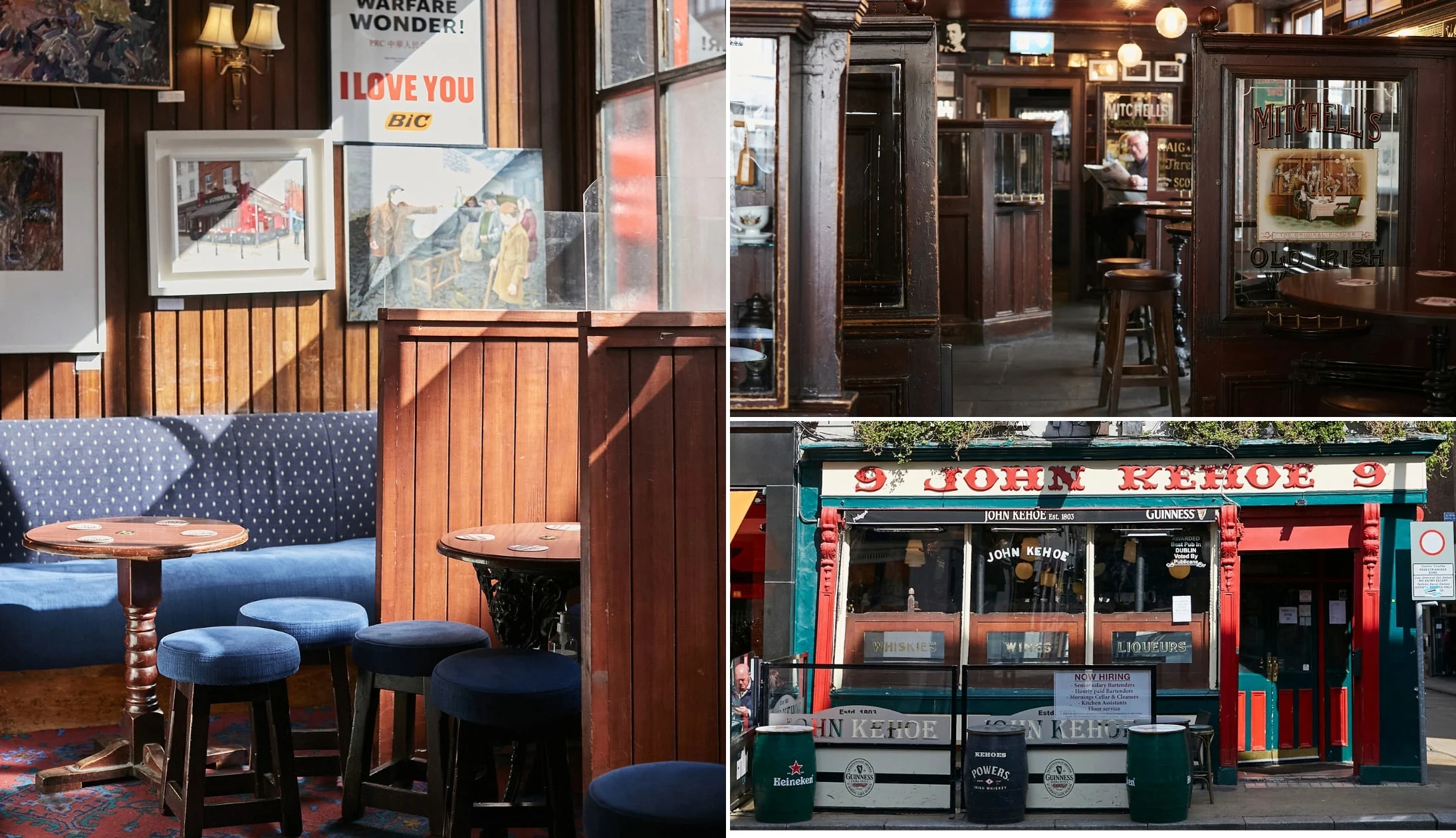
Different trad bars in Dublin. © Tourism Ireland
By now, you must be getting hungry. Dublin has heaps of options for dinner, but we’ve got a couple of suggestions for you!
Our dinner recommendations
If you’re looking for something close by, Spitalfields is a short walk from the cathedral. It’s a little bit pricey, but the atmosphere is great and the food is top-notch!
However, Spitalfields is 16+ only, so it’s not suitable for young families.
Otherwise, check out The Bull and Castle across the street from Christ Church Cathedral. Their menu has F.X. Buckley Steaks (renowned in Dublin), plus a great selection of local craft beers.
The restaurant can get booked out pretty quickly, but you can always eat in the bar upstairs, which also has steak on the menu.
Live music and trad bars
If you want a taste of what Dublin’s best pubs are, see our detailed Dublin pubs guide.
If you’re solely looking for places that do exceptional Guinness, see our guide to Dublin’s best pints.
If you fancy a bit of live music, there’s plenty on offer. Pipers Corner on Marlborough St. has some great tunes, with live music from 9pm every Tuesday to Saturday, and from 8pm on Sunday. The inside has more of a modern feel, but you’ll be guaranteed authentic Irish music.
For the full experience, O’Donoghues Bar on Merrion Row has live music every night of the week. It’s about as traditional as Irish pubs get, with a brilliant atmosphere.
The Celt is another fantastic pub with live music every night from 9pm, although it’s not always traditional.
Day 14: More Dublin City sites
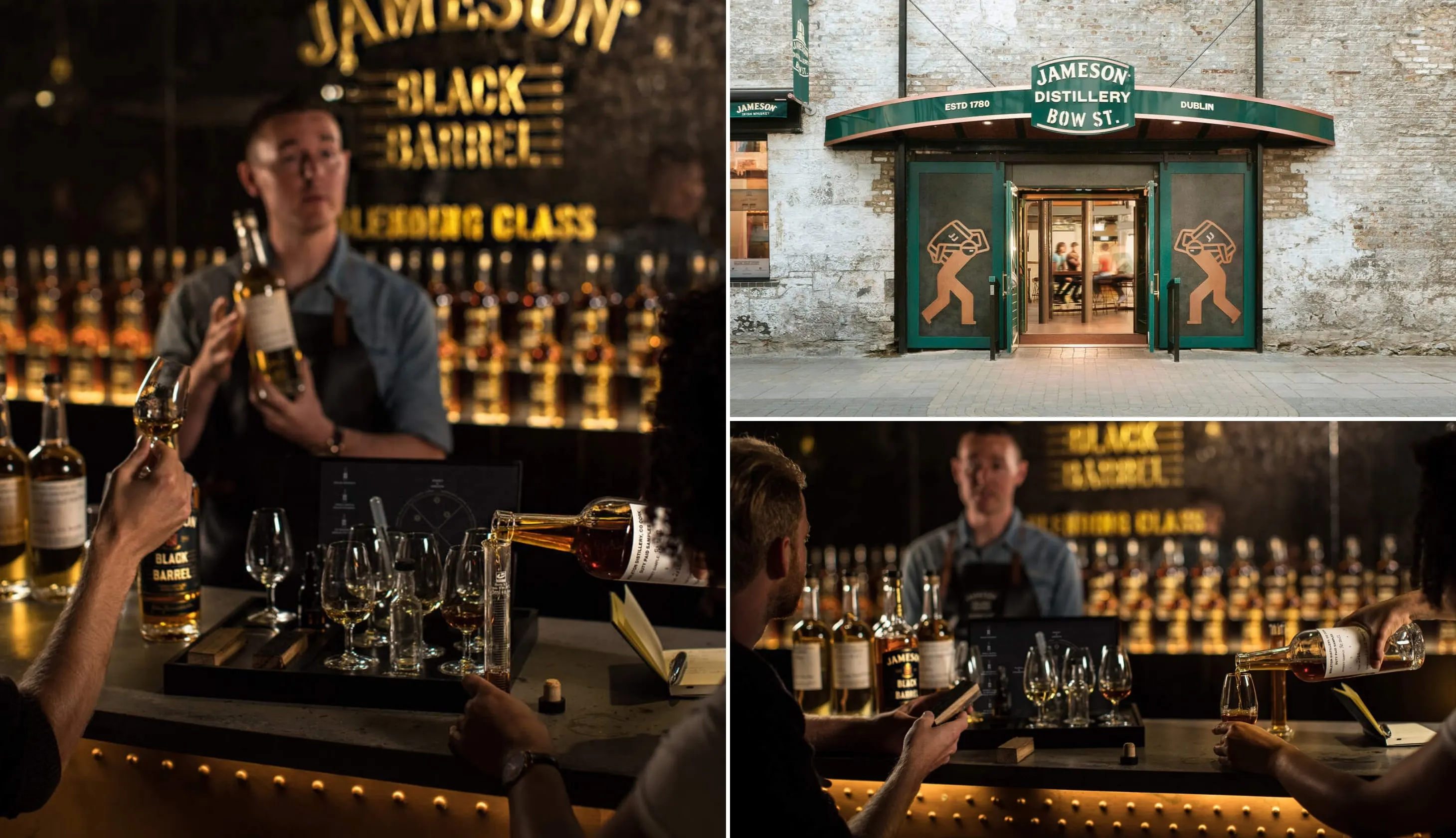
Courtesy Jameson Distillery Bow St, Dublin
It’s day 14 of our 20 days in Ireland itinerary, and there’s a full day of Dublin sightseeing ahead of you.
Now, although we’ve focused on the city for day two of this itinerary, you could easily change this day and explore the coast of Dublin.
For example, you could take a spin out to Howth Village, tackle the Howth Cliff Walk, grab lunch in the village and then take the train over to Malahide Castle.
Or, you can take it easy and stick to the city, like we do in the itinerary below.
Stop 1: Breakfast

Photos via Shutterstock
You may want to save money and eat breakfast at your hotel (if it’s included), but if not, we’ve got a couple of suggestions!
The Eatery on Church St. is a great choice for breakfast and it’s right across from St. Michan’s (your next stop). They do a great full Irish breakfast, or for something a little lighter, grab a pastry.
We also love Urbanity (a 4-minute walk away) for their delicious loaded porridge and orange, mango, and banana smoothie bowl.
Stop 2: St. Michan’s
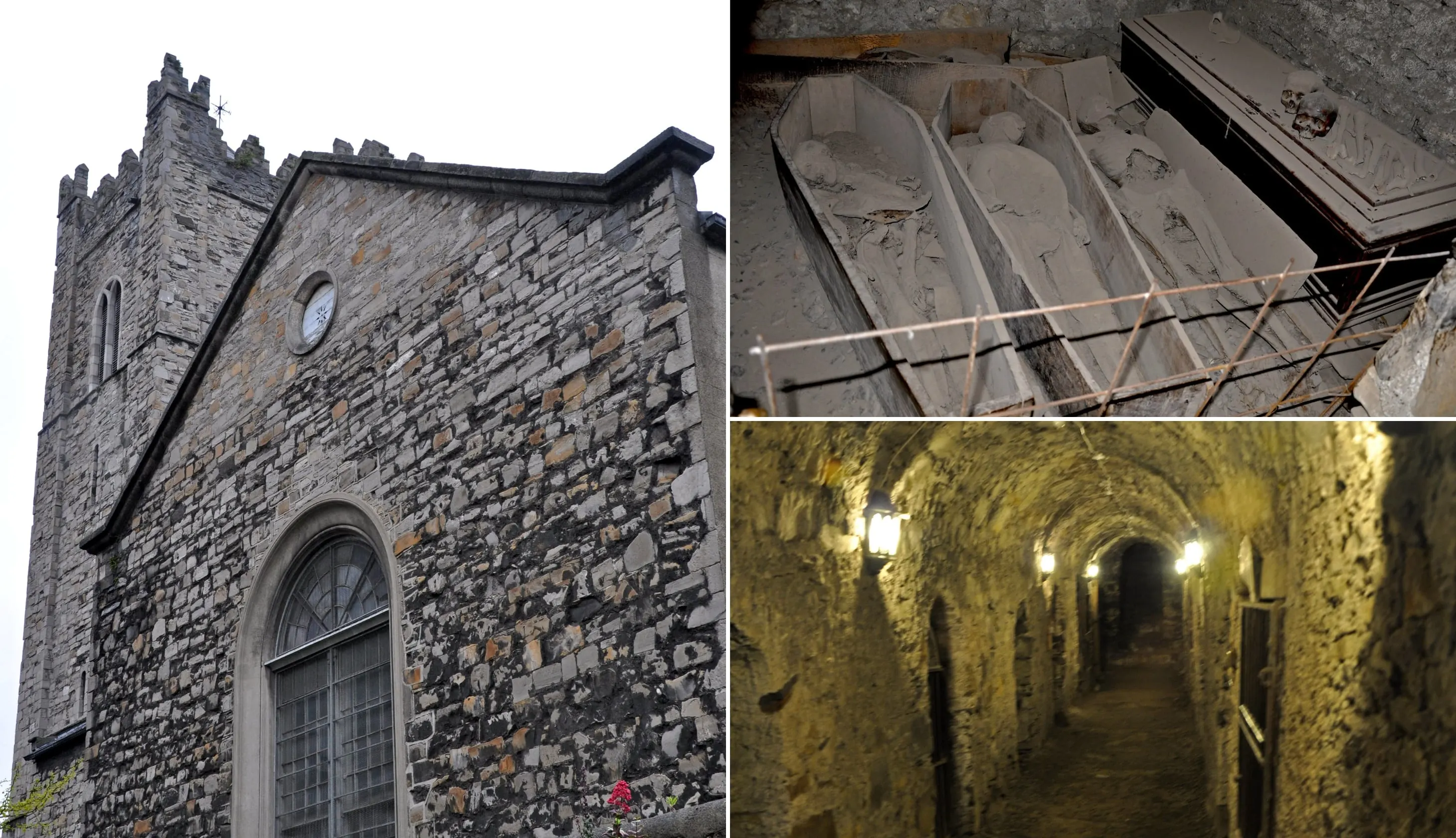
Photos with thanks to Jennifer Boyer
St. Michan’s on Church Street is a great way to kick-start the day. If you don’t fancy walking, take the Luas as far as Smithfield, which is a stone’s throw from St. Michan’s.
St. Michan’s is an incredibly interesting church that dates back to 1686, although there used to be a Christian chapel on the same spot, which was established as early as 1095.
Despite its modest size, St. Michan’s is packed full of history. In our opinion, the best way to learn about it is on their guided tour, which gives you loads of interesting info.
During the tour, you’ll get the chance to go into the 12th-century crypts and see real-life mummies that have been preserved for over 500 years; head into the vaults which were frequented by famous author Bram Stoker; and the magnificent organ, which is one of the oldest still in use in Ireland.
Stop 3: The Jameson Distillery

Courtesy Jameson Distillery Bow St, Dublin
The Jameson Distillery on Bow St. is only a 5-minute walk from St. Michan’s and you can book tickets in advance right here. The distillery was founded by John Jameson in 1780 and was the original site where the world-famous Jameson whiskey was distilled.
At its height in the late 1800s, many called the distillery a “city within a city” as it was 5 acres, housing engineers, painters, carpenters, coppersmiths, and more. There were two deep wells under the site to supply the distillery with water, and cellars were dug under streets nearby to store the whiskey. The distillery experienced highs and lows, eventually closing in 1971.
Today, Jameson is produced in County Cork, but the Jameson’s Distillery Bow St. offers award-winning tours and experiences. There are several to choose from lasting between 45 and 90 minutes, but for first-timers, we recommend the 45-minute Bow St. Experience.
Stop 4: Lunch
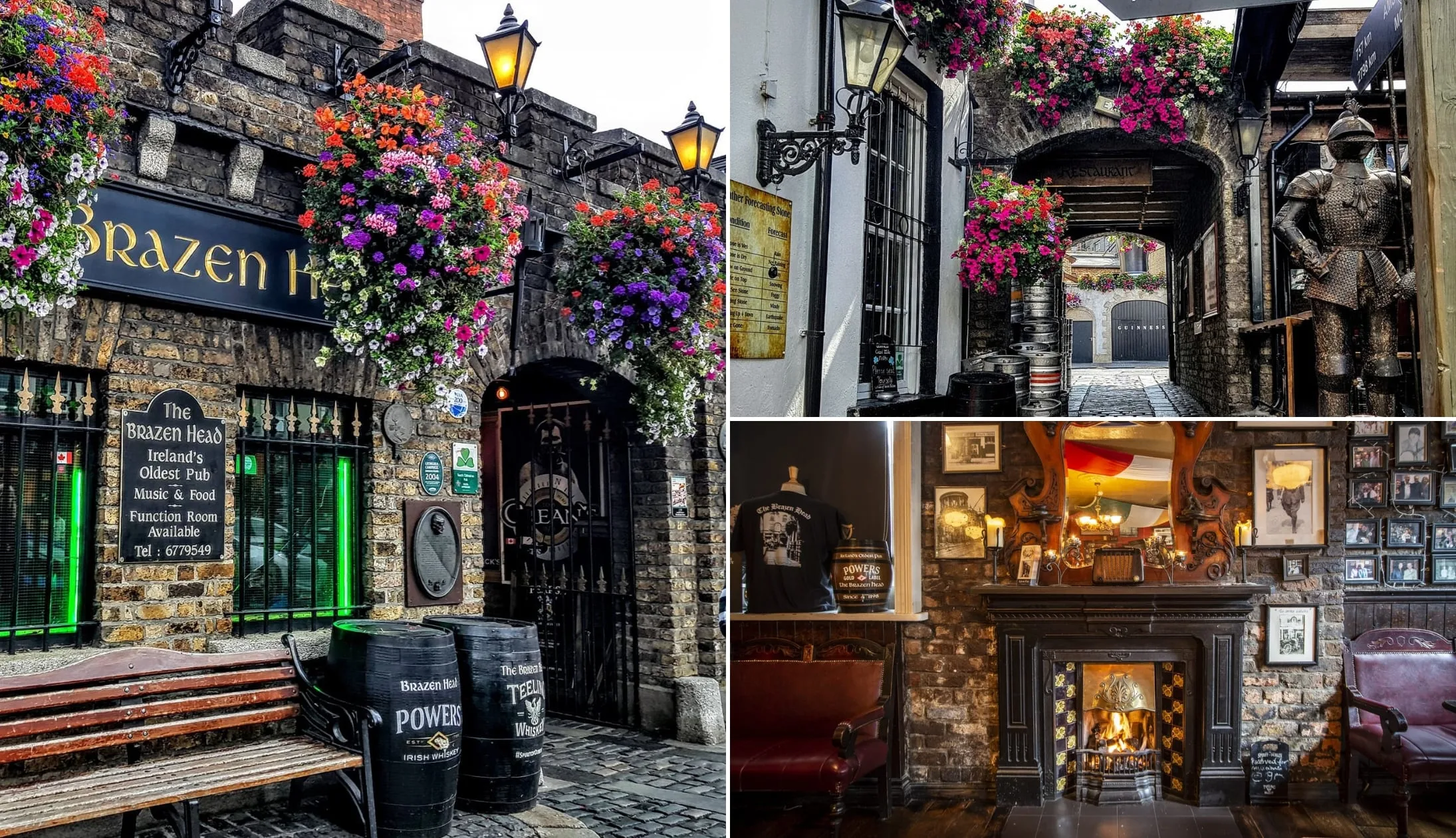
Photos via the Brazen Head on Facebook
There are some very old pubs in Dublin, but one reigns supreme! When you finish up at the distillery, you’re a short 7-minute walk to the Brazen Head. The pub is the oldest in Dublin and one of the oldest in Ireland, dating back to 1198. They serve traditional Irish pub grub and their Guinness beef stew is divine.
You’ve had a busy morning, so kick back here, make your belly happy and set yourself up for the next stop of the day.
Stop 5: Guinness Storehouse
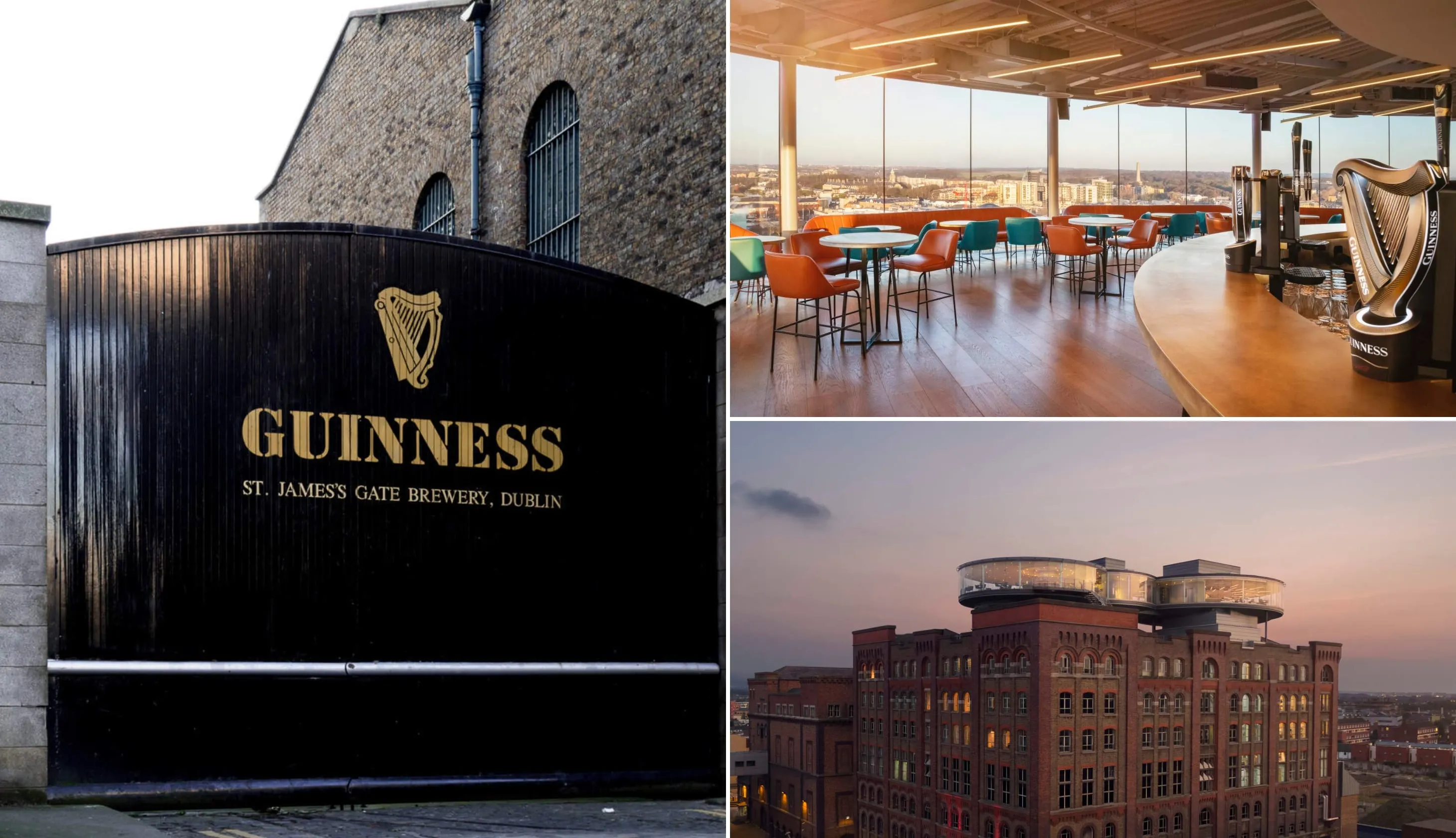
Photos © Diageo via Ireland’s Content Pool
Walk off your hearty pub lunch by taking the short 14-minute stroll to the Guinness Storehouse. It’s at St. James’s Gate, the home of Guinness, and there are several tours available.
We recommend the Guinness Storehouse Experience, a self-guided tour that takes roughly 90 minutes. You’ll learn about Guinness’ history, its ingredients, and get to enjoy a pint of Guinness and one other Guinness beer (for ages 18+) whilst taking in the views of the Gravity Bar.
Stop 6: Dinner, drinks and live music

Different trad bars in Dublin. © Tourism Ireland
For your second night in Dublin, we’ve got a few recommendations for you to consider.
Our dinner recommendations
If you’re looking for something close by, Spitalfields is a short walk from the cathedral. It’s a little bit pricey, but the atmosphere is great and the food is top-notch!
However, Spitalfields is 16+ only, so it’s not suitable for young families.
Otherwise, check out The Bull and Castle across the street from Christ Church Cathedral. Their menu has F.X. Buckley Steaks (renowned in Dublin), plus a great selection of local craft beers.
The restaurant can get booked out pretty quickly, but you can always eat in the bar upstairs, which also has steak on the menu.
Live music and trad bars
If you want a taste of what Dublin’s best pubs are, see our detailed Dublin pubs guide.
If you’re solely looking for places that do exceptional Guinness, see our guide to Dublin’s best pints.
If you fancy a bit of live music, there’s plenty on offer. Pipers Corner on Marlborough St. has some great tunes, with live music from 9pm every Tuesday to Saturday, and from 8pm on Sunday. The inside has more of a modern feel, but you’ll be guaranteed authentic Irish music.
For the full experience, O’Donoghues Bar on Merrion Row has live music every night of the week. It’s about as traditional as Irish pubs get, with a brilliant atmosphere.
The Celt is another fantastic pub with live music every night from 9pm, although it’s not always traditional.
Day 15: Wicklow’s Wonders
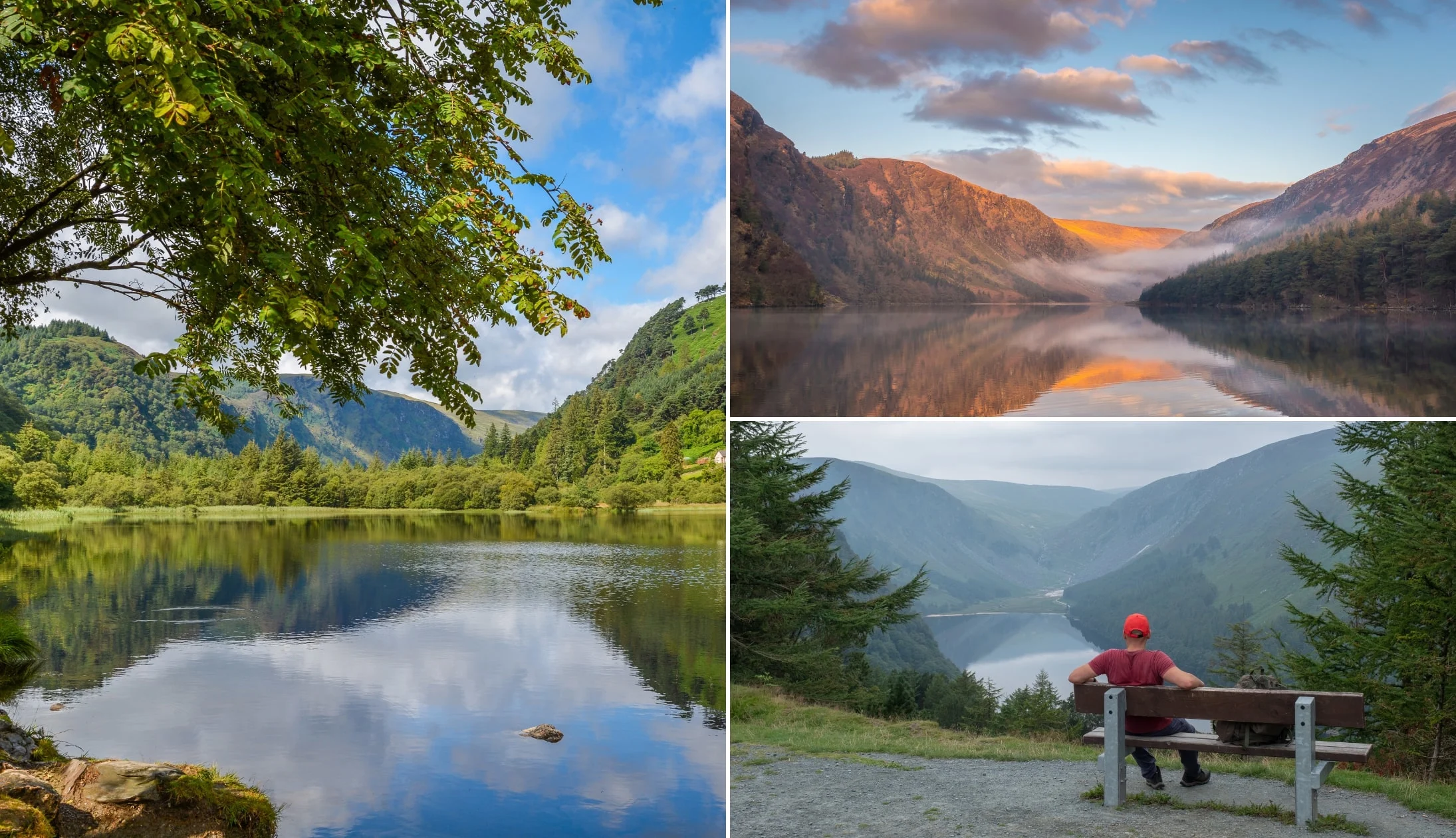
Photos via Shutterstock
Day 15 takes us into the stunning natural beauty of the Wicklow Mountains, just south of Dublin City. We’ll be heading to Glendalough National Park in the heart of the Wicklow Mountains, where you can enjoy a gentle stroll amid some of Ireland’s most spectacular landscapes.
Enjoy a hearty breakfast at your accommodation, or head into town to get food at one of Dublin’s amazing cafes.
We love to go to Lemon Crepe and Coffee Co on Williams Street (it’s just around the corner from the Molly Malone Monument too).
The focus is on pancakes, and you can enjoy a wealth of different sweet or savoury toppings. They also do omelettes and other egg dishes, toasts, melts, waffles, and much more. All washed down with a superb cup of coffee.
Stop 1: Lough Tay and optional walks and hikes
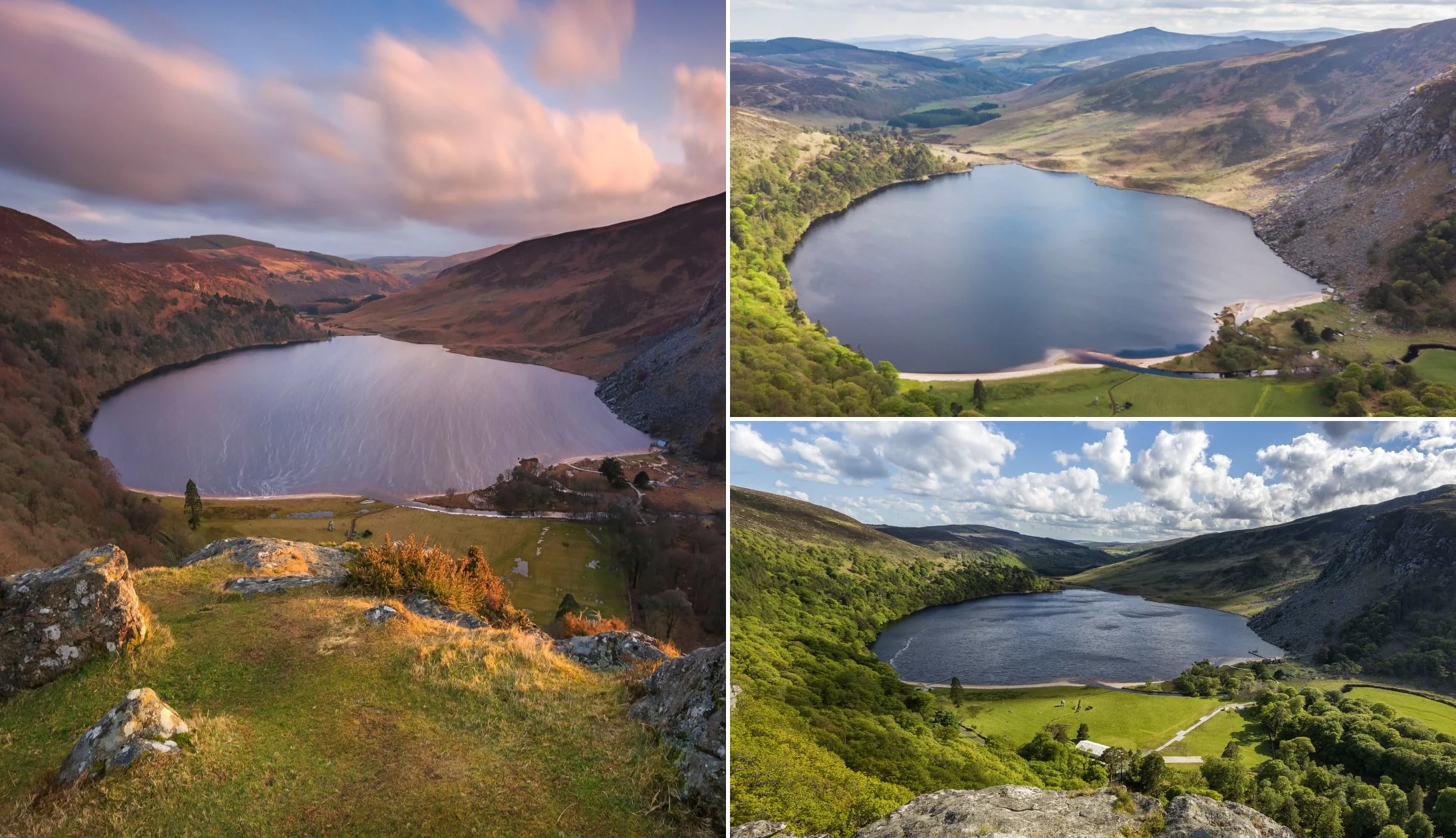
Photos via Shutterstock
Right, you’re going to be taking what’s known as the Sally Gap Drive before you head to Glendalough. This is one of the finest drives in this part of Ireland, so you’re in for a treat.
The first stop is Lough Tay, which more famously known as the Guinness Lake, due to the fact that it’s on the Guinness estate, but also because it looks almost like a pint of Guinness when viewed from above.
There’s a nice viewpoint here (care is needed as there are sheer drops). Now, although we’d recommend you follow the route below and tackle the Spinc hike in Glendalough, there are two great hikes near Lough Tay:
Stop 2: Glenmacnass Waterfall
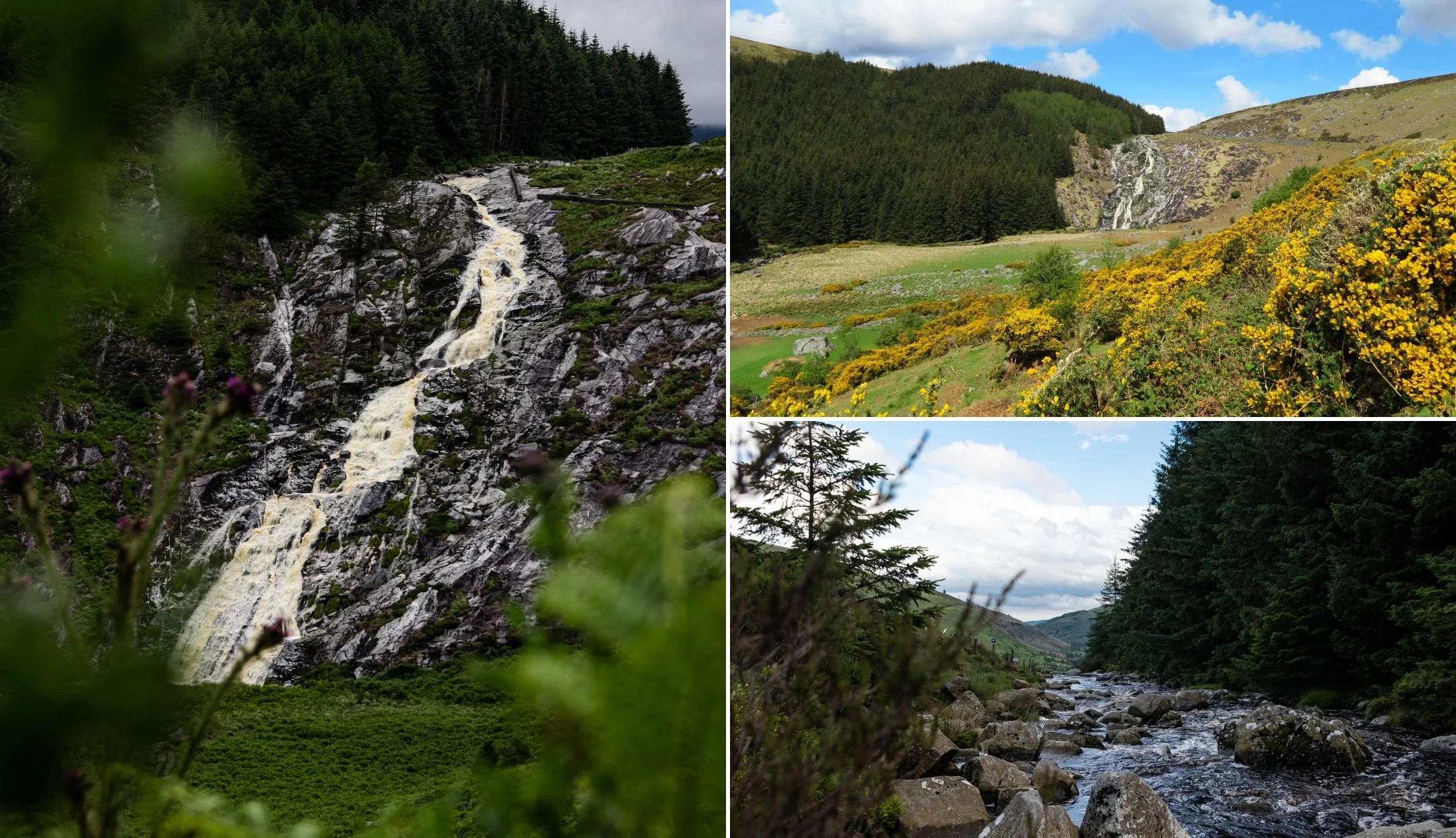
Photos via Shutterstock
Follow the road from Lough Tay and you’ll be treated to glorious mountain scenery, wide open bogland and some roadside Christmas Trees, fully decorated throughout the year (yes, very random!).
Follow the road around to Glenmacnass Waterfall, a beautiful 80-metre cascade that tumbles down the mossy rocks into the river below.
It’s located on the road from Sally Gap to Glendalough and the village of Laragh. There’s a handy car park and from here you can take a short walk to the top of the falls to see them tumbling into the valley below.
Stop 3: Glendalough Visitors Centre and Monastic City
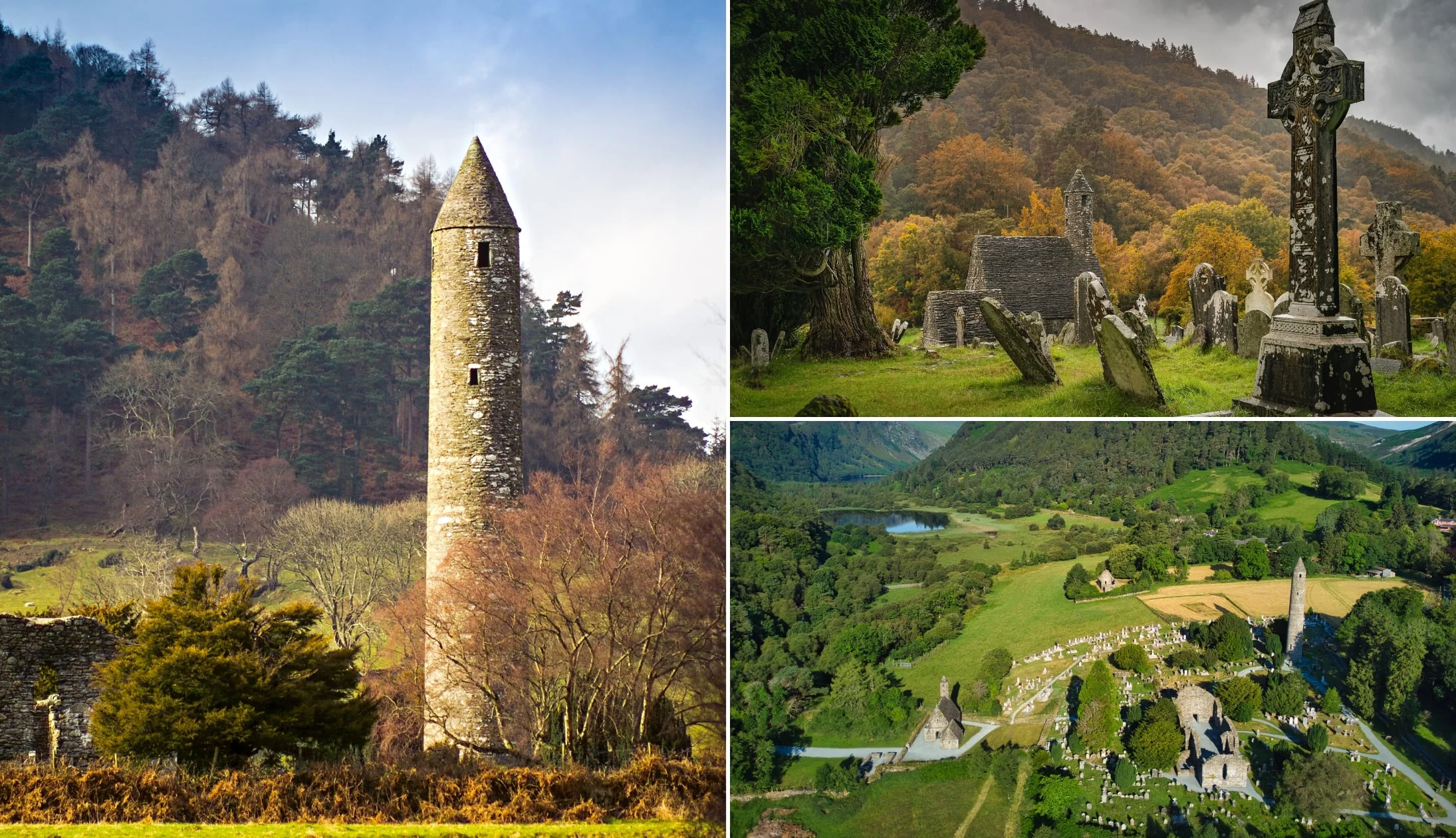
Photos via Shutterstock
Once you arrive at Glendalough, park up at the visitor centre (lower) car park, and pop inside to discover a number of interesting exhibits and displays. These tell the history of the area, while giving a fascinating insight into the natural life that inhabits it too.
Entrance to the visitors centre costs €5 for adults, €3 for children/students and €13 for a family of four, and it’s open daily from 09:30 to 18:00 (peak season) or 17:00 (low season).
Once you’ve finished inside, take a walk outside and discover the fantastic Glendalough Monastic City. Founded by St. Kevin in the sixth century, it’s home to some ancient round towers, churches, and tombs, as well as an extensive graveyard. The ruins are amazingly well-preserved and sit amid some of the finest scenery in Ireland.
Stop 4: Pick a walk in Glendalough
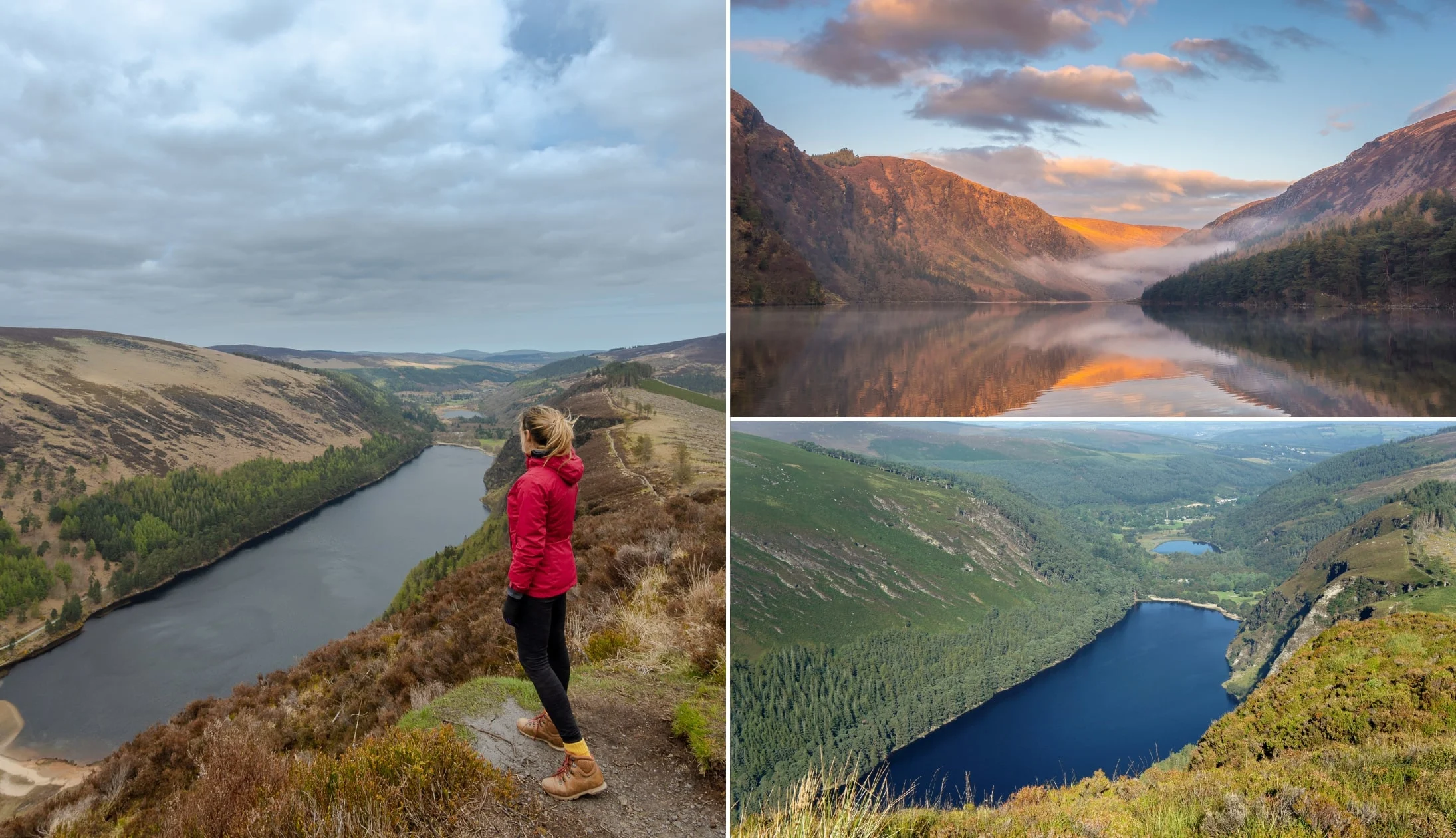
Photos via Shutterstock
There are heaps of walks in Glendalough to choose from, ranging from grand and handy to long and toughish.
We’d recommend that you opt for the longer Spinc Loop (pictured above). The Spinc is a gorgeous ridge that overlooks the magnificent Glendalough Valley.
The route we recommend is a moderate to strenuous 9.5 km walk that should take about 3.5 hours to complete. There are shorter walks which you can find here.
Stop 5: A late lunch at the Wicklow Heather

Photo left: The Irish Road Trip. Others: Via Wicklow Heather
Once you’ve finished exploring, you can drive up to the Wicklow Heather for lunch. It’ll take about 5 minutes to get there, and it has an extensive car park. We always recommend the Wicklow Heather for its cosy atmosphere, quaint decor, and excellent menu. You can choose from a number of traditional Irish dishes, as well as sandwiches, seafood, and much more, including veggie and vegan options.
Stop 6: Back to Dublin for the night

Different trad bars in Dublin. © Tourism Ireland
After enjoying a nice walk amid the stunning scenery of the Wicklow Mountains, it’s time to head back to Dublin for the night, for dinner, drinks, and maybe a little music.
Our Dublin food recommendations
There’s endless excellent restaurants in Dublin. However, if we had to pick one or two…
The first would be The Bull and Castle – it’s always a good choice and it’s right across the street from the Christ Church Cathedral.
An FX Buckley steakhouse (a Dublin institution), they offer a great range of steaks cooked to perfection, paired with their incredible beef dripping chips.
The Vintage Kitchen is an alternative, but it’s best to book in advance as it’s incredibly popular. A BYOB (bring your own bottle) place, the food is phenomenal, with a small but diverse menu that features classic Irish dishes with a contemporary twist.
Our Dublin pub recommendations
There’s certainly no shortage of great pubs in Dublin. If you’re a fan of old-school pubs, follow our Dublin pub crawl guide – it contains a short route with some of the city’s finest trad bars.
McNeils on Capel Street is an authentic Dublin pub, complete with wood panelling, impromptu folk sessions, and plenty of beers on tap.
The Long Hall is another must-see. Part Victorian time capsule, part vibrant boozer, it enjoys a fantastic atmosphere and is one of the most visually stunning pubs in the city.
You’ll find trad sessions at Pipers Corner every night of the week. O’Donoghues Bar on Merrion Row is another must-visit, with vintage decor and frequent trad sessions. It’s best-known as the home of the Dubliners, who used to play here regularly.
The Celt on Talbot Street is another great choice for live music, and while it’s not always trad, the bands are normally really good.
Day 16: The Boyne Valley and back to Belfast
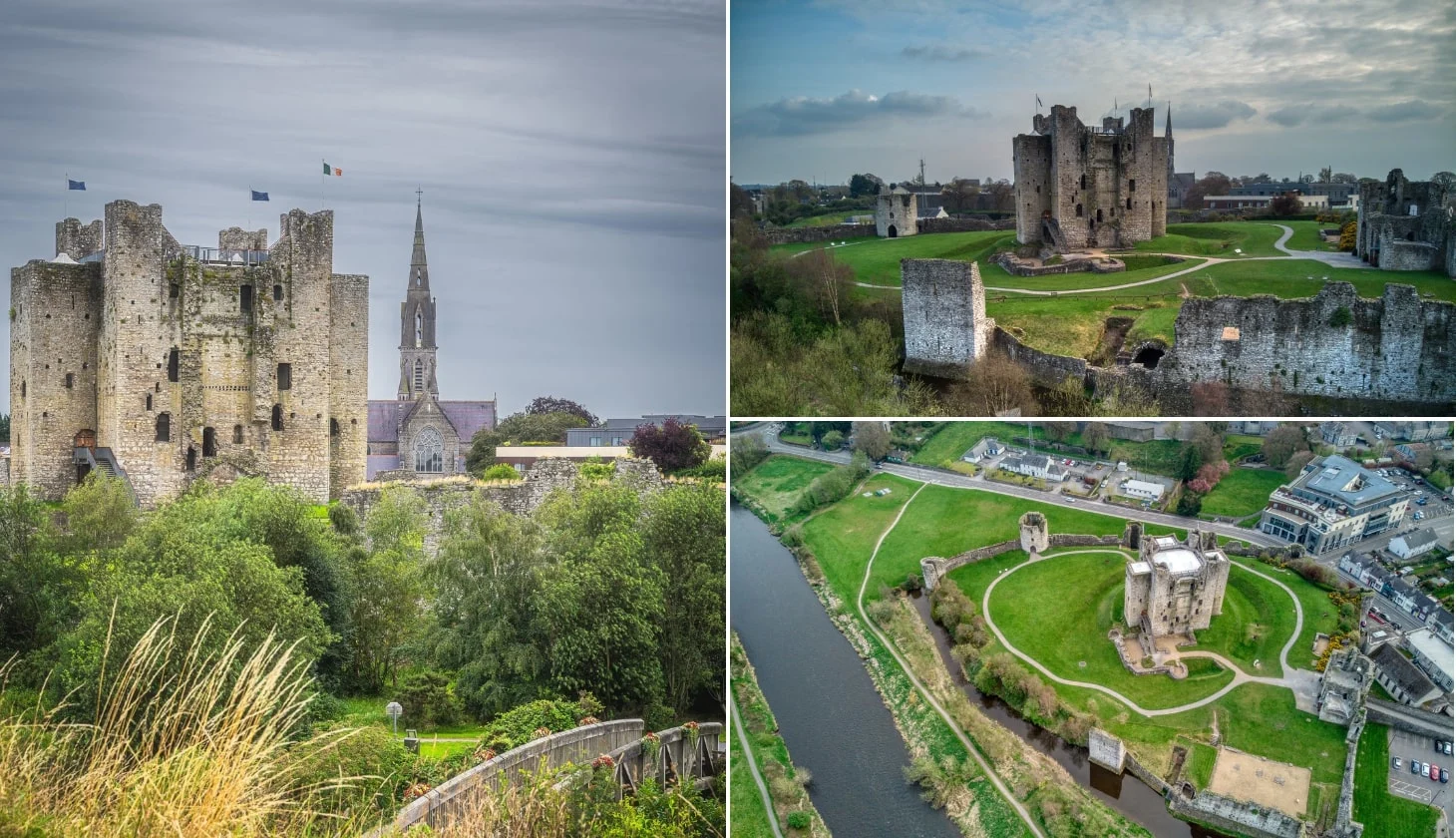
Photos via Shutterstock
Today, we’ll be heading out of Dublin and travelling to Belfast via the beautiful Boyne Valley.
Along the way, we’ll be stopping off at a number of iconic Irish sights before arriving in Belfast.
Before we hit the road one last time, be sure to grab a decent breakfast, either at your accommodation or at one of the many superb Dublin cafes that we mentioned before.
You’ll need to book accommodation in Belfast for two nights:
Our Belfast accommodation recommendations
- Budget: Vagabonds Hostel(in the city centre with top reviews) and Amica Guesthouse (short bus/drive from city centre with great reviews)
- Mid-range: Ten Square Hotel and Maldron Hotel Belfast City (both are super central with exceptional reviews)
- Luxury: The Fitzwilliam and The Merchant (both gorgeous, high-end hotels at the heart of the action)
Stop 1: Hill of Tara
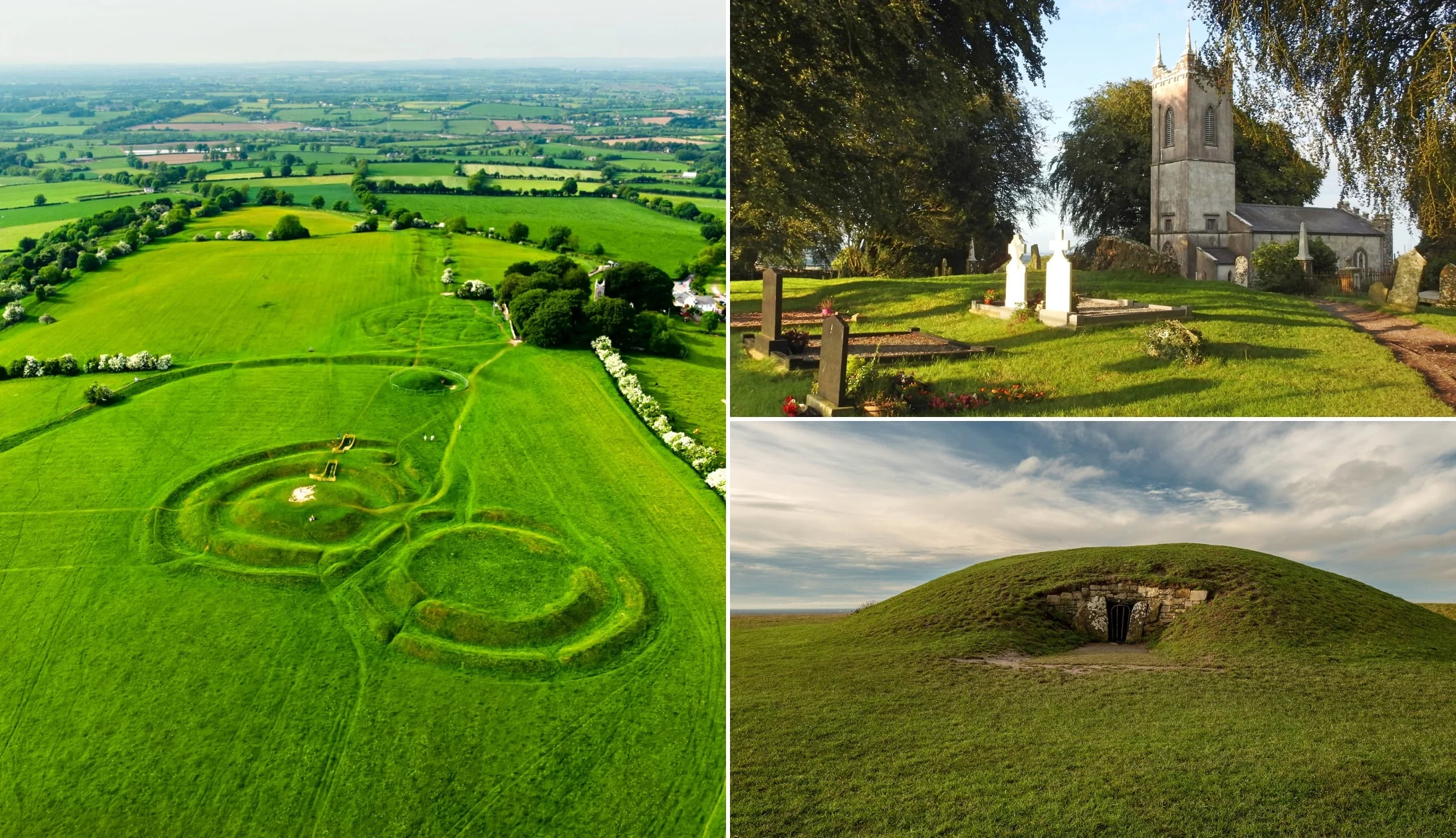
Photos via Shutterstock
Our first stop is the iconic Hill of Tara, just a 50-minute drive from Dublin. Dating back to the Iron Age, this hilltop is a veritable archaeological treasure trove and was formerly the seat of the High Kings of Ireland. The area is awash with ancient monuments, including passage tombs and burial mounds that date back thousands of years.
There’s an extensive car park on the side of the road, and you can enjoy a nice walk up onto the hills to get a better look at the various ancient sites. The surrounding scenery is also breathtaking, and you can see why it was so important to the High Kings of Ireland. If you fancy a coffee, drop by Maguires Cafe and Gift Shop to refuel.
Stop 2: Bective Abbey
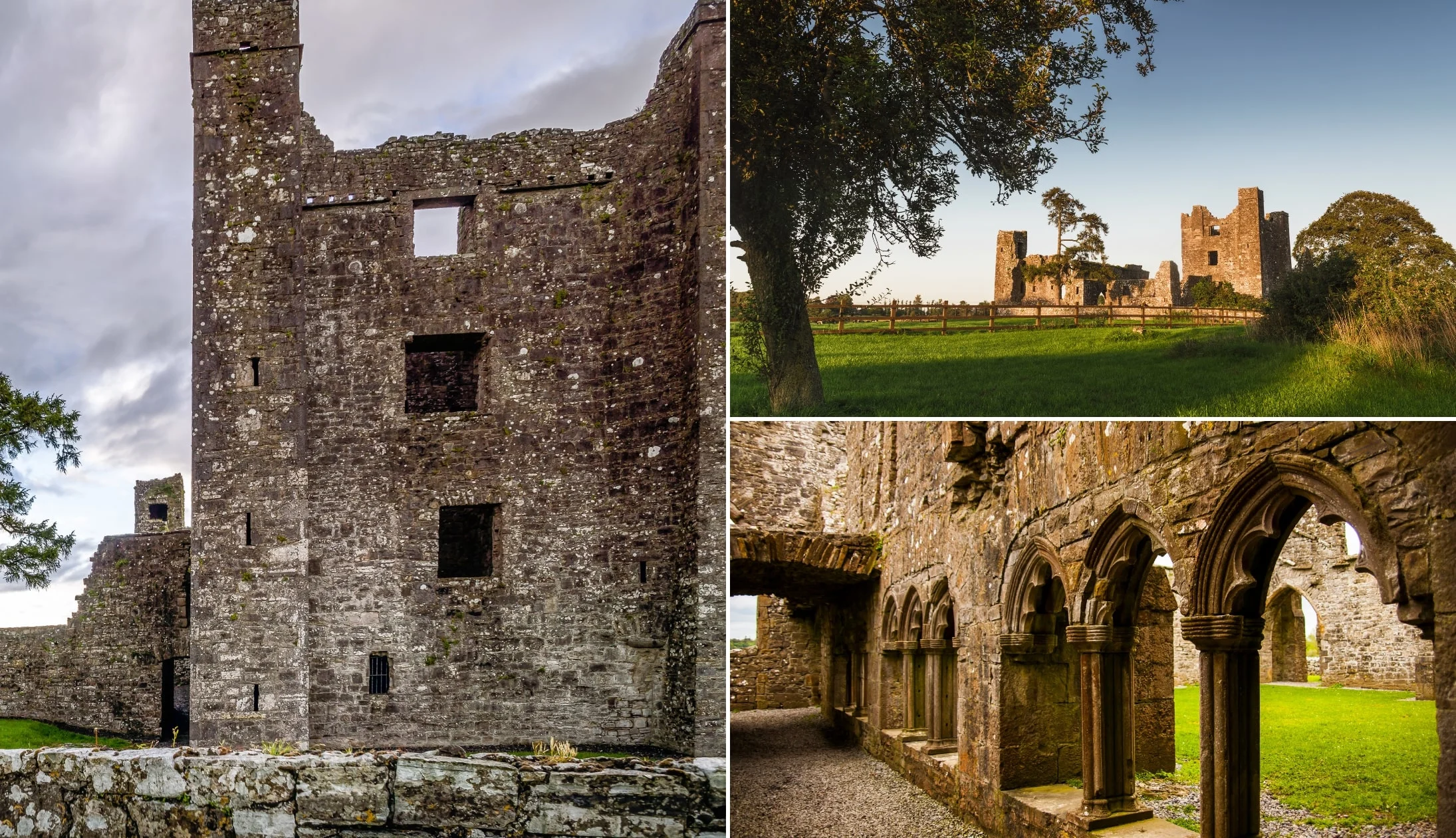
Photos via Shutterstock
Just a ten-minute spin away from the Hill of Tara, Bective Abbey dates back to 1147 and was Ireland’s second Cistercian Abbey. The ruins are remarkably well-preserved, though most of what remains date back to the 13th and 15th centuries. In particular, the cloister stands proud to this day. In fact, you might recognize it from the movie Braveheart.
You’ll see it clearly from the road, an impressive and iconic structure standing proud among the lush green surroundings. There’s a handy little car park, and from there it’s just a short walk to the ruins. It’s free to visit, and you can walk among the ruins at your leisure, reading the information panels to learn more about the history.
Stop 3: Trim Castle and lunch

Photos via Shutterstock
Continue driving for another ten minutes through the gorgeous Boyne Valley countryside before arriving at our next stop, Trim Castle. The castle is open seven days a week, between 10 am and 5 pm and an adult ticket will cost you €5, a senior ticket is €4 and child and student tickets are €3. Like Bective Abbey, scenes of the movie Braveheart were filmed at Trim Castle.
Trim Castle dates back to the 12th century and is steeped in history as the site of many battles and raids. Despite its tumultuous history, it remains in great shape, with an intact tower house and walls. You can take a guided tour that lasts about 45 minutes. Along the way, you’ll explore the various halls and chambers, before heading to the top of the castle to admire the amazing views of the surrounding town and countryside. If you don’t fancy going inside, you can enjoy a couple of lovely riverside walks around the outside of the castle.
There’s a handy pay and display car park at the castle, although the maximum stay is two hours. If that’s full, there’s another pay-and-display car park opposite the castle on the humorously-named Finnegan’s Way, just off Castle Street.
After enjoying the castle, take a stroll around the gorgeous town of Trim and drop by Rosemary Bistro for lunch. Here, you’ll find a good range of soups, sandwiches, and wraps, as well as heftier dishes like burgers, fish and chips, and lamb shank.
If you’re parked in the castle car park, on Frenchs Lane, just be mindful that you only have a maximum of two hours. If time allows, it’s well worth walking the streets of Trim and discovering sights such as Ireland’s oldest bridge, as well as the various shops in town.
Stop 4: Slane Castle and the Hill of Slane
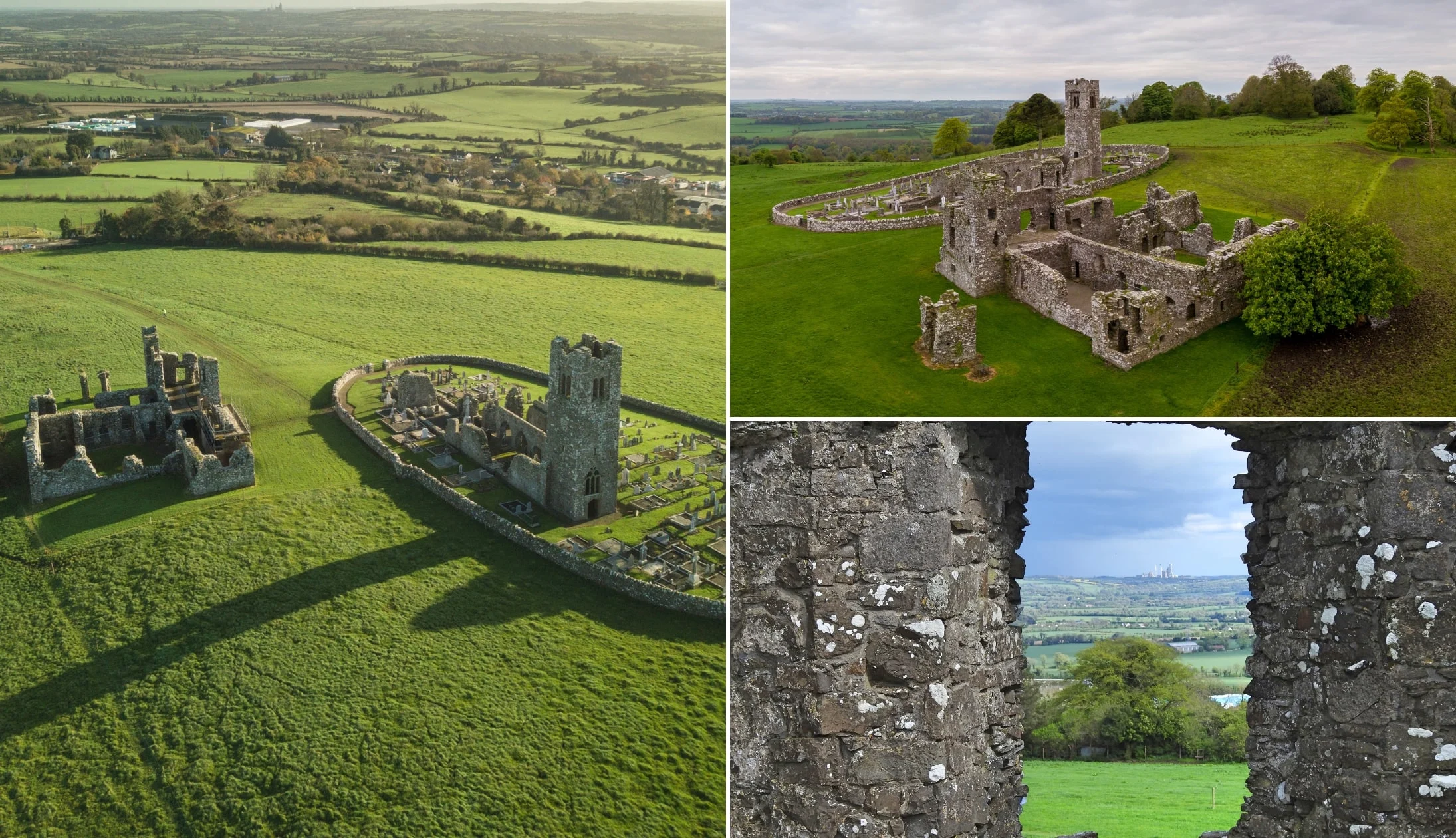
Photos via Shutterstock
After lunch, we’re back on the road for just over 30 minutes. Enjoy the gorgeous surroundings before arriving at the mighty Slane Castle and the Hill of Slane. The 18th-century Slane Castle has lots to offer, and you could easily spend several hours here. There are guided tours at weekends, though you’ll need to book in advance. Otherwise, check out the distillery or tackle the Slane Castle walking trail.
Once you’ve finished at the castle, check out the Hill of Slane, just 4 minutes away. There’s ample parking at the entrance, just follow signs for ‘The yard’ or Abbey View. The hill is steeped in mythology, with legends saying that a king of the Fir Bolg is buried beneath it. A shrine to the Tuatha Dé Danann was erected and the hill has been a hub of religious activity ever since. You can still see the well-preserved ruins of a 16th-century friary church and college to this day. Since the hill towers above the surrounding countryside, the views from the top are gorgeous.
Stop 5: Newgrange
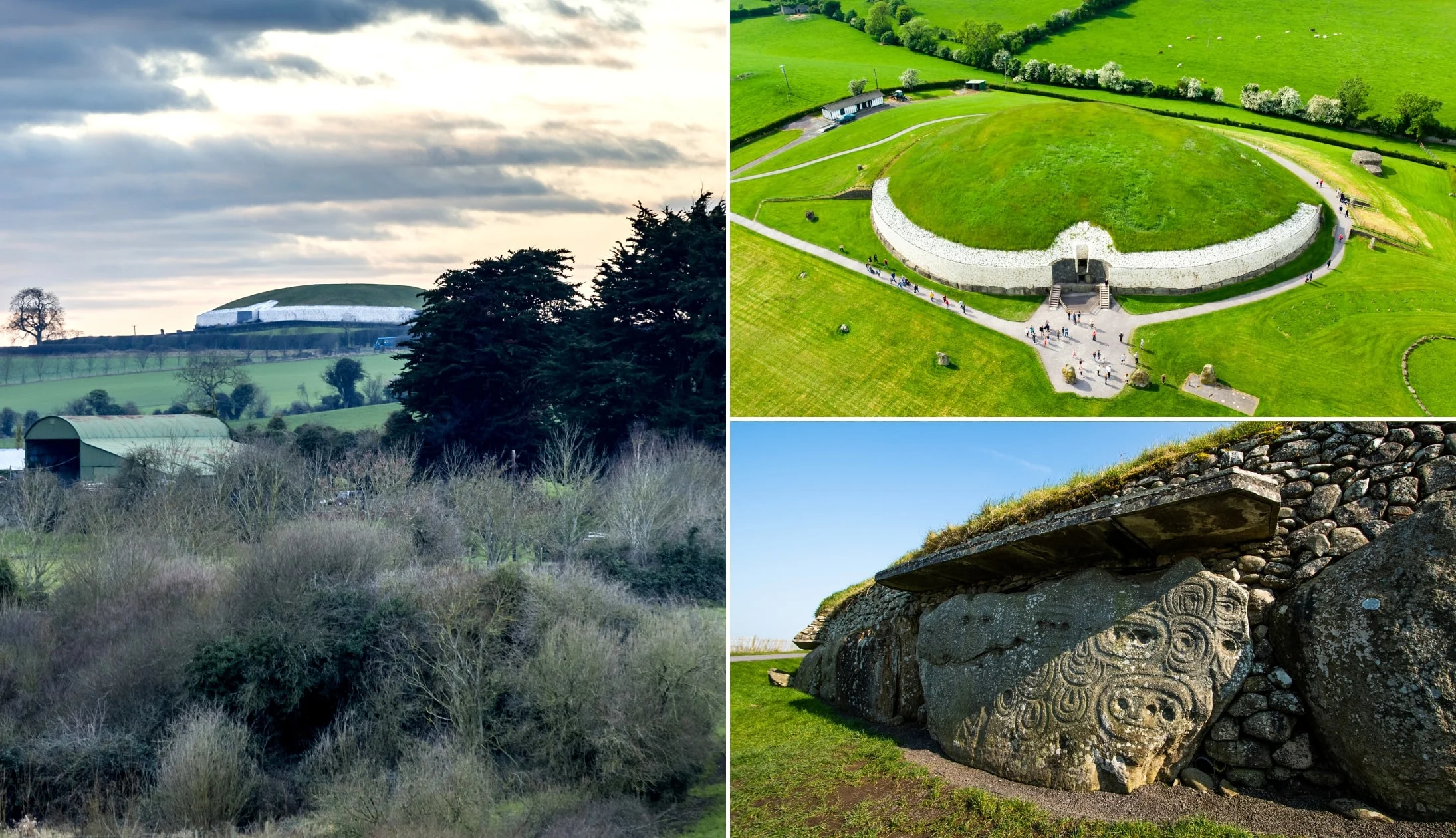
Photos via Shutterstock
Our next stop is a must-see, especially if you’re a history buff. Just a ten-minute drive away, the Newgrange Passage Tomb is one of the oldest attractions in Ireland. Dating back to 3,200 BC, it predates the pyramids and offers one of the earliest surviving examples of the triskele, the iconic Celtic three-spiral design.
There really is nothing else like it, and the best way to see it is by taking a guided tour. It’s well worth the cost and pre-booking is strongly recommended. On the tour, you’ll learn about the fascinating history of the site, while taking in a number of tombs, tunnels, mounds, rock art, and monuments. The visitor centre is also incredible, with a number of displays and exhibits to enjoy. You won’t want to miss this one.
The tour lasts about an hour, though it can easily take three hours to explore the full site.
Stop 6: Monasterboice
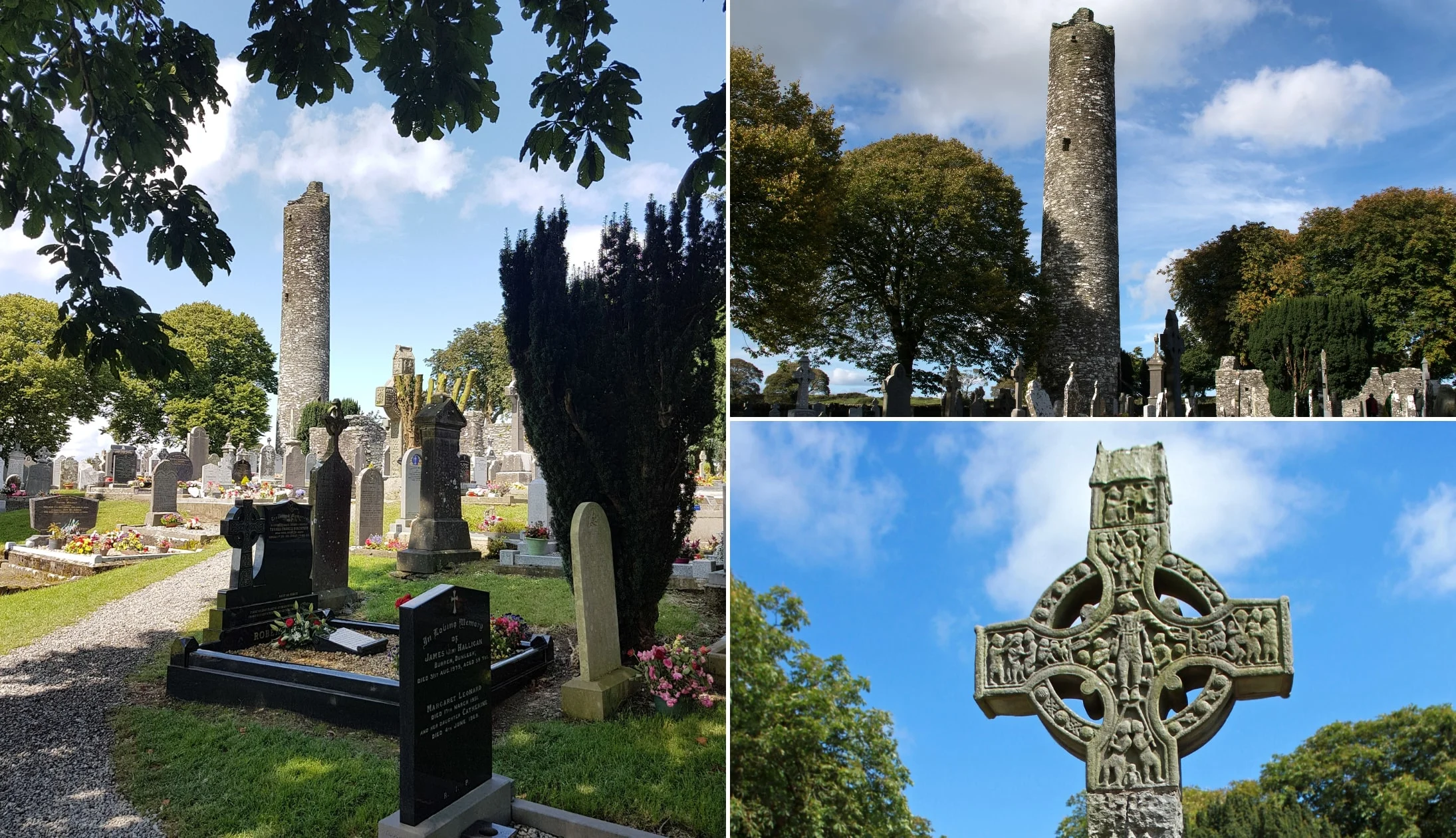
Photos via Shutterstock
Next up, Monasterboice is a stunning early Christian settlement that has been lovingly preserved. It’s about 20 minutes away from Newgrange and there’s a spacious car park right across the road. Dating back to the 5th century, the settlement was founded by Saint Buithe. The well-preserved remains of a 28-metre tall round tower and two magnificent Celtic high crosses are the biggest draws.
In fact, the Cross of Muiredach, or South Cross, is said to be the finest surviving example of a Celtic cross in Ireland. Standing 5.5 metres tall, with incredible intricate carvings, it’s not hard to see why. Enjoy half an hour of wandering around the beautiful grounds before jumping back in the car and heading to Belfast.
Stop 7: Belfast for the night
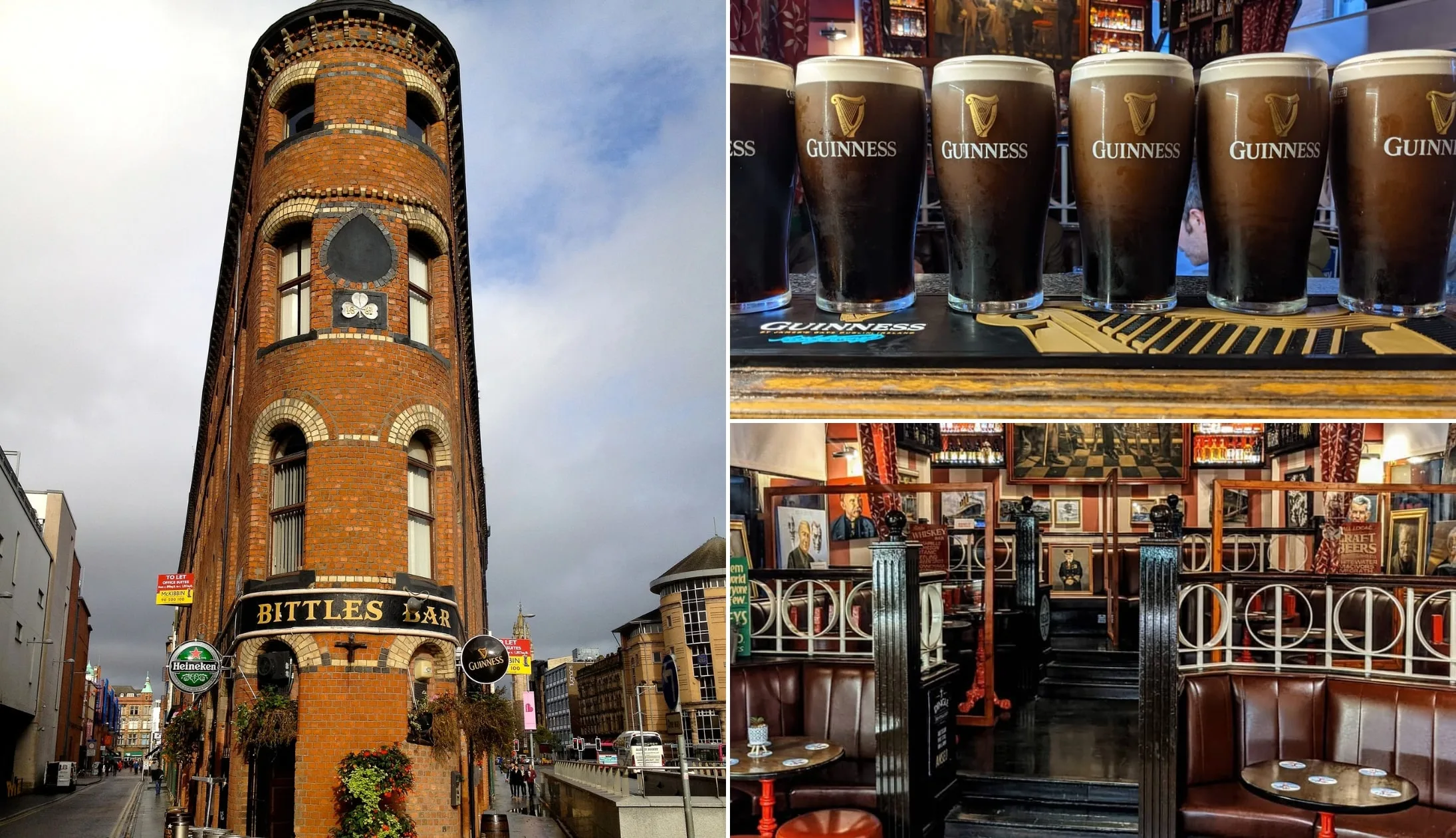
Photo left: Silvia Franceschetti (CC BY-SA 3.0). Others via Bittle’s Bar on FB
It’ll take about an hour and ten minutes to reach Belfast from Monasterboice. Once you arrive, check into your accommodation, freshen up, and hit the town for your last night in Ireland.
Our Belfast food recommendations
There’s some outstanding restaurants in Belfast City. First up, Deanes is a Belfast institution and a must-visit while you’re in the city. There are three venues to choose from, each focusing on something different; Deanes Meat Locker, Deanes Love Fish, and Deanes at Queens.
Whichever you choose, you’re in for a fine feed. EDO is another favourite of ours, a stunning tapas and cocktail bar with incredible sharing platters.
Or, for a fancy first meal in Northern Ireland, head to The Ginger Bistro, near the Belfast Opera House. Their menu is out of this world, though that’s no surprise when you consider it was voted the best restaurant in Northern Ireland.
Our Belfast pub recommendations
There are countless incredible pubs and bars in Belfast for a tasty after-dinner tipple. Check out traditional options like the unmistakable Bittles Bar, with its stunning range of local beer and Irish whisky.
The Duke of York is another old-school boozer, walls adorned with knick-knacks from yesteryear and serving up a fine pint of Guinness.
Finally, we couldn’t forget Madden’s Bar, a cosy, traditional pub complete with a roaring wood-burning stove and a friendly atmosphere. Somewhat overlooked, it’s a hidden gem, beloved by those in the know!
Traditional musicians from across Ireland come to play at Kelly’s Cellars every Tuesday, Wednesday, Thursday, and Saturday.
Other fantastic options for music include Fibber Magees, another charmingly old-fashioned pub with a lively atmosphere, and the John Hewitt.
Day 17: Belfast
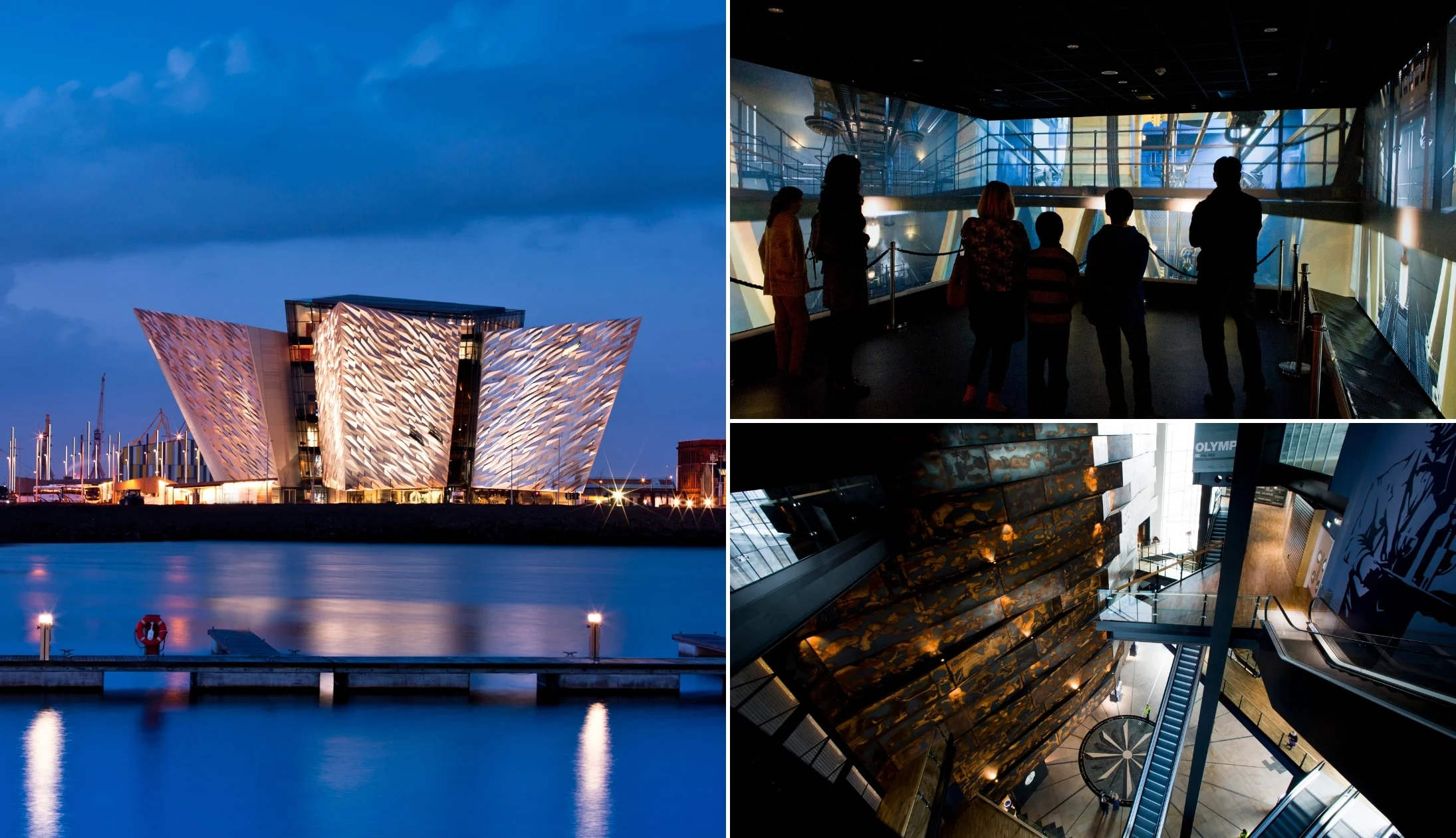
Photos by Chris Hill via Tourism Ireland
Today we’ll be enjoying more sights and attractions in and around Belfast City. You’ll be driving to most of these, though some are within fairly short walking distance of one another if you prefer to park up in the city centre halfway.
We’ve got quite a busy day lined up, so you’ll want to grab a hearty breakfast at your accommodation or in a nearby cafe. We’d recommend Established Coffee on Hill Street for a decent selection of cooked breakfasts, great coffee, and pastries. Alternatively, The Pocket on Upper Church Lane does a stunning full Irish fry-up and a bunch of veggie and vegan options.
Stop 1: Cavehill Walk

Photos via Shutterstock
The Cavehill walk is hands down one of the best walks in Belfast, offering those that conquer it unbeatable views out over Belfast City. Now, there are several different trails to tackle at Cavehill Country Park, with each ranging in difficulty level, but the most popular is a circular route that starts and ends at Belfast Castle.
Depending on your pace and the weather, this walk should take between 1.5 and 2 hours minimum. The walk is a circular route that covers a distance of 4.5 miles. Allow at least 2 hours to be safe. The Cavehill Walk is challenging, and a good level of fitness is needed. Some of the paths are unsurfaced and steep in parts, so good walking boots are advised, especially if it’s a wet day.
It’s a 16-minute drive from the city centre to Belfast Castle, where this walk starts and ends. You’ll find a spacious car park here.
Stop 2: Belfast Castle
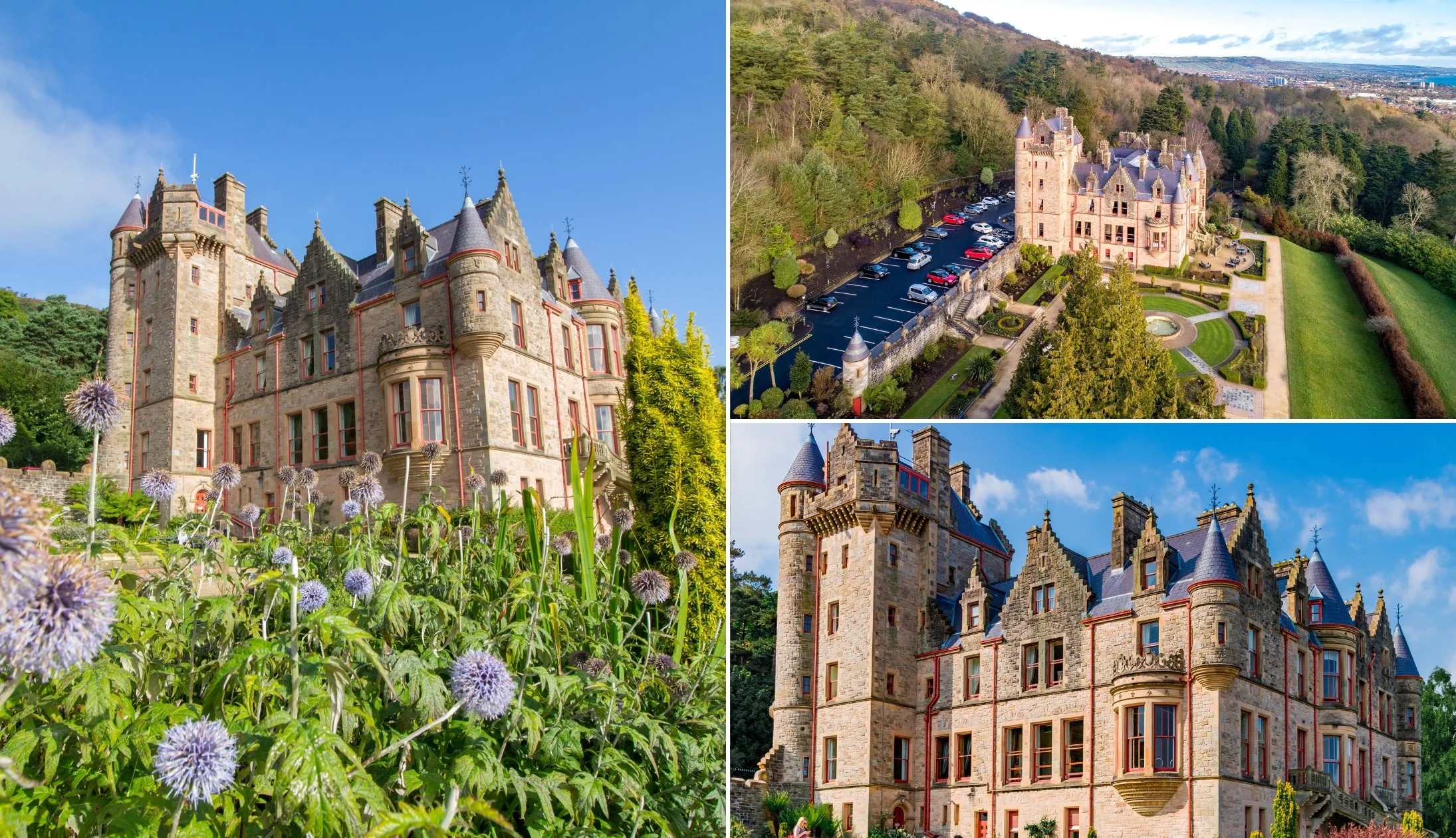
Photos via Shutterstock
Your hike starts and ends at the Disney-esque Belfast Castle, so it’s well worth popping in once you’ve finished the walk. The gorgeous turreted castle dates back to 1862, although a castle has stood on this site since the 12th century. The current iteration is absolutely stunning inside and out, and it’s well worth taking a self-guided tour of the gorgeous grounds, gardens, and public rooms on the ground and first floors.
Be sure to head up to the second floor to check out the Cave Hill Visitor Centre too. It’s free to visit and has four rooms of exhibits and an 8-minute film about Cave Hill and Belfast Castle. In fact, there’s no fee at all to visit the castle, though you may want to take some cash for the cafe!
Stop 3: Lunch in the Cathedral Quarter
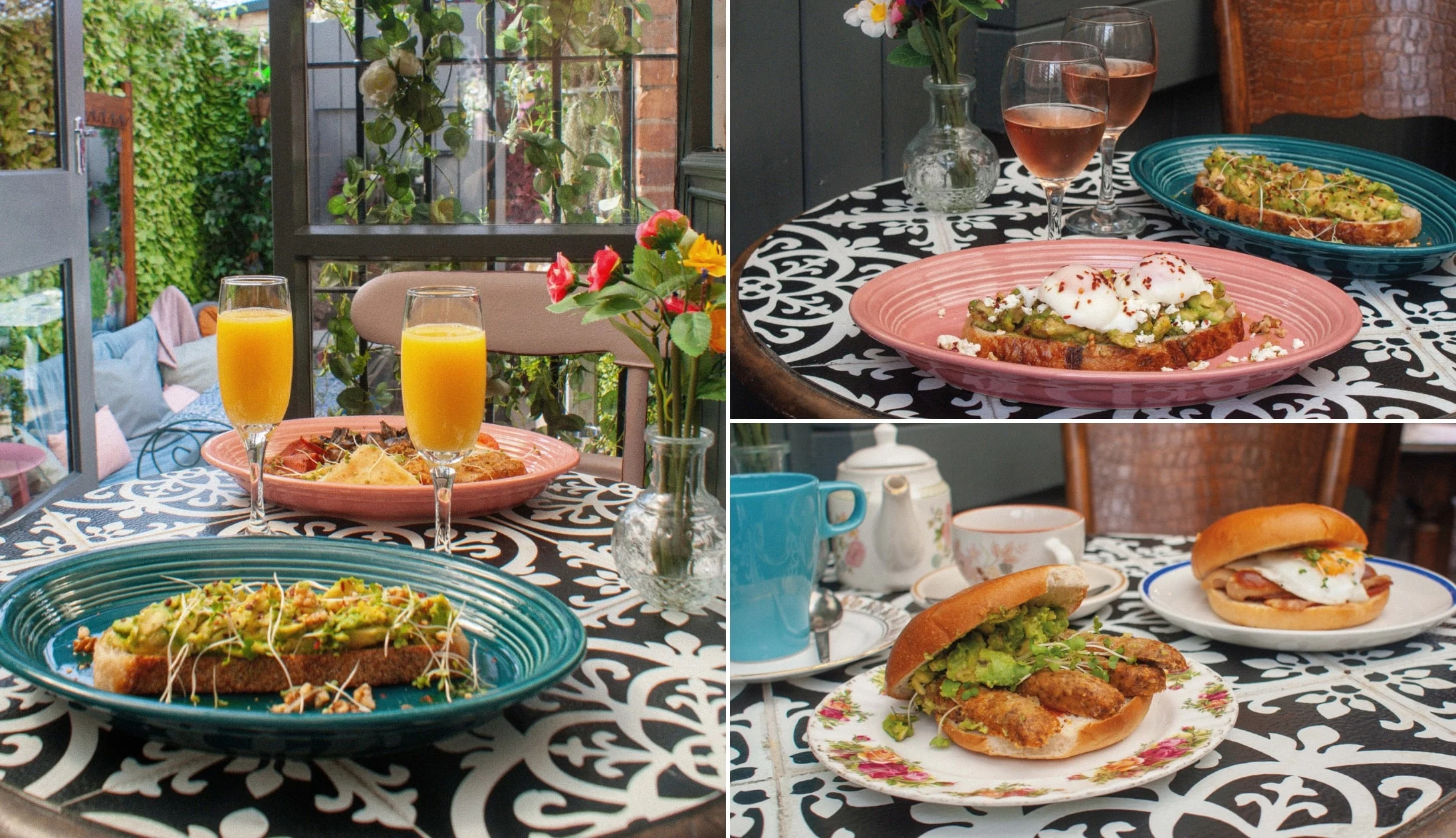
Photos via The Lamppost Cafe on FB
The Cathedral Quarter is the beating heart of Belfast, and there are plenty of great places to grab lunch. From Belfast Castle, it’s about a 16-minute drive, and you’ll find a number of handy pay and display car parks in the area, as well as paid street parking. Q-Park at Victoria Square is a good choice and is within walking distance of a variety of cafes, shops, and pubs. Alternatively, park up at your accommodation, then head back into town.
If you’re lucky enough to be in town on a Friday, Saturday, or Sunday, be sure to drop by St George’s Market. This vibrant marketplace boasts deliciously fresh produce and a wealth of arts and crafts. It’s also home to some great places to eat, serving up an array of dishes, from soup and seafood to foreign cuisine and pies. Alternatively, check out The Lamppost Cafe for some comforting home-cooked dishes, including a number of vegan options.
Stop 4: SS Nomadic
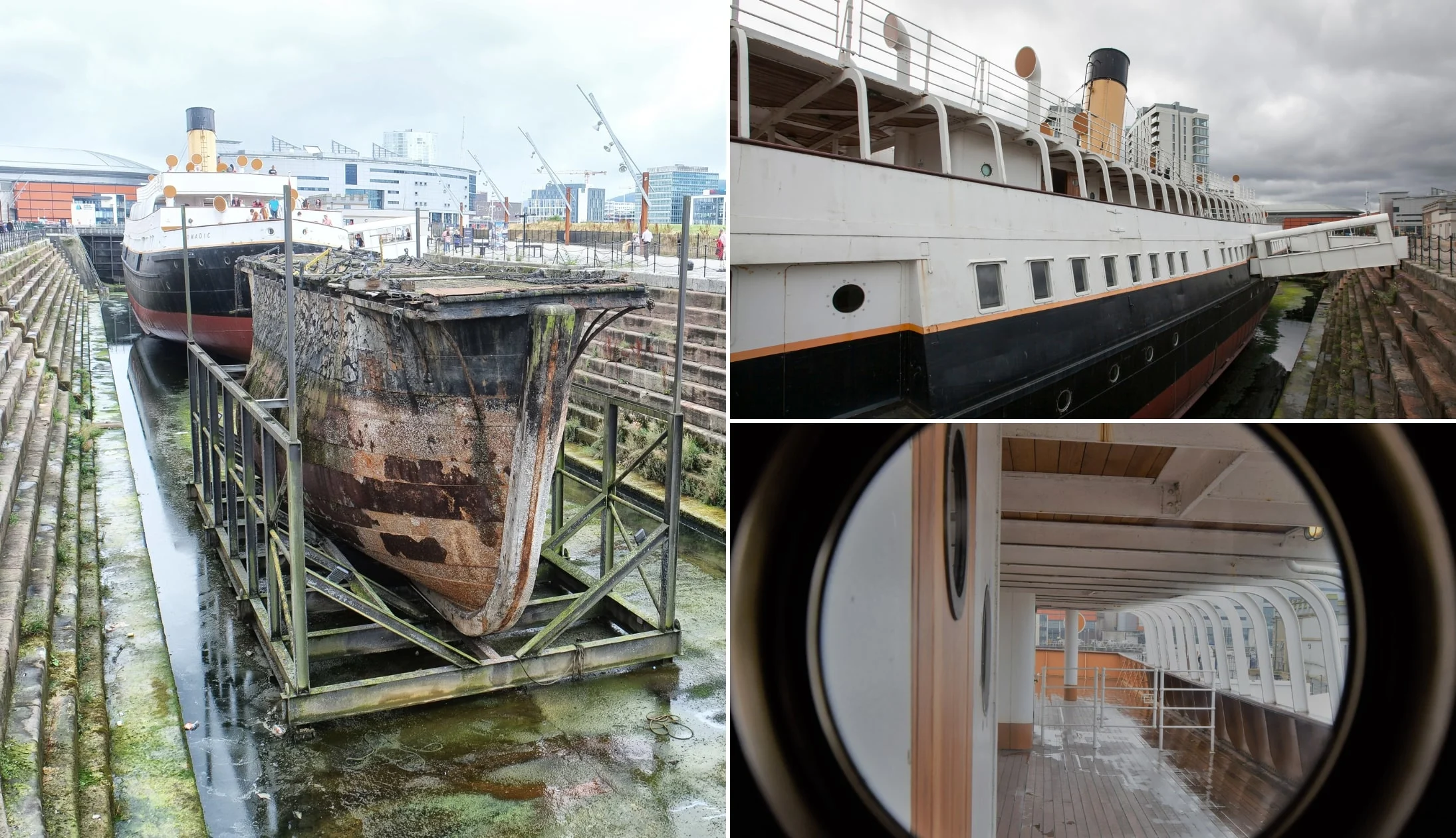
Photos via Shutterstock
After enjoying a tasty lunch, it’s a six-minute drive to our next stop, SS Nomadic. Or, if you don’t want to lose your parking spot, you can walk here from the Cathedral Quarter in around 20 minutes or so.
The SS Nomadic is moored at Hamilton Dock in the Titanic Quarter of Belfast and is part of the Titanic Experience, our next stop. Admission to the SS Nomadic is included in your ticket to the Titanic Experience, though you can pay an additional £10 for a guided tour.
SS Nomadic has a long and interesting history. Launched in 1911, it was originally used to ferry passengers onto cruise liners, including the Titanic. During the war, it served as a minesweeper in France. It’s a fascinating ship to walk around, and there’s loads to see along the way.
Stop 5: Titanic Experience

Photos by Chris Hill via Tourism Ireland
Just a 5-minute walk from SS Nomadic, the Titanic Experience is one of Belfast’s most popular attractions. Located right on the slipways where RMS Titanic was designed, built and launched, the enigmatic Titanic Museum tells the now-infamous story incredibly well. Visitors can expect exhibits, replica staterooms, photos, documents and 21st-century technology. You’ll see, hear and even SMELL the shipbuilding process during your tour!
Stop 6: Dinner, drinks, and call it a night

Photo left: Silvia Franceschetti (CC BY-SA 3.0). Others via Bittle’s Bar on FB
Drop your car off back at your accommodation if you didn’t already, freshen up and get ready to enjoy one last night in Belfast. Be sure to check out anything you’ve missed so far!
Our Belfast food recommendations
There’s some outstanding restaurants in Belfast City. First up, Deanes is a Belfast institution and a must-visit while you’re in the city. There are three venues to choose from, each focusing on something different; Deanes Meat Locker, Deanes Love Fish, and Deanes at Queens.
Whichever you choose, you’re in for a fine feed. EDO is another favourite of ours, a stunning tapas and cocktail bar with incredible sharing platters.
Or, for a fancy meal, head to The Ginger Bistro, near the Belfast Opera House. Their menu is out of this world, though that’s no surprise when you consider it was voted the best restaurant in Northern Ireland.
Our Belfast pub recommendations
There are countless incredible pubs and bars in Belfast for a tasty after-dinner tipple. Check out traditional options like the unmistakable Bittles Bar, with its stunning range of local beer and Irish whisky.
The Duke of York is another old-school boozer, walls adorned with knick-knacks from yesteryear and serving up a fine pint of Guinness.
Finally, we couldn’t forget Madden’s Bar, a cosy, traditional pub complete with a roaring wood-burning stove and a friendly atmosphere. Somewhat overlooked, it’s a hidden gem, beloved by those in the know!
Traditional musicians from across Ireland come to play at Kelly’s Cellars every Tuesday, Wednesday, Thursday, and Saturday.
Other fantastic options for music include Fibber Magees, another charmingly old-fashioned pub with a lively atmosphere, and the John Hewitt.
Day 18: The Causeway Coast
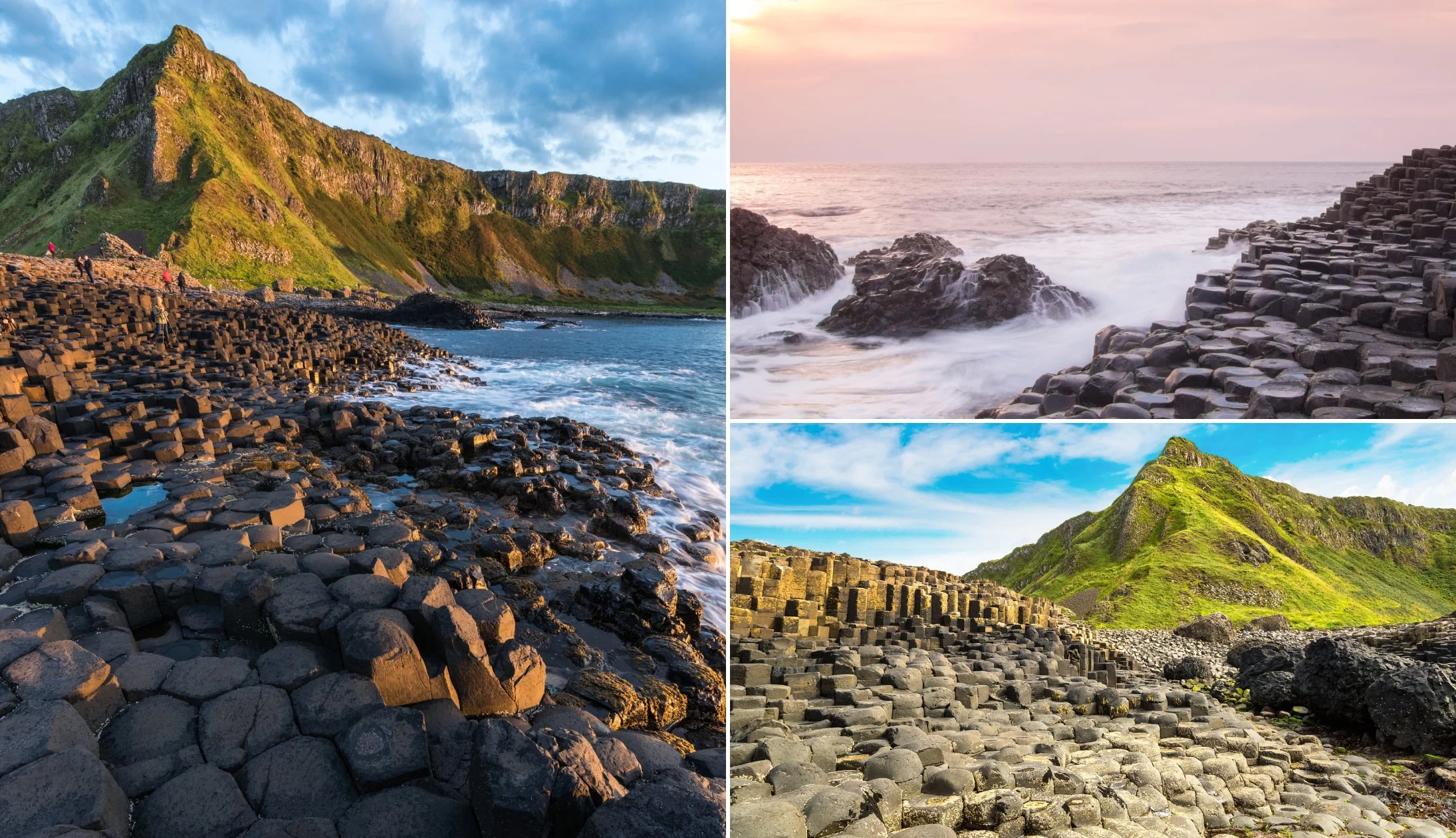
Photos via Shutterstock
Today we’ll be exploring the epic Causeway Coast, taking in a scattering of incredible attractions along the way, culminating in the incredible Giant’s Causeway.
Once you’ve taken in all the attractions of the coast, you’ll be driving on to the bustling town of Derry, where you’ll be spending two nights.
You’ve got an action-packed day ahead of you, so it’s a good idea to get a hearty breakfast in you before you start! Grab a full Irish or buffet breakfast at your accommodation, or head into town to check out one of the many superb cafes.
We’d heartily recommend the Lamppost Cafe on Newtownards Road for a slap-up cooked Irish breakfast—they also have a cooked vegan breakfast. Alternatively, check out the Grapevine in the Cathedral Quarter for porridge, bagels, baps, and breakfast burritos.
Our Derry accommodation recommendations
- Budget: Rose Park House (cosy, great reviews and a 20-minute walk from the centre) and Bishop Gate BnB (excellent reviews and a 10-minute walk from the city centre)
- Mid-range: Number 8 The Townhouse and Shipquay Boutique Hotel (both very central with top reviews)
- Luxury: Bishop’s Gate Hotel (gorgeous and central luxury accommodation)
Stop 1: Carrickfergus Castle
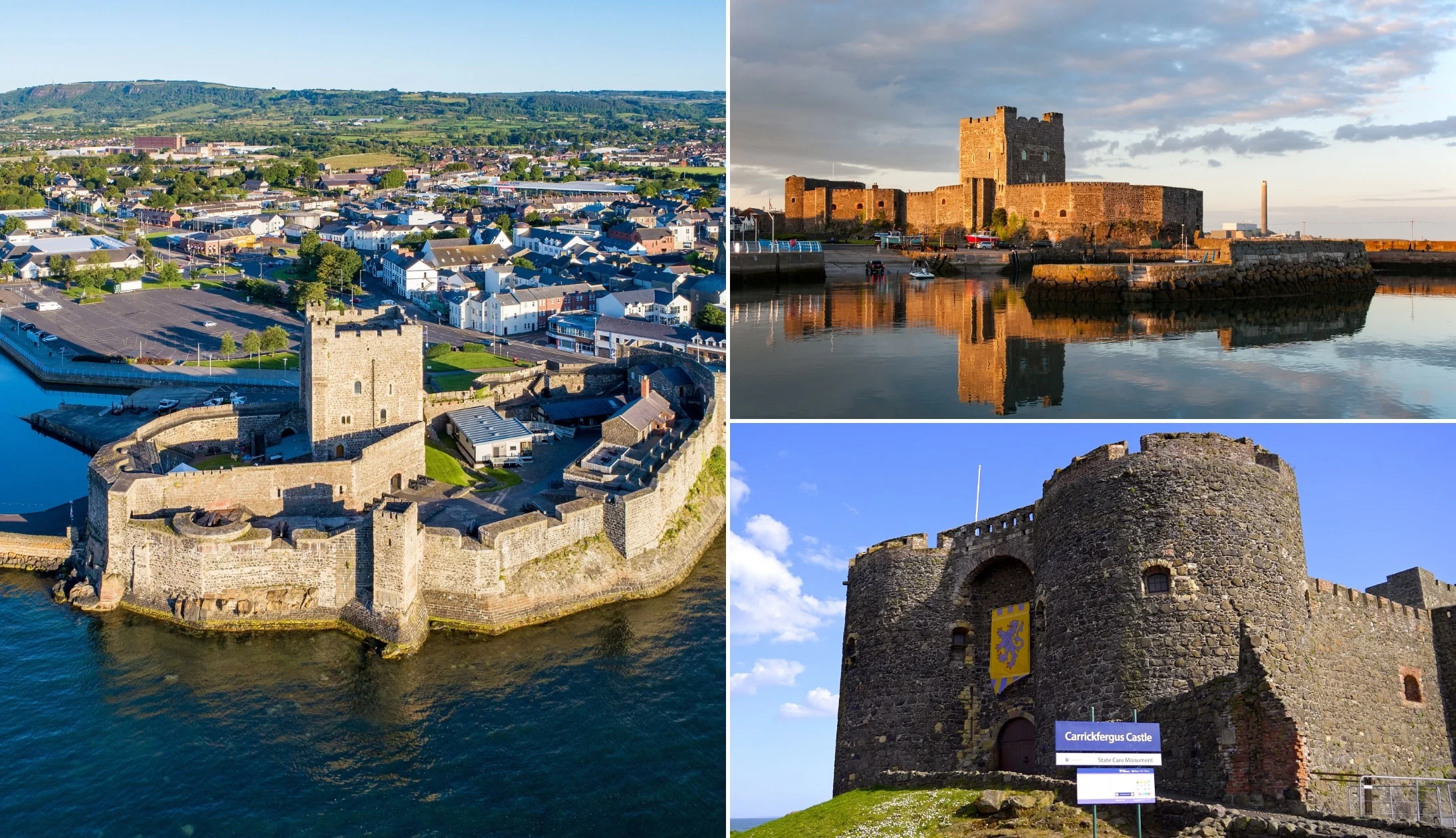
Photos via Shutterstock
Carrickfergus Castle is one of the most well-known and best-preserved castles in Ireland. It’s just a 23-minute drive from Belfast City Centre, making it an ideal first stop on your way to the Causeway Coast.
Dating back to the 12th Century, this epic fortress boasts huge walls that protect it from the sea, plus a number of mighty towers. It’s been the site of countless battles over the years, and it’s no surprise that it’s home to a ghost. The guided tour is well worth the ticket fee, although, with numerous information boards and displays, you can also enjoy a self-guided tour at your own pace.
There’s a large car park right next to the castle and the harbour. It’s free to use, has public toilets, and it’s just a short walk to the castle gates. If you fancy a little pick-me-up before you jump back in the car, NACS coffee shop is also nearby and they serve up a superb cup of coffee as well as cakes and snacks.
Stop 2: Whitehead Coastal Path – Blackhead Lighthouse
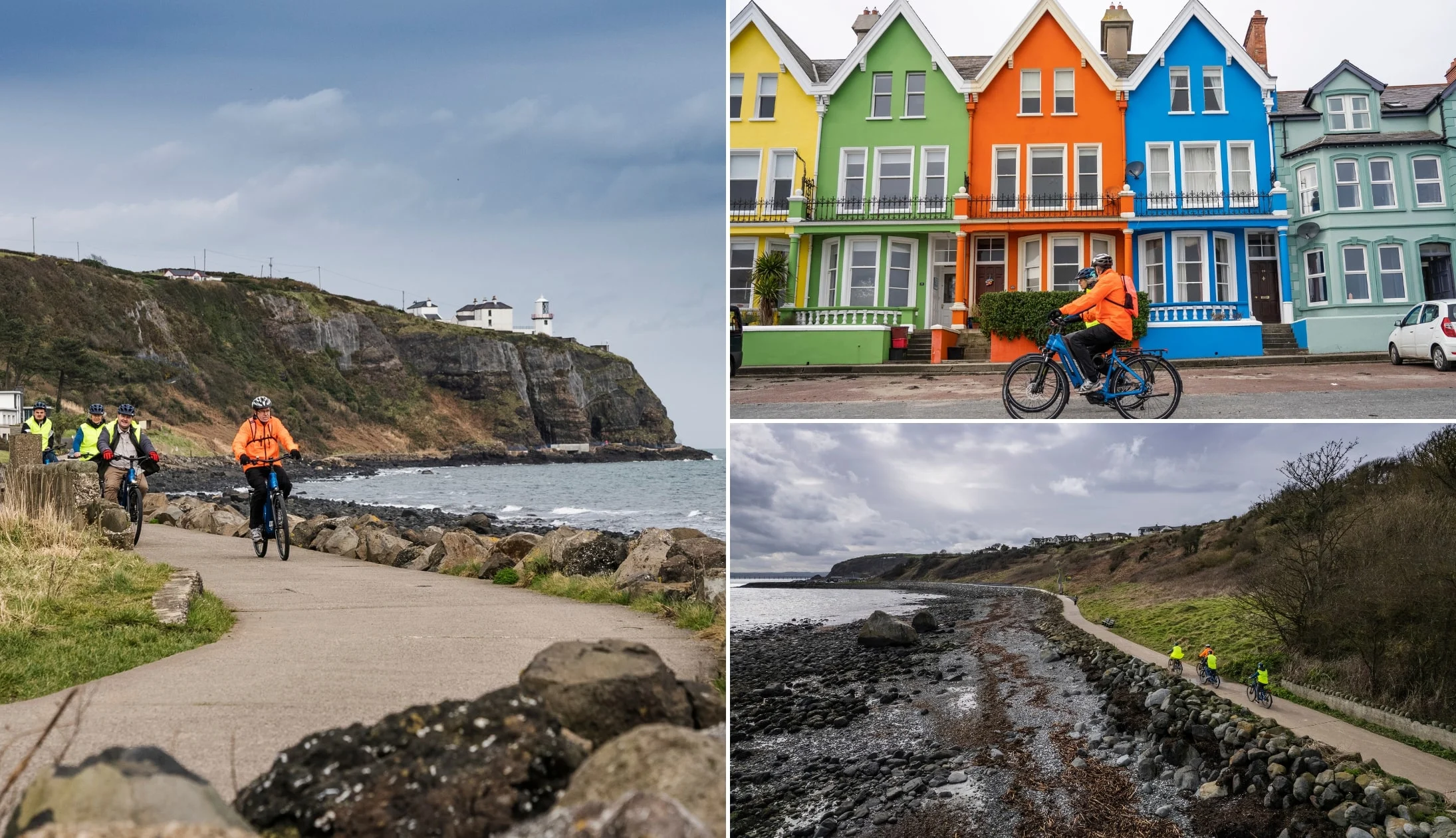
Courtesy of Mid and East Antrim council @grafters media
Stop number two is just 13 minutes away from Carrickfergus Castle and offers a nice, short walk along the beautiful coastline out towards Blackhead Lighthouse. It’s an excellent opportunity to stretch your legs and feel the sea breeze on your face while taking in the spectacular scenery. Looking out to sea, you might witness a pod of dolphins frolicking in the waves, seals, seabirds, and if you’re really lucky, the occasional minke whale.
As you amble along the coast, you’ll take in breathtaking sea caves before reaching the beautiful lighthouse. It’s a bit of a climb up there, with more than 100 steps, but it’s worth the effort for the views. Built in 1902, it has guided many famous ships in its time, including the Titanic.
The walk is about 5 km in total. Simply park up in the Whitehead Car Park and follow the paved track up to and around the lighthouse before returning back the same way.
Stop 3: The Black Arch
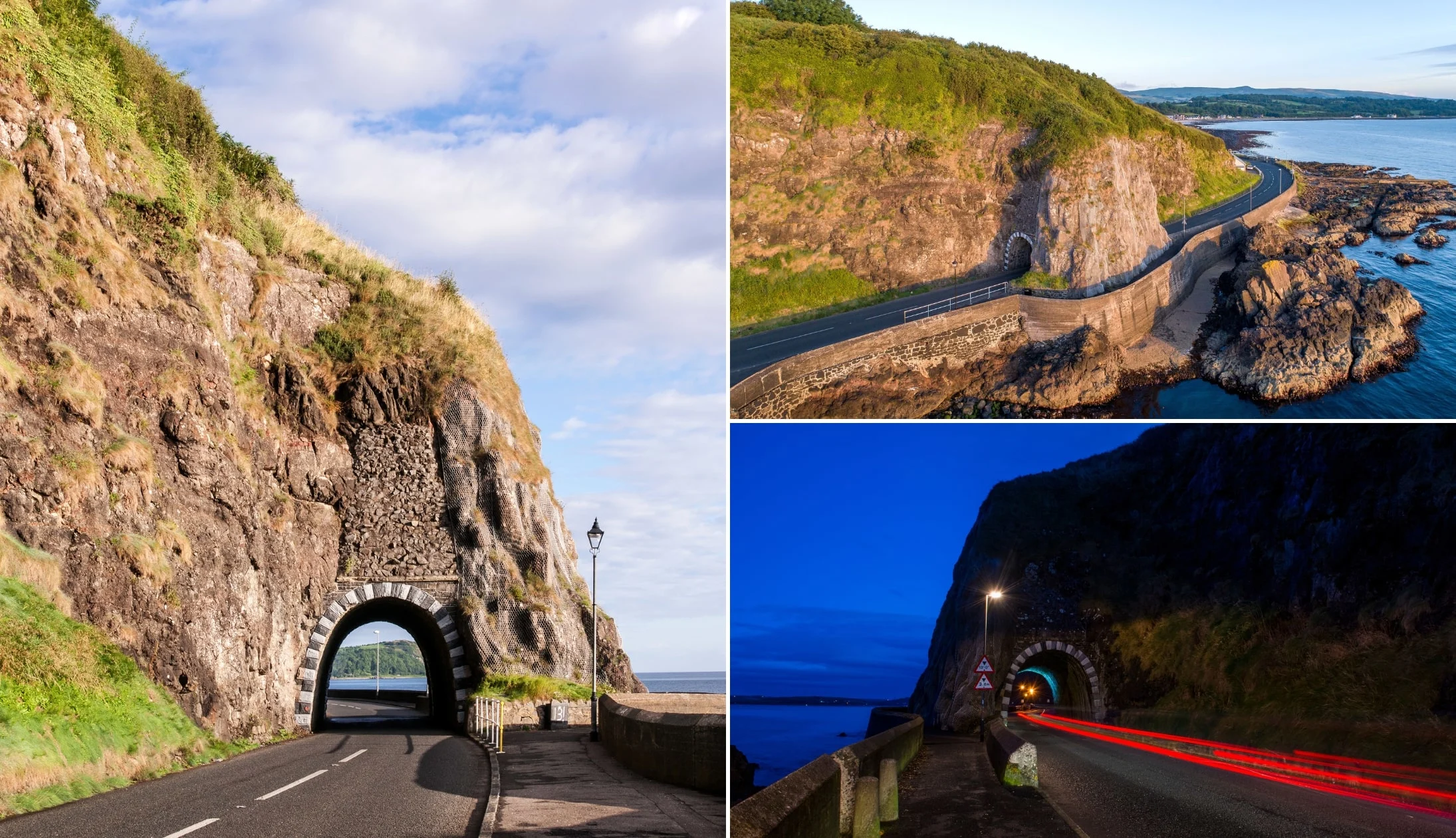
Photos via Shutterstock
The epic Black Arch isn’t really a stop in itself. It’s actually just a short tunnel that you’ll drive through as you cruise along the Antrim Coast Road. The road clings to the sea, with cliffs looming up on the other side.
As you approach Larne, about 23 minutes from the Whitehead Coastal Path, the craggy cliffs cross over the road, which tunnels through. It’s only short, but it looks pretty cool and is a popular spot for photographers.
Stop 4: Cushendun Beach
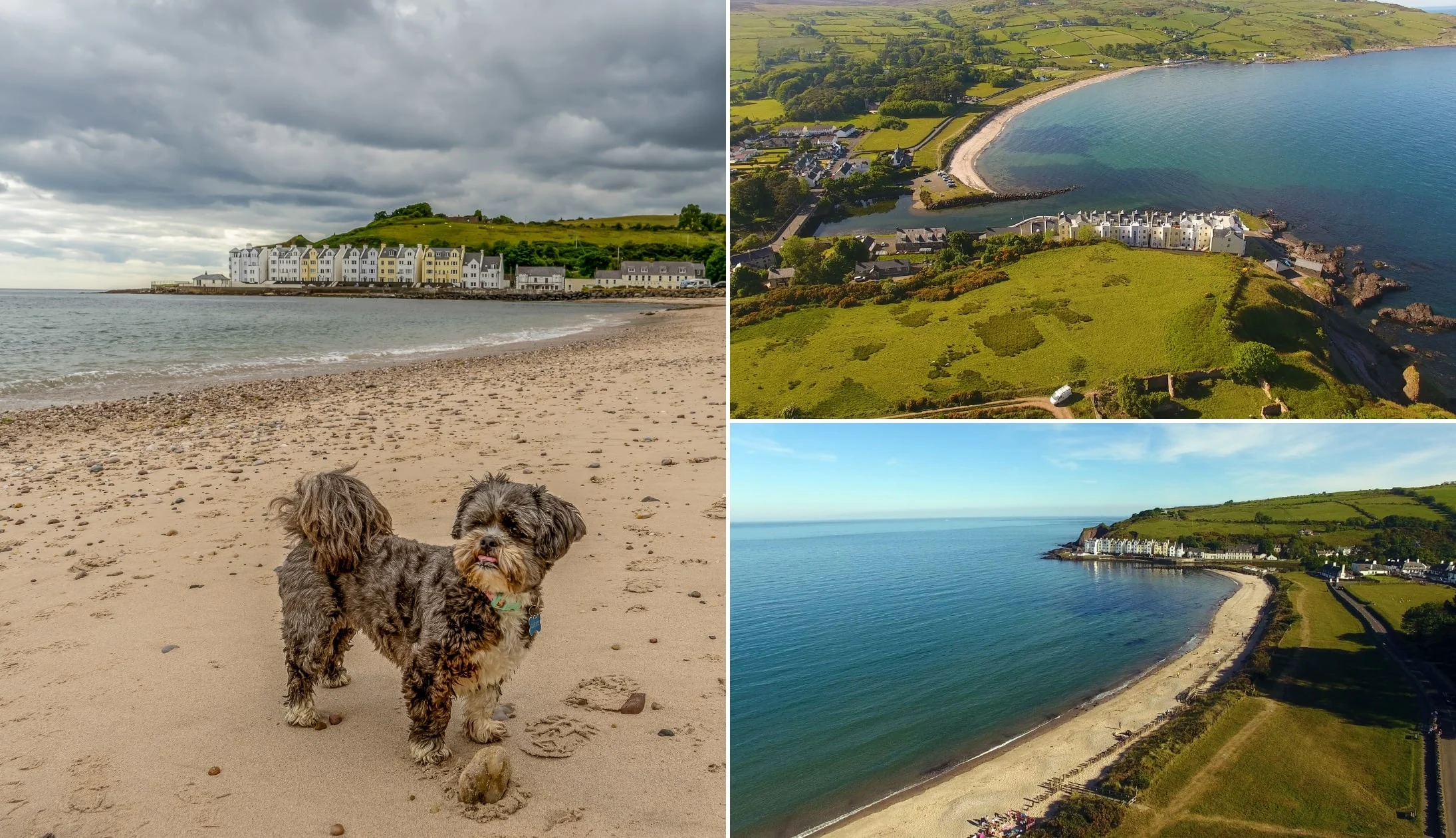
Photos via Shutterstock
The coast road is absolutely stunning between the Black Arch and your next stop, Cushendun Beach.
This lovely sandy bay is a fantastic place to relax and gaze out across the sea. On a clear day, you might even see the Scottish Coast.
If you fancy stretching your legs, it’s worth walking to the nearby Cushendun Caves, which are famous for appearing in the Game of Thrones series. Alternatively, there’s a 2km looped walk around the beach and village.
It’ll take about 48 minutes to reach Cushendun Beach from the Black Arch, and there’s plenty of free parking to be found, as well as public toilets.
Stop 5: Lunch in Ballycastle
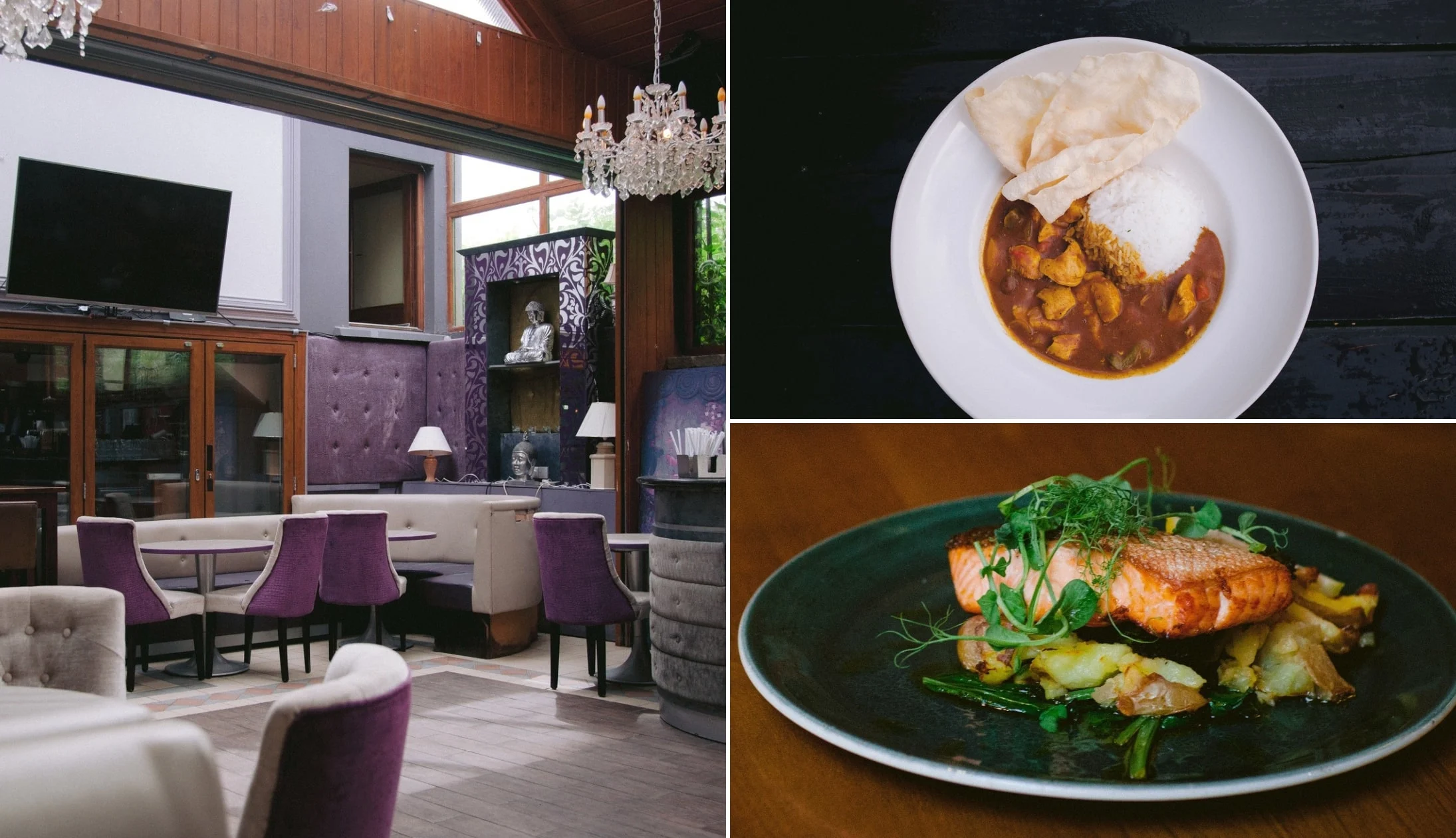
Photos via Central Bar Ballycastle on FB
After a short 22-minute drive from Cushendun Beach, you’ll arrive in the bustling seaside town of Ballycastle. The town boasts a gorgeous location, surrounded by sea, sand, mountains, and forests, and is ideally placed on the Antrim Coastal Route.
The former Viking settlement is a top spot for a bit of lunch too. Morton’s Fish and Chips is our favourite place for a bite to eat. It’s right on the harbour, with a small car park next to it.
The food is great, and on a fine day, there are few things better than sitting on the harbour wall watching the boats go by with a nice hot bag of fish and chips.
If you’re looking for something other than chipper food, check out the Central Bar. Their menu boasts a fine selection of fresh seafood, steaks, and much more.
Stop 6: Carrick-a-Rede
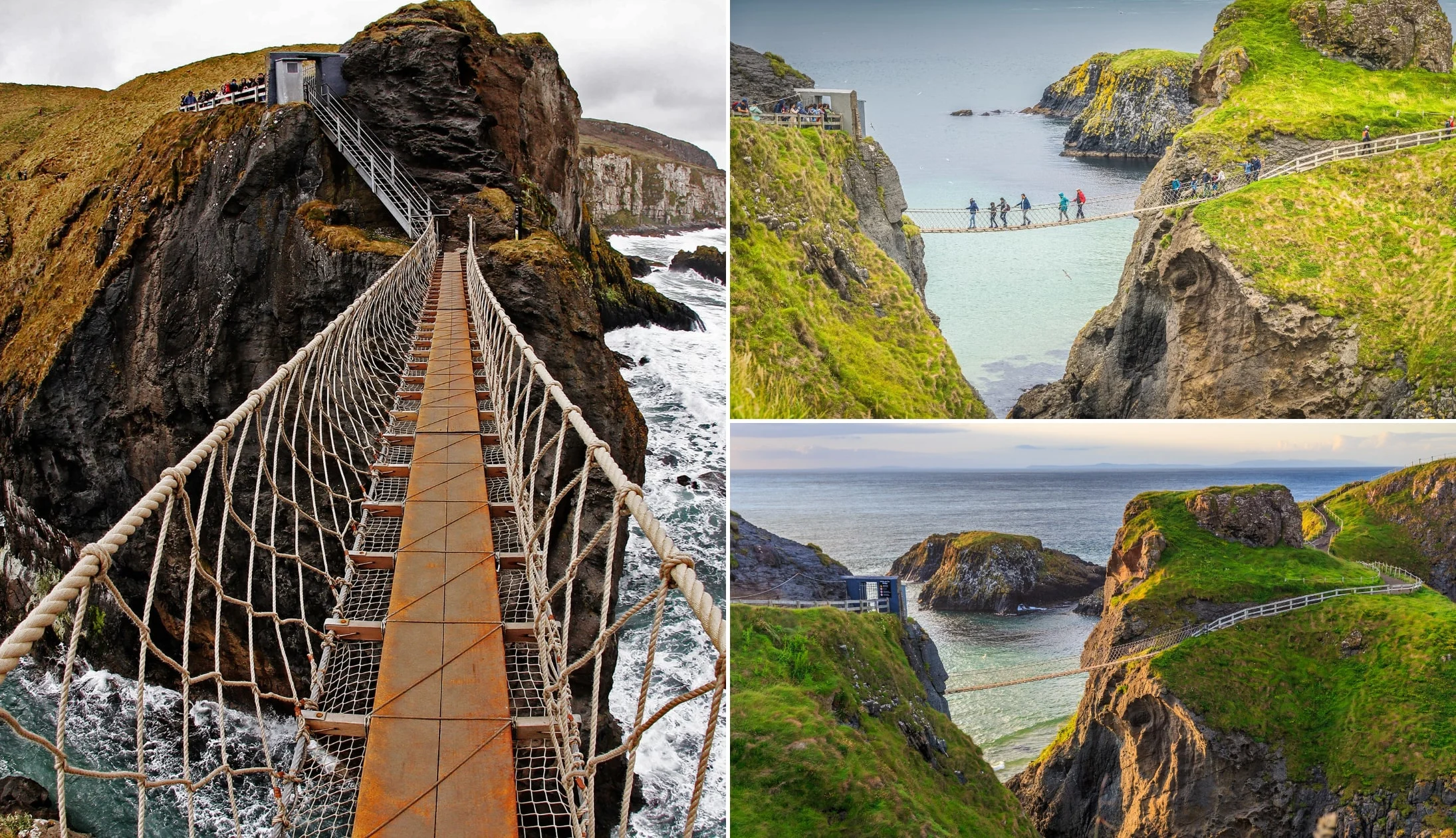
Photos via Shutterstock
The next stop is just 11 minutes outside of Ballycastle. Carrick-a-Rede is a small island just off the Causeway Coast. It’s attached to the mainland by an old rope bridge and was once a top spot for salmon fishing. Nowadays, you can enjoy a short coastal walk that culminates in crossing the bridge.
Swinging 25 feet above the sea as it crashes against the rocks below, it’s not great for those with a fear of heights! The entire walk will typically take an hour or so in total and offers spectacular views and a thrilling experience. We recommend checking the bridge out in the off-season rather than the height of summer, as it does get busy.
Stop 7: Giants Causeway

Photos via Shutterstock
After the dizzying heights of Carrick-a-Rede, you’ll arrive at the epic Giant’s Causeway in about 18 minutes. This legendary landscape boasts more than 40,000 basalt pillars, jutting proudly out from the sea.
In Irish folklore, the path was used by the hero Fionn Mac Cumhaill to get to Scotland, where he fought an enemy giant.
It was formed more than 60 million years ago and has been studied by geologists for more than 300 years, making it one of the most important and unique nature reserves on Earth. Now, parking at the Giant’s Causeway Visitor Centre is the most convenient but also extremely expensive. A more affordable alternative is to park at the nearby Causeway Coast Way Car Park and walk down.
You can easily spend a couple of hours at the Giant’s Causeway, especially if you do decide to check out the visitor centre. Just be advised it can be crazy busy on weekends and during the high season.
Stop 8: Bushmills
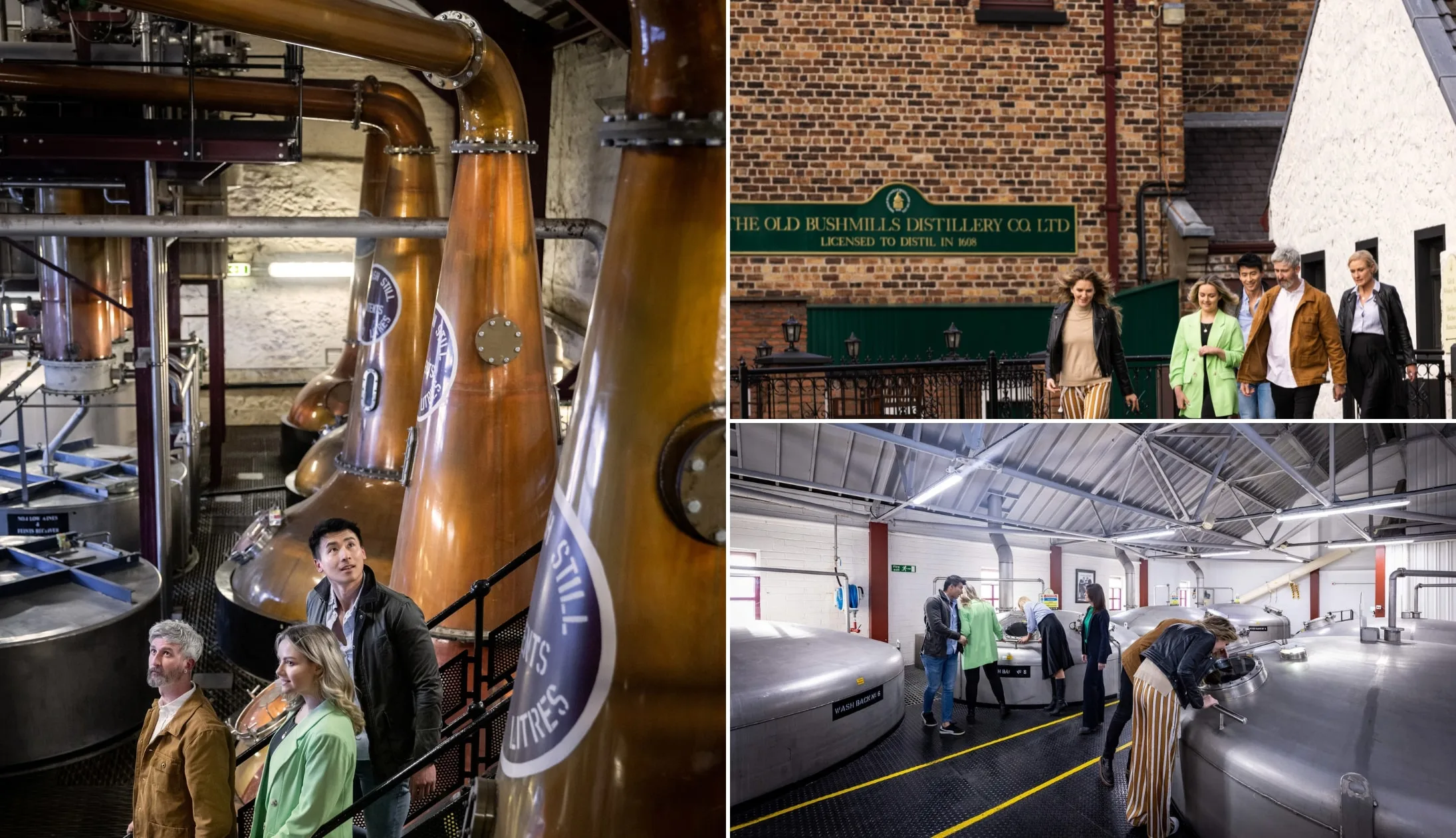
Photos courtesy of Tourism Northern Ireland
Once you’ve finished exploring the Giant’s Causeway, your next stop is just a quick 9-minute drive away. The small, riverside town of Bushmills is home to some great pubs and shops, and it’s a nice place to wander around.
However, the Bushmills Distillery is the highlight and well worth a visit. The oldest licensed distillery in the world, you don’t have to be a whiskey drinker to enjoy a tour of the facilities, though it doesn’t hurt if you do enjoy a wee dram every now and then!
Along the 40-minute tour, you’ll get a chance to see, smell, and hear how Irish whiskey is made in the company of a knowledgeable tour guide. The tours are a good laugh, culminating in a fantastic tasting session. Having said that, it’s better to take some samples with you if you’re driving.
Stop 9: Dunluce Castle
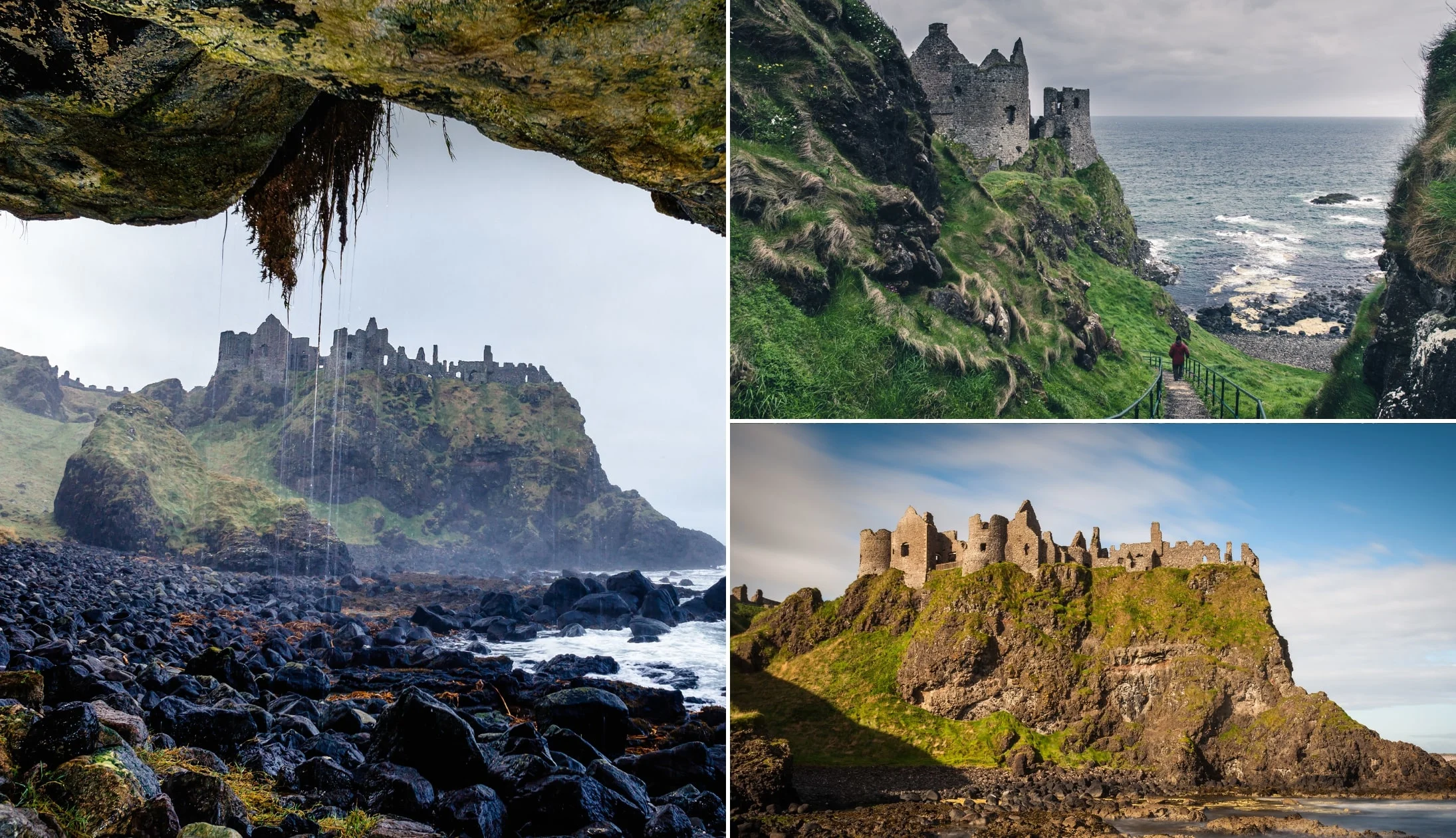
Photos via Shutterstock
Our final stop for the day before heading to Derry is the legendary Dunluce Castle. It’s just a 7-minute drive from Bushmills, and a wander around the castle ruins is well worth it. Dunluce Castle dates back to the 1500s and is rich in history.
Of course, there are several legends, most notably the Dunluce Banshee, whose wails and screams are said to haunt the Northeast Tower. It’s another top spot for Game of Thrones fans, too—the castle served as the Greyjoy fortress on the Iron Isles.
You can enjoy a guided or self-guided tour of the grounds, or if you prefer not to go in, you can enjoy viewing it from afar at a nearby viewpoint.
Stop 10: Head to Derry
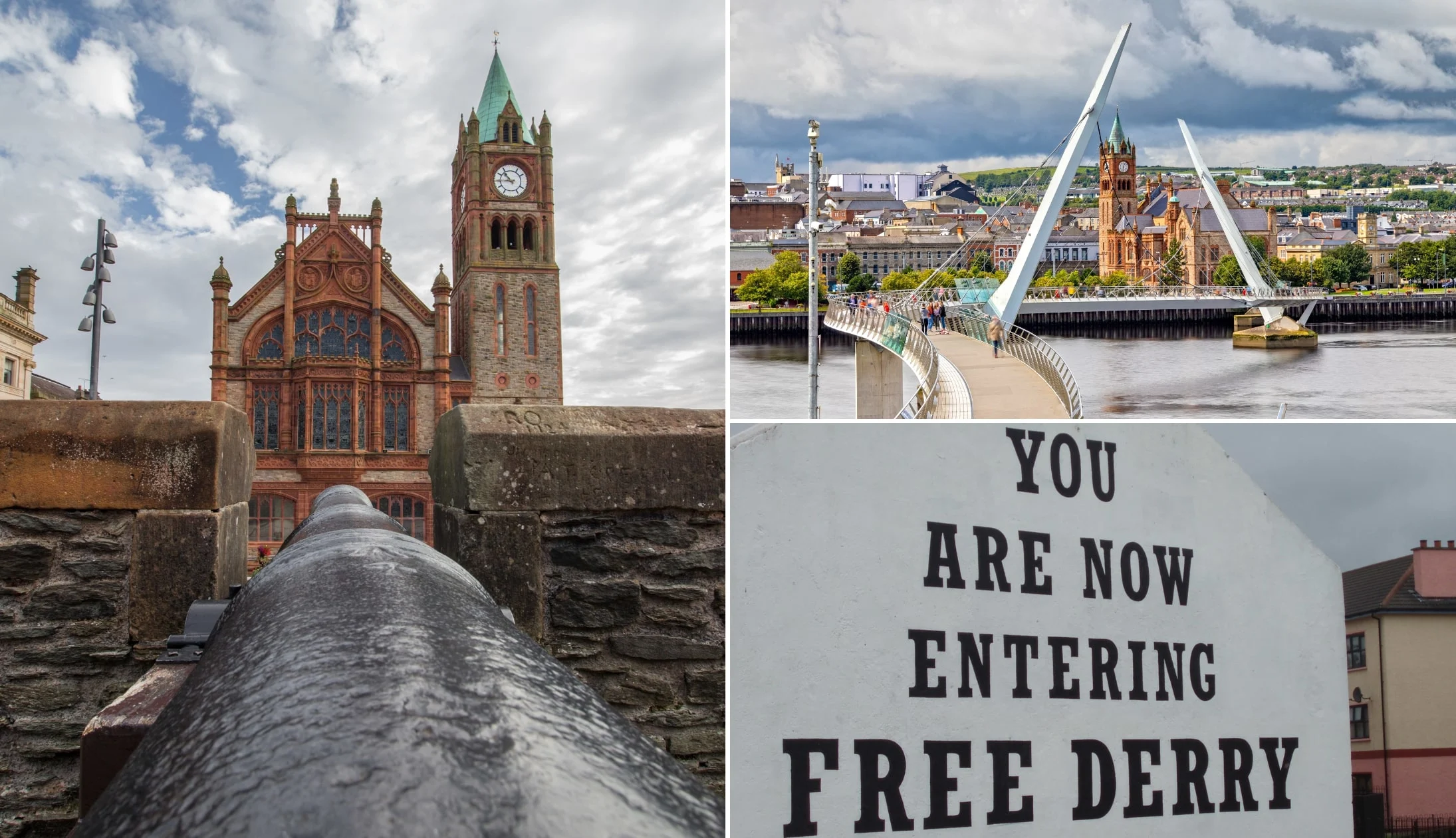
Photos via Shutterstock
That’s all for today’s attractions, so now it’s on to Derry. The drive should take about an hour. Once you arrive, check in, freshen up, and then head into town to discover the delights of Derry.
Stop 11: Dinner, drinks and call it a night
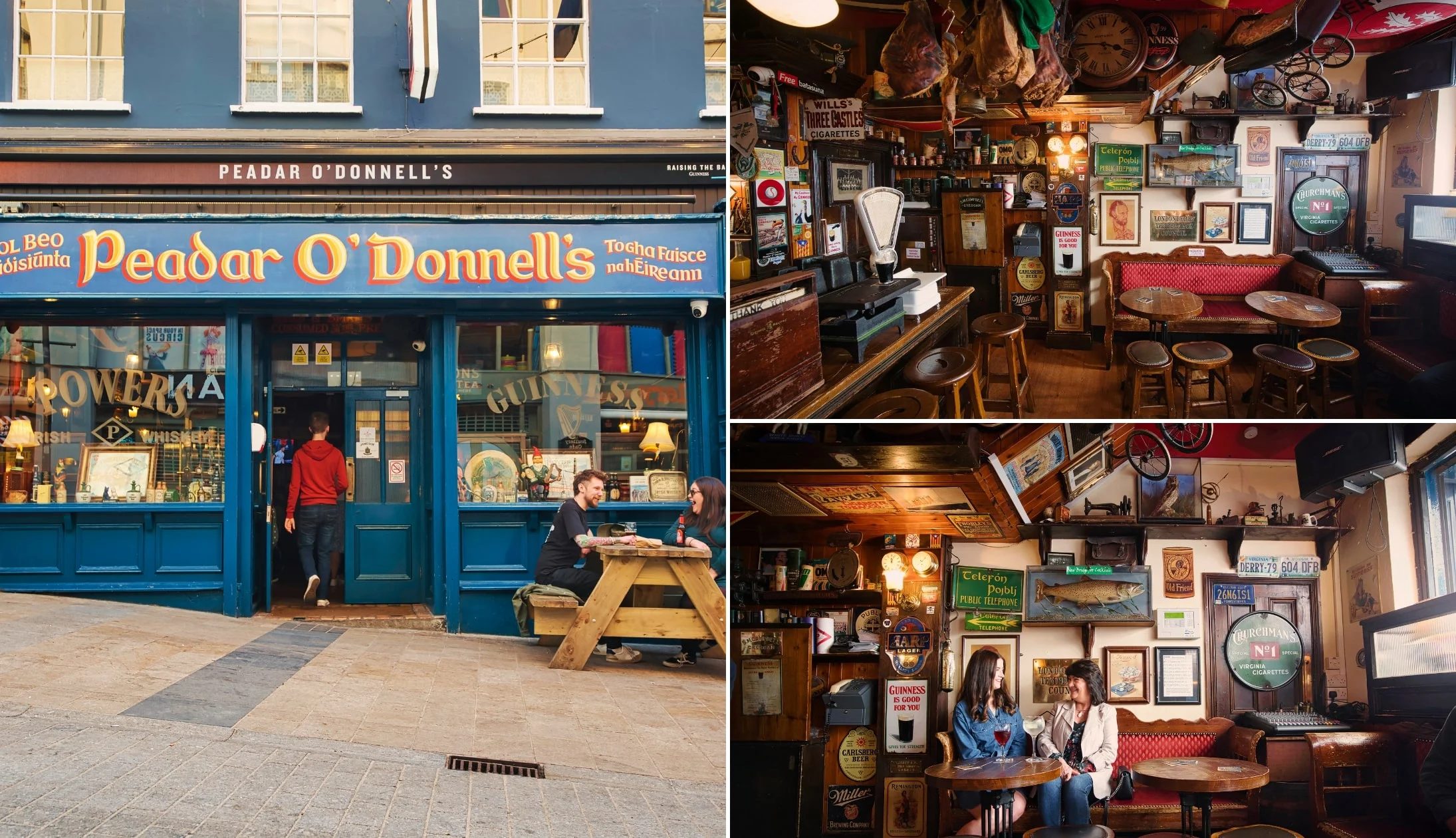
Photos courtesy of Tourism Northern Ireland
You’ll find no end of excellent pubs and restaurants to enjoy in the bustling Derry city centre.
Our Derry food recommendations
There’s no shortage of great places to eat out in Derry. Ship’s Quay is a good choice for dinner, with a larger, more varied menu.
If you’re up for a little fine dining, Browns Bonds Hill is a good choice, with a seasonal menu of beautifully cooked and presented dishes.
For a more laid-back feed, drop by Badgers Bar and Restaurant (check out the Derry Girls Mural on the back wall if you haven’t already!).
Our Derry pub recommendations
Whenever we’re in Derry, we try to drop by Walled City Brewery. It’s a fantastic little brewpub that offers a range of gorgeous beers, mostly brewed on-site.
For a more traditional pub experience, get down to Blackbird, where you’ll find retro decor and a superb gin and whisky selection, as well as cocktails, craft beers, and much more.
Grand Central Bar is another good choice, a cosy little old-school bar with excellent Guinness and regular impromptu trad sessions.
First of all, check out the Dungloe Bar, considered by many to be the best in the city for music. Peader O’Donnel’s is also worth a shot, a quirky and lively bar with live music every Saturday. Right next door, you’ll find The Gweedore Bar, which also does excellent live music on the weekends.
Day 19: Inishowen Peninsula
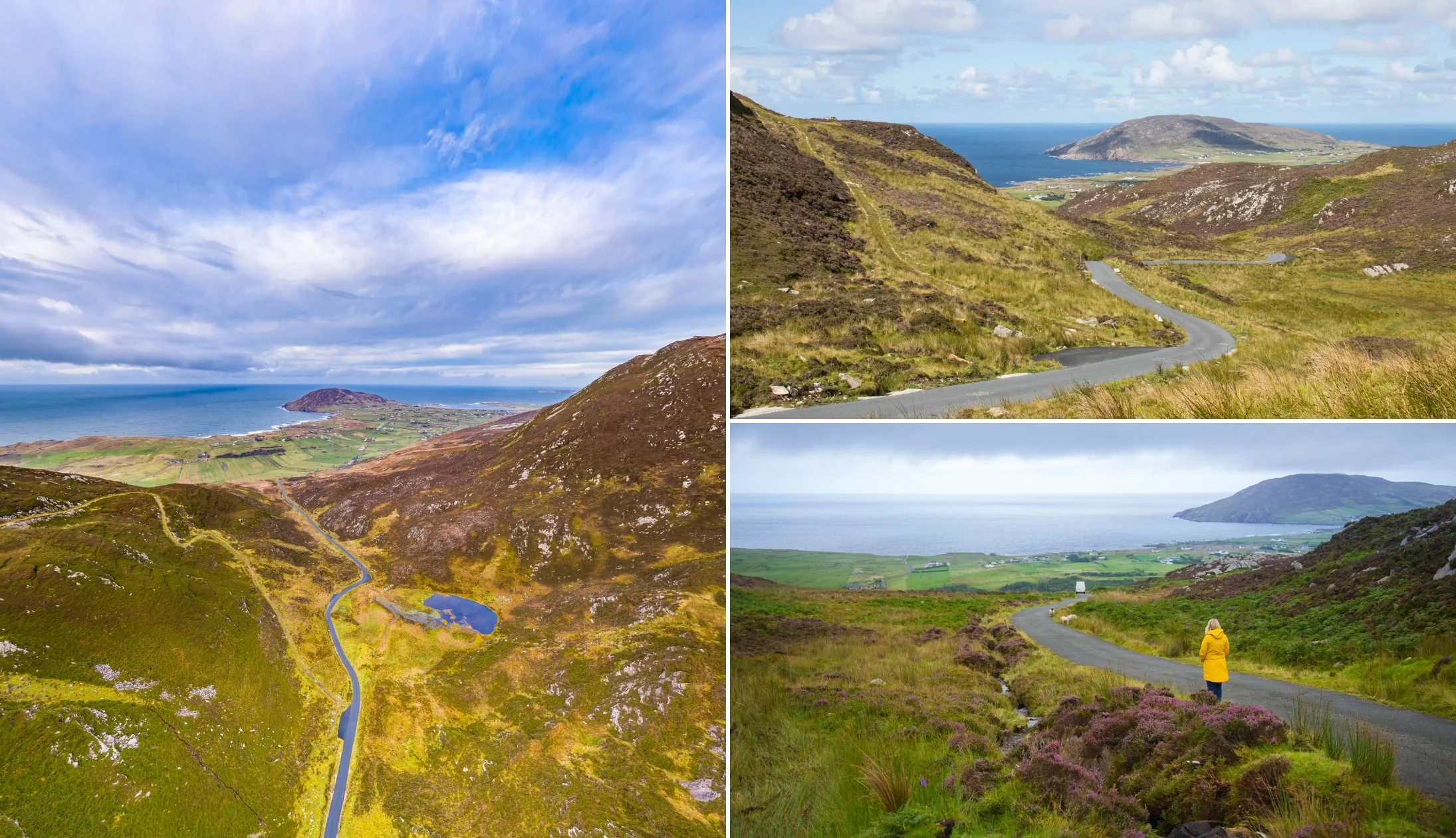
Photos via Shutterstock
Today we’ll be hopping over the border into the Republic of Ireland as we explore the stunning Inishowen Peninsula.
The drive today, known as the Inishowen 100, will take you all the way to Ireland’s most northerly point, taking in a clatter of superb attractions along the way.
Once you’ve seen everything, you’ll take a gorgeously scenic road back to Derry for your final night in the town.
Let’s start the day right with a slap-up breakfast. Most places you’ll stay offer a good breakfast, but if you prefer to eat out, check out the Scullery Cafe in the town centre for a fabulous Full Irish.
Hidden City Cafe is another top choice, and while they also offer a great fry-up, you’ll find several lighter options too.
Stop 1: Greenan Mountain or Grianan of Aileach
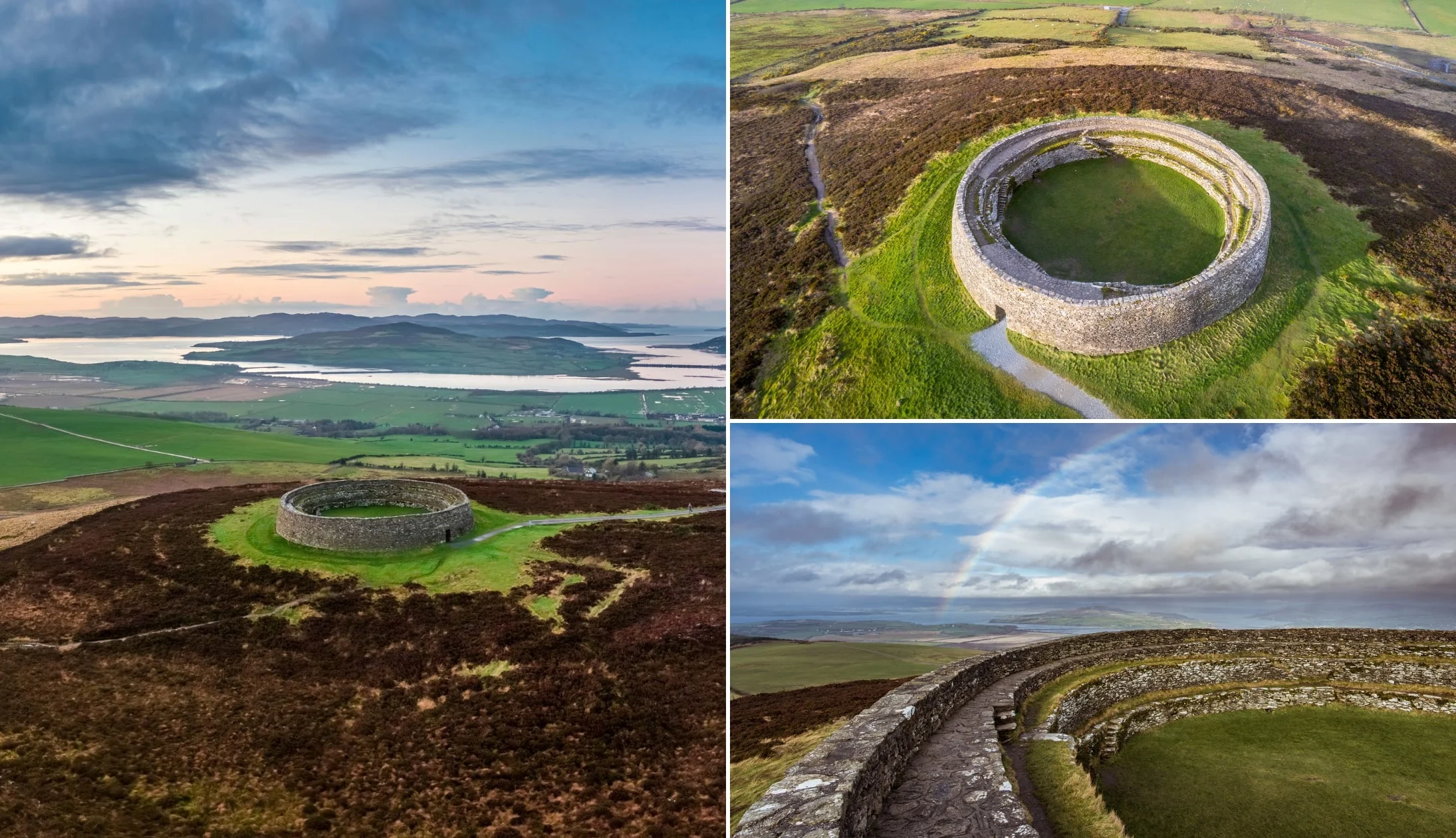
Photos via Shutterstock
Our first stop of the day is Greenan Mountain, otherwise known as Grianan of Aileach or An Grianan Fort. It’s just 22 minutes outside of Derry, and there’s a small but handy car park at the top of the hill. From there, it’s just a short, though somewhat challenging, walk to one of the most impressive Hill Forts in Ireland.
Dating back to 1700 BC, the fort is steeped in history and myth. It’s free to enter and offers stunning views of the surrounding landscape, which takes in Lough Foyle and Lough Swilly, as well as Inch Island, a favourite among photographers.
It gets pretty wild and windy up there, so be sure to dress suitably! By the way, welcome to the Republic of Ireland!
Stop 2: Buncrana Beach
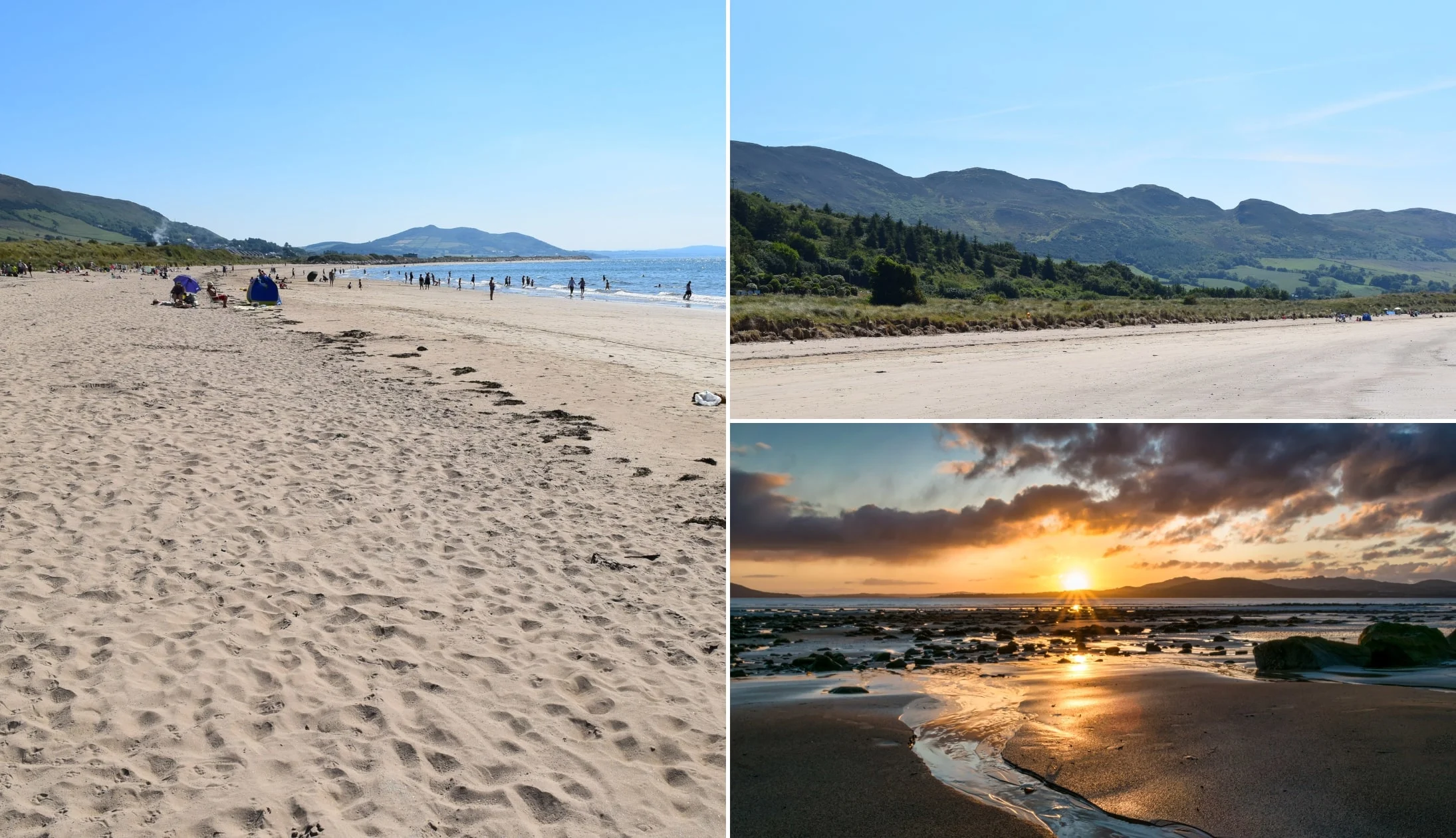
Photos via Shutterstock
After a nice bumble on Greenan Mountain, our next stop is the wonderful Buncrana Beach. Well, there are actually several beautiful beaches here, situated on the shores of Lough Swilly. The main Buncrana Beach boasts a long sandy expanse, ideal for a nice stroll amid some stunning scenery. It’s about a 19-minute drive from Greenan Mountain.
Stop 3: Fort Dunree
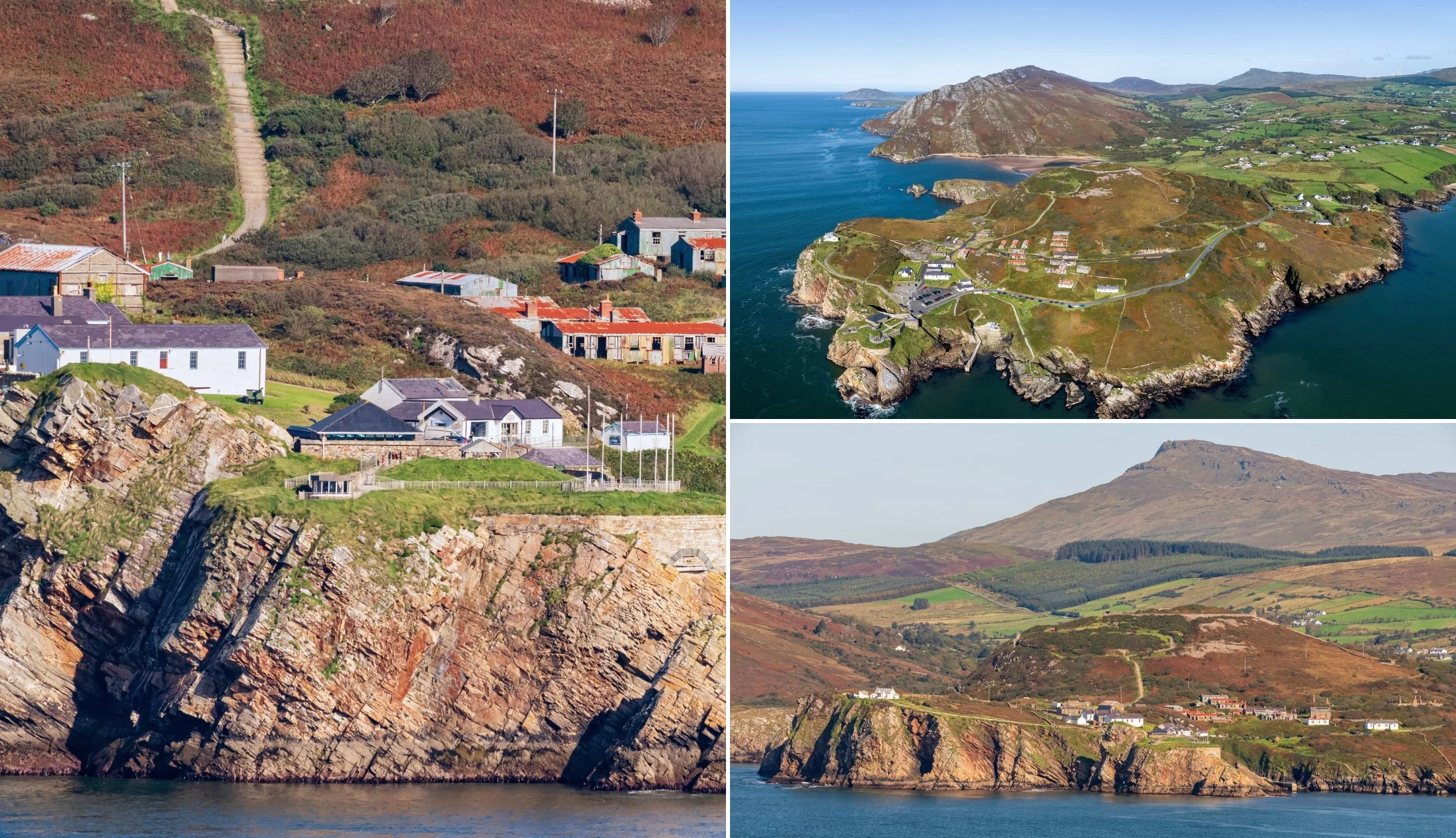
Photos via Shutterstock
Our next stop takes us to Fort Dunree, about an 18-minute drive away from Buncrana Beach. Perched on the western edge of the Inishowen Peninsula, it was built in the early 1800s to protect the entrance into Lough Swilly during the Napoleonic wars. It’s a fascinating place to explore, complete with Ireland’s first funicular railway, a glass walkway, and a military museum.
Stop 4: Glenevin Waterfall
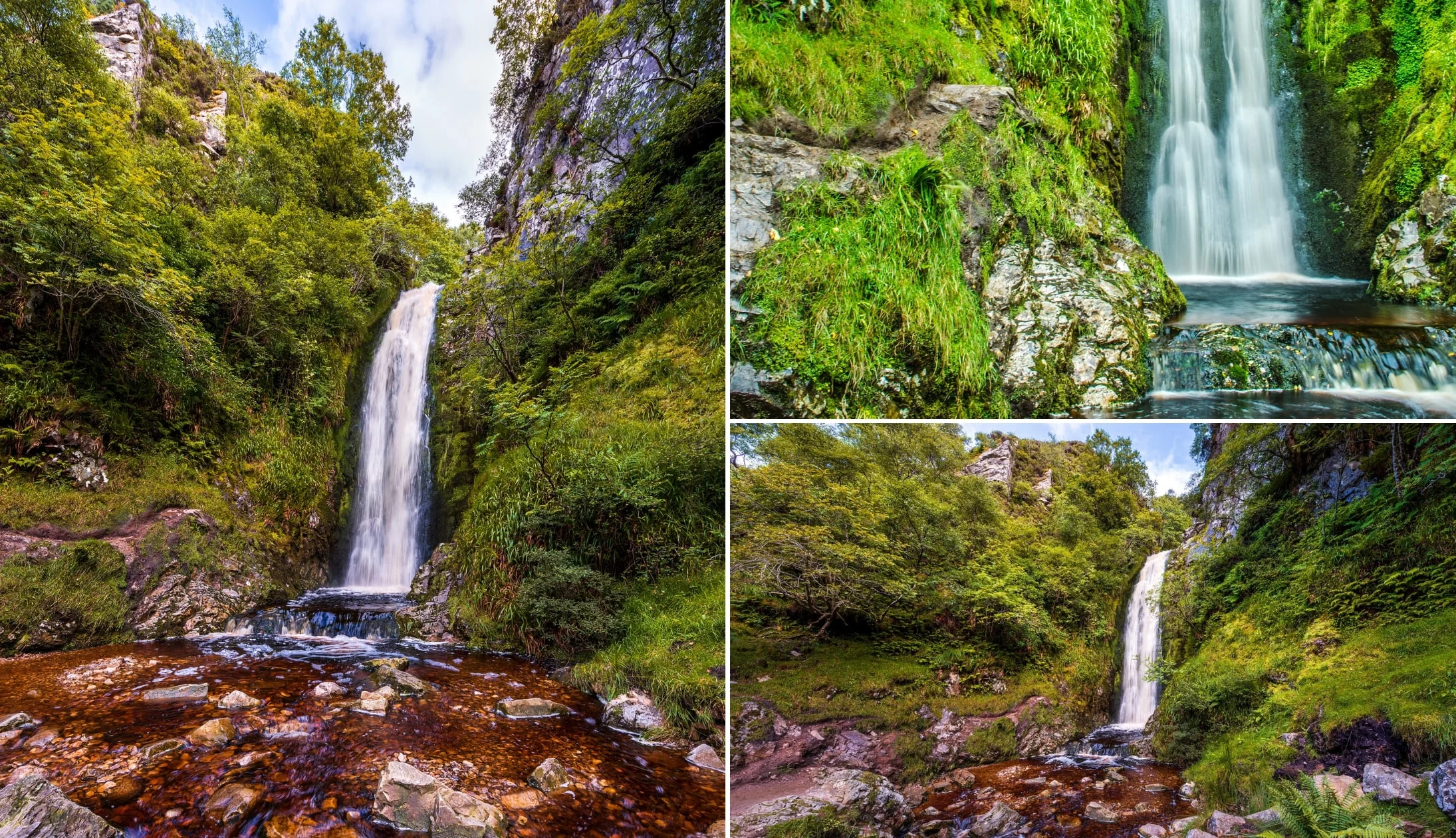
Photo left and bottom right: Gareth Wray. Top right: Shutterstock
After exploring Fort Dunree, we’ll drive another 20 minutes to Glenevin Waterfall. This gorgeous 40-foot cascade is a hidden gem in the Donegal countryside, and there’s a superb walk through beautiful scenery to get to it. You can park in a small car park just off the main road in Clonmany, and from there, it’s easy enough to follow the well-marked Waterfall Walk trail. It’ll typically take an hour or so to complete the walk both ways.
Stop 5: Doagh Famine Village

Our next stop is the Doagh Famine Village, a unique attraction that offers a fascinating look back at over 200 years’ worth of Irish history. With gorgeous thatched cottages and a variety of displays and exhibits, you’ll find plenty to look at. The village gives an insight into how life was lived in this remote corner of Ireland for hundreds of years. At times harrowing, it’s an emotional journey that’ll teach you more about Irish history and customs in its 40-minute tour than any amount of reading online.
The village is just a 14-minute drive from Glenevin Waterfall. It’s worth noting, however, that it’s only open between mid-March and mid-October.
Stop 6: Lunch
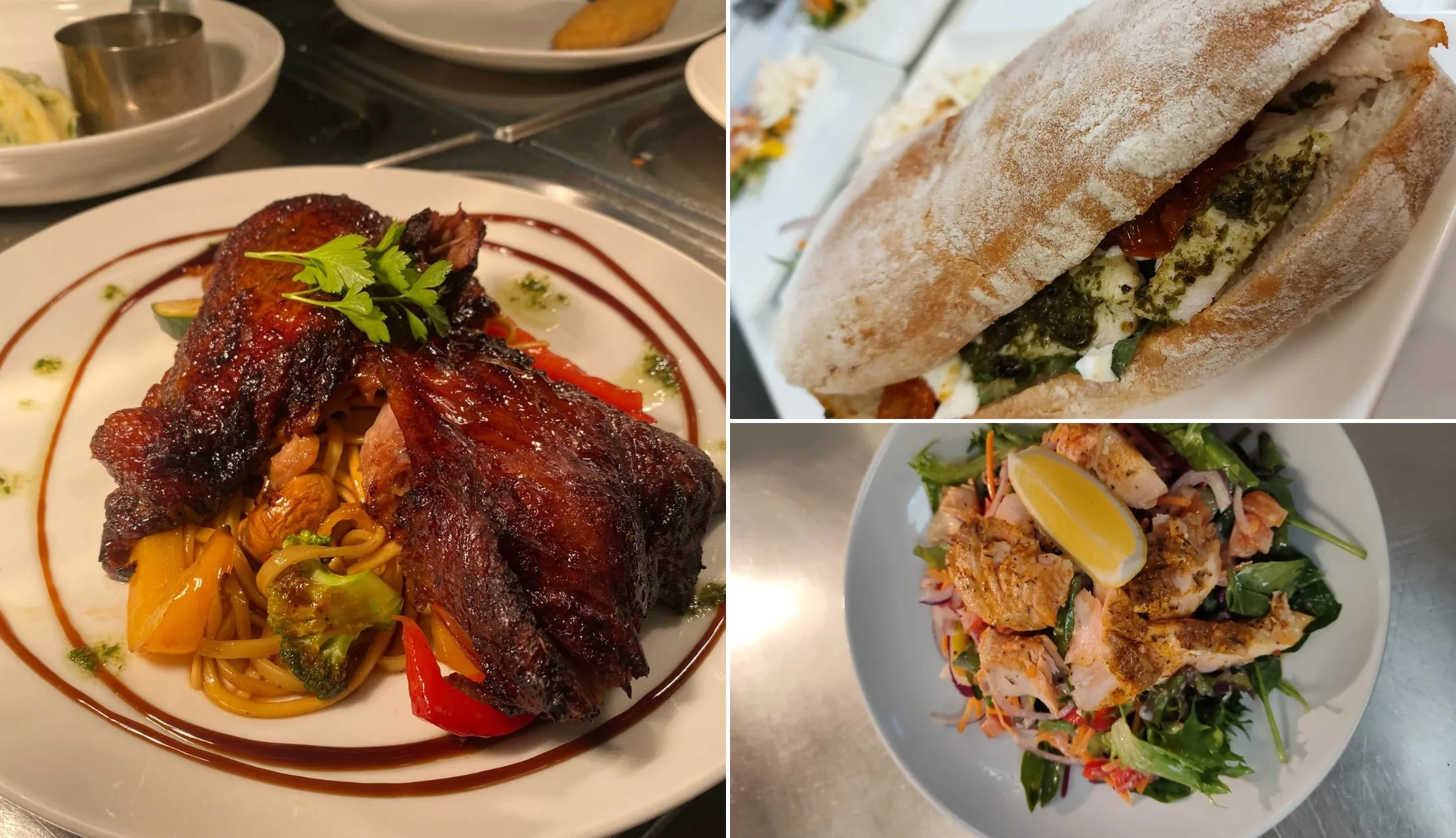
Photos via The Butterbean Restaurant on FB
It’s been a fairly action-packed morning, so you’ll be more than ready for a bite to eat. Drive the 16-minute road to the bustling village of Carndonagh, where you’ll find plenty of fantastic options. The Butterbean is one of our top picks, and they offer a varied menu of Irish classics, sumptuous burgers, and seafood.
For something a little lighter, you can grab a tasty bowl of soup and a sandwich at Diamond Cafe, which also does a range of cakes, baps, and much more. Harkins is another top choice for a cafe lunch.
Stop 7: Malin Head
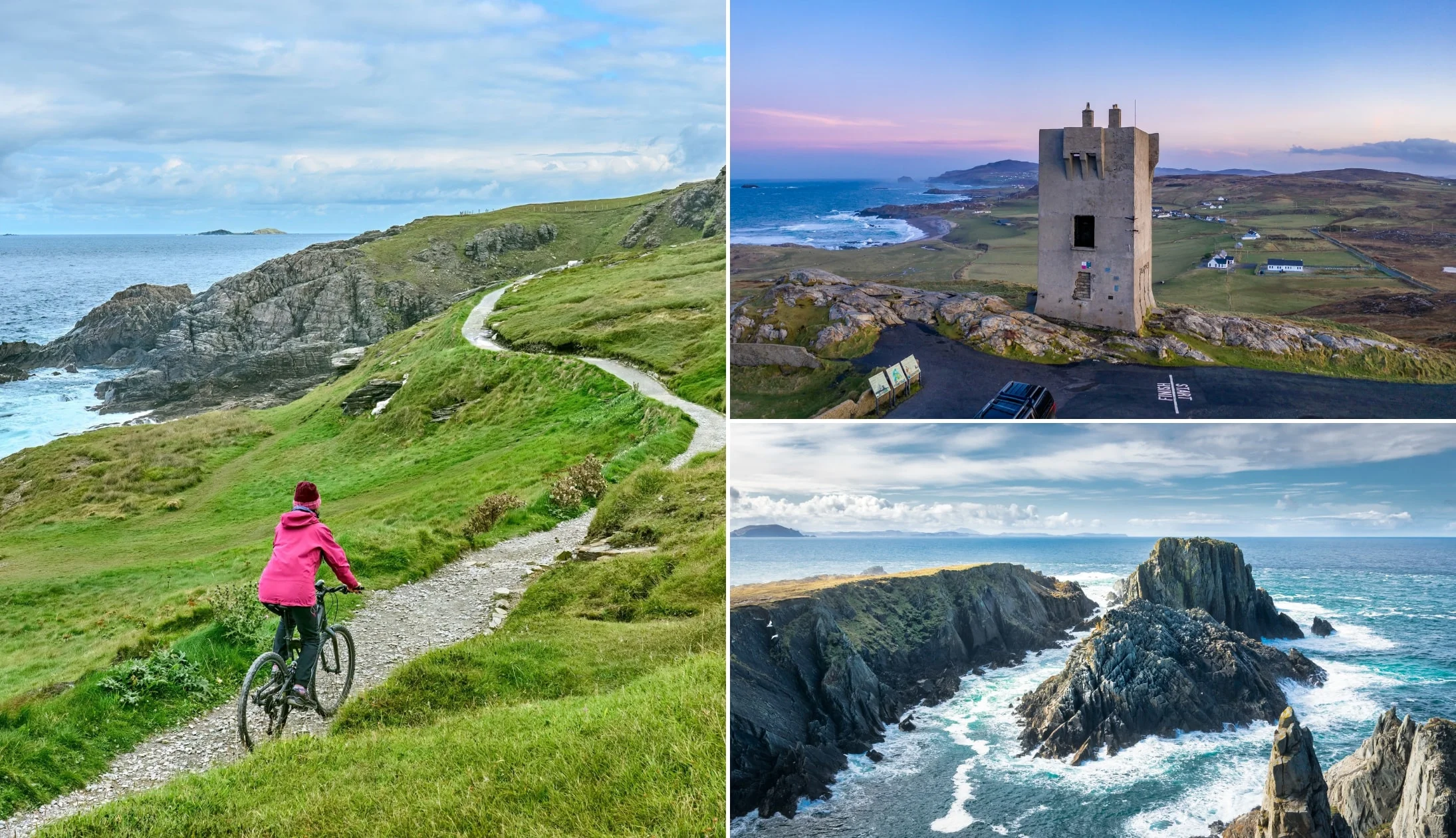
Photos via Shutterstock
After a good feed, it’s time to head north to Malin Head. In fact, you can’t get any further north than this, the most northerly point on the island of Ireland. From Carndonagh, it’s about a 25-minute drive and you’ll find a decent little car park, complete with toilets, and a little way up the road, the Cafe Banba coffee van.
The best way to explore Malin Head is to do the Malin Head Walk, a moderate hour-long stroll that takes in all the main points of interest. It’s just under a kilometre long in total and starts off at the car park. From there, you’ll take in Lloyds Signal Tower, the EIRE 80 sign, and the epic Hells Hole, as well as catching an eyeful of gorgeous natural beauty. When you’re done, it’s worth dropping into Farren’s Bar for refreshments.
Stop 8: Kinnagoe Bay
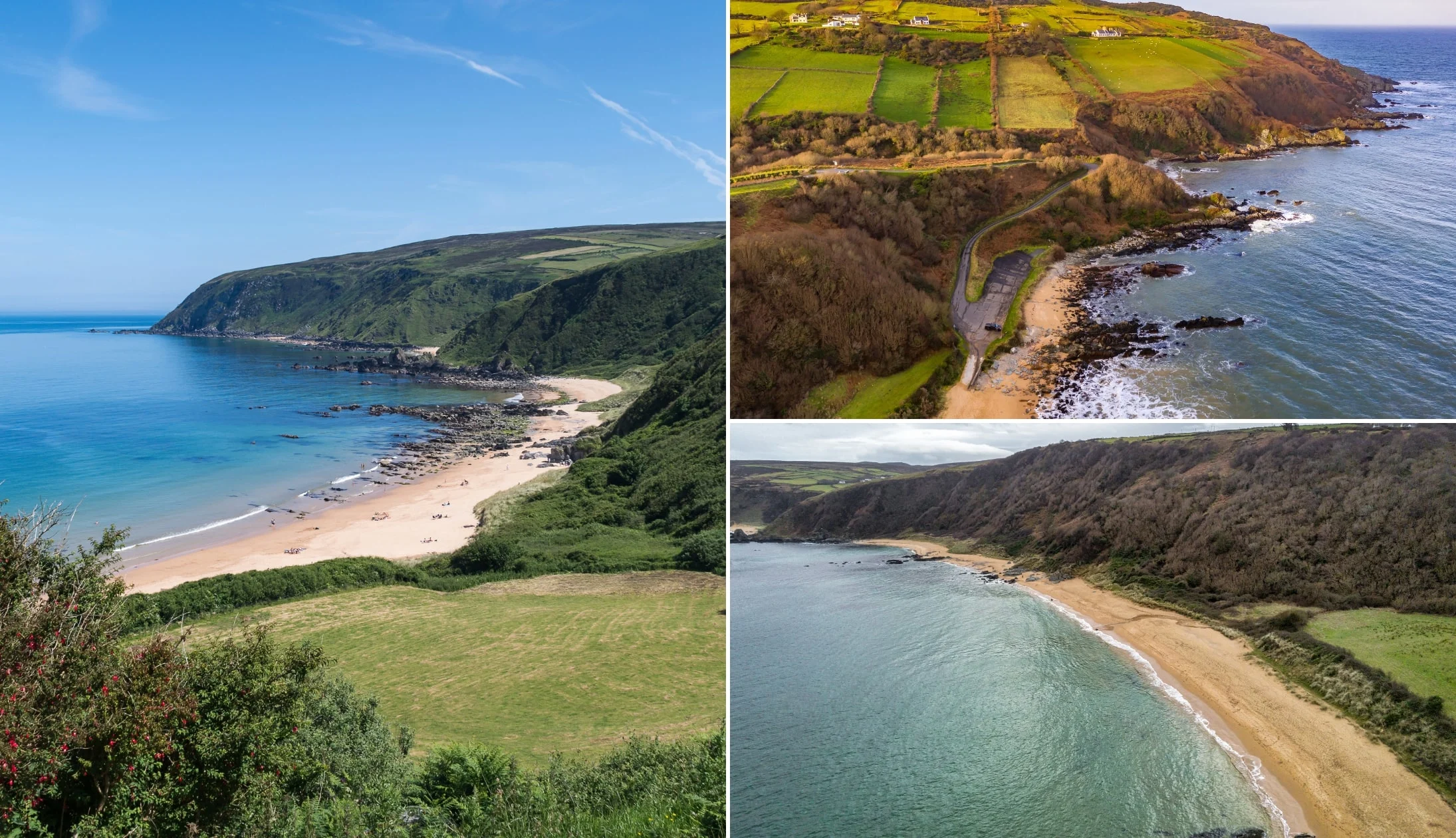
Photos via Shutterstock
Once you arrive at our next stop, you’d be forgiven for thinking you’d teleported to a tropical island in the Pacific Ocean. Kinnagoe Bay is one of Ireland’s hidden gems, a gorgeous sandy beach with stunningly clear waters. Surrounded by towering green cliffs, it’s picture-perfect. There’s a nice lookout point, but if you prefer to get close, you’ll find a small car park on the edge of the beach. Just beware, it’s down a very steep and narrow lane.
There are no lifeguards at Kinnagoe Bay, though it is a popular swimming spot for confident swimmers. The waters can be a little rough at times, so it’s probably best to just chill out on the sand and take in the views. It’s a 46-minute drive from Malin Head.
Stop 9: Inishowen Head Lighthouse
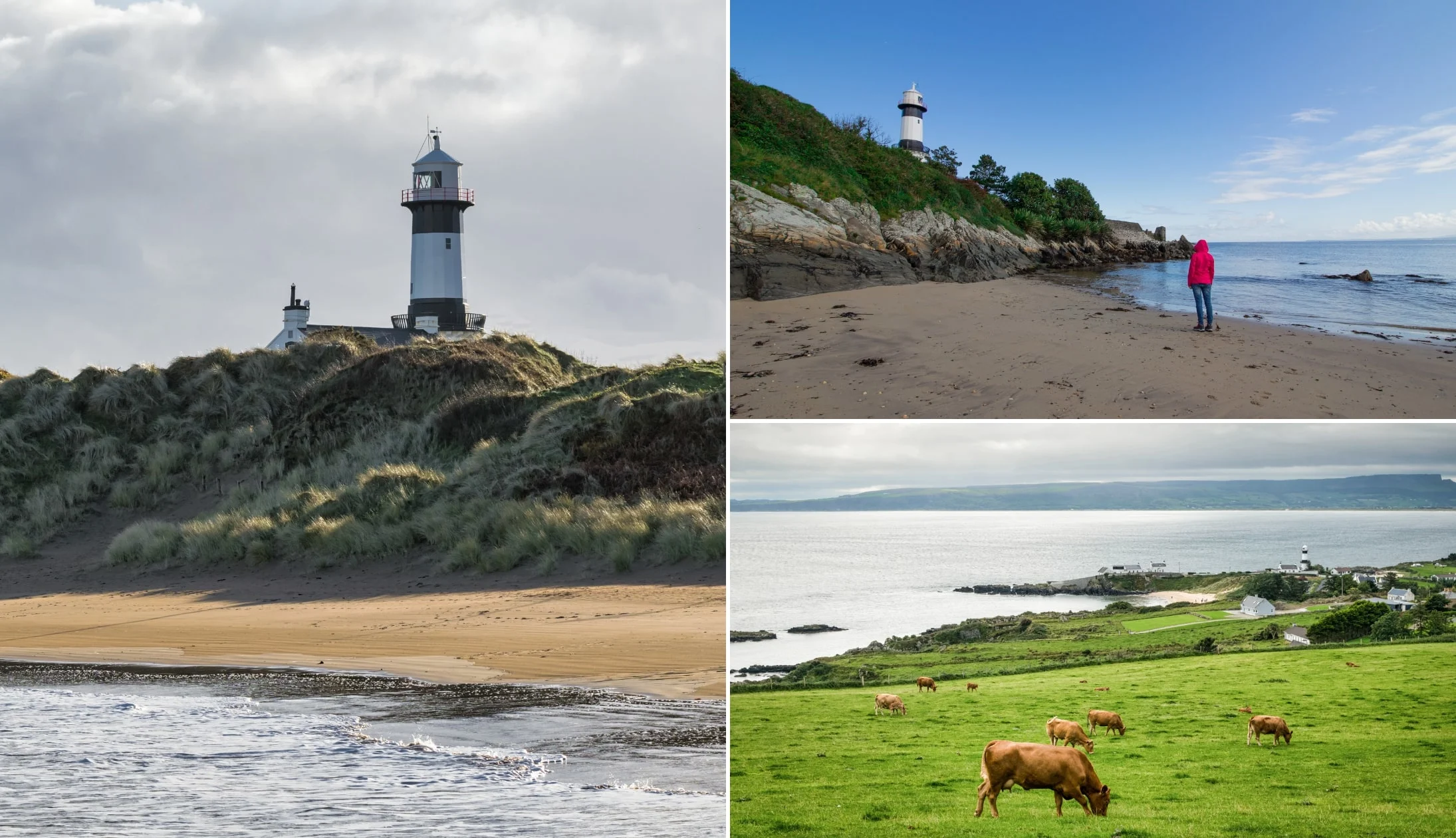
Photos via Shutterstock
As we head back toward Derry, there’s just one last little detour. Inishowen Head Lighthouse is a 16-minute drive from Kinnagoe Bay. It’s a gorgeous lighthouse, surrounded by breathtaking scenery, but it’s worth noting that you won’t find a visitor centre or tours of the inside here. Having said that, it’s a nice area to wander around and enjoy the views, and there’s even a small beach nearby.
Stop 10: Back to Derry for the night

Photos courtesy of Tourism Northern Ireland
It’s now time to head back to Derry for the night and you’re in for a treat. The road back hugs the coast on the southeastern edge of the Inishowen Peninsula, offering stunning scenery the entire way. It’ll take about 45 minutes to get back to Derry.
Now that you’ve seen the main sights and attractions in Derry City, it’s time to hit the town and enjoy some dinner, drinks, and live music.
Check into your accommodation, freshen up, and then enjoy these incredible places to check out.
Our Derry food recommendations
There’s no shortage of great places to eat out in Derry. Ship’s Quay is a good choice for dinner, with a larger, more varied menu.
If you’re up for a little fine dining, Browns Bonds Hill is a good choice, with a seasonal menu of beautifully cooked and presented dishes.
For a more laid-back feed, drop by Badgers Bar and Restaurant (check out the Derry Girls Mural on the back wall if you haven’t already!).
Our Derry pub recommendations
Whenever we’re in Derry, we try to drop by Walled City Brewery. It’s a fantastic little brewpub that offers a range of gorgeous beers, mostly brewed on-site.
For a more traditional pub experience, get down to Blackbird, where you’ll find retro decor and a superb gin and whisky selection, as well as cocktails, craft beers, and much more.
Grand Central Bar is another good choice, a cosy little old-school bar with excellent Guinness and regular impromptu trad sessions.
First of all, check out the Dungloe Bar, considered by many to be the best in the city for music. Peader O’Donnel’s is also worth a shot, a quirky and lively bar with live music every Saturday. Right next door, you’ll find The Gweedore Bar, which also does excellent live music on the weekends.
Day 20: Back to Donegal Airport

Photos via Google Maps and Shutterstock
Today is your final day in Ireland, and while we don’t have any more attractions to check out, you do have a nice drive up ahead!
We recommend booking a late flight home if possible, so you don’t have to rush. If your flight is in the evening, feel free to enjoy a morning of sightseeing in Derry, enjoying things like the Peace Bridge, the Derry Walls, and the Free Derry Corner.
It’s your last breakfast in Ireland, so go large! You can’t go wrong with either the Pickled Duck Cafe or the Scullery Cafe in the middle of the city.
Once you’re ready to hit the road, the drive to Donegal Airport should take about an hour and a half. Give yourself plenty of time to get there and drop your car off, all while enjoying the gorgeous countryside on the way there.
We hope you’ve enjoyed Ireland and go home with fond memories and new friendships! May the road rise to meet you.
And that’s a wrap on this road trip
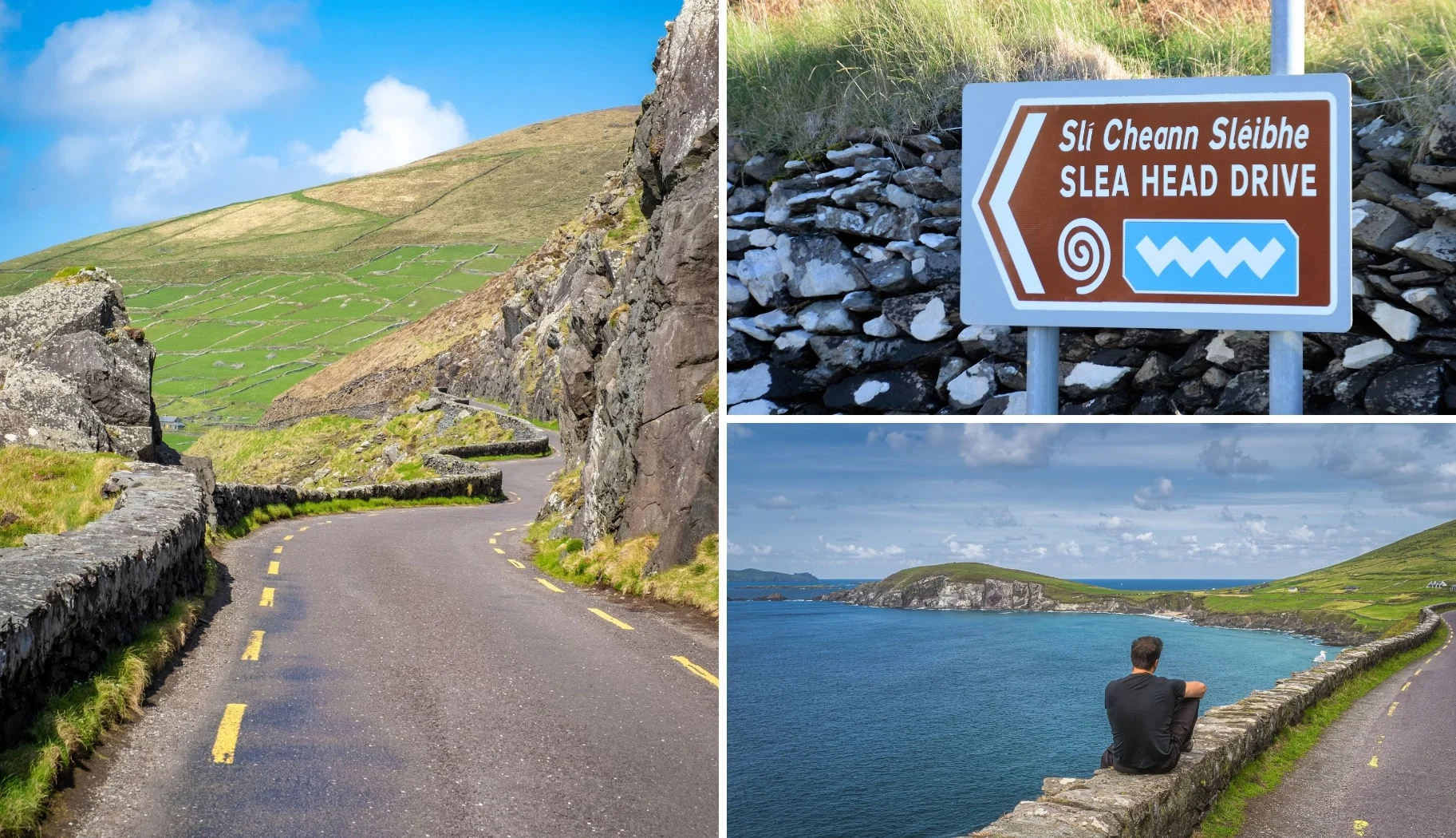
Photos via Shutterstock
We hope you found the above road trip guide useful. If you have any questions, ask in the comments below and we’ll do our best to help.
Or, if you’d like to browse our other Irish Road Trip itineraries, visit our Road Trip Hub – cheers!

